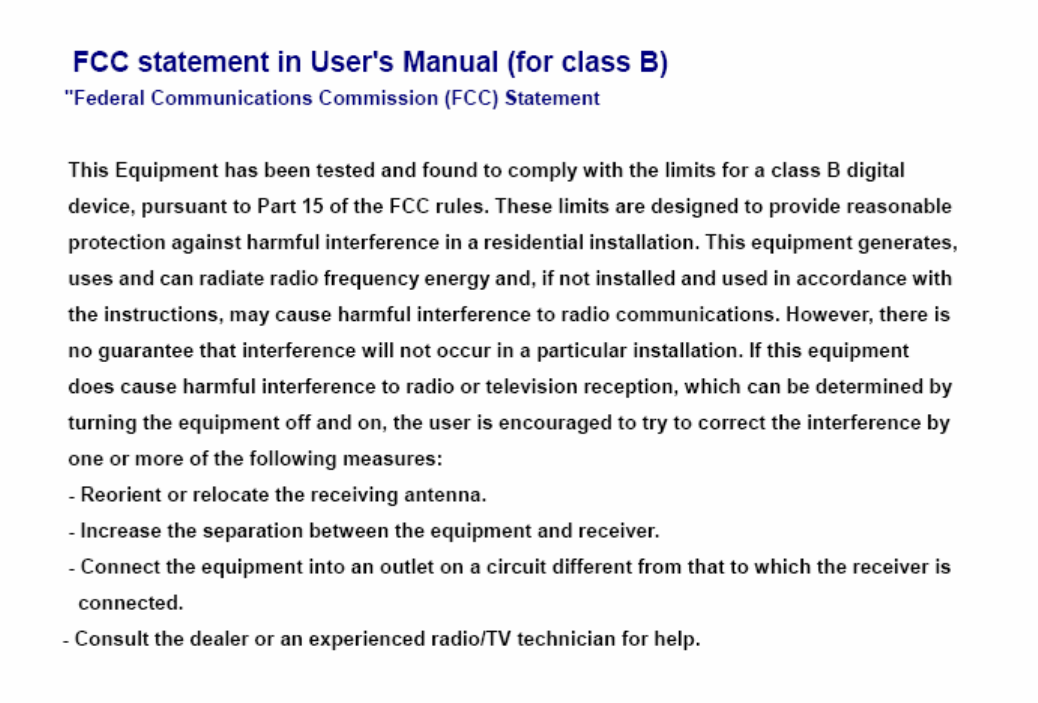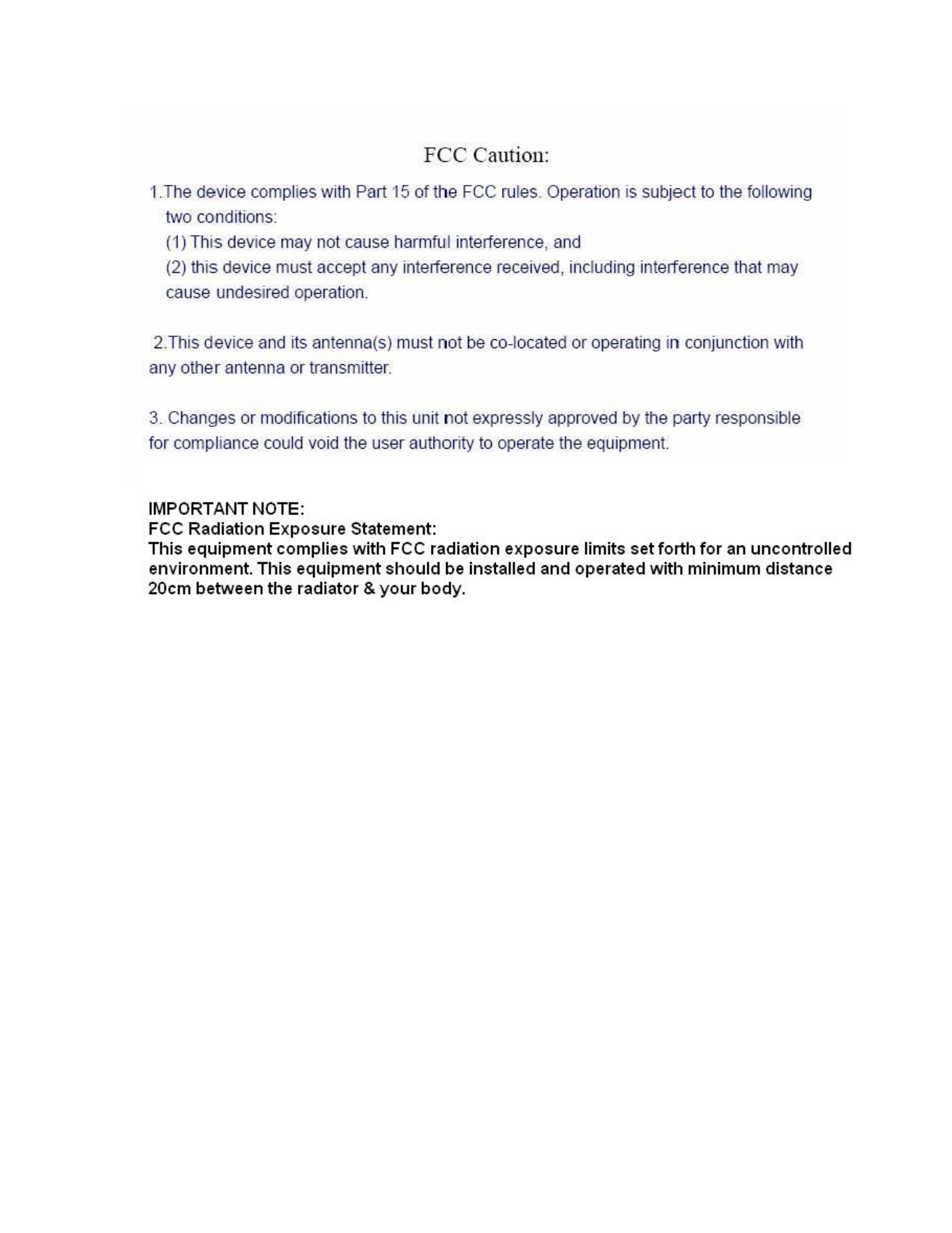ZyXEL Communications P320WV3 802.11g Wireless Firewall Router User Manual P 320W v3 User Guide March 2009
ZyXEL Communications Corporation 802.11g Wireless Firewall Router P 320W v3 User Guide March 2009
Users Manaul
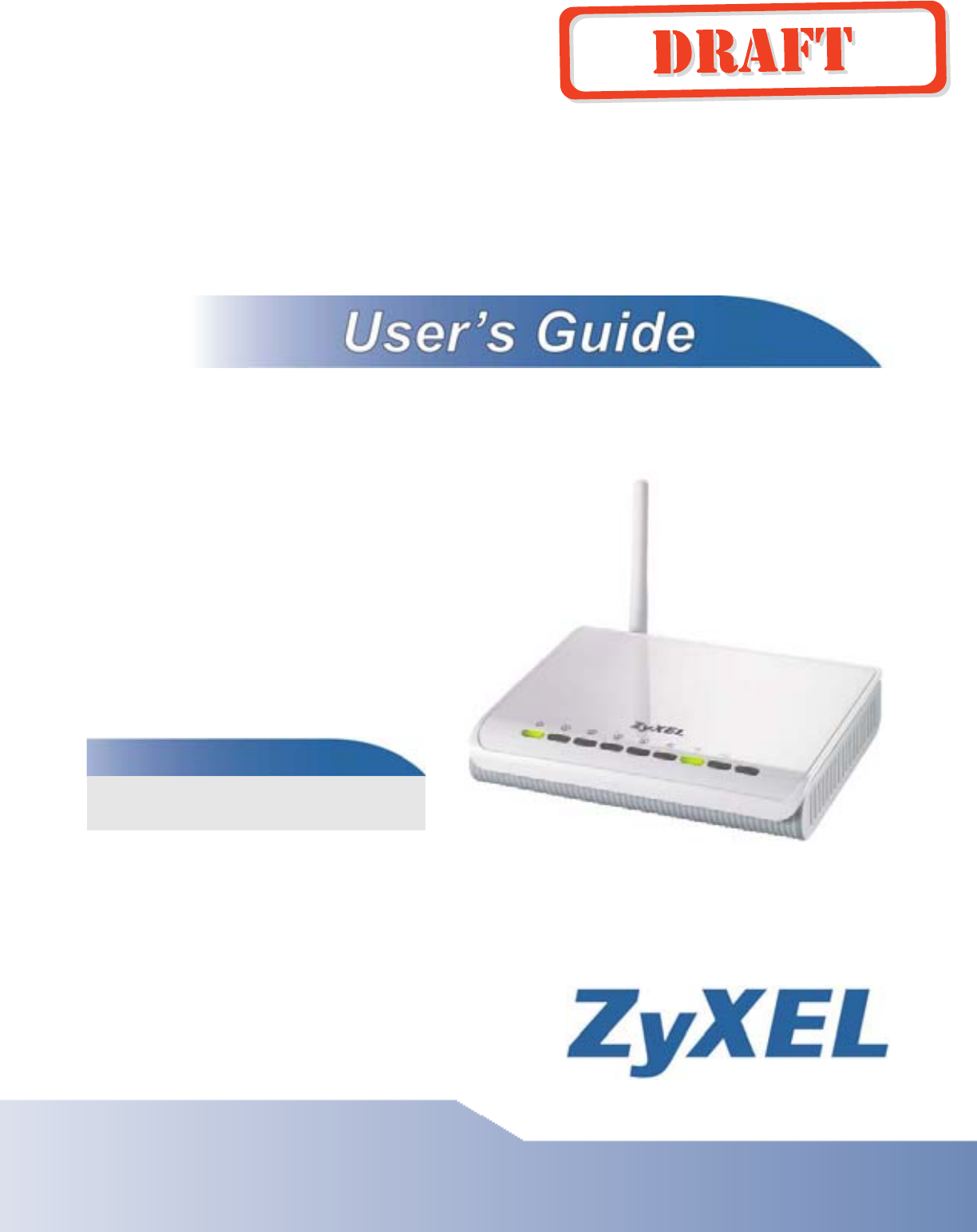
www.zyxel.com
www.zyxel.com
P-320W v3
802.11g Wireless Firewall Router
Copyright © 2009
ZyXEL Communications Corporation
Firmware Version 1.0
Edition 1, 3/2009
Default Login Details
IP Address http://192.168.1.1
Password 1234

About This User's Guide
P-320W v3 User’s Guide 3
About This User's Guide
Intended Audience
This manual is intended for people who want to configure the P-320W v3 using the
web configurator. You should have at least a basic knowledge of TCP/IP
networking concepts and topology.
Related Documentation
•Quick Start Guide
The Quick Start Guide is designed to help you get up and running right away. It
contains information on setting up your network and configuring for Internet
access.
• Supporting Disc
Refer to the included CD for support documents.
• ZyXEL Web Site
Please refer to www.zyxel.com for additional support documentation and
product certifications.
User Guide Feedback
Help us help you. Send all User Guide-related comments, questions or suggestions
for improvement to the following address, or use e-mail instead. Thank you!
The Technical Writing Team,
ZyXEL Communications Corp.,
6 Innovation Road II,
Science-Based Industrial Park,
Hsinchu, 300, Taiwan.
E-mail: techwriters@zyxel.com.tw

About This User's Guide
P-320W v3 User’s Guide
4
Customer Support
In the event of problems that cannot be solved by using this manual, you should
contact your vendor. If you cannot contact your vendor, then contact a ZyXEL
office for the region in which you bought the device. See http://www.zyxel.com/
web/contact_us.php for contact information. Please have the following information
ready when you contact an office.
• Product model and serial number.
•Warranty Information.
• Date that you received your device.
Brief description of the problem and the steps you took to solve it.

Document Conventions
P-320W v3 User’s Guide 5
Document Conventions
Warnings and Notes
These are how warnings and notes are shown in this User’s Guide.
Warnings tell you about things that could harm you or your device.
Note: Notes tell you other important information (for example, other things you may
need to configure or helpful tips) or recommendations.
Syntax Conventions
• The P-320W v3 may be referred to as the “P-320W v3”, the “device”, the
“product” or the “system” in this User’s Guide.
• Product labels, screen names, field labels and field choices are all in bold font.
• A key stroke is denoted by square brackets and uppercase text, for example,
[ENTER] means the “enter” or “return” key on your keyboard.
• “Enter” means for you to type one or more characters and then press the
[ENTER] key. “Select” or “choose” means for you to use one of the predefined
choices.
• A right angle bracket ( > ) within a screen name denotes a mouse click. For
example, Maintenance > Log > Log Setting means you first click
Maintenance in the navigation panel, then the Log sub menu and finally the
Log Setting tab to get to that screen.
• Units of measurement may denote the “metric” value or the “scientific” value.
For example, “k” for kilo may denote “1000” or “1024”, “M” for mega may
denote “1000000” or “1048576” and so on.
• “e.g.,” is a shorthand for “for instance”, and “i.e.,” means “that is” or “in other
words”.
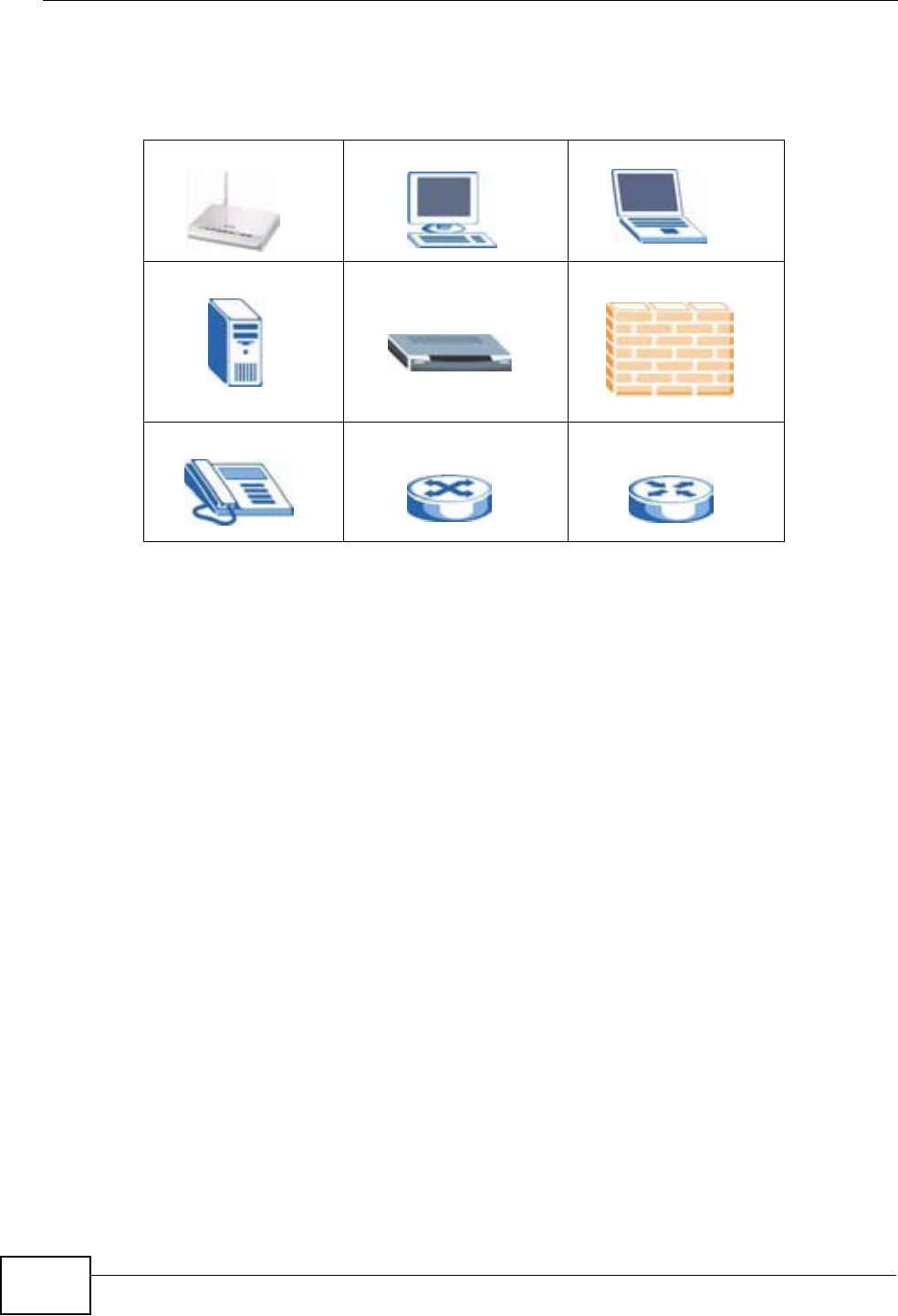
Document Conventions
P-320W v3 User’s Guide
6
Icons Used in Figures
Figures in this User’s Guide may use the following generic icons.
P-320W v3 Computer Notebook computer
Server Modem Firewall
Telephone Switch Router

Safety Warnings
P-320W v3 User’s Guide 7
Safety Warnings
• Do NOT use this product near water, for example, in a wet basement or near a swimming
pool.
• Do NOT expose your device to dampness, dust or corrosive liquids.
• Do NOT store things on the device.
• Do NOT install, use, or service this device during a thunderstorm. There is a remote risk
of electric shock from lightning.
• Connect ONLY suitable accessories to the device.
• Do NOT open the device or unit. Opening or removing covers can expose you to
dangerous high voltage points or other risks. ONLY qualified service personnel should
service or disassemble this device. Please contact your vendor for further information.
• Make sure to connect the cables to the correct ports.
• Place connecting cables carefully so that no one will step on them or stumble over them.
• Always disconnect all cables from this device before servicing or disassembling.
• Use ONLY an appropriate power adaptor or cord for your device.
• Connect the power adaptor or cord to the right supply voltage (for example, 110V AC in
North America or 230V AC in Europe).
• Do NOT allow anything to rest on the power adaptor or cord and do NOT place the
product where anyone can walk on the power adaptor or cord.
• Do NOT use the device if the power adaptor or cord is damaged as it might cause
electrocution.
• If the power adaptor or cord is damaged, remove it from the power outlet.
• Do NOT attempt to repair the power adaptor or cord. Contact your local vendor to order a
new one.
• Do not use the device outside, and make sure all the connections are indoors. There is a
remote risk of electric shock from lightning.
• Do NOT obstruct the device ventilation slots, as insufficient airflow may harm your
device.
• Antenna Warning! This device meets ETSI and FCC certification requirements when using
the included antenna(s). Only use the included antenna(s).
• If you wall mount your device, make sure that no electrical lines, gas or water pipes will
be damaged.
Your product is marked with this symbol, which is known as the WEEE mark. WEEE
stands for Waste Electronics and Electrical Equipment. It means that used electrical
and electronic products should not be mixed with general waste. Used electrical and
electronic equipment should be treated separately.

Safety Warnings
P-320W v3 User’s Guide
8

Contents Overview
P-320W v3 User’s Guide 9
Contents Overview
Introduction ............................................................................................................................ 19
Getting to Know Your P-320W v3 .............................................................................................. 21
Introducing the Web Configurator .............................................................................................. 25
Connection Wizard .................................................................................................................... 37
Network ................................................................................................................................... 53
Wireless LAN ............................................................................................................................. 55
Wireless Client Mode ................................................................................................................. 73
Wireless Tutorial ........................................................................................................................ 77
LAN ............................................................................................................................................ 85
DHCP Server ............................................................................................................................. 89
Network Address Translation (NAT) .......................................................................................... 93
VLAN ....................................................................................................................................... 101
Security ................................................................................................................................. 105
WAN ........................................................................................................................................ 107
Firewall .....................................................................................................................................117
Content Filtering ...................................................................................................................... 125
Management ......................................................................................................................... 129
Static Route ............................................................................................................................. 131
Remote Management ..............................................................................................................135
Universal Plug-and-Play (UPnP) ............................................................................................. 141
Maintenance and Troubleshooting ..................................................................................... 155
System ..................................................................................................................................... 157
Logs ......................................................................................................................................... 163
Tools ........................................................................................................................................ 179
Troubleshooting ....................................................................................................................... 185
Product Specifications ............................................................................................................. 193
Appendices and Index .........................................................................................................197

Contents Overview
P-320W v3 User’s Guide
10

Table of Contents
P-320W v3 User’s Guide 11
Table of Contents
About This User's Guide ..........................................................................................................3
Document Conventions............................................................................................................5
Safety Warnings........................................................................................................................7
Contents Overview ...................................................................................................................9
Table of Contents.................................................................................................................... 11
Part I: Introduction................................................................................. 19
Chapter 1
Getting to Know Your P-320W v3 ..........................................................................................21
1.1 Overview .............................................................................................................................. 21
1.2 Ways to Manage the P-320W v3 ......................................................................................... 22
1.3 Good Habits for Managing the P-320W v3 .......................................................................... 22
1.4 LEDs .................................................................................................................................... 23
Chapter 2
Introducing the Web Configurator ........................................................................................ 25
2.1 Web Configurator Overview ................................................................................................. 25
2.2 Accessing the Web Configurator ......................................................................................... 25
2.3 Resetting the P-320W v3 ..................................................................................................... 27
2.3.1 Procedure to Use the Reset Button ........................................................................... 27
2.4 Navigating the Web Configurator ...................................................................................... 27
2.4.1 Navigation Panel ........................................................................................................ 30
2.4.2 Summary: DHCP Table ............................................................................................ 32
2.4.3 Summary: Association List ...................................................................................... 33
2.4.4 Summary: Statistics ................................................................................................. 33
2.4.5 Summary: Active Session ...................................................................................... 34
2.4.6 Summary: Routing Table ............................................................................................ 35
Chapter 3
Connection Wizard ................................................................................................................. 37
3.1 Wizard Setup ....................................................................................................................... 37
3.2 Connection Wizard: STEP 1: System Information ............................................................... 38
3.2.1 System Name ............................................................................................................. 38

Table of Contents
P-320W v3 User’s Guide
12
3.2.2 Domain Name ............................................................................................................ 38
3.3 Connection Wizard: STEP 2: Wireless LAN ........................................................................ 40
3.3.1 Basic(WEP) Security .................................................................................................. 42
3.3.2 Extend (WPA-PSK) Security ...................................................................................... 43
3.4 Connection Wizard: STEP 3: Internet Configuration ........................................................... 43
3.4.1 Ethernet Connection .................................................................................................. 44
3.4.2 PPPoE Connection .................................................................................................... 44
3.4.3 PPTP Connection ....................................................................................................... 46
3.4.4 Your IP Address ......................................................................................................... 47
3.4.5 WAN IP Address Assignment ..................................................................................... 48
3.4.6 IP Address and Subnet Mask ..................................................................................... 48
3.4.7 DNS Server Address Assignment .............................................................................. 49
3.4.8 WAN IP and DNS Server Address Assignment ......................................................... 50
3.4.9 WAN MAC Address .................................................................................................... 51
3.5 Connection Wizard Complete .............................................................................................. 52
Part II: Network....................................................................................... 53
Chapter 4
Wireless LAN........................................................................................................................... 55
4.1 Overview .............................................................................................................................. 55
4.2 What You Can Do ................................................................................................................ 56
4.3 What You Need To Know ..................................................................................................... 56
4.3.1 SSID ........................................................................................................................... 56
4.3.2 MAC Address Filter .................................................................................................... 57
4.3.3 User Authentication .................................................................................................... 57
4.3.4 Encryption .................................................................................................................. 58
4.3.5 WiFi Protected Setup ................................................................................................. 60
4.4 General Wireless LAN Screen ............................................................................................ 60
4.4.1 No Security ................................................................................................................. 62
4.4.2 WEP Encryption ......................................................................................................... 63
4.4.3 WPA-PSK ................................................................................................................... 64
4.4.4 WPA ........................................................................................................................... 65
4.4.5 802.1x + Dynamic WEP ............................................................................................. 66
4.4.6 WPA-PSK/WPA2-PSK (Mixed) ................................................................................... 67
4.5 MAC Filter ............................................................................................................................ 68
4.6 WPS Screen ........................................................................................................................ 69
4.7 WPS Station Screen ............................................................................................................ 70
4.8 Wireless LAN Advanced Screen ......................................................................................... 70
Chapter 5
Wireless Client Mode.............................................................................................................. 73

Table of Contents
P-320W v3 User’s Guide 13
5.1 Overview .............................................................................................................................. 73
5.2 What You Can Do ................................................................................................................ 73
5.3 Wireless Client Mode Screen .............................................................................................. 74
Chapter 6
Wireless Tutorial ..................................................................................................................... 77
6.1 How to Connect to the Internet from an AP ......................................................................... 77
6.2 Configure Wireless Security Using WPS on both your P-320W v3 and Wireless Client ..... 77
6.2.1 Push Button Configuration (PBC) .............................................................................. 78
6.2.2 PIN Configuration ....................................................................................................... 79
6.3 Enable and Configure Wireless Security without WPS on your P-320W v3 ........................ 81
6.4 Configure Your Notebook ....................................................................................................82
Chapter 7
LAN........................................................................................................................................... 85
7.1 Overview .............................................................................................................................. 85
7.2 What You Can Do ................................................................................................................ 85
7.3 What You Need to Know ......................................................................................................85
7.3.1 IP Pool Setup ............................................................................................................. 86
7.3.2 System DNS Servers ................................................................................................. 86
7.3.3 LAN TCP/IP ................................................................................................................ 86
7.3.4 Factory LAN Defaults ................................................................................................. 86
7.3.5 IP Address and Subnet Mask ..................................................................................... 86
7.4 LAN IP Screen ..................................................................................................................... 87
Chapter 8
DHCP Server............................................................................................................................ 89
8.1 Overview .............................................................................................................................. 89
8.2 What You Can Do ................................................................................................................ 89
8.3 DHCP Server General Screen ............................................................................................. 89
8.4 Static DHCP Screen ......................................................................................................... 91
8.5 Client List Screen ................................................................................................................ 91
Chapter 9
Network Address Translation (NAT)......................................................................................93
9.1 Overview ........................................................................................................................... 93
9.2 What You Can Do ................................................................................................................ 93
9.3 What You Need to Know ......................................................................................................93
9.3.1 Port Forwarding: Services and Port Numbers ............................................................ 94
9.3.2 Trigger Port Forwarding ............................................................................................. 95
9.3.3 Two Points To Remember About Trigger Ports .......................................................... 96
9.4 General NAT Screen ............................................................................................................ 96
9.5 Port Forwarding Screen ..................................................................................................... 97

Table of Contents
P-320W v3 User’s Guide
14
9.5.1 Rule Setup Screen ..................................................................................................... 98
9.6 Trigger Port Screen ............................................................................................................. 99
9.7 Technical Reference .......................................................................................................... 100
9.7.1 Game List Example .................................................................................................. 100
Chapter 10
VLAN ...................................................................................................................................... 101
10.1 Overview ..................................................................................................................... 101
10.2 What You Can Do ............................................................................................................ 101
10.3 What You Need to Know .................................................................................................. 102
10.3.1 How VLAN Works .................................................................................................. 102
10.3.2 VLAN Tag ............................................................................................................... 102
10.4 VLAN Screen ................................................................................................................... 102
Part III: Security.................................................................................... 105
Chapter 11
WAN........................................................................................................................................ 107
11.1 Overview .......................................................................................................................... 107
11.2 What You Can Do ............................................................................................................ 107
11.3 Internet Connection Screen ............................................................................................. 108
11.3.1 Ethernet Encapsulation .......................................................................................... 108
11.3.2 PPPoE Encapsulation ............................................................................................ 109
11.3.3 PPTP Encapsulation ................................................................................................111
11.4 Advanced Screen ..............................................................................................................114
11.5 Traffic Redirect Screen .....................................................................................................114
Chapter 12
Firewall................................................................................................................................... 117
12.1 Overview .........................................................................................................................117
12.2 What You Can Do .............................................................................................................117
12.3 What You Need to Know ...................................................................................................117
12.3.1 About the P-320W v3 Firewall .................................................................................118
12.3.2 Security Parameter Index (SPI) ..............................................................................118
12.4 General Firewall Screen ................................................................................................119
12.5 Services Screen ...............................................................................................................119
12.6 Technical Reference ........................................................................................................ 121
12.6.1 Guidelines For Enhancing Security With Your Firewall .......................................... 121
12.6.2 Services ................................................................................................................. 122
Chapter 13
Content Filtering ................................................................................................................... 125

Table of Contents
P-320W v3 User’s Guide 15
13.1 Overview .......................................................................................................................... 125
13.2 What You Can Do ............................................................................................................ 125
13.3 Filter Screen .................................................................................................................... 125
13.4 Technical Reference ........................................................................................................ 127
13.4.1 Domain Name or IP Address URL Checking ......................................................... 127
13.4.2 Full Path URL Checking ......................................................................................... 127
13.4.3 File Name URL Checking ....................................................................................... 128
Part IV: Management............................................................................ 129
Chapter 14
Static Route ...........................................................................................................................131
14.1 Overview .......................................................................................................................... 131
14.2 What You Can Do ............................................................................................................ 132
14.3 IP Static Route Screen ....................................................................................................132
14.3.1 Static Route Setup Screen ................................................................................... 133
Chapter 15
Remote Management............................................................................................................135
15.1 Overview .......................................................................................................................... 135
15.2 What You Can Do ............................................................................................................ 136
15.3 What You Need to Know .................................................................................................. 136
15.3.1 Remote Management Limitations .......................................................................... 136
15.3.2 Remote Management and NAT .............................................................................. 136
15.3.3 System Timeout .................................................................................................... 136
15.4 WWW Screen ................................................................................................................ 137
15.5 The SNMP Screen ...........................................................................................................138
15.6 Security Screen ............................................................................................................. 139
Chapter 16
Universal Plug-and-Play (UPnP)..........................................................................................141
16.1 Overview .......................................................................................................................... 141
16.2 What You Can Do ............................................................................................................ 141
16.3 What You Need to Know .................................................................................................. 141
16.3.1 How do I know if I'm using UPnP? ......................................................................... 141
16.3.2 NAT Traversal ........................................................................................................ 142
16.3.3 Cautions with UPnP ............................................................................................... 142
16.3.4 UPnP and ZyXEL ................................................................................................... 142
16.4 UPnP Screen ................................................................................................................... 143
16.5 Technical Reference ........................................................................................................ 143
16.5.1 Installing UPnP in Windows Example .................................................................... 143

Table of Contents
P-320W v3 User’s Guide
16
Part V: Maintenance and Troubleshooting ........................................ 155
Chapter 17
System ................................................................................................................................... 157
17.1 Overview .......................................................................................................................... 157
17.2 What You Can Do ............................................................................................................ 157
17.3 What You Need to Know .................................................................................................. 157
17.3.1 Dynamic DNS Introduction .................................................................................... 157
17.3.2 DynDNS Wildcard .................................................................................................. 158
17.4 System General Screen ................................................................................................. 158
17.5 Dynamic DNS Screen .................................................................................................... 160
17.6 Time Setting Screen ........................................................................................................ 161
Chapter 18
Logs ....................................................................................................................................... 163
18.1 Overview .......................................................................................................................... 163
18.2 What You Can Do ............................................................................................................ 163
18.3 What You Need to Know .................................................................................................. 163
18.4 View Log Screen .............................................................................................................. 164
18.5 Log Settings Screen ........................................................................................................ 165
18.6 Technical Reference ........................................................................................................ 166
18.6.1 Log Descriptions .................................................................................................... 166
Chapter 19
Tools....................................................................................................................................... 179
19.1 Overview .......................................................................................................................... 179
19.2 What You Can Do ............................................................................................................ 179
19.3 Firmware Upload Screen ................................................................................................. 179
19.4 Configuration Screen ....................................................................................................... 181
19.4.1 Backup Configuration ............................................................................................. 181
19.4.2 Restore Configuration ............................................................................................ 182
19.4.3 Back to Factory Defaults ........................................................................................ 183
19.5 Restart Screen ................................................................................................................. 183
Chapter 20
Troubleshooting.................................................................................................................... 185
20.1 Power, Hardware Connections, and LEDs ...................................................................... 185
20.2 P-320W v3 Access and Login ......................................................................................... 186
20.3 Internet Access ................................................................................................................ 188
20.4 Resetting the P-320W v3 to Its Factory Defaults ............................................................. 189
20.5 Wireless Router Troubleshooting .................................................................................... 190
20.6 Advanced Features .........................................................................................................191

Table of Contents
P-320W v3 User’s Guide 17
Chapter 21
Product Specifications .........................................................................................................193
Part VI: Appendices and Index ........................................................... 197
Appendix A Pop-up Windows, JavaScripts and Java Permissions ...................................... 199
Appendix B IP Addresses and Subnetting ...........................................................................207
Appendix C Setting up Your Computer’s IP Address ........................................................... 217
21.0.1 Verifying Settings ................................................................................................... 234
Appendix D Wireless LANs .................................................................................................. 235
21.0.2 WPA(2)-PSK Application Example ......................................................................... 245
21.0.3 WPA(2) with RADIUS Application Example ........................................................... 245
Appendix E Services ............................................................................................................ 247
Appendix F Legal Information .............................................................................................. 251
Index....................................................................................................................................... 255

Table of Contents
P-320W v3 User’s Guide
18

19
PART I
Introduction
Getting to Know Your P-320W v3 (21)
Introducing the Web Configurator (25)
Connection Wizard (37)

20
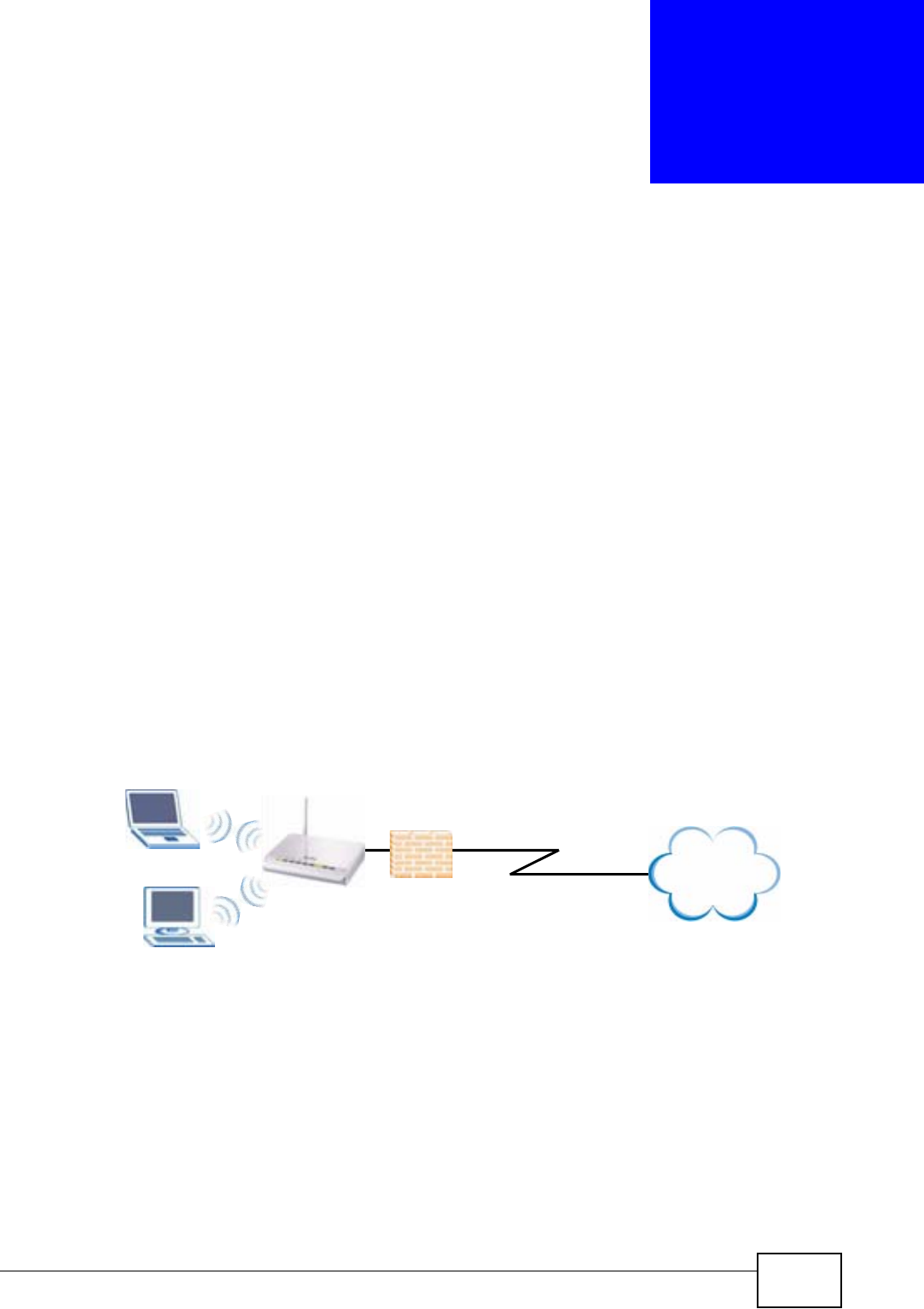
P-320W v3 User’s Guide 21
CHAPTER 1
Getting to Know Your P-320W v3
1.1 Overview
This chapter introduces the main features and applications of the P-320W v3.
The P-320W v3 extends the range of your existing wired network without
additional wiring, providing easy network access to mobile users.
It acts as a secure broadband router for all data passing between the Internet and
your local network. You can set up a wireless network with other IEEE 802.11b/g
compatible devices.
The following figure shows computers in a WLAN connecting to the P-320W v3
(A), which has a DSL connection to the Internet. The P-320W v3 has a built-in
firewall (B) to protect the network. It also has the Network Address Translation
(NAT) feature enabled by default.
Figure 1 Secure Wireless Internet Access in Router Mode
The P-320W v3 can also serve as a wireless client enabling network devices to
connect to an existing wired or wireless network. Features, such as firewall and
NAT, are available. Networking devices cannot connect wirelessly to the P-320W
v3 when it is acting as a wireless client.
AB
WLAN
Internet
DSL
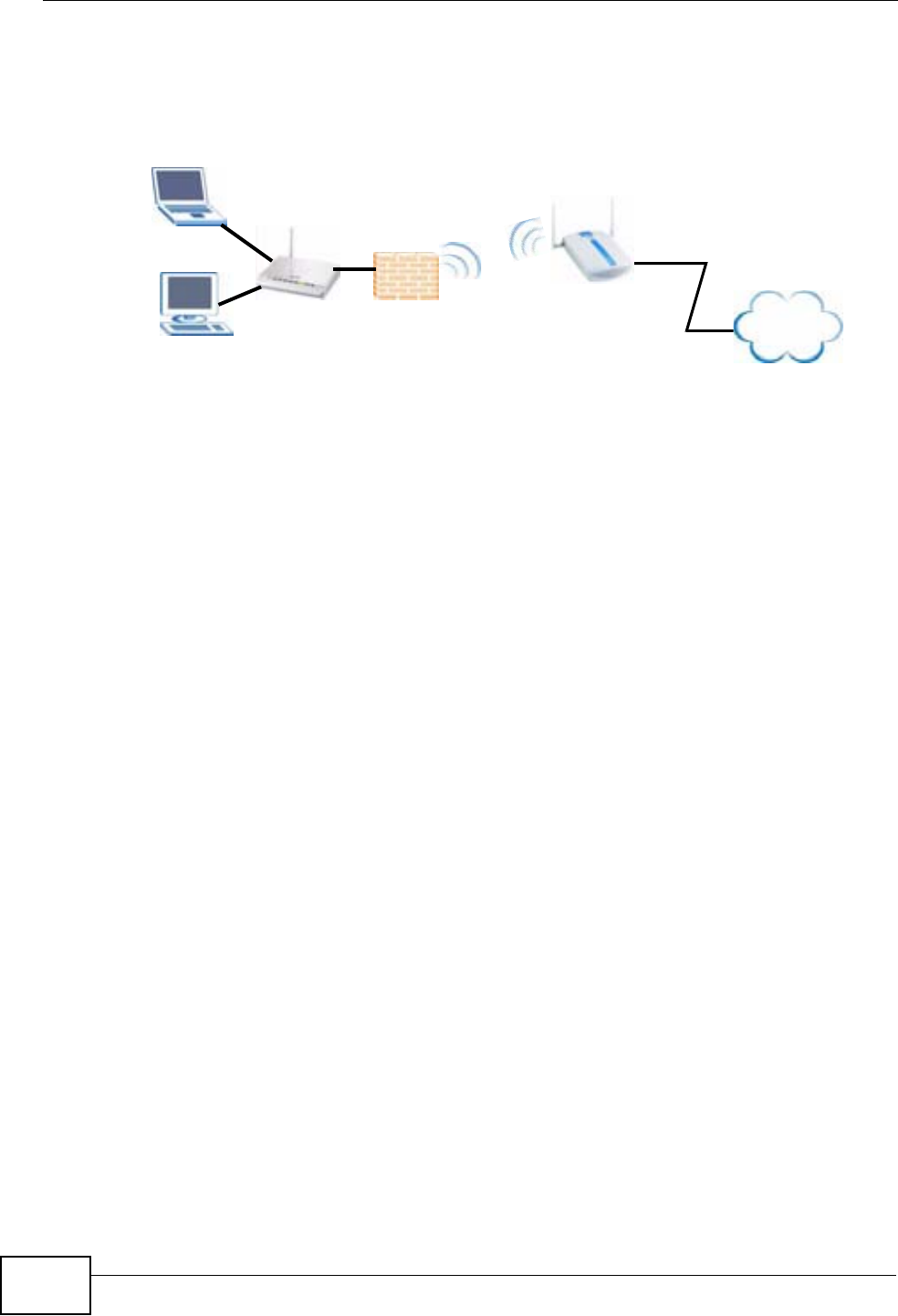
Chapter 1 Getting to Know Your P-320W v3
P-320W v3 User’s Guide
22
In the following figure, the P-320W v3 (A) enables the wired computers to connect
to the access point (B) and gain access to LAN/Internet.
Figure 2 Using the P-320W v3 as a Wireless Client
1.2 Ways to Manage the P-320W v3
Use any of the following methods to manage the P-320W v3.
•Web Configurator. This is recommended for everyday management of the P-
320W v3 using a (supported) web browser.
•SNMP. Simple Network Management Protocol is a communication protocol for
collecting information from devices on the network.
1.3 Good Habits for Managing the P-320W v3
Do the following things regularly to make the P-320W v3 more secure and to
manage the P-320W v3 more effectively.
• Change the password. Use a password that’s not easy to guess and that consists
of different types of characters, such as numbers and letters.
• Write down the password and put it in a safe place.
• Back up the configuration (and make sure you know how to restore it).
Restoring an earlier working configuration may be useful if the device becomes
unstable or even crashes. If you forget your password, you will have to reset the
P-320W v3 to its factory default settings. If you backed up an earlier
configuration file, you would not have to totally re-configure the P-320W v3. You
could simply restore your last configuration.
AB
Internet
DSL
Firewall
ISP
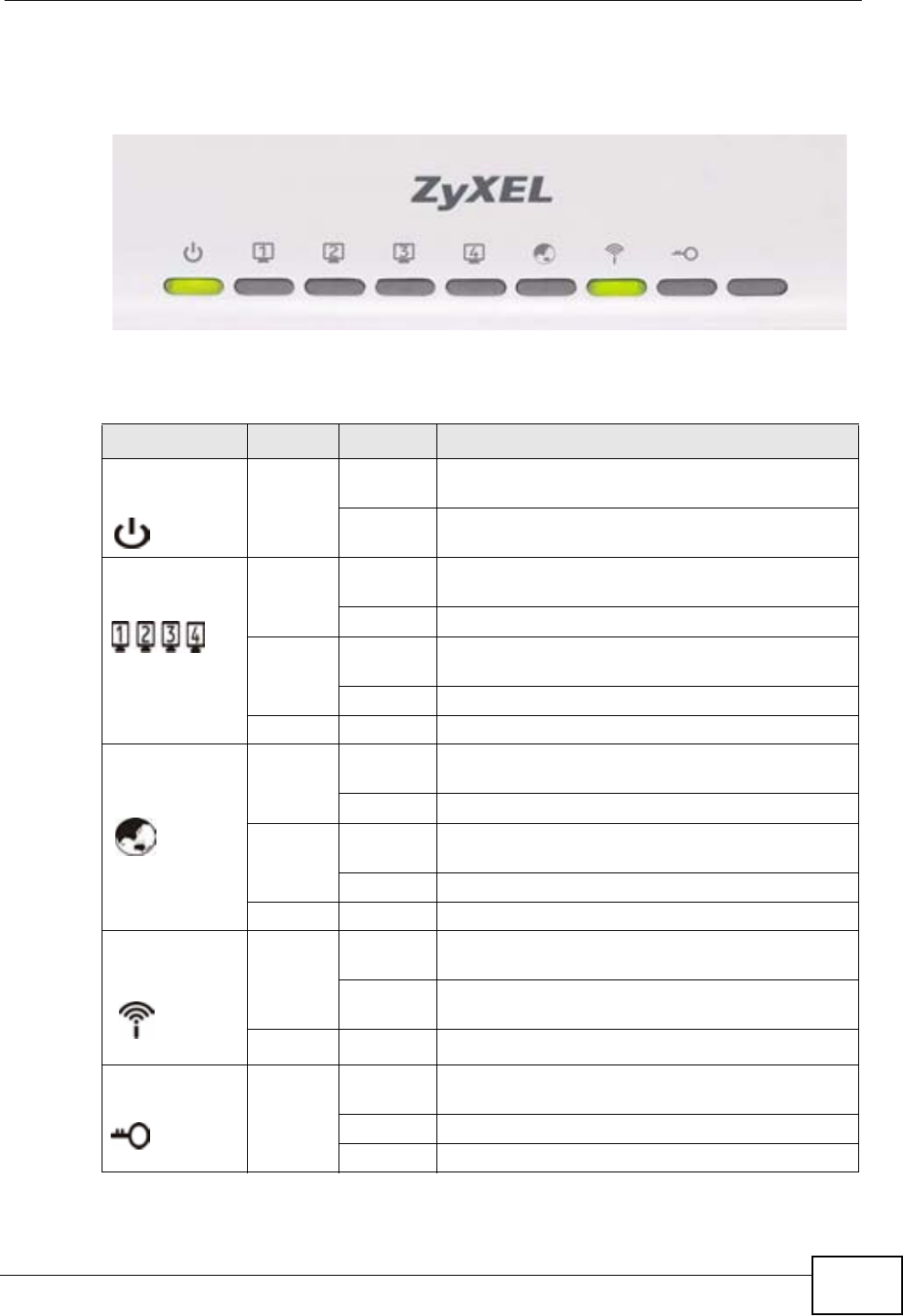
Chapter 1 Getting to Know Your P-320W v3
P-320W v3 User’s Guide 23
1.4 LEDs
Figure 3 Front Panel
The following table describes the LEDs.
Table 1 Front Panel LEDs
LED COLOR STATUS DESCRIPTION
POWER Green On The P-320W v3 is receiving power and
functioning properly.
Off The P-320W v3 is not receiving power.
LAN 1-4 Green On The P-320W v3 has a successful 10MB Ethernet
connection.
Blinking The P-320W v3 is sending/receiving data.
Amber On The P-320W v3 has a successful 100MB Ethernet
connection.
Blinking The P-320W v3 is sending/receiving data.
Off The LAN is not connected.
WAN Green On The P-320W v3 has a successful 10MB WAN
connection.
Blinking The P-320W v3 is sending/receiving data.
Amber On The P-320W v3 has a successful 100MB Ethernet
connection.
Blinking The P-320W v3 is sending/receiving data.
Off The WAN connection is not ready, or has failed.
WLAN Green On The P-320W v3 is ready, but is not sending/
receiving data through the wireless LAN.
Blinking The P-320W v3 is sending/receiving data
through the wireless LAN.
Off The wireless LAN is not ready or has failed.
WPS Green On WPS (WiFi Protected Setp) is configurered on
your device.
Blinking The P-320W v3 is negotiating WPS.
Off WPS is disabled on your device.

Chapter 1 Getting to Know Your P-320W v3
P-320W v3 User’s Guide
24

P-320W v3 User’s Guide 25
CHAPTER 2
Introducing the Web
Configurator
This chapter describes how to access the P-320W v3 web configurator and
provides an overview of its screens.
2.1 Web Configurator Overview
The web configurator is an HTML-based management interface that allows easy
setup and management of the P-320W v3 via Internet browser. Use Internet
Explorer 6.0 and later or Netscape Navigator 7.0 and later versions or Safari 2.0
or later versions. The recommended screen resolution is 1024 by 768 pixels.
In order to use the web configurator you need to allow:
• Web browser pop-up windows from your device. Web pop-up blocking is enabled
by default in Windows XP SP (Service Pack) 2.
• JavaScripts (enabled by default).
• Java permissions (enabled by default).
Refer to the Troubleshooting chapter to see how to make sure these functions are
allowed in Internet Explorer.
2.2 Accessing the Web Configurator
1Make sure your P-320W v3 hardware is properly connected and prepare your
computer or computer network to connect to the P-320W v3 (refer to the Quick
Start Guide).
2Launch your web browser.
3Type "http://192.168.1.1" as the website address.
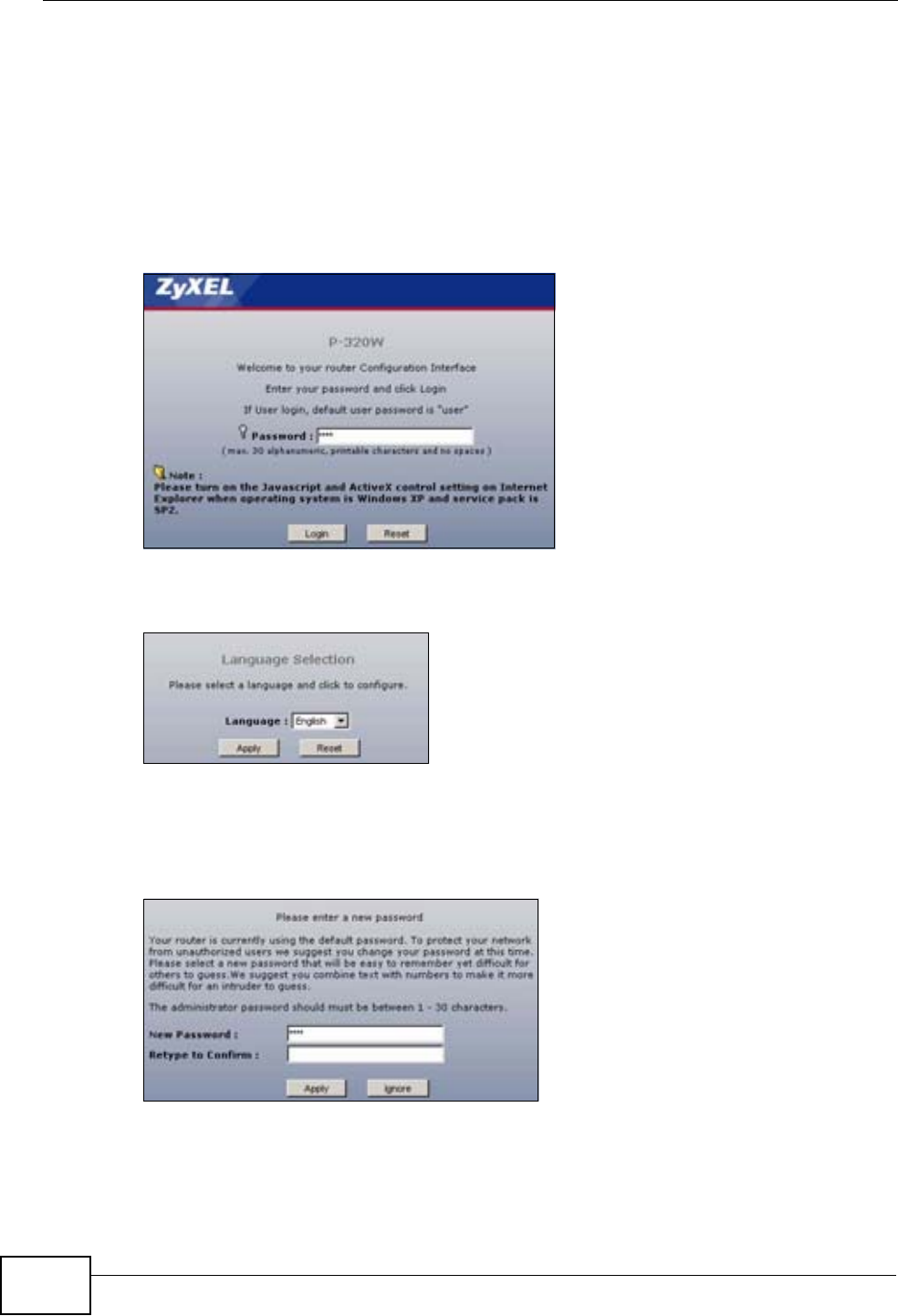
Chapter 2 Introducing the Web Configurator
P-320W v3 User’s Guide
26
Your computer must be in the same subnet in order to access this website
address.
Note: Enable the DHCP Server. The P-320W v3 assigns your computer an IP address
on the same subnet.
4Type "1234" (default) as the password and click Login. In some versions, the
default password appears automatically - if this is the case, click Login.
Figure 4 Change Password Screen
5Select your language in the screen that follows and click Apply or click Reset.
Figure 5 Language Selection
6You should see a screen asking you to change your password (highly
recommended) as shown next. Type a new password (and retype it to confirm)
and click Apply or click Ignore.
Figure 6 Change Password Screen
7Click Go to Wizard Setup to use the Configuration Wizard for basic Internet and
Wireless setup.
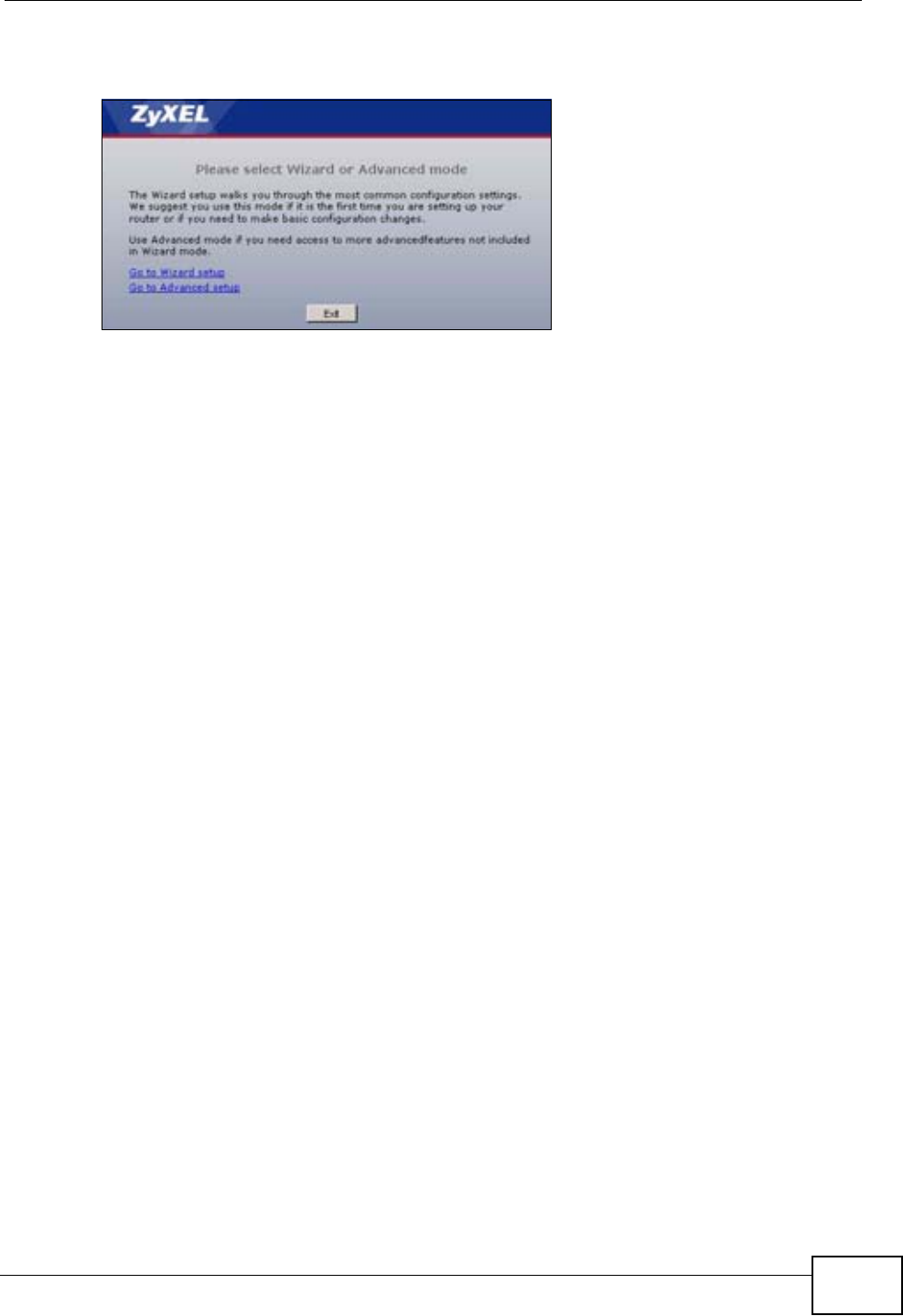
Chapter 2 Introducing the Web Configurator
P-320W v3 User’s Guide 27
8Click Go to Advanced Setup to view and configure all the P-320W v3’s settings.
Figure 7 Choose Your Setup Mode.
Note: The management session automatically times out when the time period set in
the Administrator Inactivity Timer field expires (default five minutes). Simply
log back into the P-320W v3 if this happens.
2.3 Resetting the P-320W v3
If you forget your password or IP address, or you cannot access the web
configurator, you will need to use the RESET button at the back of the P-320W v3
to reload the factory-default configuration file. This means that you will lose all
configurations that you had previously saved, the password will be reset to “1234”
and the IP address will be reset to “192.168.1.1”.
2.3.1 Procedure to Use the Reset Button
1Make sure the power LED is on.
2Press the RESET button for longer than 1 second to restart/reboot the P-320W v3.
3Press the RESET button for longer than five seconds to set the P-320W v3 back to
its factory-default configurations.
2.4 Navigating the Web Configurator
The following summarizes how to navigate the web configurator from the Status
screen.
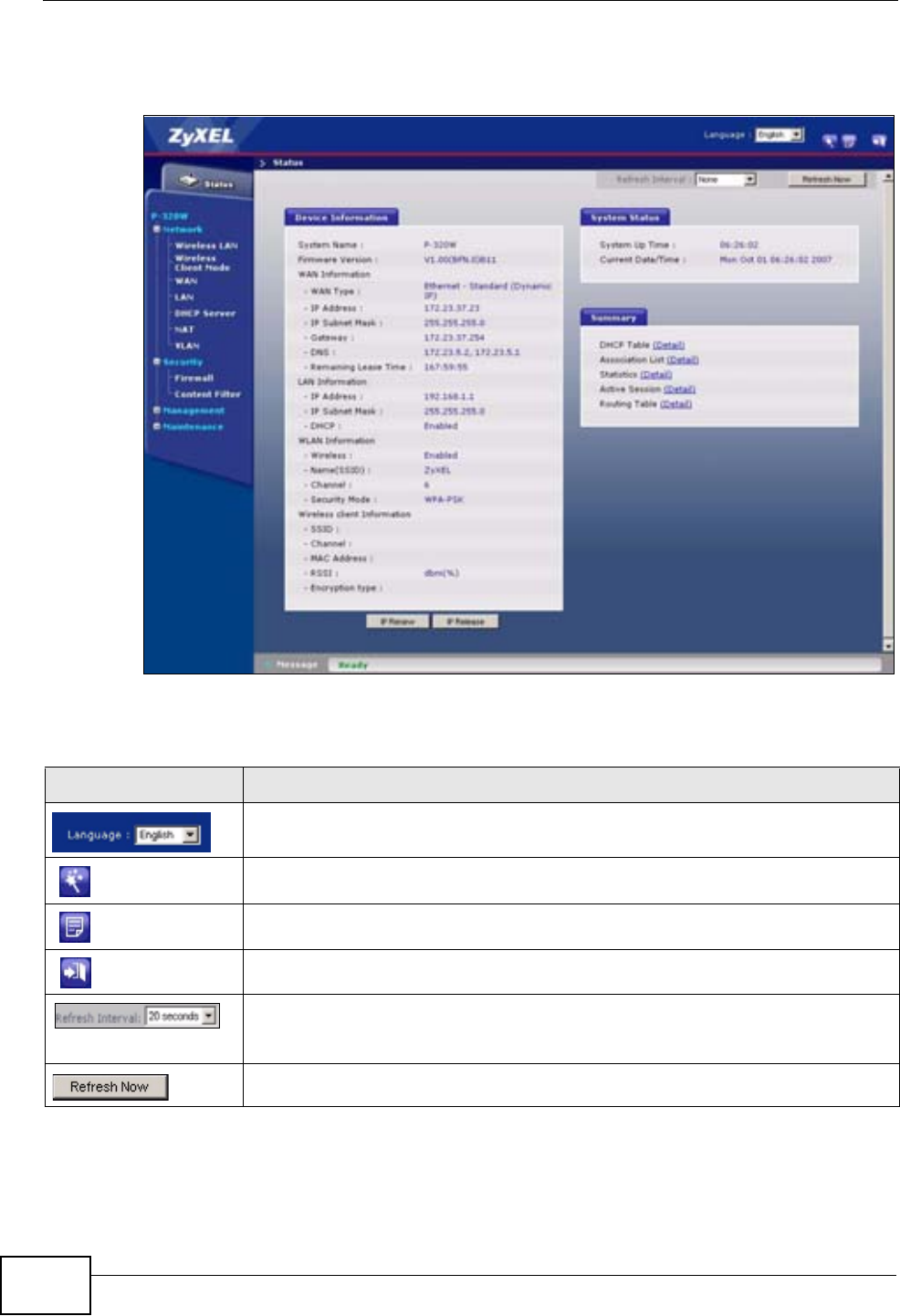
Chapter 2 Introducing the Web Configurator
P-320W v3 User’s Guide
28
Click on Status. The screen below shows the status screen.
Figure 8 Web Configurator Status Screen
The following table describes the icons shown in the Status screen.
Table 2 Status Screen Icon Key
ICON DESCRIPTION
Select a language from the drop-down list box to have the web configurator
display in that language.
Click this icon to open the setup wizard.
Click this icon to view copyright and a link for related product information.
Click this icon at any time to exit the web configurator.
Select a number of seconds or None from the drop-down list box to refresh
all screen statistics automatically at the end of every time interval or to not
refresh the screen statistics.
Click this button to refresh the status screen statistics.

Chapter 2 Introducing the Web Configurator
P-320W v3 User’s Guide 29
The following table describes the labels shown in the Status screen.
Table 3 Web Configurator Status Screen
LABEL DESCRIPTION
Device Information
System Name This is the System Name you enter in the Maintenance > System >
General screen. It is for identification purposes.
Firmware Version This is the firmware version and the date created.
WAN Information
WAN Type This shows the P-320W v3’s WAN type or how it acquires its WAN IP
address.
- IP Address This shows the WAN port’s IP address.
- IP Subnet Mask This shows the WAN port’s subnet mask.
- Gateway This shows the gateway address of the WAN connection.
- DNS This shows the Domain Name System (DNS) addresses of the WAN
connection.
- Remaining Lease
Time This shows how long the P-320W v3 can use the current WAN IP address.
LAN Information
- IP Address This shows the LAN port’s IP address.
- IP Subnet Mask This shows the LAN port’s subnet mask.
- DHCP This shows the LAN port’s DHCP is enabled.
WLAN Information
- Wireless This shows if the wireless LAN is enabled.
- Name(SSID) This shows a descriptive name used to identify the P-320W v3 in the
wireless LAN.
- Channel This shows the channel number which you select manually.
Note: To comply with US FCC regulation, the country selection
function has been completely removed from all US models. The
above function is for non-US models only.
- Security Mode This shows the level of wireless security the P-320W v3 is using.
Wireless client Information
- SSID This shows a descriptive name used to identify the P-320W v3 in the guest
WLAN network.
- Channel This shows the channel number which you select manually.
Note: To comply with US FCC regulation, the country selection
function has been completely removed from all US models. The
above function is for non-US models only.
- MAC Address This shows the wireless adapter MAC Address of guest WLAN on your
device.
- RSSI This shows the IP address for guest WLAN network.
- Encryption Type This shows the subnet mask for guest WLAN network.
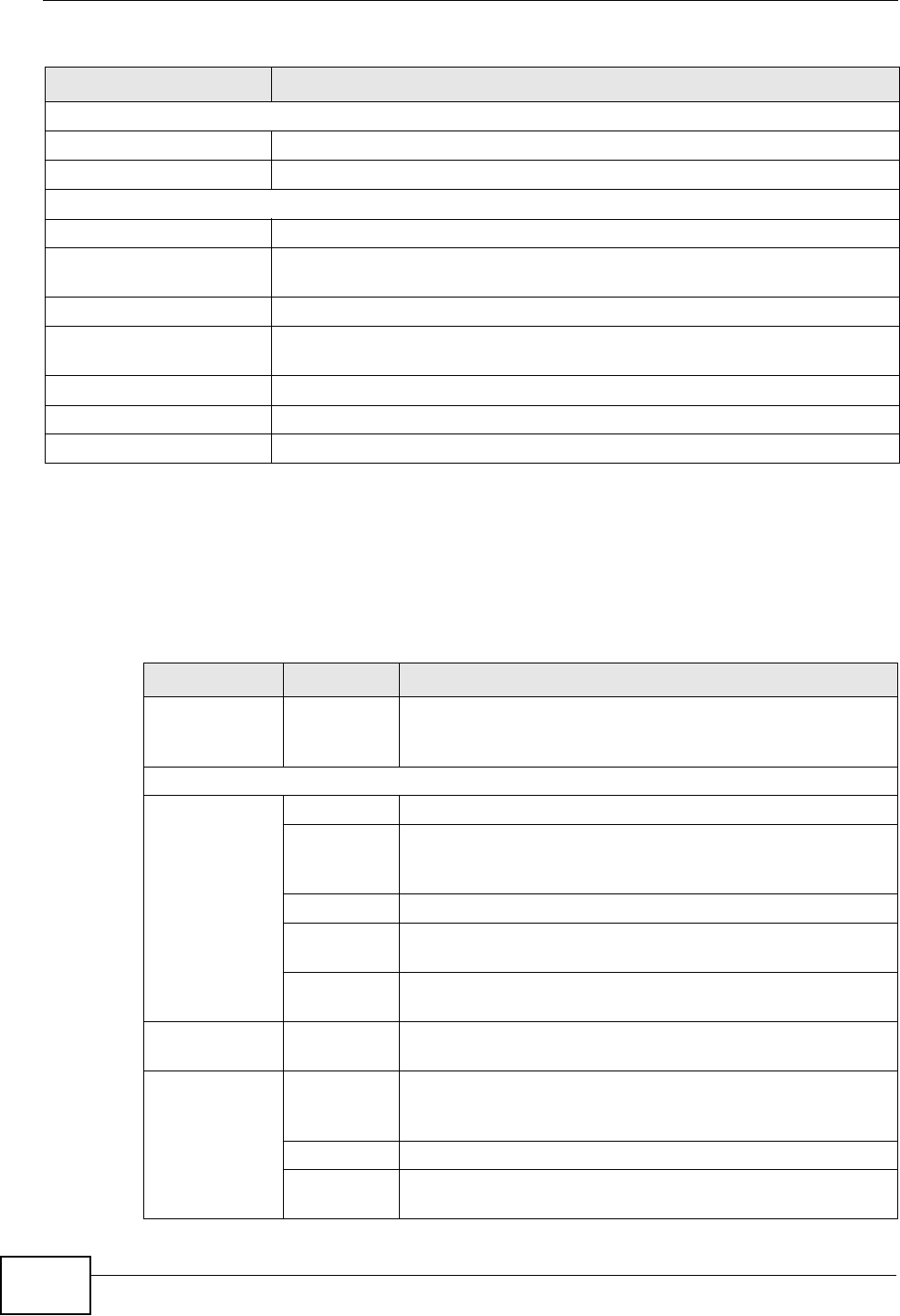
Chapter 2 Introducing the Web Configurator
P-320W v3 User’s Guide
30
2.4.1 Navigation Panel
Use the sub-menus on the navigation panel to configure P-320W v3 features.
The following table describes the sub-menus.
System Status
- System Up Time This is the total time the P-320W v3 has been on.
- Current Date/Time This field displays your P-320W v3’s present date and time.
Summary
- DHCP Table Use this screen to view current DHCP client information.
- Association List Use this screen to view the a list of devices the P-320W v3 is currently
associated with.
- Statistics Use this screen to view port status and packet specific statistics.
- Active Session Use this screen to view a list of wireless clients currently connected to the
P-320W v3.
- Routing Table Use this screen to view a list of the traffic routes used by the P-320W v3.
IP Renew Click this to renew the P-320W v3’s IP address.
IP Release Click this to release the P-320W v3’s IP address.
Table 3 Web Configurator Status Screen (continued)
LABEL DESCRIPTION
Table 4 Sub-menus
LINK TAB FUNCTION
Status This screen shows the P-320W v3’s general device, system
and interface status information. Use this screen to access
the wizard, and summary statistics tables.
Network
Wireless
LAN General Use this screen to configure wireless LAN.
MAC Filter Use the MAC filter screen to configure the P-320W v3 to
block access to devices or block the devices from
accessing the P-320W v3.
WPS Use this screen to configure WPS.
WPS
Station
Use this screen to add stations to the wireless network via
the Push Button.
Advanced This screen allows you to configure advanced wireless
settings.
Wireless
Client Mode This screen allows you to use your P-320W v3 as a
wireless client and connect to a wireless access point.
WAN Internet
Connection
This screen allows you to configure ISP parameters, WAN
IP address assignment, DNS servers and the WAN MAC
address.
Advanced Use this screen to configure other advanced properties.
Traffic
Redirect
Use this screen to enable a backup gateway IP address for
the P-320W v3.

Chapter 2 Introducing the Web Configurator
P-320W v3 User’s Guide 31
LAN IP Use this screen to configure LAN IP address and subnet
mask.
DHCP
Server General Use this screen to enable the P-320W v3’s DHCP server.
Static DHCP Use this screen to assign permanent IP addresses to
specific devices.
Client List Use this screen to view current DHCP client information
and to always assign an IP address to a MAC address (and
host name).
NAT General Use this screen to enable NAT.
Port
Forwarding
Use this screen to configure servers behind the P-320W
v3.
Trigger Port Use this screen to change your P-320W v3’s port
triggering settings.
VLAN VLAN Setup Use this screen to assign VLAN IDs to the physical ports of
the P-320W v3.
Security
Firewall General Use this screen to activate/deactivate the firewall.
Services This screen shows a summary of the firewall rules, and
allows you to edit/add a firewall rule.
Content
Filter Filter Use this screen to block certain web features and sites
containing certain keywords in the URL.
Management
IP Static
Route IP Static
Route
Use this screen to configure IP static routes.
Remote
MGMT WWW Use this screen to configure through which interface(s)
and from which IP address(es) users can use HTTP to
manage the P-320W v3.
SNMP Use this screen to configure SNMP in your P-320W v3.
Security Use this screen to set your P-320W v3 to not respond to
ping from WAN.
UPnP General Use this screen to enable UPnP on the P-320W v3.
Maintenance
System General Use this screen to view and change administrative settings
such as system and domain names, password and
inactivity timer.
Dynamic
DNS
Use this screen to enable dynamic DNS.
Time
Setting
Use this screen to change your P-320W v3’s time and
date.
Logs View Log Use this screen to view the logs for the categories that you
selected.
Log
Settings
Use this screen to change your P-320W v3’s log settings.
Table 4 Sub-menus
LINK TAB FUNCTION
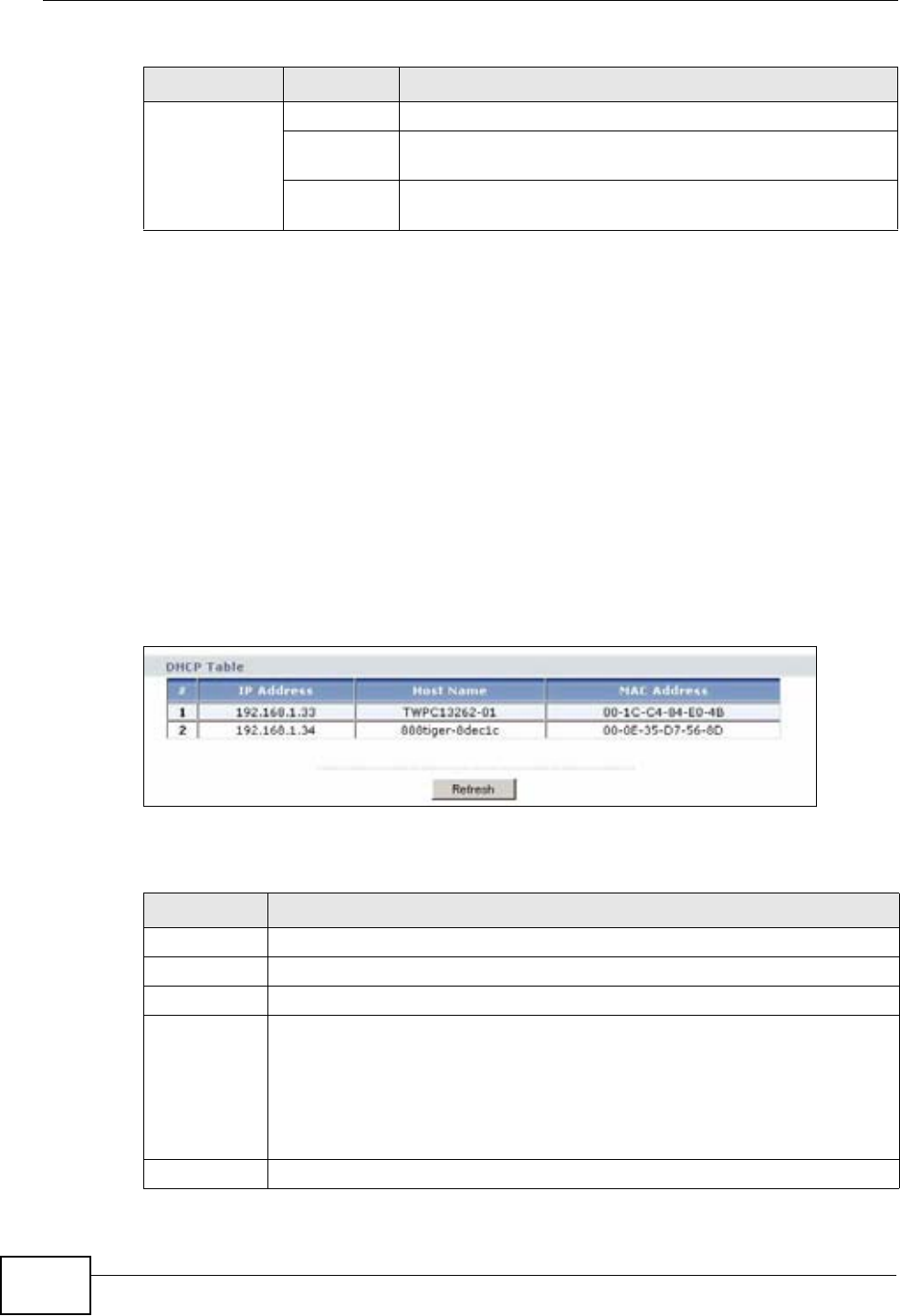
Chapter 2 Introducing the Web Configurator
P-320W v3 User’s Guide
32
2.4.2 Summary: DHCP Table
DHCP (Dynamic Host Configuration Protocol, RFC 2131 and RFC 2132) allows
individual clients to obtain TCP/IP configuration at start-up from a server. You can
configure the P-320W v3’s LAN and/or Guest WLAN as DHCP server(s) or disable
them. When configured as a server, the P-320W v3 provides the TCP/IP
configuration for the clients. If DHCP service is disabled, you must have another
DHCP server on that network, or else the computer must be manually configured.
Click the DHCP Table (Details...) hyperlink in the Status screen. Read-only
information here relates to your DHCP status. The DHCP table shows current
DHCP client information (including IP Address,Host Name and MAC Address)
of all network clients using the P-320W v3’s DHCP server.
Figure 9 Summary: DHCP Table
The following table describes the labels in this screen.
Tools Firmware Use this screen to upload firmware to your P-320W v3.
Configuratio
n
Use this screen to backup and restore the configuration or
reset the factory defaults to your P-320W v3.
Restart This screen allows you to reboot the P-320W v3 without
turning the power off.
Table 4 Sub-menus
LINK TAB FUNCTION
Table 5 Summary: DHCP Table
LABEL DESCRIPTION
# This is the index number of the client.
IP Address This field displays the IP address relative to the # field listed above.
Host Name This field displays the computer host name.
MAC Address This field shows the MAC address of the computer with the name in the
Host Name field.
Every Ethernet device has a unique MAC (Media Access Control) address
which uniquely identifies a device. The MAC address is assigned at the
factory and consists of six pairs of hexadecimal characters, for example,
00:A0:C5:00:00:02.
Refresh Click Refresh to renew the screen.
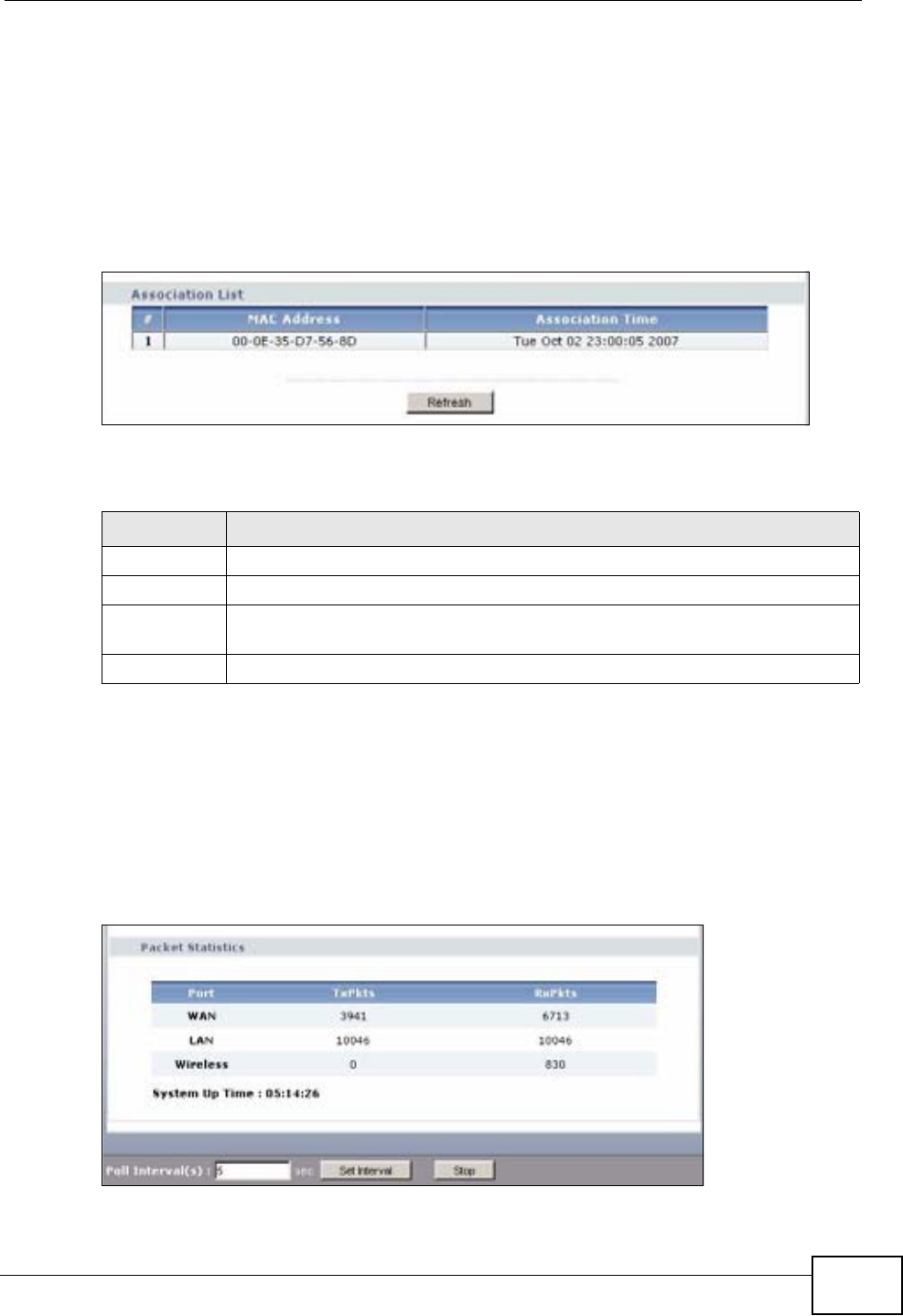
Chapter 2 Introducing the Web Configurator
P-320W v3 User’s Guide 33
2.4.3 Summary: Association List
Click the Association List (Details...) hyperlink in the Status screen. Read-only
information here includes the MAC address of a device and its time of association
with the P-320W v3. Association means that a wireless client (for example, your
network or computer with a wireless network card) has connected successfully to
the AP (or wireless router) using the same SSID, channel and security settings.
Figure 10 Summary: Association List
The following table describes the labels in this screen.
2.4.4 Summary: Statistics
Click the Statistics (Details...) hyperlink in the Status screen. Read-only
information here includes port status, packet specific statistics and the "system up
time". The Poll Interval(s) field is configurable and is used for refreshing the
screen.
Figure 11 Summary: Statistics
Table 6 Summary: Association List
LABEL DESCRIPTION
# This is the index number of the client.
MAC Address This shows the MAC address of the device associated with the P-320W v3.
Association
Time
This shows the date and time when the association with a device is made.
Refresh Click Refresh to renew the screen.
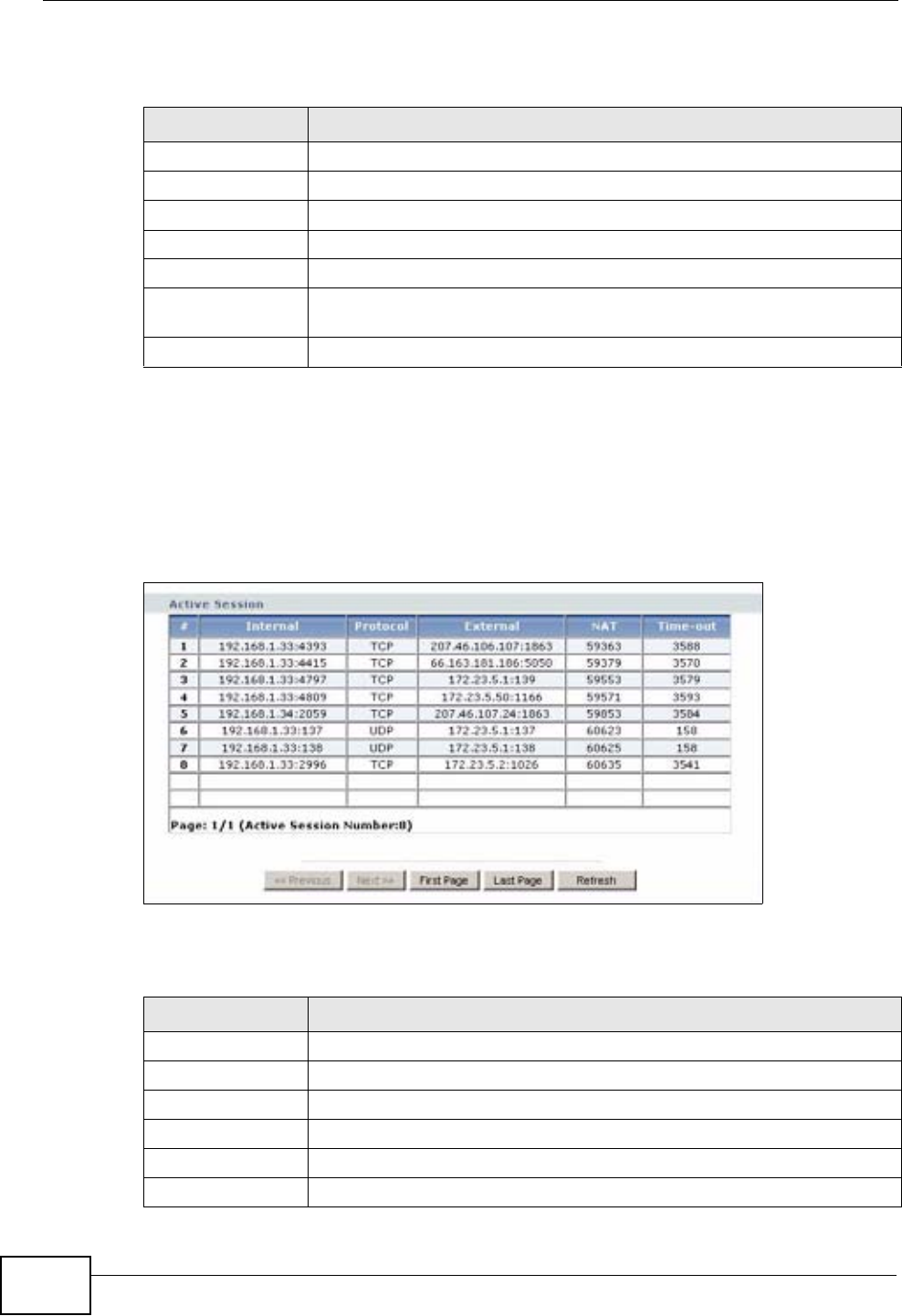
Chapter 2 Introducing the Web Configurator
P-320W v3 User’s Guide
34
The following table describes the labels in this screen.
2.4.5 Summary: Active Session
Click the Active Session (Details...) hyperlink in the Status screen. View a list
of devices that are currently associated to the P-320W v3 and read-only
information such as internal/external IP addresses and Time-out.
Figure 12 Summary: Active Session
The following table describes the labels in this screen.
Table 7 Summary: Statistics
LABEL DESCRIPTION
Port This is the P-320W v3’s port type.
TxPkts This is the number of transmitted packets on this port.
RxPkts This is the number of received packets on this port.
System Up Time This is the total time the P-320W v3 has been on.
Poll Interval(s) Enter the time interval for refreshing statistics in this field.
Set Interval Click this button to apply the new poll interval you entered in the Poll
Interval(s) field.
Stop Click Stop to stop refreshing statistics.
Table 8 Summary: Active Sessiont
LABEL DESCRIPTION
#This is the index number of the active session.
Internal This is the internal IP address of the device.
Protocol This is the transfer protocol used.
External This is the external IP address of the device.
NAT This is the numerical tag for the NAT entry.
Time out This is the time out value (in minutes) of the NAT entry.
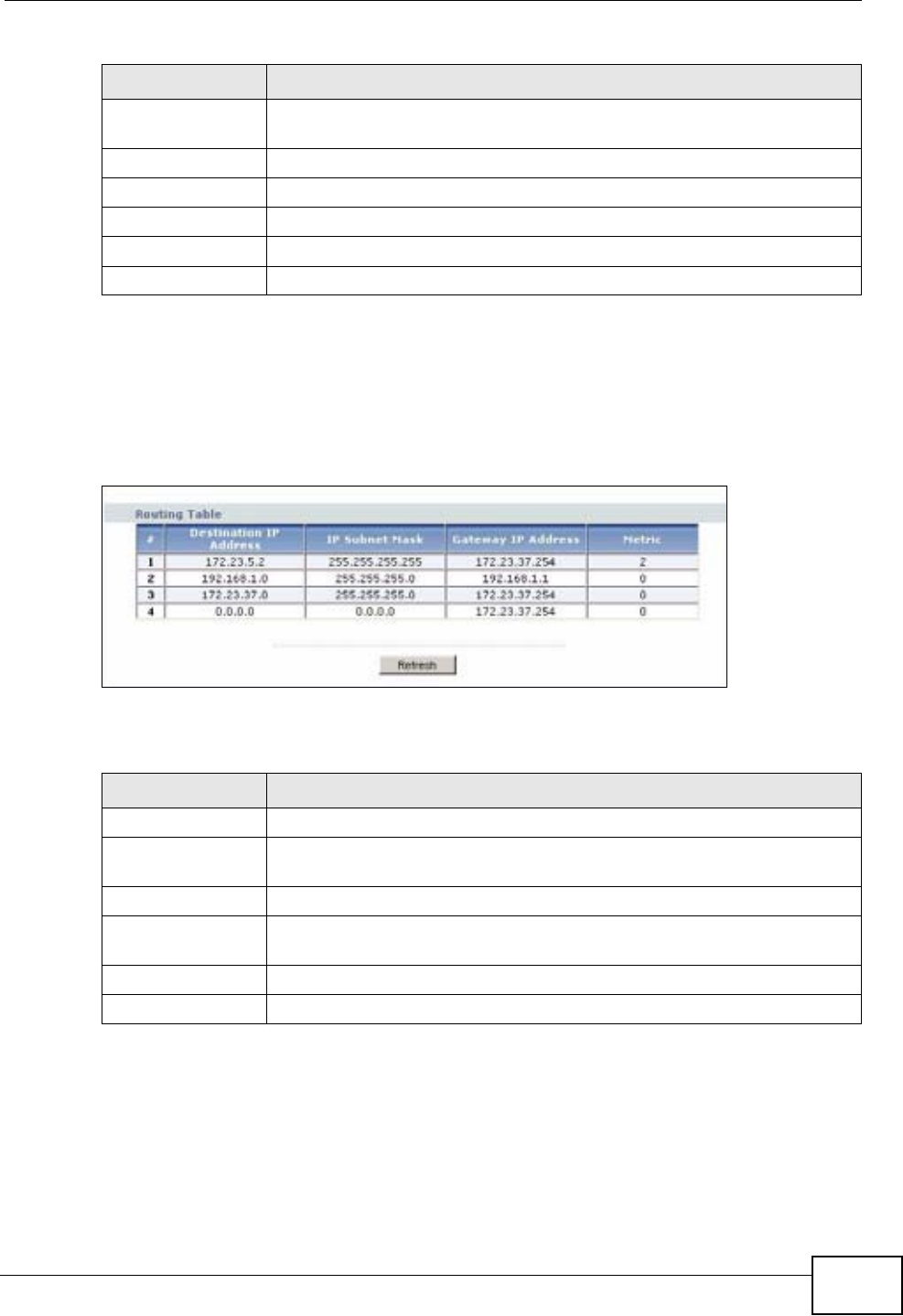
Chapter 2 Introducing the Web Configurator
P-320W v3 User’s Guide 35
2.4.6 Summary: Routing Table
Click the Routing Table (Details...) hyperlink in the Status screen. View a list of
the static routes configured in the P-320W v3.
Figure 13 Summary: Routing Table
The following table describes the labels in this screen.
Page... (Active
Session Number)
This shows the current page you are looking at as well as the total
number of pages of the association list.
Previous Click this to go to the previous page.
Next Click this to go to the next page.
First Page Click this to go to the first page.
Last Page Click this to go to the last page.
Refresh Click Refresh to renew the screen.
Table 8 Summary: Active Sessiont
LABEL DESCRIPTION
Table 9 Summary: Routing Table
LABEL DESCRIPTION
#This is the index number of the routing entry.
Destination IP
Address
This is the destination IP address of the outgoing traffic.
IP Subnet Mask This is teh IP subnet mask of the traffic.
Gateway IP
Address
This is the gateway IP address of the host computer.
Metric This is the numerical tag for the routing entry.
Refresh Click Refresh to renew the screen.

Chapter 2 Introducing the Web Configurator
P-320W v3 User’s Guide
36
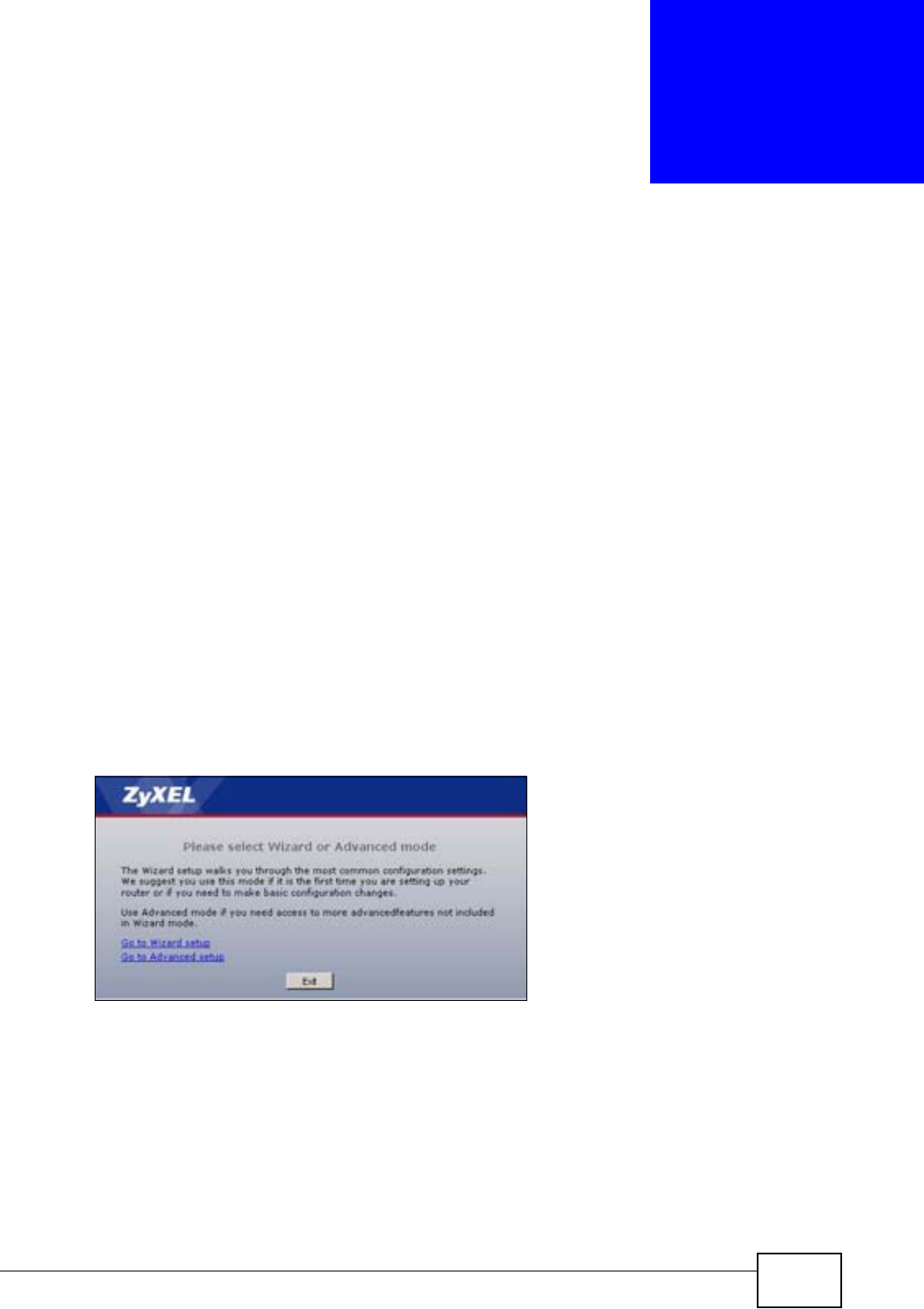
P-320W v3 User’s Guide 37
CHAPTER 3
Connection Wizard
This chapter provides information on the wizard setup screens in the web
configurator.
3.1 Wizard Setup
The web configurator’s wizard setup helps you configure your device to access the
Internet. Refer to your ISP (Internet Service Provider) checklist in the Quick Start
Guide to know what to enter in each field. Leave a field blank if you don’t have
that information.
1After you access the P-320W v3 web configurator, click the Go to Wizard setup
hyperlink.
You can click the Go to Advanced setup hyperlink to skip this wizard setup and
configure advanced features accordingly.
Figure 14 Select Wizard or Advanced Mode
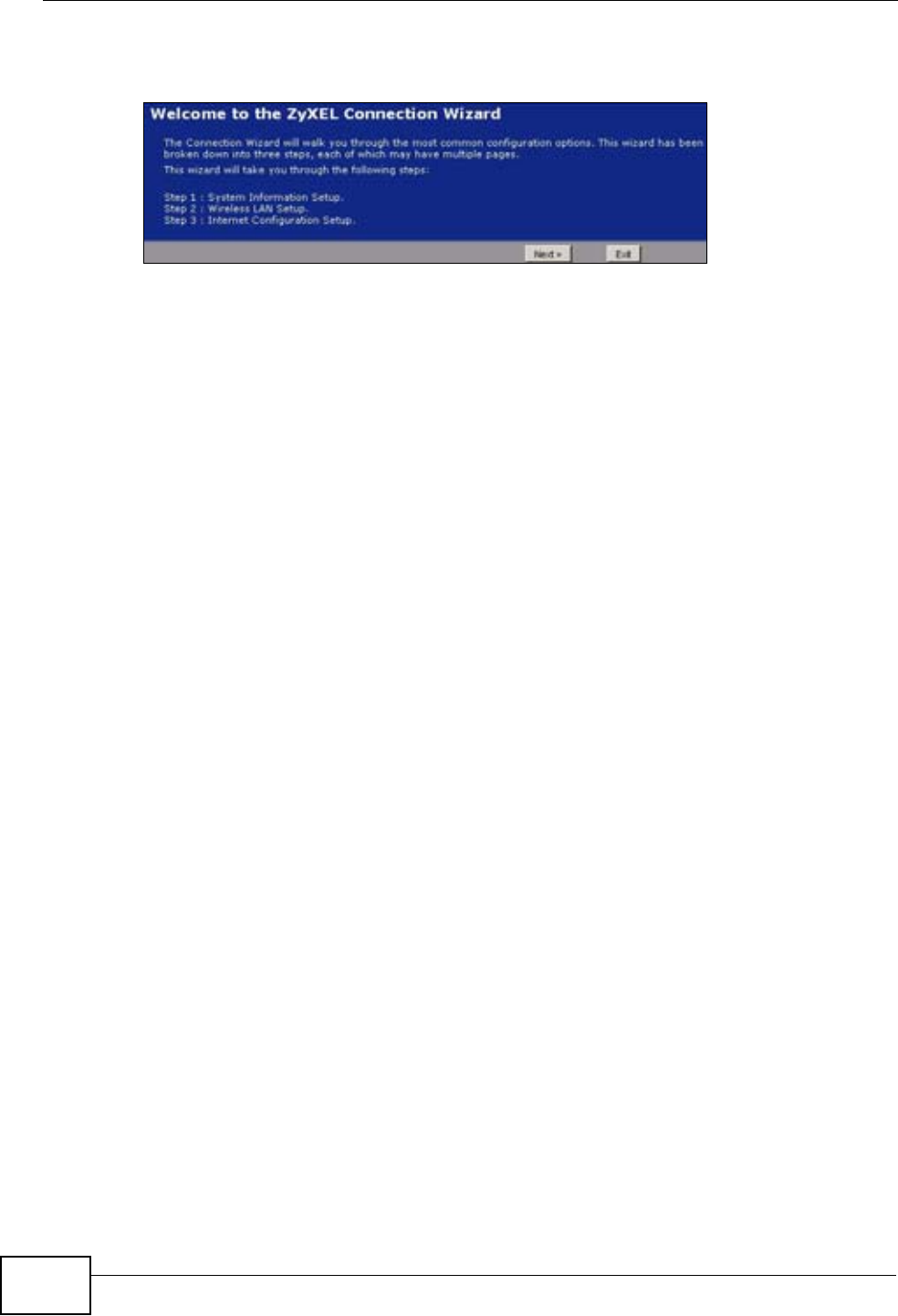
Chapter 3 Connection Wizard
P-320W v3 User’s Guide
38
2Read the on-screen information and click Next.
Figure 15 Welcome to the Connection Wizard
3.2 Connection Wizard: STEP 1: System
Information
System Information contains administrative and system-related information.
3.2.1 System Name
System Name is for identification purposes. However, because some ISPs check
this name you should enter your computer's "Computer Name".
• In Windows 95/98 click Start, Settings, Control Panel, Network. Click the
Identification tab, note the entry for the Computer Name field and enter it as
the System Name.
• In Windows 2000, click Start, Settings and Control Panel and then double-
click System. Click the Network Identification tab and then the Properties
button. Note the entry for the Computer name field and enter it as the
System Name.
• In Windows XP, click Start, My Computer, View system information and
then click the Computer Name tab. Note the entry in the Full computer
name field and enter it as the P-320W v3 System Name.
3.2.2 Domain Name
The Domain Name entry is what is propagated to the DHCP clients on the LAN. If
you leave this blank, the domain name obtained by DHCP from the ISP is used.
While you must enter the host name (System Name) on each individual computer,
the domain name can be assigned from the P-320W v3 via DHCP.
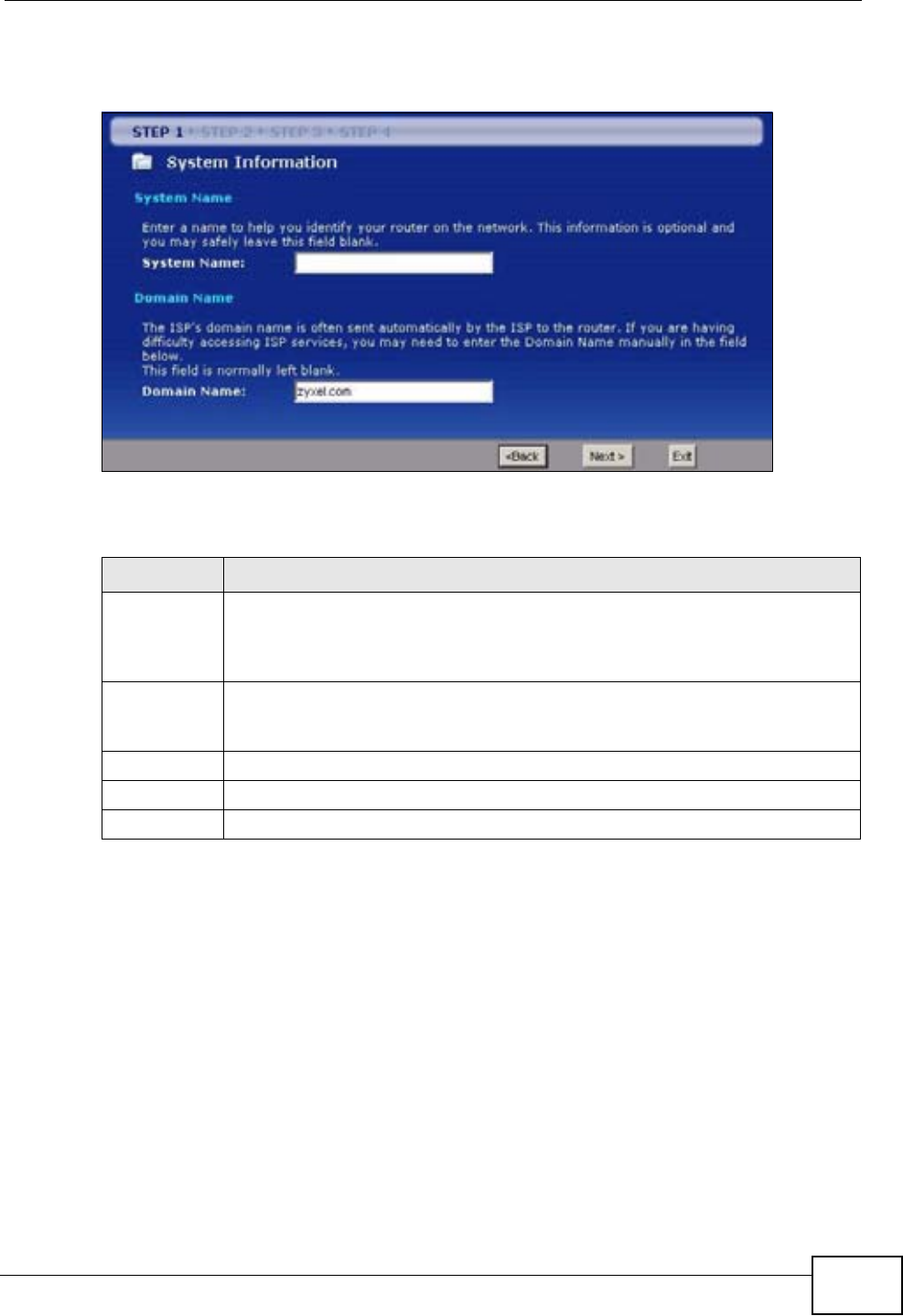
Chapter 3 Connection Wizard
P-320W v3 User’s Guide 39
Click Next to configure the P-320W v3 for Internet access.
Figure 16 Wizard Step 1: System Information
The following table describes the labels in this screen.
Table 10 Wizard Step 1: System Information
LABEL DESCRIPTION
System
Name
System Name is a unique name to identify the P-320W v3 in an Ethernet
network. Enter a descriptive name. This name can be up to 30
alphanumeric characters long. Spaces are not allowed, but dashes "-" and
underscores "_" are accepted.
Domain
Name
Type the domain name (if you know it) here. If you leave this field blank,
the ISP may assign a domain name via DHCP. The domain name entered
by you is given priority over the ISP assigned domain name.
Back Click Back to display the previous screen.
Next Click Next to proceed to the next screen.
Exit Click Exit to close the wizard screen without saving.
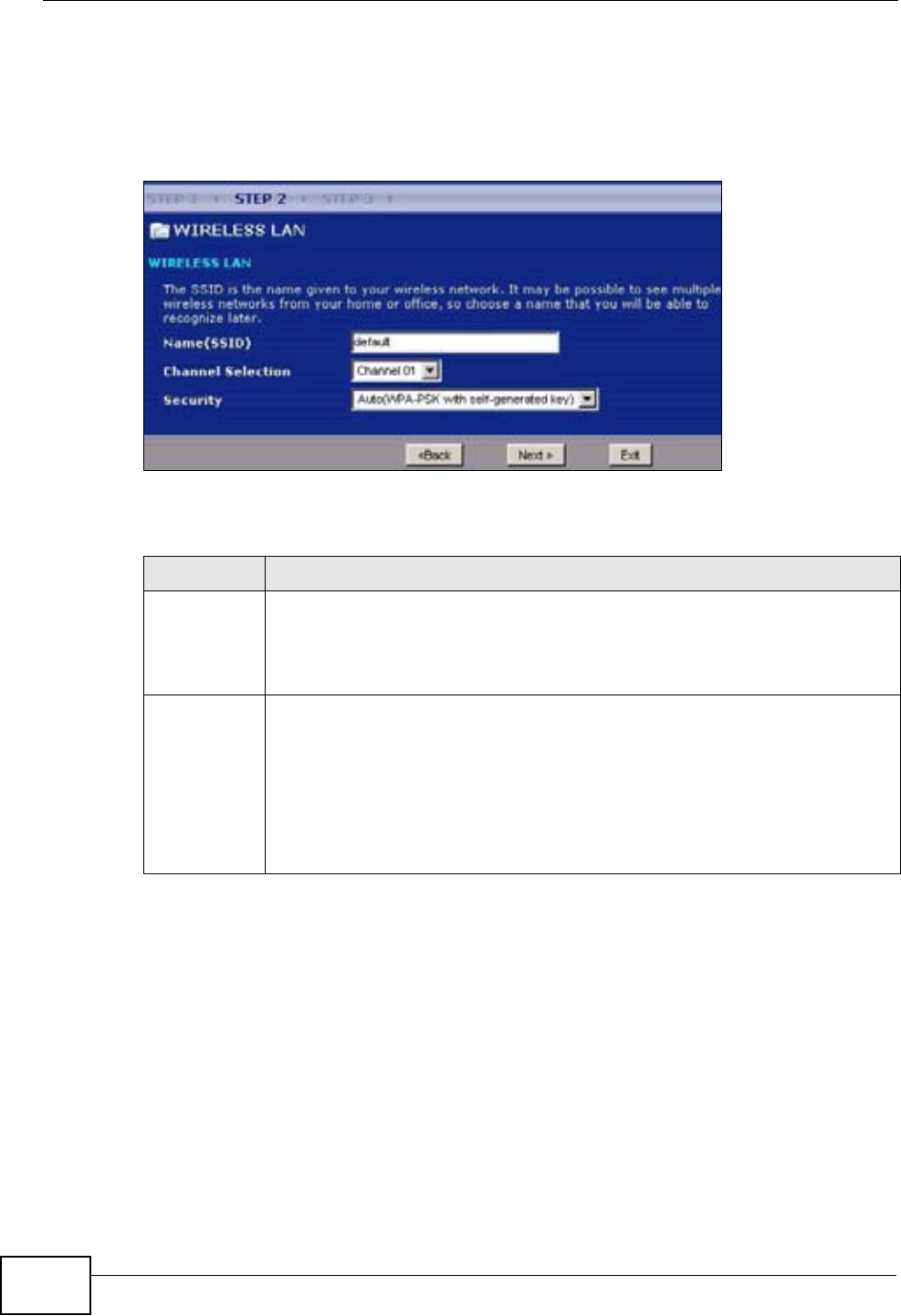
Chapter 3 Connection Wizard
P-320W v3 User’s Guide
40
3.3 Connection Wizard: STEP 2: Wireless LAN
Set up your wireless LAN using the following screen.
Figure 17 Wizard Step 2: Wireless LAN
The following table describes the labels in this screen.
Table 11 Wizard Step 2: Wireless LAN
LABEL DESCRIPTION
Name
(SSID)
Enter a descriptive name (up to 32 printable 7-bit ASCII characters) for the
wireless LAN.
If you change this field on the P-320W v3, make sure all wireless stations
use the same SSID in order to access the network.
Channel
Selection
The range of radio frequencies used by IEEE 802.11b/g wireless devices is
called a channel.
Select a channel that is not used by any nearby devices.
Note: To comply with US FCC regulation, the country selection
function has been completely removed from all US models. The
above function is for non-US models only.

Chapter 3 Connection Wizard
P-320W v3 User’s Guide 41
Note: The wireless stations and P-320W v3 must use the same SSID, channel ID and
WEP encryption key (if WEP is enabled), WPA-PSK (if WPA-PSK is enabled) or
WPA2-PSK (if WPA2-PSK is enabled) for wireless communication.
Security Select a Security level from the drop-down list box.
Choose Auto (WPA-PSK with self-generated key) to have the P-320W
v3 generate a pre-shared key automatically. A screen pops up displaying
the generated pre-shared key after you click Next. Write down the key for
use later when connecting other wireless devices to your network. Click OK
to continue.
Choose None to have no wireless LAN security configured. If you do not
enable any wireless security on your P-320W v3, your network is accessible
to any wireless networking device that is within range. If you choose this
option, skip directly to Section 3.4 on page 43.
Choose Basic (WEP) security if you want to configure WEP Encryption
parameters. If you choose this option, go directly to Section 3.3.1 on page
42.Basic (WEP) is only available when WPS (WiFi Protected Setup) is
disabled. See Section 4.3.5 on page 60 for more information about WPS.
Choose Extend (WPA-PSK with customized key) security to configure a
Pre-Shared Key. Choose this option only if your wireless clients support
WPA-PSK. If you choose this option, skip directly to Section 3.3.2 on page
43.
Back Click Back to display the previous screen.
Next Click Next to proceed to the next screen.
Exit Click Exit to close the wizard screen without saving.
Table 11 Wizard Step 2: Wireless LAN
LABEL DESCRIPTION
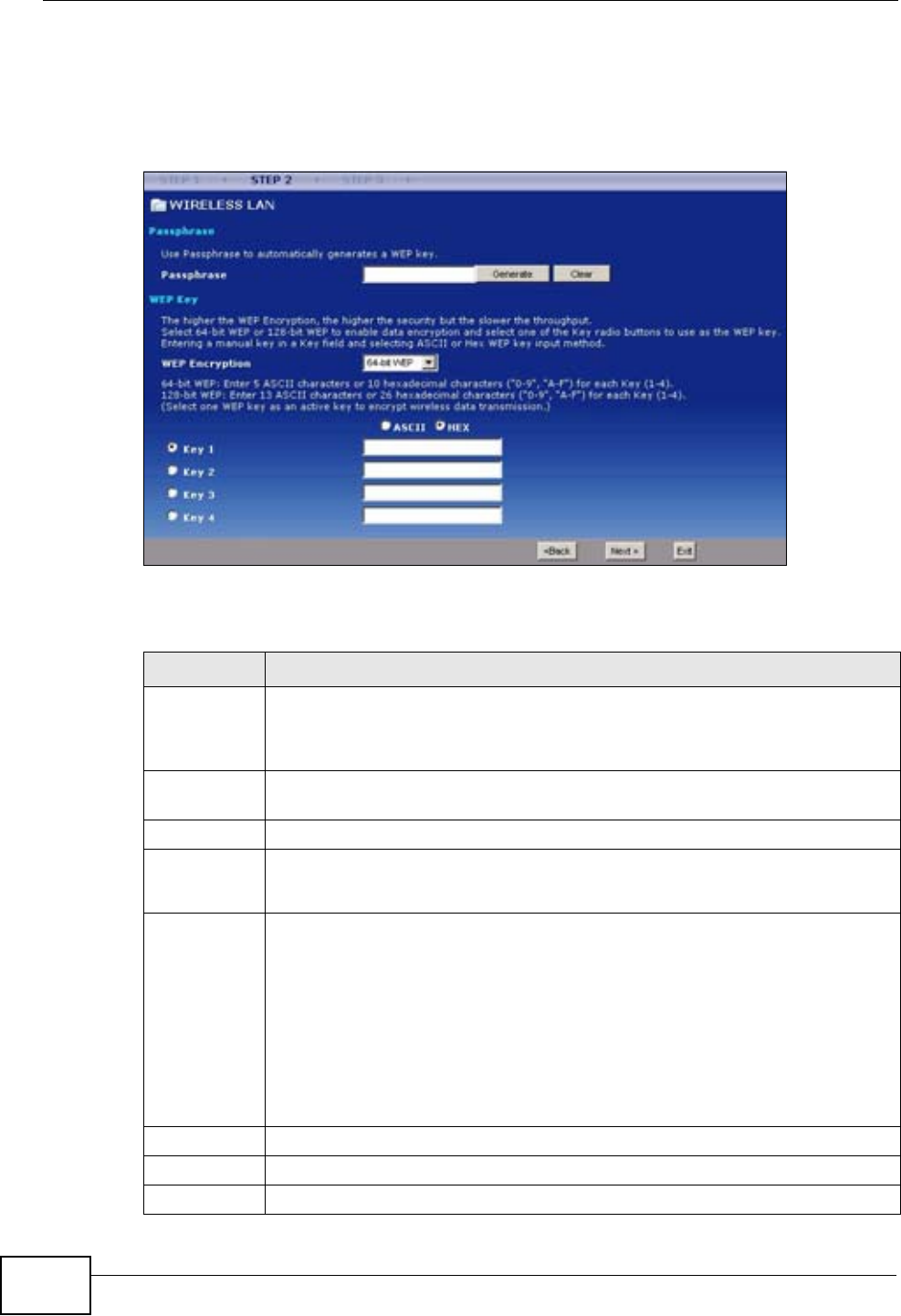
Chapter 3 Connection Wizard
P-320W v3 User’s Guide
42
3.3.1 Basic(WEP) Security
Choose Basic(WEP) to setup WEP Encryption parameters.
Figure 18 Wizard Step 2: Basic (WEP) Security
The following table describes the labels in this screen.
Table 12 Wizard Step 2: Basic (WEP) Security
LABEL DESCRIPTION
Passphrase Type a Passphrase (up to 32 printable characters) and click Generate. The
P-320W v3 automatically generates a WEP key.
Click Clear to make this field blank.
WEP
Encryption
Select 64-bit WEP or 128-bit WEP to allow data encryption.
ASCII Select this option in order to enter ASCII characters as the WEP keys.
HEX Select this option to enter hexadecimal characters as the WEP keys.
The preceding “0x” is entered automatically.
Key 1 to Key
4
The WEP keys are used to encrypt data. Both the P-320W v3 and the
wireless stations must use the same WEP key for data transmission.
If you chose 64-bit WEP, then enter any 5 ASCII characters or 10
hexadecimal characters ("0-9", "A-F").
If you chose 128-bit WEP, then enter 13 ASCII characters or 26
hexadecimal characters ("0-9", "A-F").
You must configure at least one key, only one key can be activated at any
one time. The default key is key 1.
Back Click Back to display the previous screen.
Next Click Next to proceed to the next screen.
Exit Click Exit to close the wizard screen without saving.
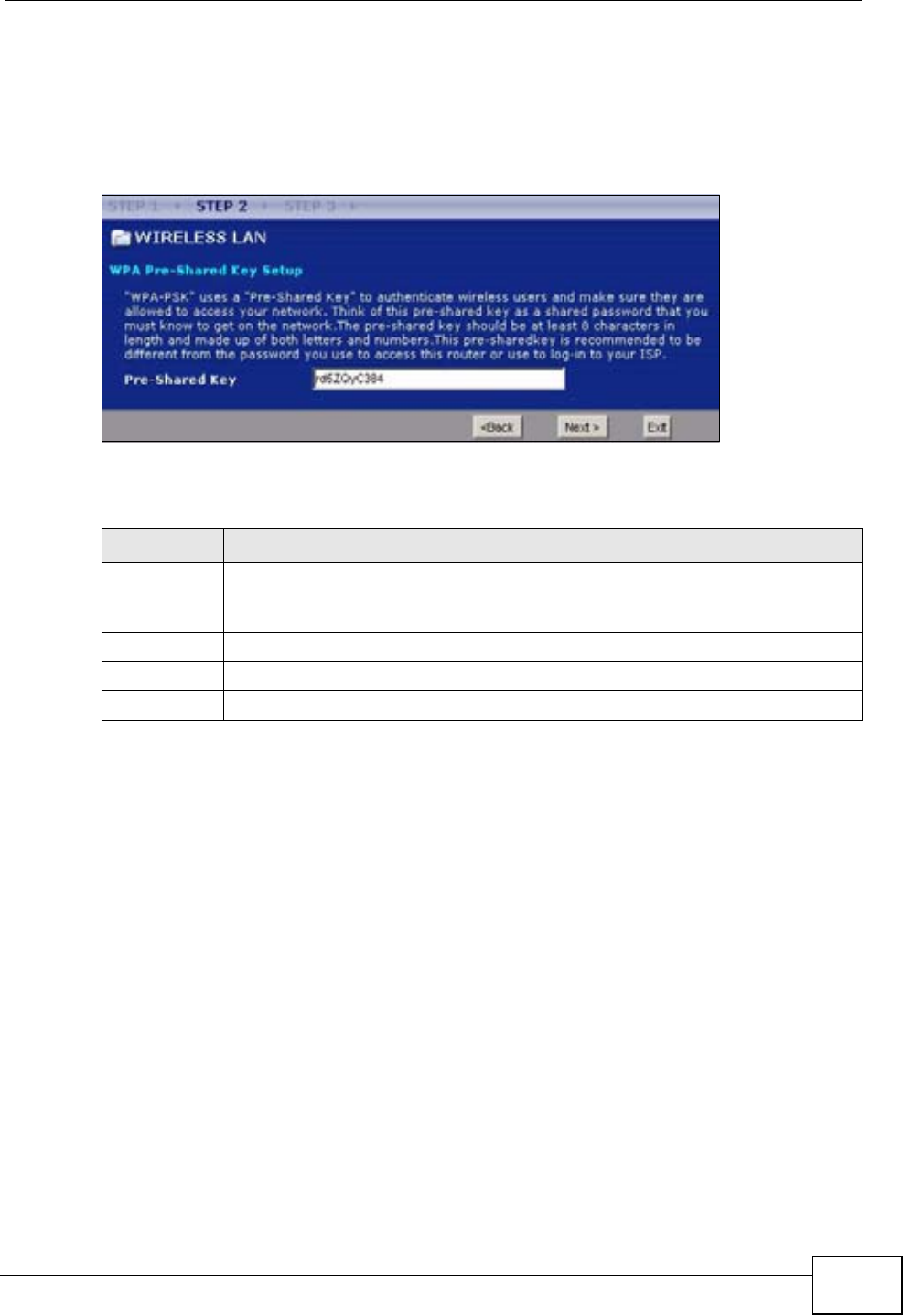
Chapter 3 Connection Wizard
P-320W v3 User’s Guide 43
3.3.2 Extend (WPA-PSK) Security
Choose Extend (WPA-PSK) security in the Wireless LAN setup screen to set up a
Pre-Shared Key.
Figure 19 Wizard Step 2: Extend (WPA-PSK) Security
The following table describes the labels in this screen.
3.4 Connection Wizard: STEP 3: Internet
Configuration
The P-320W v3 offers three Internet connection types. They are Ethernet,PPP
over Ethernet or PPTP. The wizard attempts to detect which WAN connection
type you are using. If the wizard does not detect a connection type, you must
select one from the drop-down list box. Check with your ISP to make sure you use
the correct type.
Table 13 Wizard Step 2: Extend (WPA-PSK) Security
LABEL DESCRIPTION
Pre-Shared
Key
Type from 8 to 63 case-sensitive ASCII characters. You can set up the most
secure wireless connection by configuring WPA in the wireless LAN screens.
You need to configure an authentication server to do this.
Back Click Back to display the previous screen.
Next Click Next to proceed to the next screen.
Exit Click Exit to close the wizard screen without saving.
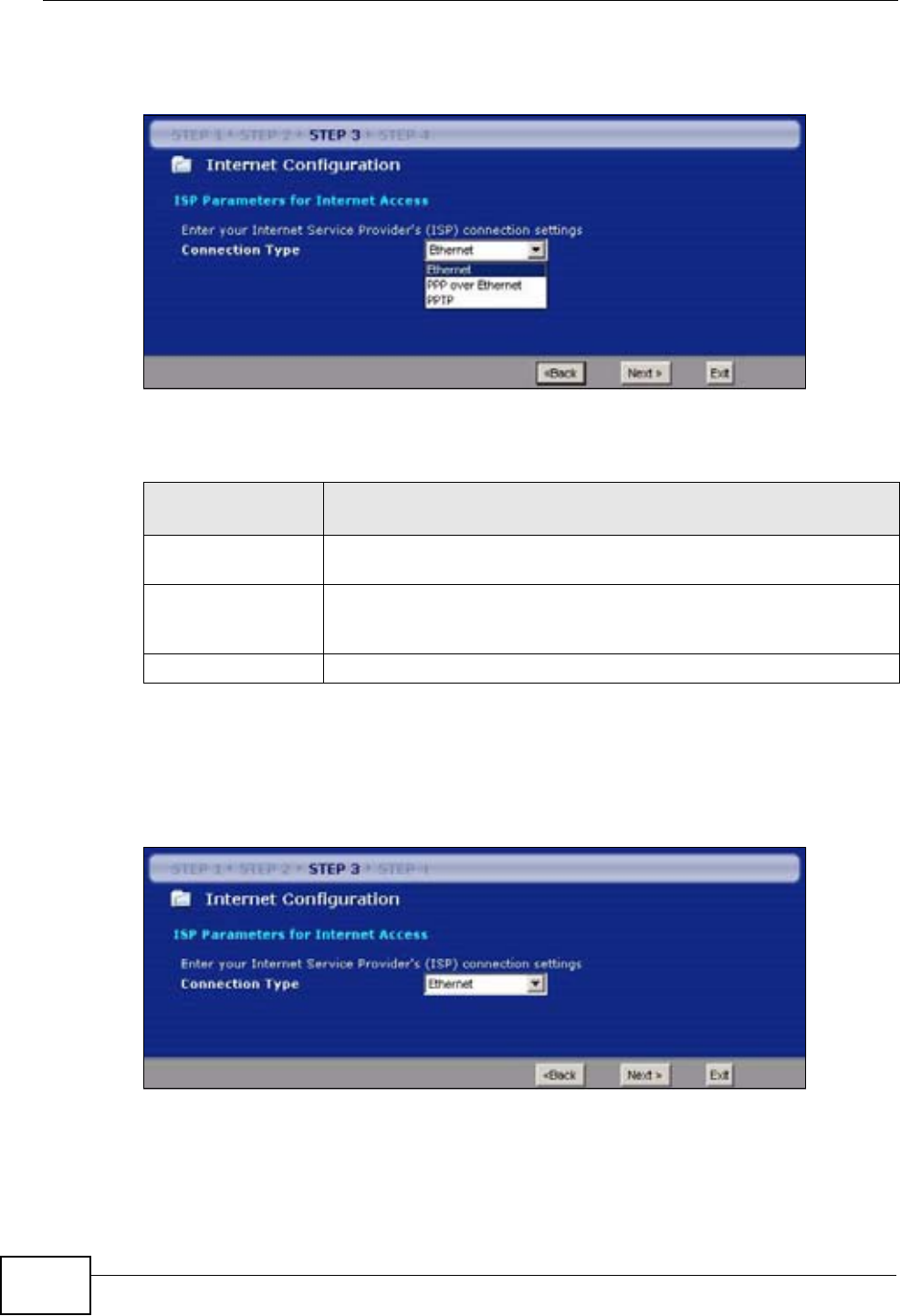
Chapter 3 Connection Wizard
P-320W v3 User’s Guide
44
This wizard screen varies according to the connection type that you select.
Figure 20 Wizard Step 3: ISP Parameters.
The following table describes the labels in this screen,
3.4.1 Ethernet Connection
Choose Ethernet when the WAN port is used as a regular Ethernet.
Figure 21 Wizard Step 3: Ethernet Connection
3.4.2 PPPoE Connection
Point-to-Point Protocol over Ethernet (PPPoE) functions as a dial-up connection.
PPPoE is an IETF (Internet Engineering Task Force) standard specifying how a host
Table 14 Wizard Step 3: ISP Parameters
CONNECTION
TYPE DESCRIPTION
Ethernet Select the Ethernet option when the WAN port is used as a regular
Ethernet.
PPPoE Select the PPP over Ethernet option for a dial-up connection. If
your ISP gave you an IP address and/or subnet mask, then select
PPTP.
PPTP Select the PPTP option for a dial-up connection.
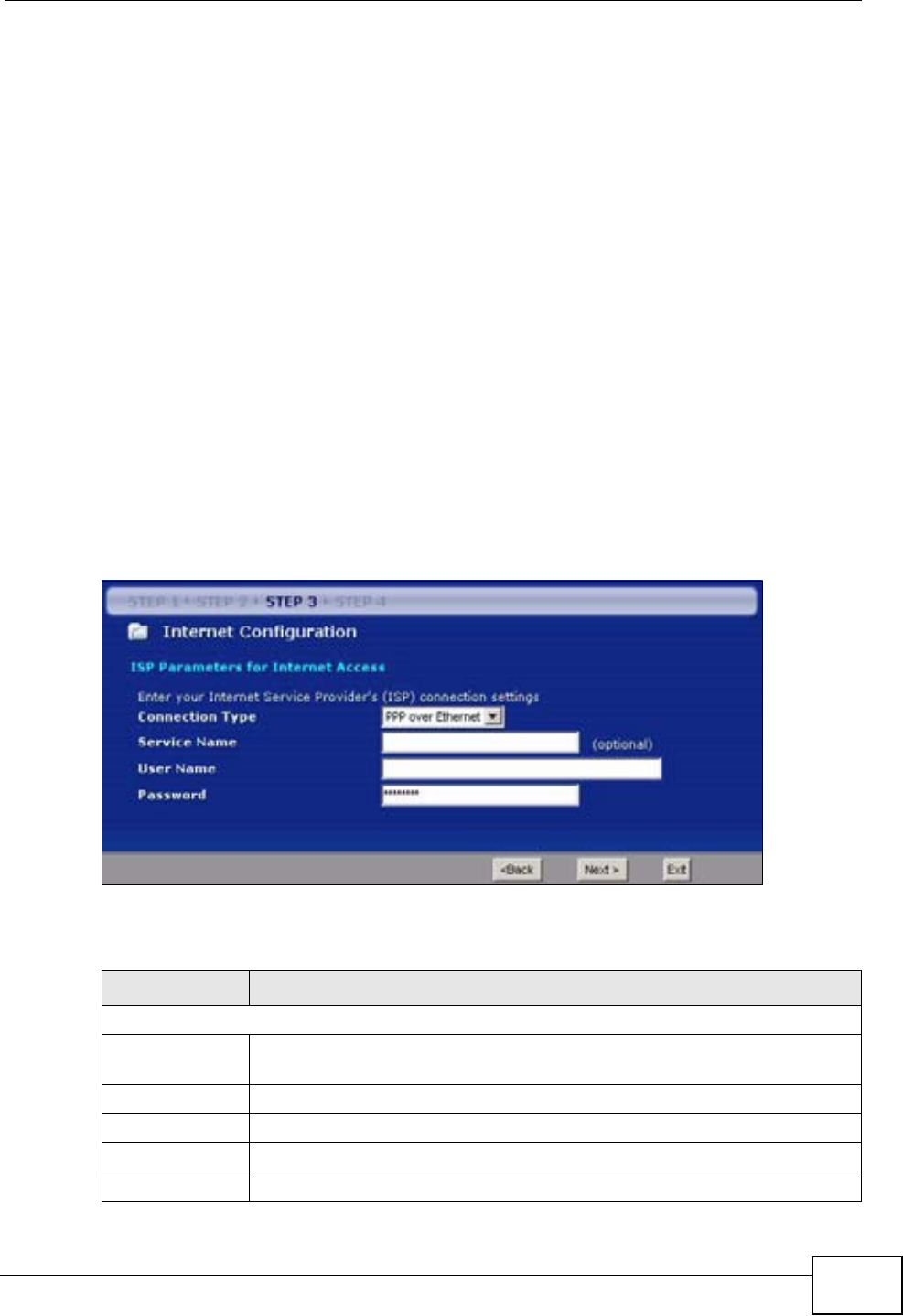
Chapter 3 Connection Wizard
P-320W v3 User’s Guide 45
personal computer interacts with a broadband modem (for example DSL, cable,
wireless, etc.) to achieve access to high-speed data networks.
For the service provider, PPPoE offers an access and authentication method that
works with existing access control systems (for instance, RADIUS).
One of the benefits of PPPoE is the ability to let end users access one of multiple
network services, a function known as dynamic service selection. This enables the
service provider to easily create and offer new IP services for specific users.
Operationally, PPPoE saves significant effort for both the subscriber and the ISP/
carrier, as it requires no specific configuration of the broadband modem at the
subscriber’s site.
By implementing PPPoE directly on the P-320W v3 (rather than individual
computers), the computers on the LAN do not need PPPoE software installed,
since the P-320W v3 does that part of the task. Furthermore, with NAT, all of the
LAN's computers will have Internet access.
Refer to the appendix for more information on PPPoE.
Figure 22 Wizard Step 3: PPPoE Connection
The following table describes the labels in this screen.
Table 15 Wizard Step 3: PPPoE Connection
LABEL DESCRIPTION
ISP Parameter for Internet Access
Connection
Type
Select the PPP over Ethernet option for a dial-up connection.
Service Name Type the name of your service provider.
User Name Type the user name given to you by your ISP.
Password Type the password associated with the user name above.
Back Click Back to return to the previous screen.
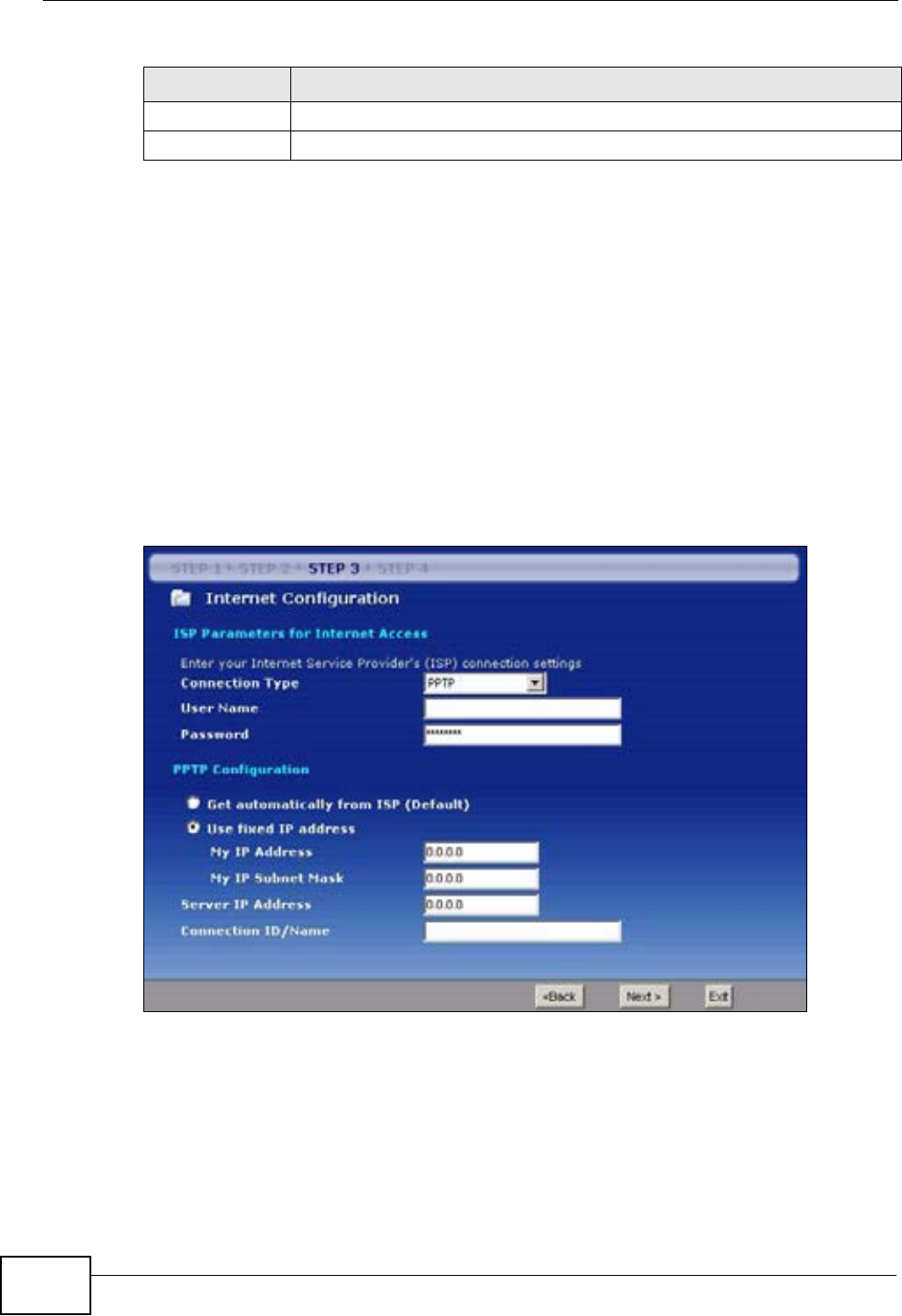
Chapter 3 Connection Wizard
P-320W v3 User’s Guide
46
3.4.3 PPTP Connection
Point-to-Point Tunneling Protocol (PPTP) is a network protocol that enables
transfers of data from a remote client to a private server, creating a Virtual Private
Network (VPN) using TCP/IP-based networks.
PPTP supports on-demand, multi-protocol, and virtual private networking over
public networks, such as the Internet.
Refer to the appendix for more information on PPTP.
Note: The P-320W v3 supports one PPTP server connection at any given time.
Figure 23 Wizard Step 3: PPTP Connection
Next Click Next to continue.
Exit Click Exit to close the wizard screen without saving.
Table 15 Wizard Step 3: PPPoE Connection
LABEL DESCRIPTION
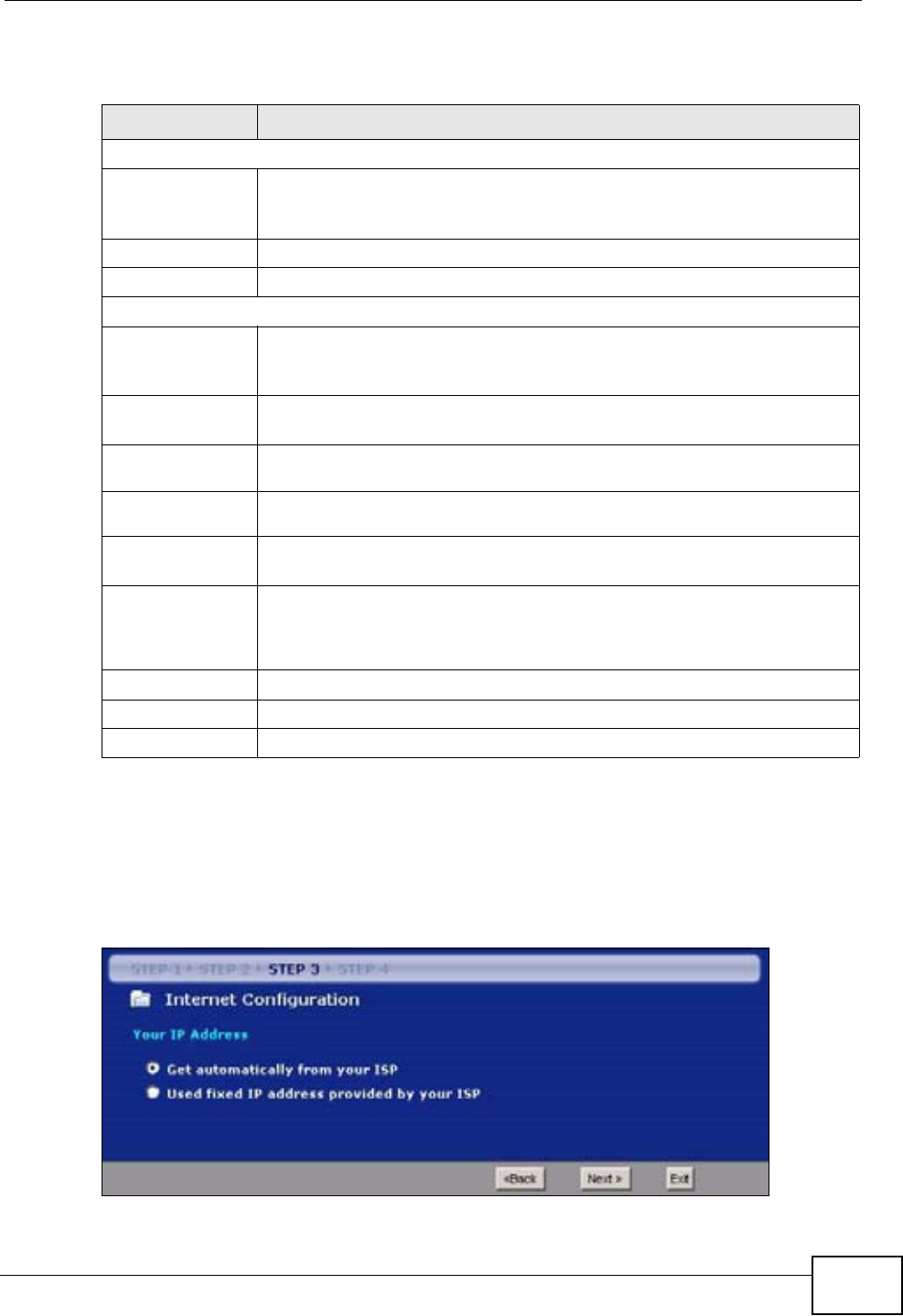
Chapter 3 Connection Wizard
P-320W v3 User’s Guide 47
The following table describes the fields in this screen
3.4.4 Your IP Address
The following wizard screen allows you to assign a fixed IP address or give the P-
320W v3 an automatically assigned IP address depending on your ISP.
Figure 24 Wizard Step 3: Your IP Address
Table 16 Wizard Step 3: PPTP Connection
LABEL DESCRIPTION
ISP Parameters for Internet Access
Connection Type Select PPTP from the drop-down list box. To configure a PPTP client,
you must configure the User Name and Password fields for a PPP
connection and the PPTP parameters for a PPTP connection.
User Name Type the user name given to you by your ISP.
Password Type the password associated with the User Name above.
PPTP Configuration
Get
automatically
from ISP
Select this radio button if your ISP did not assign you a fixed IP
address.
Use fixed IP
address
Select this radio button, provided by your ISP to give the P-320W v3 a
fixed, unique IP address.
My IP
Address Type the (static) IP address assigned to you by your ISP.
My IP Subnet
Mask Type the subnet mask assigned to you by your ISP (if given).
Server IP
Address
Type the IP address of the PPTP server.
Connection ID/
Name
Enter the connection ID or connection name in this field. It must follow
the "c:id" and "n:name" format. For example, C:12 or N:My ISP.
This field is optional and depends on the requirements of your ISP.
Back Click Back to return to the previous screen.
Next Click Next to continue.
Exit Click Exit to close the wizard screen without saving.
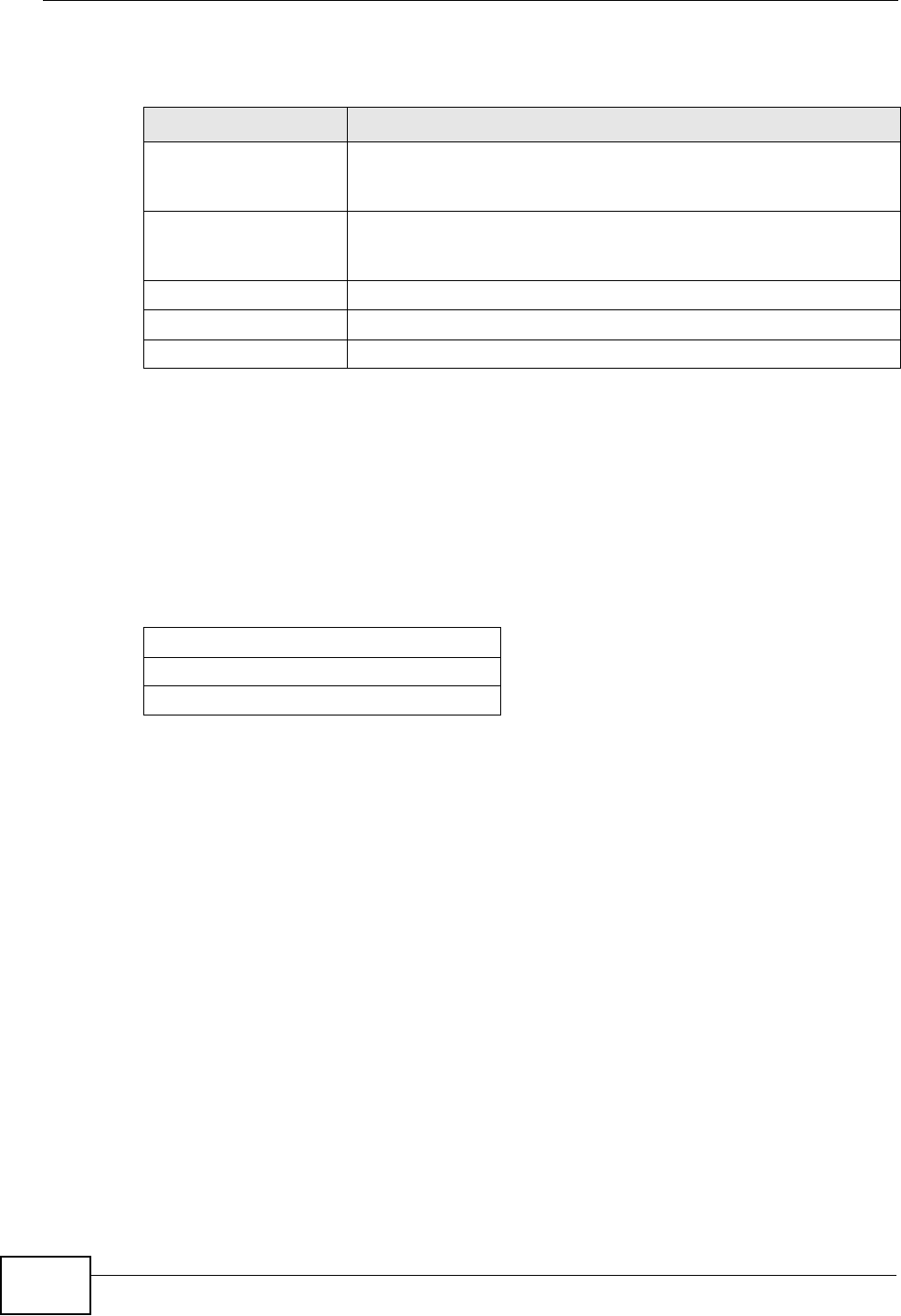
Chapter 3 Connection Wizard
P-320W v3 User’s Guide
48
The following table describes the labels in this screen
3.4.5 WAN IP Address Assignment
Every computer on the Internet must have a unique IP address. If your networks
are isolated from the Internet, for instance, only between your two branch offices,
you can assign any IP addresses to the hosts without problems. However, the
Internet Assigned Numbers Authority (IANA) has reserved the following three
blocks of IP addresses specifically for private networks.
You can obtain your IP address from the IANA, from an ISP or have it assigned by
a private network. If you belong to a small organization and your Internet access
is through an ISP, the ISP can provide you with the Internet addresses for your
local networks. On the other hand, if you are part of a much larger organization,
you should consult your network administrator for the appropriate IP addresses.
Note: Regardless of your particular situation, do not create an arbitrary IP address;
always follow the guidelines above. For more information on address
assignment, please refer to RFC 1597, Address Allocation for Private Internets
and RFC 1466, Guidelines for Management of IP Address Space.
3.4.6 IP Address and Subnet Mask
Similar to the way houses on a street share a common street name, so too do
computers on a LAN share one common network number.
Where you obtain your network number depends on your particular situation. If
the ISP or your network administrator assigns you a block of registered IP
Table 17 Wizard Step 3: Your IP Address
LABEL DESCRIPTION
Get automatically from
your ISP
Select this option If your ISP did not assign you a fixed IP
address. This is the default selection. If you choose this option,
skip directly to section Section 3.4.9 on page 51.
Use fixed IP address
provided by your ISP
Select this option if you were given IP address and/or DNS server
settings by the ISP. The fixed IP address should be in the same
subnet as your broadband modem or router.
Back Click Back to return to the previous screen.
Next Click Next to continue.
Exit Click Exit to close the wizard screen without saving.
Table 18 Private IP Address Ranges
10.0.0.0 -10.255.255.255
172.16.0.0 -172.31.255.255
192.168.0.0 -192.168.255.255

Chapter 3 Connection Wizard
P-320W v3 User’s Guide 49
addresses, follow their instructions in selecting the IP addresses and the subnet
mask.
If the ISP did not explicitly give you an IP network number, then most likely you
have a single user account and the ISP will assign you a dynamic IP address when
the connection is established. The Internet Assigned Number Authority (IANA)
reserved this block of addresses specifically for private use; please do not use any
other number unless you are told otherwise. Let's say you select 192.168.1.0 as
the network number; which covers 254 individual addresses, from 192.168.1.1 to
192.168.1.254 (zero and 255 are reserved). In other words, the first three
numbers specify the network number while the last number identifies an individual
computer on that network.
Once you have decided on the network number, pick an IP address that is easy to
remember, for instance, 192.168.1.1, for your P-320W v3, but make sure that no
other device on your network is using that IP address.
The subnet mask specifies the network number portion of an IP address. Your P-
320W v3 will compute the subnet mask automatically based on the IP address
that you entered. You don't need to change the subnet mask computed by the P-
320W v3 unless you are instructed to do otherwise.
3.4.7 DNS Server Address Assignment
Use DNS (Domain Name System) to map a domain name to its corresponding IP
address and vice versa, for instance, the IP address of www.zyxel.com is
204.217.0.2. The DNS server is extremely important because without it, you must
know the IP address of a computer before you can access it.
The P-320W v3 can get the DNS server addresses in the following ways.
1The ISP tells you the DNS server addresses, usually in the form of an information
sheet, when you sign up. If your ISP gives you DNS server addresses, enter them
in the DNS Server fields in the Wizard and/or WAN > Internet Connection
screen.
2If the ISP did not give you DNS server information, leave the DNS Server fields
set to 0.0.0.0 in the Wizard screen and/or set to From ISP in the WAN >
Internet Connection screen for the ISP to dynamically assign the DNS server IP
addresses.
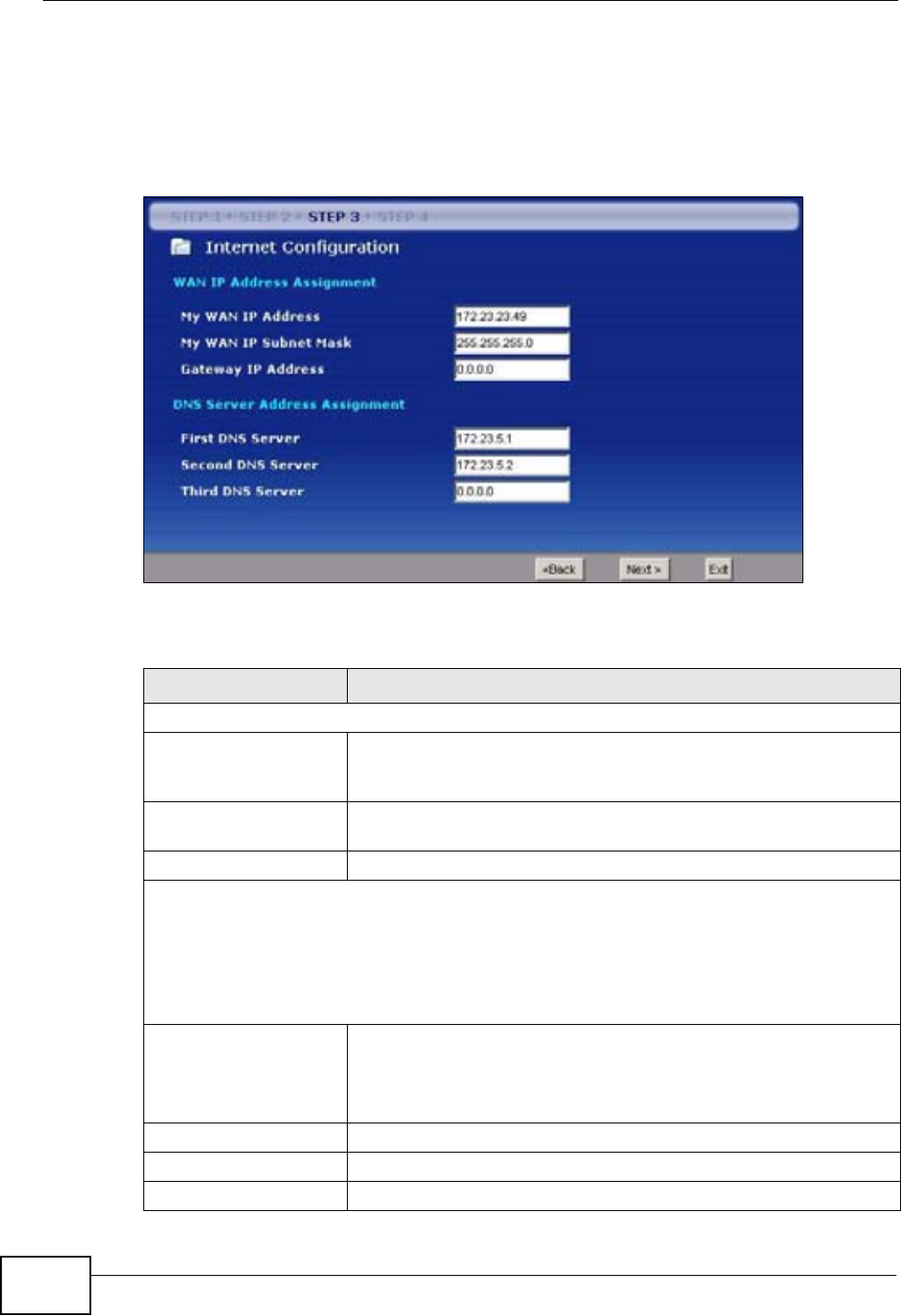
Chapter 3 Connection Wizard
P-320W v3 User’s Guide
50
3.4.8 WAN IP and DNS Server Address Assignment
The following wizard screen allows you to assign a fixed WAN IP address and DNS
server addresses.
Figure 25 Wizard Step 3: WAN IP and DNS Server Addresses
The following table describes the labels in this screen
Table 19 Wizard Step 3: WAN IP and DNS Server Addresses
LABEL DESCRIPTION
WAN IP Address Assignment
My WAN IP Address Enter your WAN IP address in this field. The WAN IP address
should be in the same subnet as your DSL/Cable modem or
router.
My WAN IP Subnet
Mask
Enter the IP subnet mask in this field.
Gateway IP Address Enter the gateway IP address in this field.
System DNS Server Address Assignment (if applicable)
DNS (Domain Name System) is for mapping a domain name to its corresponding IP
address and vice versa. The DNS server is extremely important because without it, you
must know the IP address of a computer before you can access it. The P-320W v3 uses a
system DNS server (in the order you specify here) to resolve domain names for DDNS and
the time server.
First DNS Server
Second DNS Server
Third DNS Server
Enter the DNS server's IP address in the fields provided.
If you do not configure a system DNS server, you must use IP
addresses when configuring DDNS and the time server.
Back Click Back to return to the previous screen.
Next Click Next to continue.
Exit Click Exit to close the wizard screen without saving.
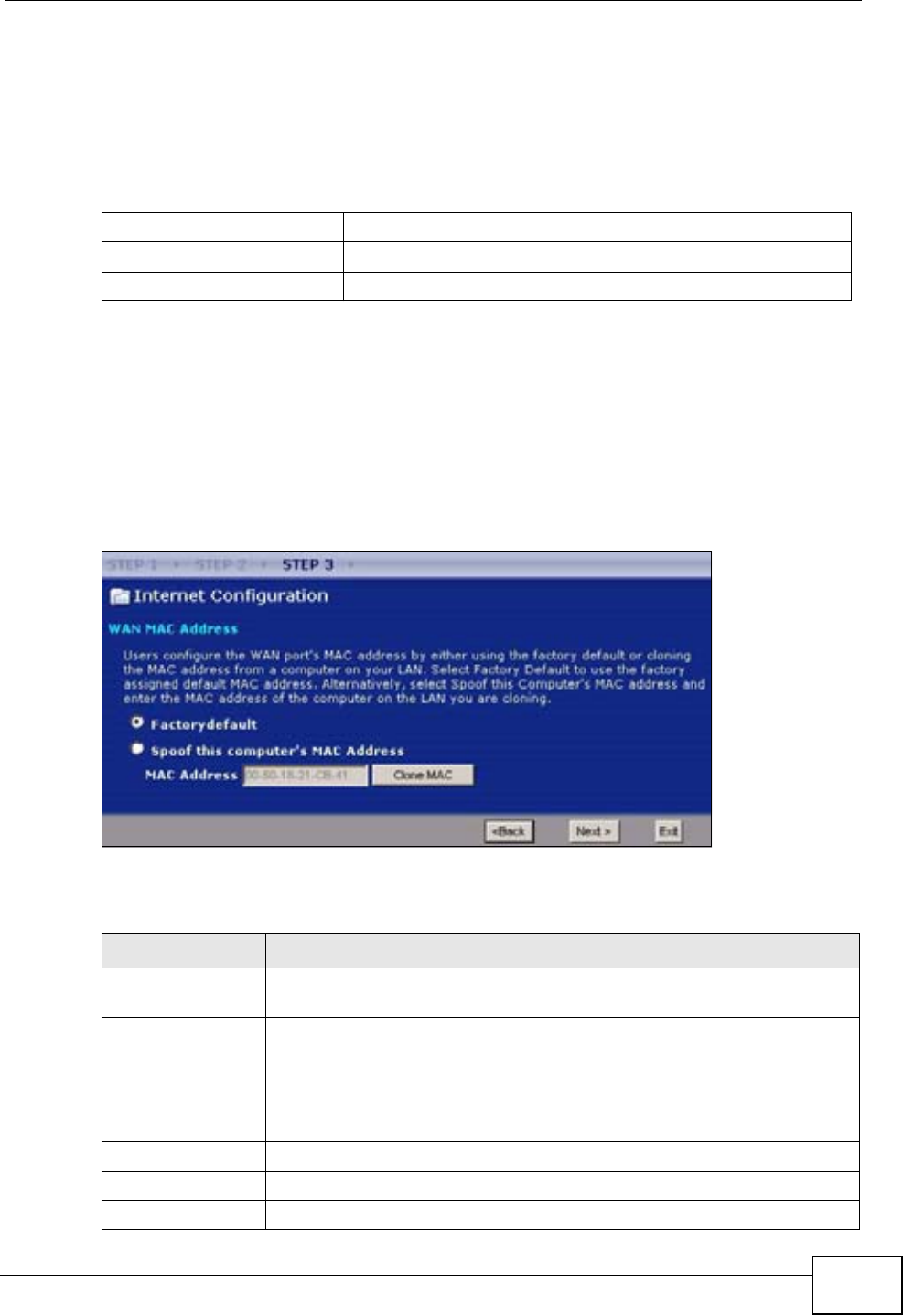
Chapter 3 Connection Wizard
P-320W v3 User’s Guide 51
3.4.9 WAN MAC Address
Every Ethernet device has a unique MAC (Media Access Control) address. The MAC
address is assigned at the factory and consists of six pairs of hexadecimal
characters, for example, 00:A0:C5:00:00:02.
This screen allows users to configure the WAN port's MAC address by either using
the P-320W v3’s MAC address, copying the MAC address from a computer on your
LAN or manually entering a MAC address. Once it is successfully configured, the
address will be copied to the "rom" file (ZyNOS configuration file). It will not
change unless you change the setting or upload a different "rom" file. It is
advisable to clone the MAC address from a computer on your LAN even if your ISP
does not presently require MAC address authentication.
Figure 26 Wizard Step 3: WAN MAC Address
The following table describes the fields in this screen.
Table 20 Example of Network Properties for LAN Servers with Fixed IP Addresses
Choose an IP address 192.168.1.2-192.168.1.32; 192.168.1.65-192.168.1.254.
Subnet mask 255.255.255.0
Gateway (or default route) 192.168.1.1(P-320W v3 LAN IP)
Table 21 Wizard Step 3: WAN MAC Address
LABEL DESCRIPTION
Factory Default Select Factory Default to use the factory assigned default MAC
address.
Spoof the
computer’s MAC
address
Select this option, enter the IP address of the computer on the LAN
whose MAC you are cloning and click Clone MAC.
It is advisable to clone the MAC address from a computer on your LAN
even if your ISP does not presently require MAC address
authentication.
Back Click Back to return to the previous screen.
Next Click Next to continue.
Exit Click Exit to close the wizard screen without saving.
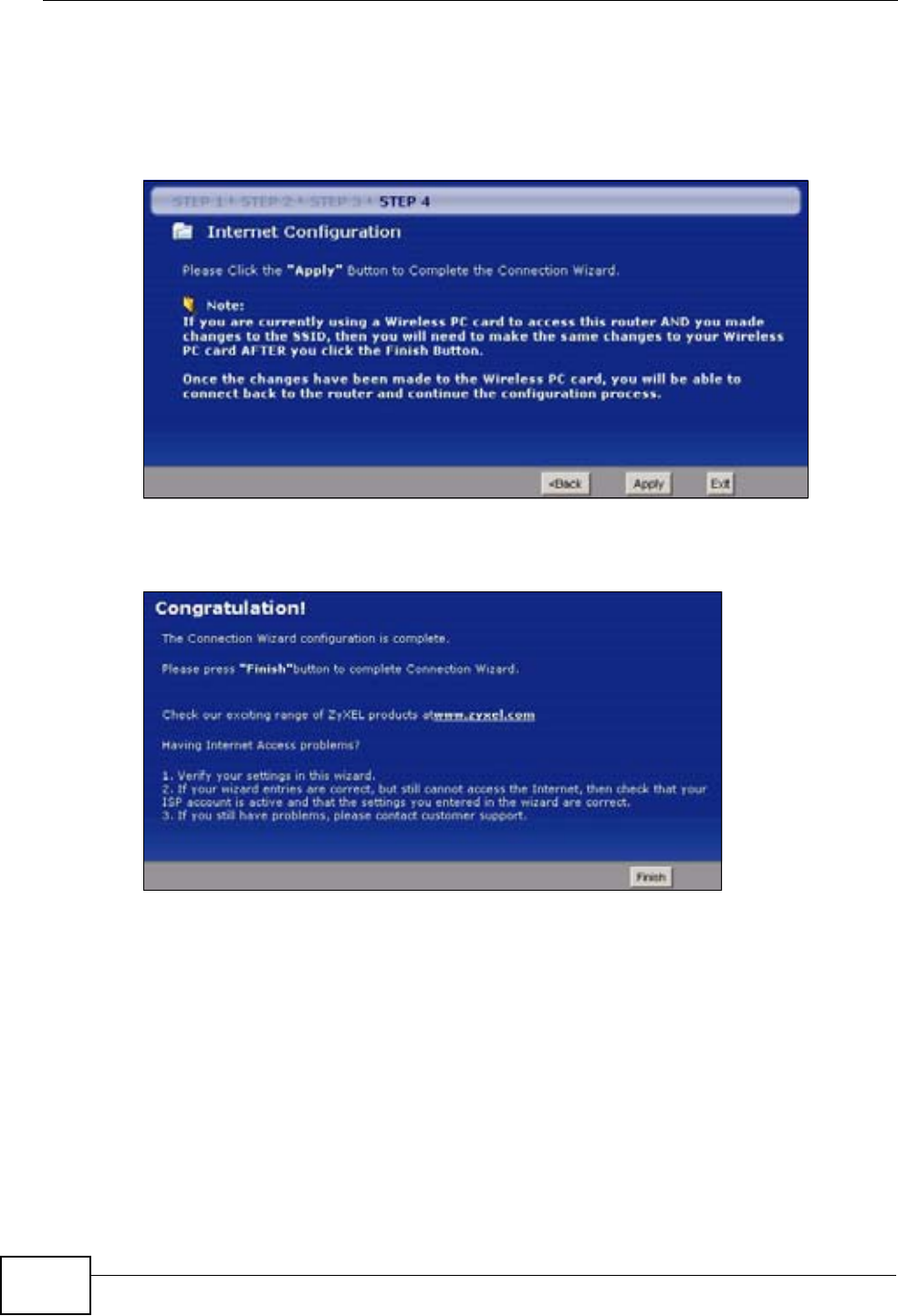
Chapter 3 Connection Wizard
P-320W v3 User’s Guide
52
3.5 Connection Wizard Complete
Click Apply to save your configuration.
Figure 27 Connection Wizard Save
Follow the on-screen instructions and click Finish to complete the wizard setup.
Figure 28 Connection Wizard Complete
Well done! You have successfully set up your P-320W v3 to operate on your
network and access the Internet.

53
PART II
Network
Wireless LAN (55)
Wireless Tutorial (77)
WAN (107)
LAN (85)
Guest WLAN (117)
DHCP Server (89)
Network Address Translation (NAT) (93)
Dynamic DNS (123)

54
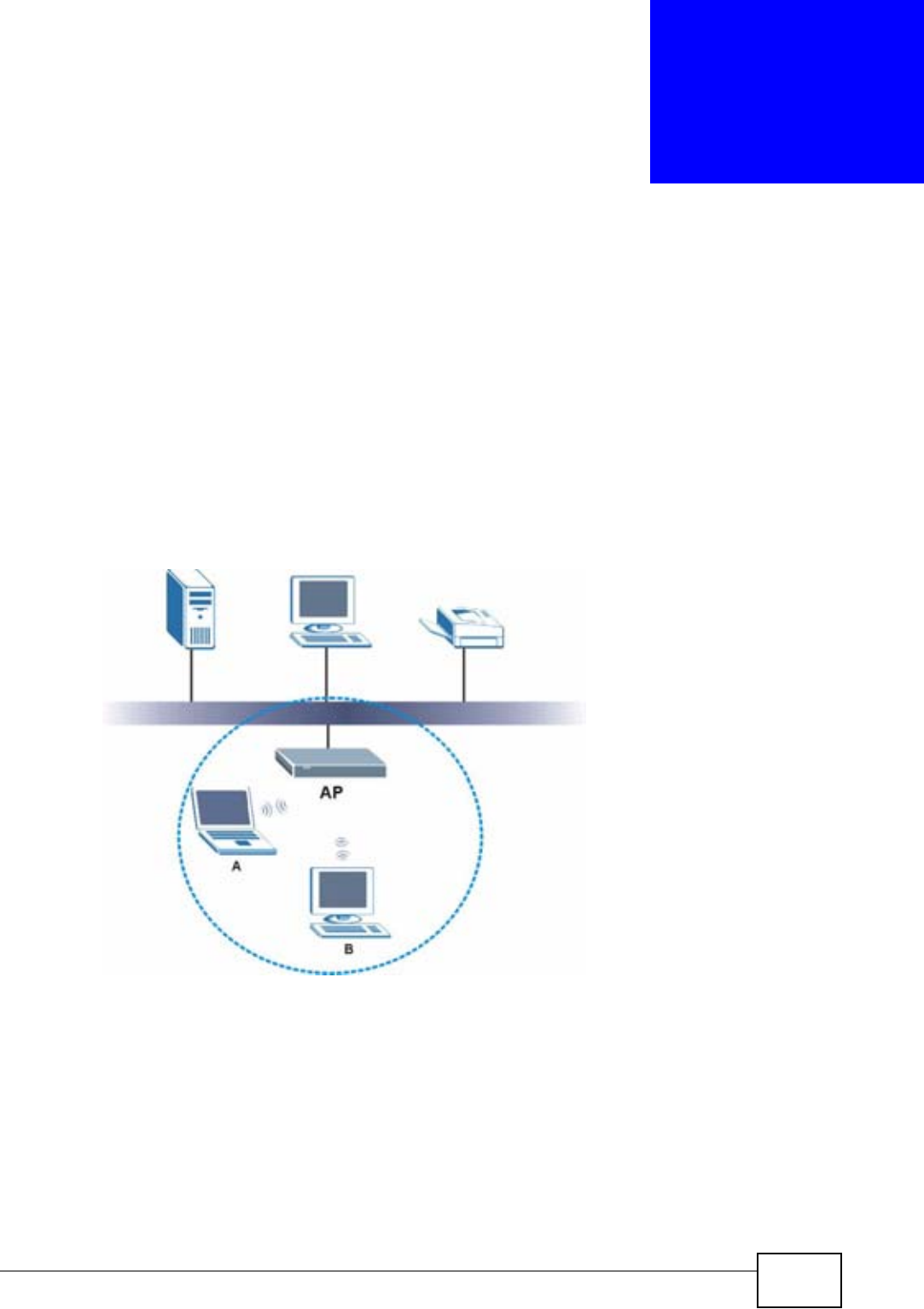
P-320W v3 User’s Guide 55
CHAPTER 4
Wireless LAN
4.1 Overview
This chapter discusses how to configure the wireless network settings in your P-
320W v3. See the appendices for more detailed information about wireless
networks.
The following figure provides an example of a wireless network.
Figure 29 Example of a Wireless Network
The wireless network is the part in the blue circle. In this wireless network,
devices A and B are called wireless clients. The wireless clients use the access
point (AP) to interact with other devices (such as the printer) or with the Internet.
Your P-320W v3 is the AP.
Every wireless network must follow these basic guidelines.
• Every wireless client in the same wireless network must use the same SSID.
The SSID is the name of the wireless network. It stands for Service Set IDentity.

Chapter 4 Wireless LAN
P-320W v3 User’s Guide
56
• If two wireless networks overlap, they should use different channels.
Like radio stations or television channels, each wireless network uses a specific
channel, or frequency, to send and receive information.
• Every wireless client in the same wireless network must use security compatible
with the AP.
Security stops unauthorized devices from using the wireless network. It can also
protect the information that is sent in the wireless network.
4.2 What You Can Do
•Use the General Wireless screen (Section 4.4 on page 60) configure your P-
320W v3 as a wireless router or access point (AP).
•Use the MAC Filter screen (Section 4.5 on page 68) to configure the P-320W v3
to give or deny access to up to 32 devices.
•Use the WPS screen (Section 4.6 on page 69) to enable/disable WPS, view or
generate a new PIN number and check current WPS status.
•Use the WPS Station screen (Section 4.7 on page 70) to add a wireless station
using WPS.
•Use the Wireless LAN Advanced screen (Section 4.8 on page 70) to configure
your P-320W v3’s advanced wireless setup.
4.3 What You Need To Know
The following sections provide information that can help you set up your wireless
network. It also introduces different types of wireless security you can set up in
the wireless network.
4.3.1 SSID
Normally, the AP acts like a beacon and regularly broadcasts the SSID in the area.
You can hide the SSID instead, in which case the AP does not broadcast the SSID.
In addition, you should change the default SSID to something that is difficult to
guess.
This type of security is fairly weak, however, because there are ways for
unauthorized devices to get the SSID. In addition, unauthorized devices can still
see the information that is sent in the wireless network.

Chapter 4 Wireless LAN
P-320W v3 User’s Guide 57
4.3.2 MAC Address Filter
Every wireless client has a unique identification number, called a MAC address.1 A
MAC address is usually written using twelve hexadecimal characters2; for
example, 00A0C5000002 or 00:A0:C5:00:00:02. To get the MAC address for each
wireless client, see the appropriate User’s Guide or other documentation.
You can use the MAC address filter to tell the AP which wireless clients are allowed
or not allowed to use the wireless network. If a wireless client is allowed to use the
wireless network, it still has to have the correct settings (SSID, channel, and
security). If a wireless client is not allowed to use the wireless network, it does not
matter if it has the correct settings.
This type of security does not protect the information that is sent in the wireless
network. Furthermore, there are ways for unauthorized devices to get the MAC
address of an authorized wireless client. Then, they can use that MAC address to
use the wireless network.
4.3.3 User Authentication
You can make every user log in to the wireless network before they can use it.
This is called user authentication. However, every wireless client in the wireless
network has to support IEEE 802.1x to do this.
For wireless networks, there are two typical places to store the user names and
passwords for each user.
• In the AP: this feature is called a local user database or a local database.
• In a RADIUS server: this is a server used in businesses more than in homes.
If your AP does not provide a local user database and if you do not have a RADIUS
server, you cannot set up user names and passwords for your users.
Unauthorized devices can still see the information that is sent in the wireless
network, even if they cannot use the wireless network. Furthermore, there are
ways for unauthorized wireless users to get a valid user name and password.
Then, they can use that user name and password to use the wireless network.
Local user databases also have an additional limitation that is explained in the
next section.
1. Some wireless devices, such as scanners, can detect wireless networks but cannot use wireless networks.
These kinds of wireless devices might not have MAC addresses.
2. Hexadecimal characters are 0, 1, 2, 3, 4, 5, 6, 7, 8, 9, A, B, C, D, E, and F.
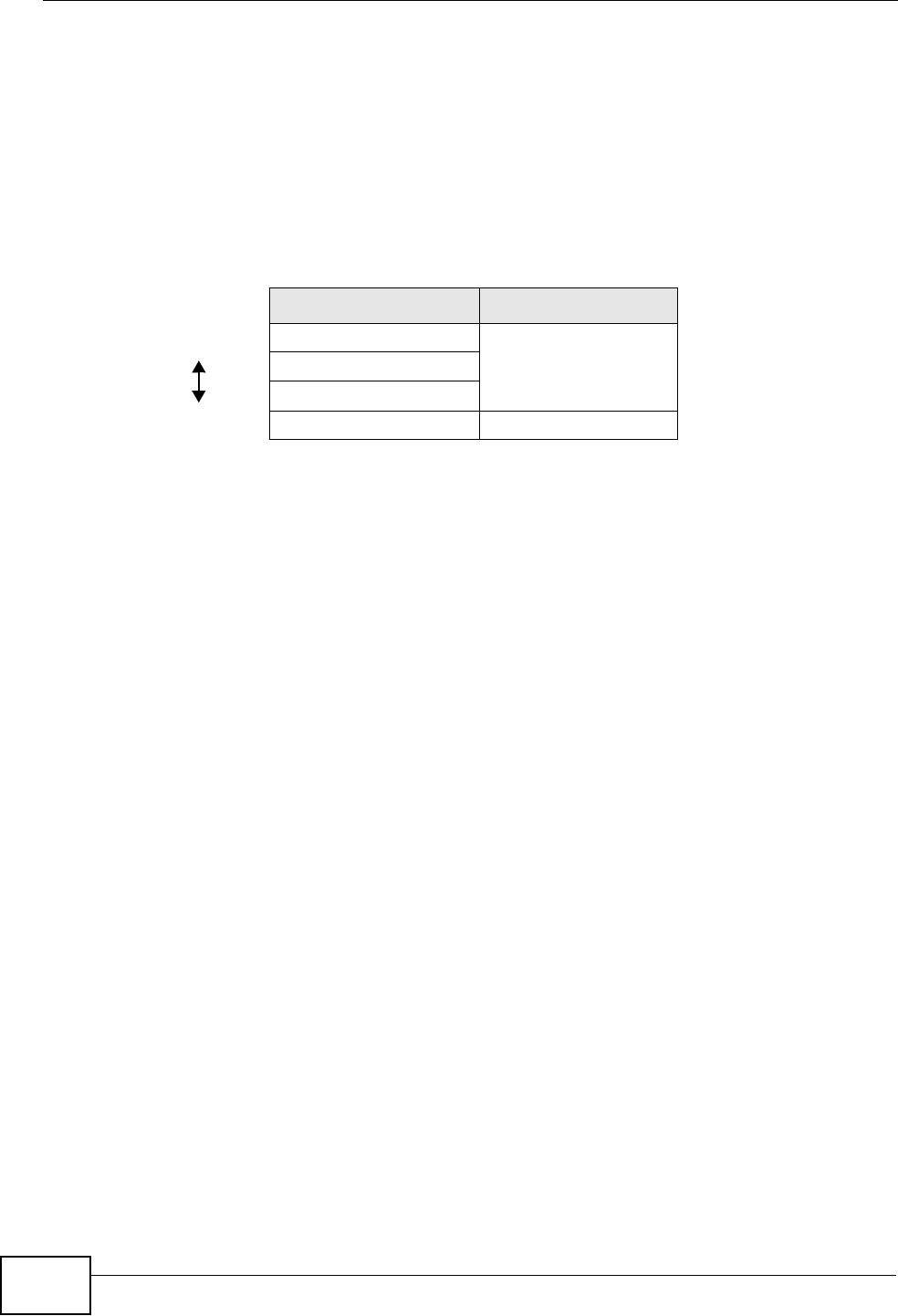
Chapter 4 Wireless LAN
P-320W v3 User’s Guide
58
4.3.4 Encryption
Wireless networks can use encryption to protect the information that is sent in the
wireless network. Encryption is like a secret code. If you do not know the secret
code, you cannot understand the message.
The types of encryption you can choose depend on the type of user
authentication. (See Section 4.3.3 on page 57 for information about this.)
For example, if the wireless network has a RADIUS server, you can choose WPA
or WPA2. If users do not log in to the wireless network, you can choose no
encryption, Static WEP,WPA-PSK, or WPA2-PSK.
Usually, you should set up the strongest encryption that every wireless client in
the wireless network supports. For example, suppose the AP does not have a local
user database, and you do not have a RADIUS server. Therefore, there is no user
authentication. Suppose the wireless network has two wireless clients. Device A
only supports WEP, and device B supports WEP and WPA. Therefore, you should
set up Static WEP in the wireless network.
Note: It is recommended that wireless networks use WPA-PSK,WPA, or stronger
encryption. IEEE 802.1x and WEP encryption are better than none at all, but it
is still possible for unauthorized devices to figure out the original information
pretty quickly.
Note: It is not possible to use WPA-PSK,WPA or stronger encryption with a local user
database. In this case, it is better to set up stronger encryption with no
authentication than to set up weaker encryption with the local user database.
When you select WPA2 or WPA2-PSK in your P-320W v3, you can also select an
option (WPA Compatible) to support WPA as well. In this case, if some wireless
clients support WPA and some support WPA2, you should set up WPA2-PSK or
WPA2 (depending on the type of wireless network login) and select the WPA
Compatible option in the P-320W v3.
Many types of encryption use a key to protect the information in the wireless
network. The longer the key, the stronger the encryption. Every wireless client in
the wireless network must have the same key.
Table 22 Types of Encryption for Each Type of Authentication
NO AUTHENTICATION RADIUS SERVER
Weakest No Security WPA
Static WEP
WPA-PSK
Strongest WPA2-PSK WPA2
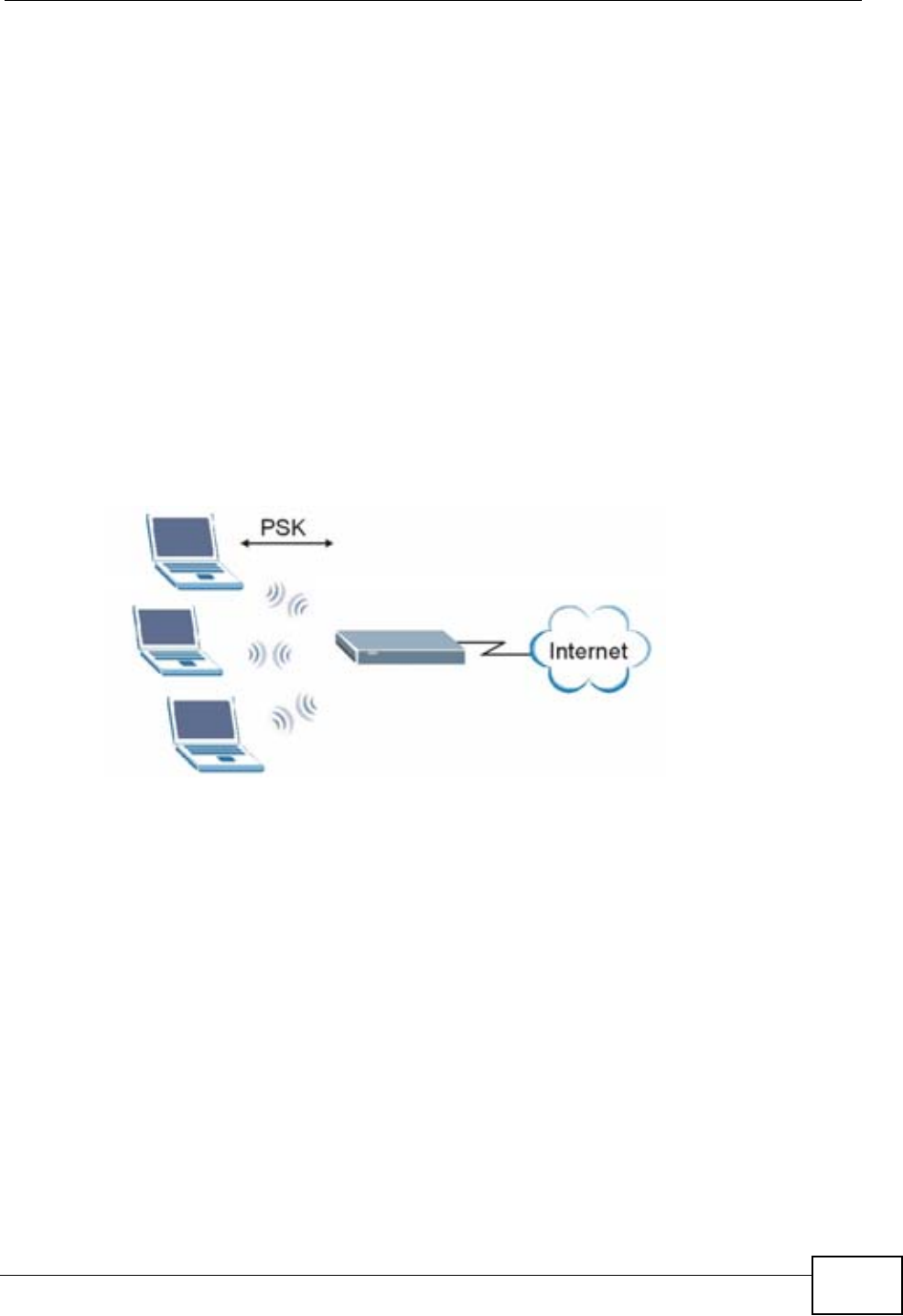
Chapter 4 Wireless LAN
P-320W v3 User’s Guide 59
4.3.4.1 WPA-PSK Application Example
A WPA-PSK application looks as follows.
1First enter identical passwords into the AP and all wireless clients. The Pre-Shared
Key (PSK) must consist of between 8 and 63 ASCII characters or 64 hexadecimal
characters (including spaces and symbols).
2The AP checks each wireless client's password and allows it to join the network
only if the password matches.
3The AP and wireless clients generate a common PMK (Pairwise Master Key). The
key itself is not sent over the network, but is derived from the PSK and the SSID.
4The AP and wireless clients use the TKIP or AES encryption process, the PMK and
information exchanged in a handshake to create temporal encryption keys. They
use these keys to encrypt data exchanged between them.
Figure 30 WPA-PSK Authentication
4.3.4.2 WPA with RADIUS Application Example
To set up WPA, you need the IP address of the RADIUS server, its port number
(default is 1812), and the RADIUS shared secret. A WPA application example with
an external RADIUS server looks as follows. "A" is the RADIUS server. "DS" is the
distribution system.
1The AP passes the wireless client's authentication request to the RADIUS server.
2The RADIUS server then checks the user's identification against its database and
grants or denies network access accordingly.
3A 256-bit Pairwise Master Key (PMK) is derived from the authentication process by
the RADIUS server and the client.
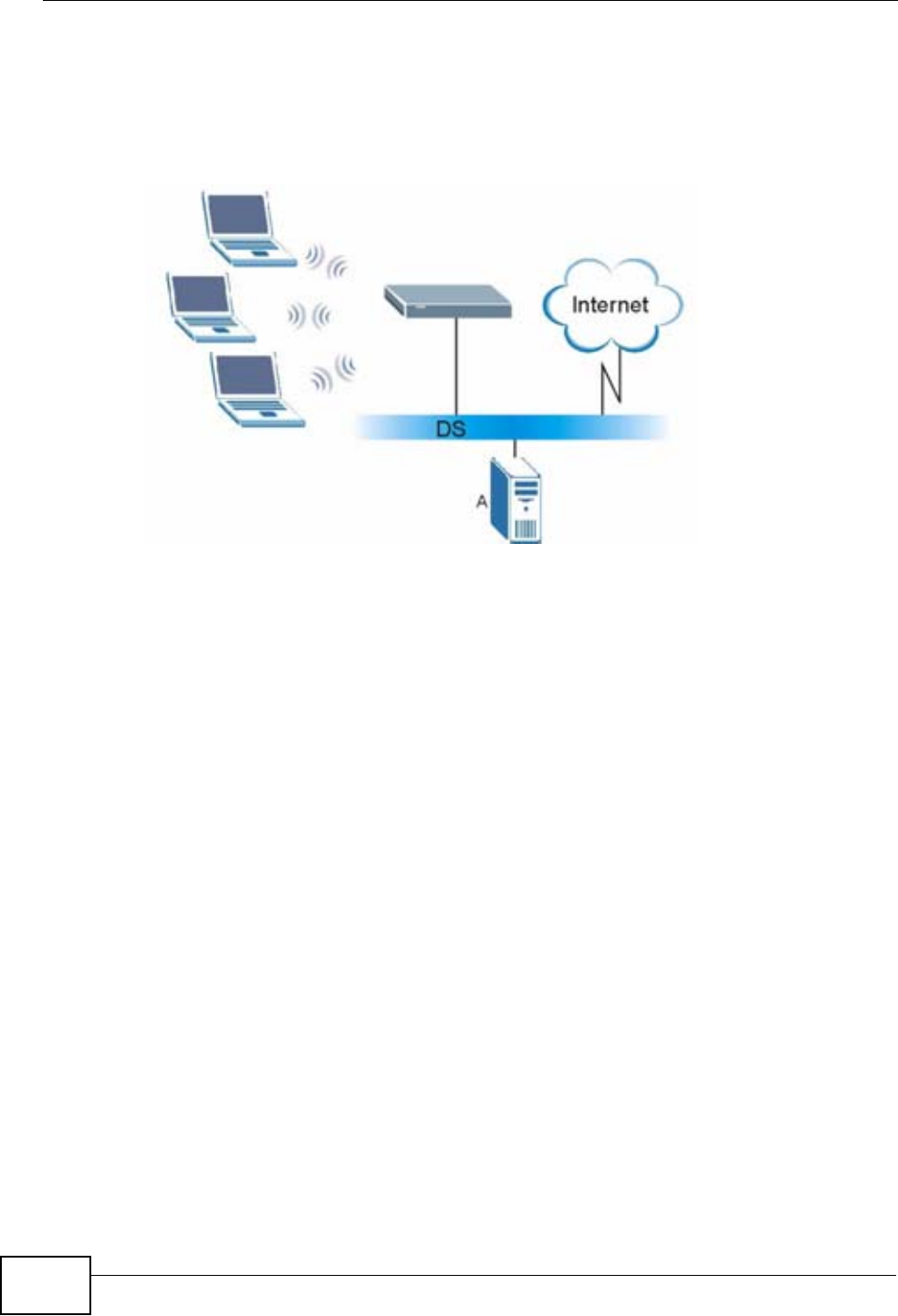
Chapter 4 Wireless LAN
P-320W v3 User’s Guide
60
4The RADIUS server distributes the PMK to the AP. The AP then sets up a key
hierarchy and management system, using the PMK to dynamically generate
unique data encryption keys. The keys are used to encrypt every data packet that
is wirelessly communicated between the AP and the wireless clients.
Figure 31 WPA with RADIUS Application Example
4.3.5 WiFi Protected Setup
WiFi Protected Setup (WPS) is an industry standard specification, defined by the
WiFi Alliance. WPS allows you to quickly set up a wireless network with strong
security, without having to configure security settings manually. Depending on the
devices in your network, you can either press a button (on the device itself, or in
its configuration utility) or enter a PIN (Personal Identification Number) in the
devices. Then, they connect and set up a secure network by themselves. See how
to set up a secure wireless network using WPS in the Section 6.2 on page 77.
4.4 General Wireless LAN Screen
Use this screen to configure your P-320W v3 as a wireless router or access point
(AP).
The P-320W v3 can broadcast up to four wireless profiles at the same time. This
means that users can connect to the P-320W v3 using different SSIDs.
You can only secure the connection on one SSID profile (AP1). Clients connecting
to the P-320W v3 using different SSIDs are in the same subnet but cannot
communicate with each other.
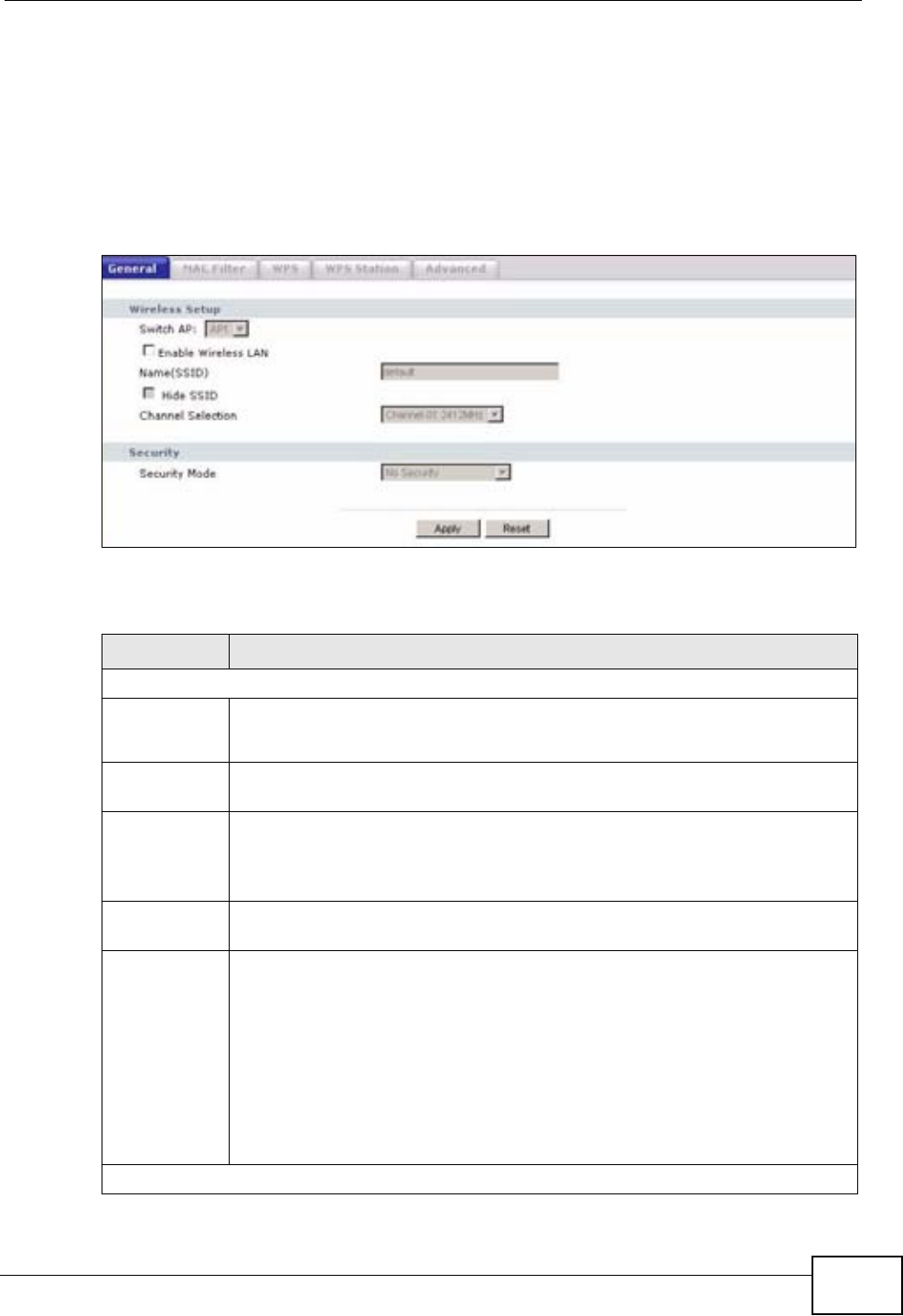
Chapter 4 Wireless LAN
P-320W v3 User’s Guide 61
Note: If you are configuring the P-320W v3 from a computer connected to the wireless
LAN and you change the P-320W v3’s SSID, channel or security settings, you
will lose your wireless connection when you press Apply to confirm. You must
then change the wireless settings of your computer to match the P-320W v3’s
new settings.
Click Network > Wireless LAN to open the General screen.
Figure 32 Network > Wireless LAN > General
The following table describes the general wireless LAN labels in this screen.
Table 23 Network > Wireless LAN > General
LABEL DESCRIPTION
Wireless Setup
Switch AP Select the AP profile you want to configure.
You can enable up to 4 AP profiles with your P-320W v3.
Enable
Wireless LAN
Click the check box to activate wireless LAN.
Name(SSID) (Service Set IDentity) The SSID identifies the Service Set with which a
wireless station is associated. Wireless stations associating to the access
point (AP) must have the same SSID. Enter a descriptive name (up to 32
printable 7-bit ASCII characters) for the wireless LAN.
Hide SSID Select this check box to hide the SSID in the outgoing beacon frame so a
station cannot obtain the SSID through scanning using a site survey tool.
Channel
Selection
Set the operating frequency/channel depending on your particular region.
Select a channel from the drop-down list box. The options vary depending
on whether you are using B/G frequency band and the country you are in.
Refer to the Connection Wizard chapter for more information on channels.
Note: To comply with US FCC regulation, the country selection
function has been completely removed from all US models.
The above function is for non-US models only.
Security
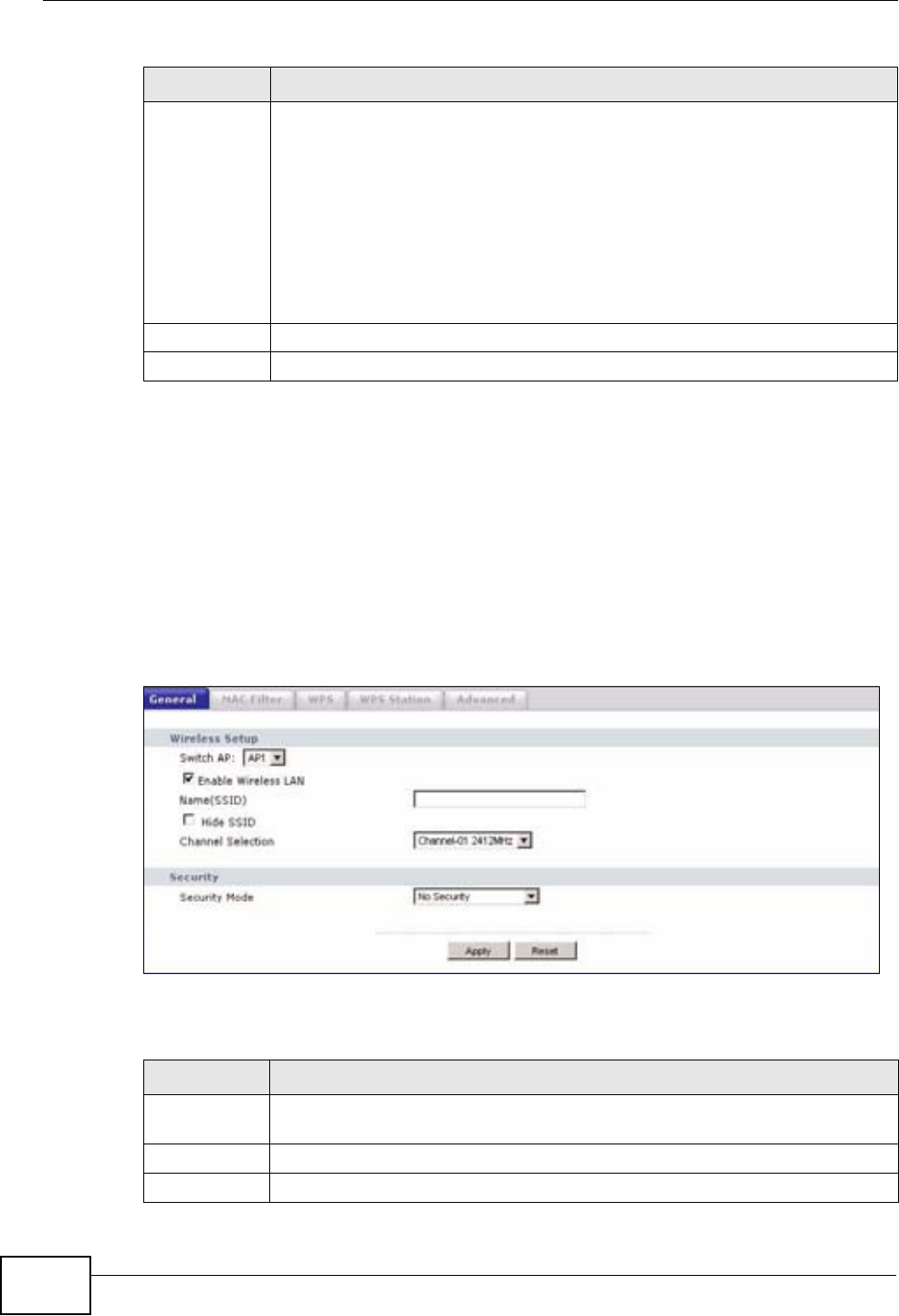
Chapter 4 Wireless LAN
P-320W v3 User’s Guide
62
See the rest of this chapter for information on the other labels in this screen.
4.4.1 No Security
Select No Security to allow wireless stations to communicate with the access
points without any data encryption.
Note: If you do not enable any wireless security on your P-320W v3, your network is
accessible to any wireless networking device that is within range.
Figure 33 Network > Wireless LAN > General: No Security
The following table describes the labels in this screen.
Security
Mode
Select Static-WEP,WPA-PSK,WPA,802.1x + Dynamic WEP or
WPA-PSK/WPA2-PSK (Mixed) to add security on this wireless
network. The wireless clients which want to associate to this network
must have same wireless security settings as this device. After you select
to use a security, additional options appears in this screen. See 4.4.2,
4.4.3,4.4.4 sections. Or you can select No Security to allow any client to
associate this network without authentication.
Note: If you enable the WPS function, only No Security and WPA-
PSK are available in this option.
Apply Click Apply to save your changes back to the P-320W v3.
Reset Click Reset to reload the previous configuration for this screen.
Table 23 Network > Wireless LAN > General
LABEL DESCRIPTION
Table 24 Wireless No Security
LABEL DESCRIPTION
Security
Mode
Choose No Security from the drop-down list box.
Apply Click Apply to save your changes back to the P-320W v3.
Reset Click Reset to reload the previous configuration for this screen.
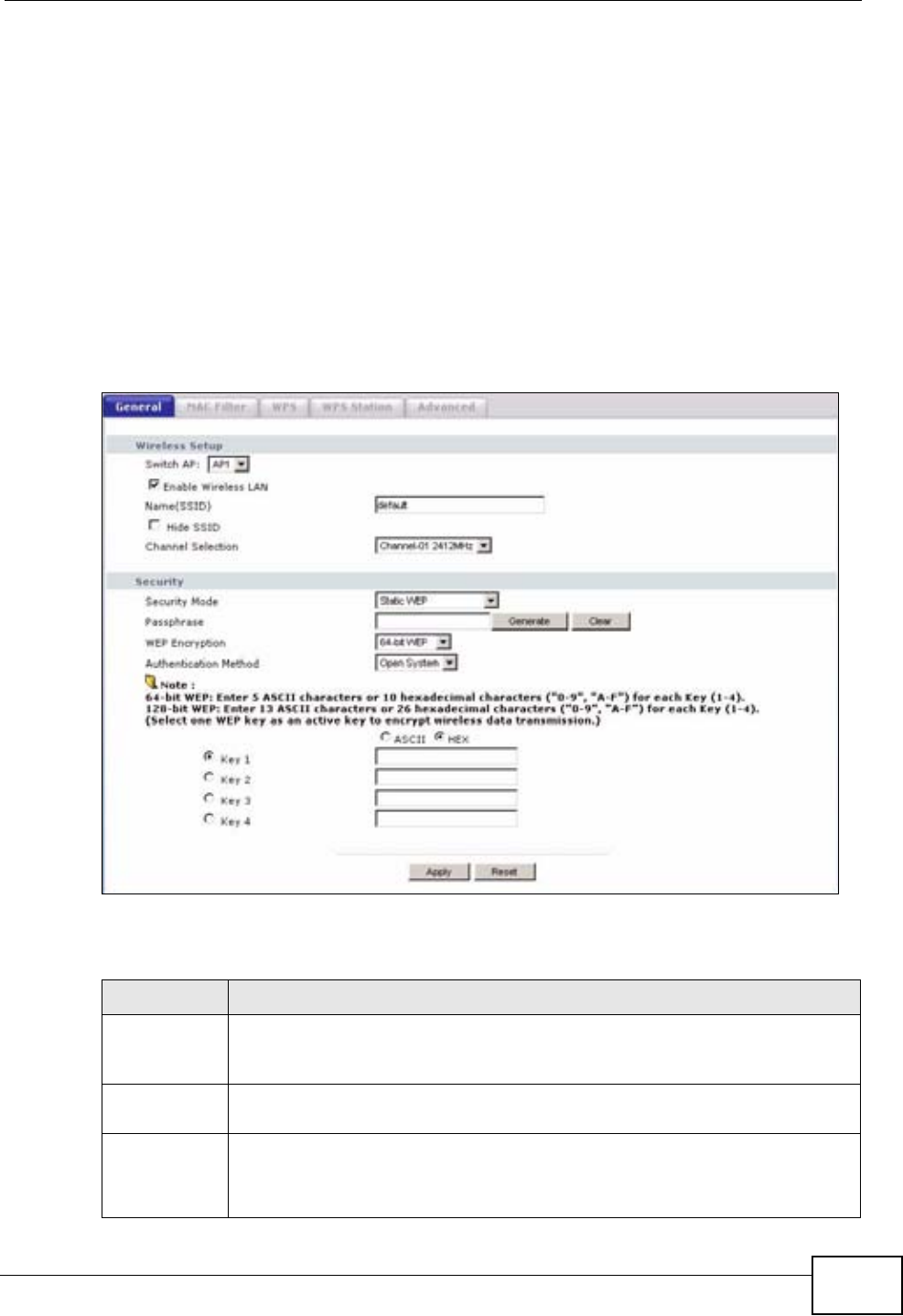
Chapter 4 Wireless LAN
P-320W v3 User’s Guide 63
4.4.2 WEP Encryption
WEP encryption scrambles the data transmitted between the wireless stations and
the access points to keep network communications private. It encrypts unicast
and multicast communications in a network. Both the wireless stations and the
access points must use the same WEP key.
Your P-320W v3 allows you to configure up to four 64-bit or 128-bit WEP keys but
only one key can be enabled at any one time.
In order to configure and enable WEP encryption; click Network > Wireless LAN
to display the General screen. Select Static WEP from the Security Mode list.
Figure 34 Network > Wireless LAN > General: Static WEP
The following table describes the wireless LAN security labels in this screen.
Table 25 Network > Wireless LAN > General: Static WEP
LABEL DESCRIPTION
Passphrase Enter a passphrase (password phrase) of up to 32 printable characters and
click Generate. The P-320W v3 automatically generates four different
WEP keys and displays them in the Key fields below.
WEP
Encryption
Select 64-bit WEP or 128-bit WEP to enable data encryption.
Authenticatio
n Method
This field is activated when you select 64-bit WEP or 128-bit WEP in the
WEP Encryption field.
Select Auto or Shared Key from the drop-down list box.
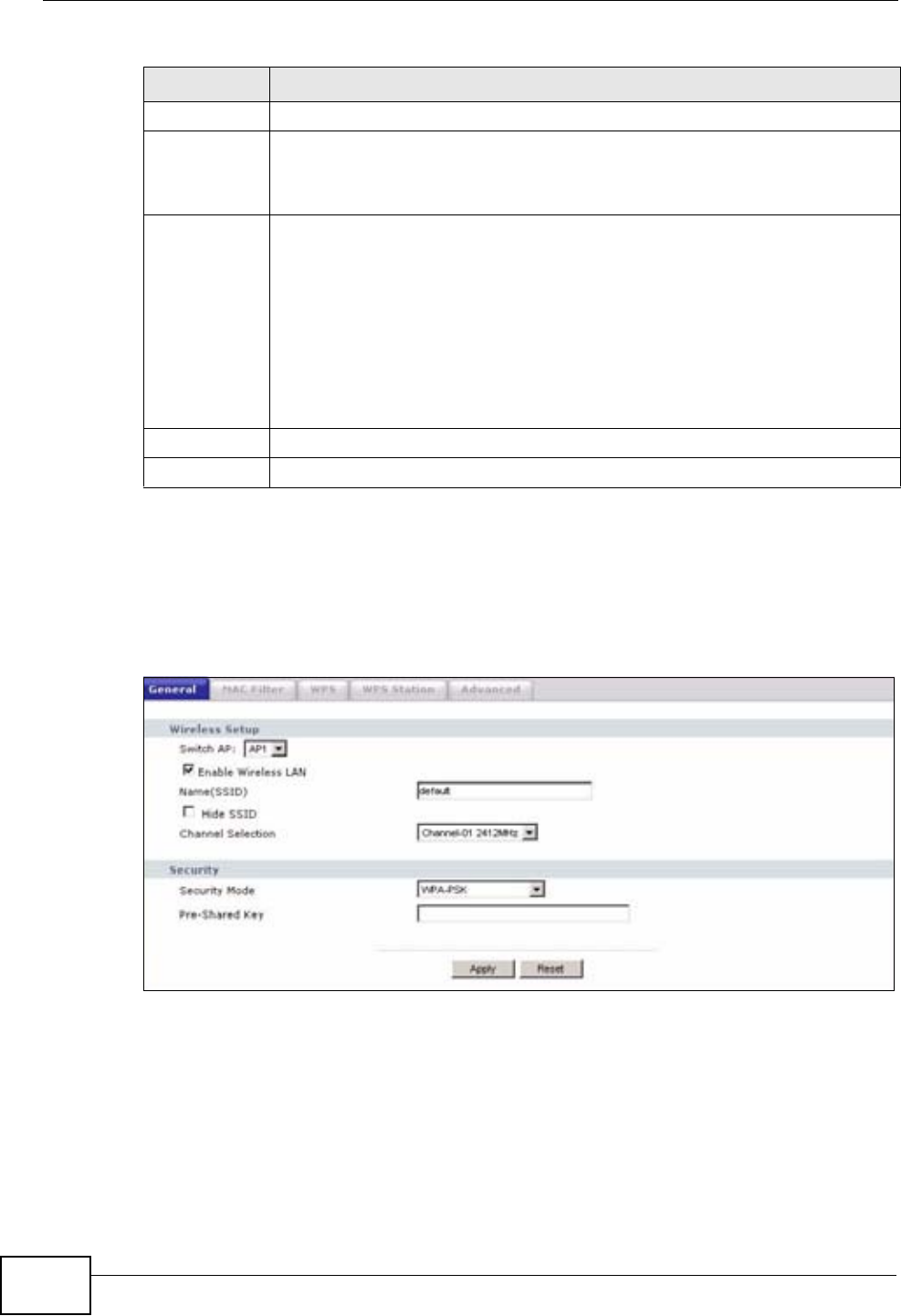
Chapter 4 Wireless LAN
P-320W v3 User’s Guide
64
4.4.3 WPA-PSK
Click Network > Wireless LAN to display the General screen. Select WPA-PSK
from the Security Mode list.
Figure 35 Network > Wireless LAN > General: WPA-PSK
ASCII Select this option in order to enter ASCII characters as WEP key.
Hex Select this option in order to enter hexadecimal characters as a WEP key.
The preceding "0x", that identifies a hexadecimal key, is entered
automatically.
Key 1 to Key
4
The WEP keys are used to encrypt data. Both the P-320W v3 and the
wireless stations must use the same WEP key for data transmission.
If you chose 64-bit WEP, then enter any 5 ASCII characters or 10
hexadecimal characters ("0-9", "A-F").
If you chose 128-bit WEP, then enter 13 ASCII characters or 26
hexadecimal characters ("0-9", "A-F").
You must configure at least one key, only one key can be activated at any
one time. The default key is key 1.
Apply Click Apply to save your changes back to the P-320W v3.
Reset Click Reset to reload the previous configuration for this screen.
Table 25 Network > Wireless LAN > General: Static WEP
LABEL DESCRIPTION
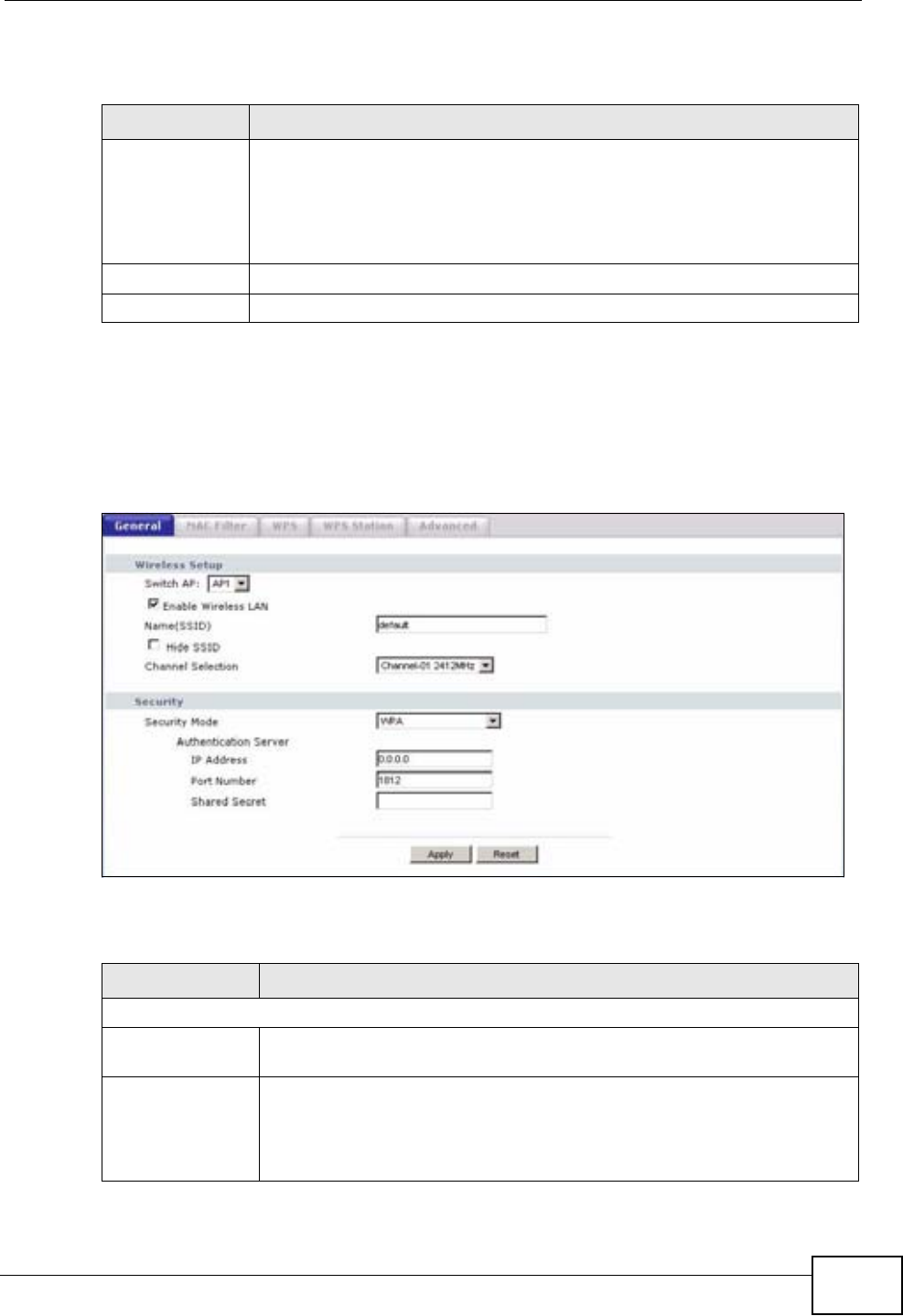
Chapter 4 Wireless LAN
P-320W v3 User’s Guide 65
The following table describes the labels in this screen.
4.4.4 WPA
Click Network > Wireless LAN to display the General screen. Select WPA from
the Security Mode list.
Figure 36 Network > Wireless LAN > General: WPA
The following table describes the labels in this screen.
Table 26 Network > Wireless LAN > General: WPA-PSK
LABEL DESCRIPTION
Pre-Shared Key The encryption mechanisms used for WPA and WPA-PSK are the
same. The only difference between the two is that WPA-PSK uses a
simple common password, instead of user-specific credentials.
Type a pre-shared key from 8 to 63 case-sensitive ASCII characters
(including spaces and symbols).
Apply Click Apply to save your changes back to the P-320W v3.
Reset Click Reset to reload the previous configuration for this screen.
Table 27 Network > Wireless LAN > General: WPA/WPA2
LABEL DESCRIPTION
Authentication Server
IP Address Enter the IP address of the external authentication server in dotted
decimal notation.
Port Number Enter the port number of the external authentication server. The
default port number is 1812.
You need not change this value unless your network administrator
instructs you to do so with additional information.
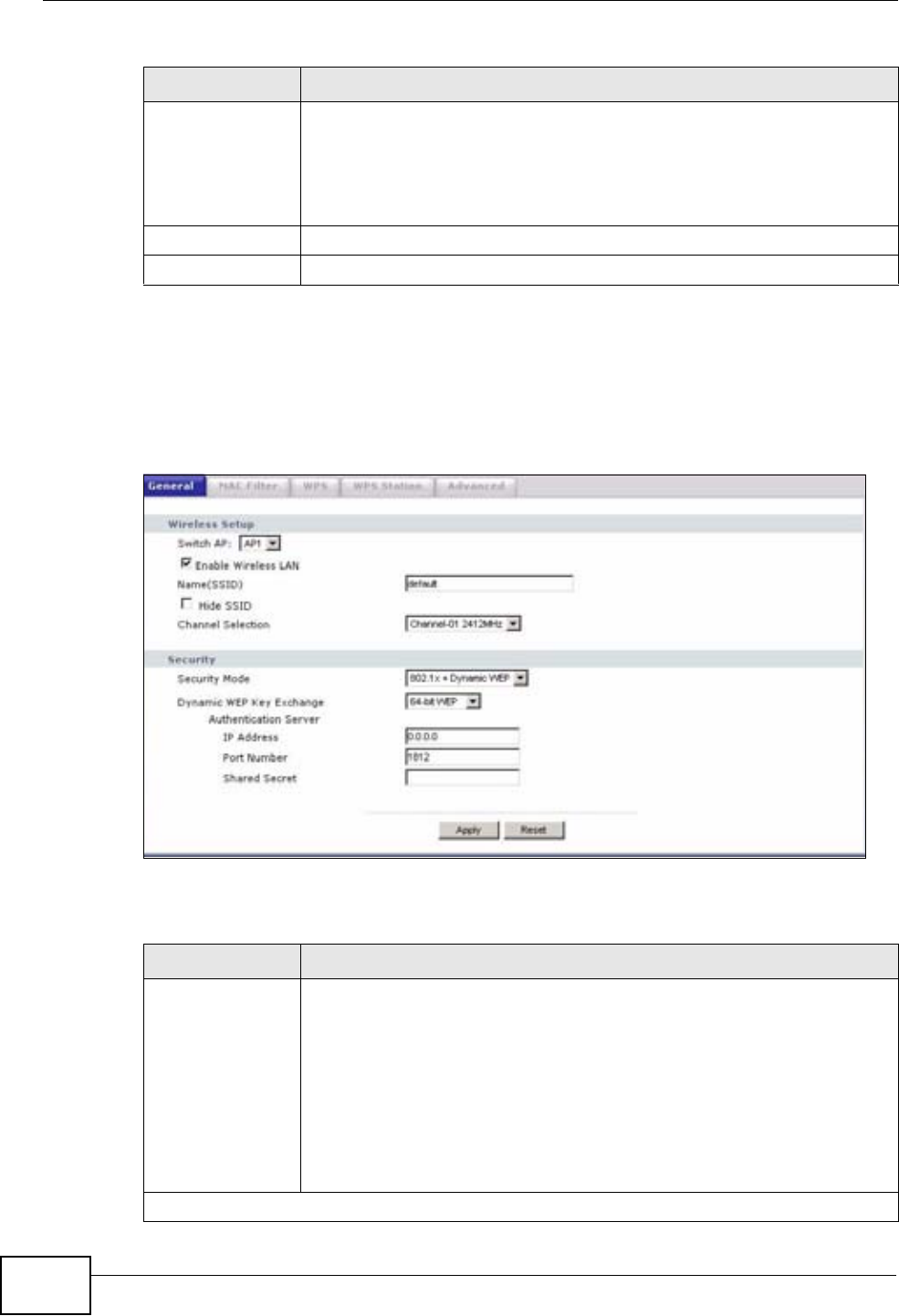
Chapter 4 Wireless LAN
P-320W v3 User’s Guide
66
4.4.5 802.1x + Dynamic WEP
Click Network > Wireless LAN to display the General screen. Select 802.1x +
Dynamic WEP from the Security Mode list.
Figure 37 Network > Wireless LAN > General: 802.1x + Dynamic WEP
The following table describes the labels in this screen..
Shared Secret Enter a password (up to 31 alphanumeric characters) as the key to be
shared between the external authentication server and the P-320W
v3.
The key must be the same on the external authentication server and
your P-320W v3. The key is not sent over the network.
Apply Click Apply to save your changes back to the P-320W v3.
Reset Click Reset to reload the previous configuration for this screen.
Table 27 Network > Wireless LAN > General: WPA/WPA2
LABEL DESCRIPTION
Table 28 Network > Wireless LAN > General: 802.1x + Dynamic WEP
LABEL DESCRIPTION
Dynamic WEP
Key Exchange
The WEP keys are used to encrypt data. Both the P-320W v3 and the
wireless stations must use the same WEP key for data transmission.
If you chose 64-bit WEP, then enter any 5 ASCII characters or 10
hexadecimal characters ("0-9", "A-F").
If you chose 128-bit WEP, then enter 13 ASCII characters or 26
hexadecimal characters ("0-9", "A-F").
You must configure at least one key, only one key can be activated at
any one time. The default key is key 1.
Security
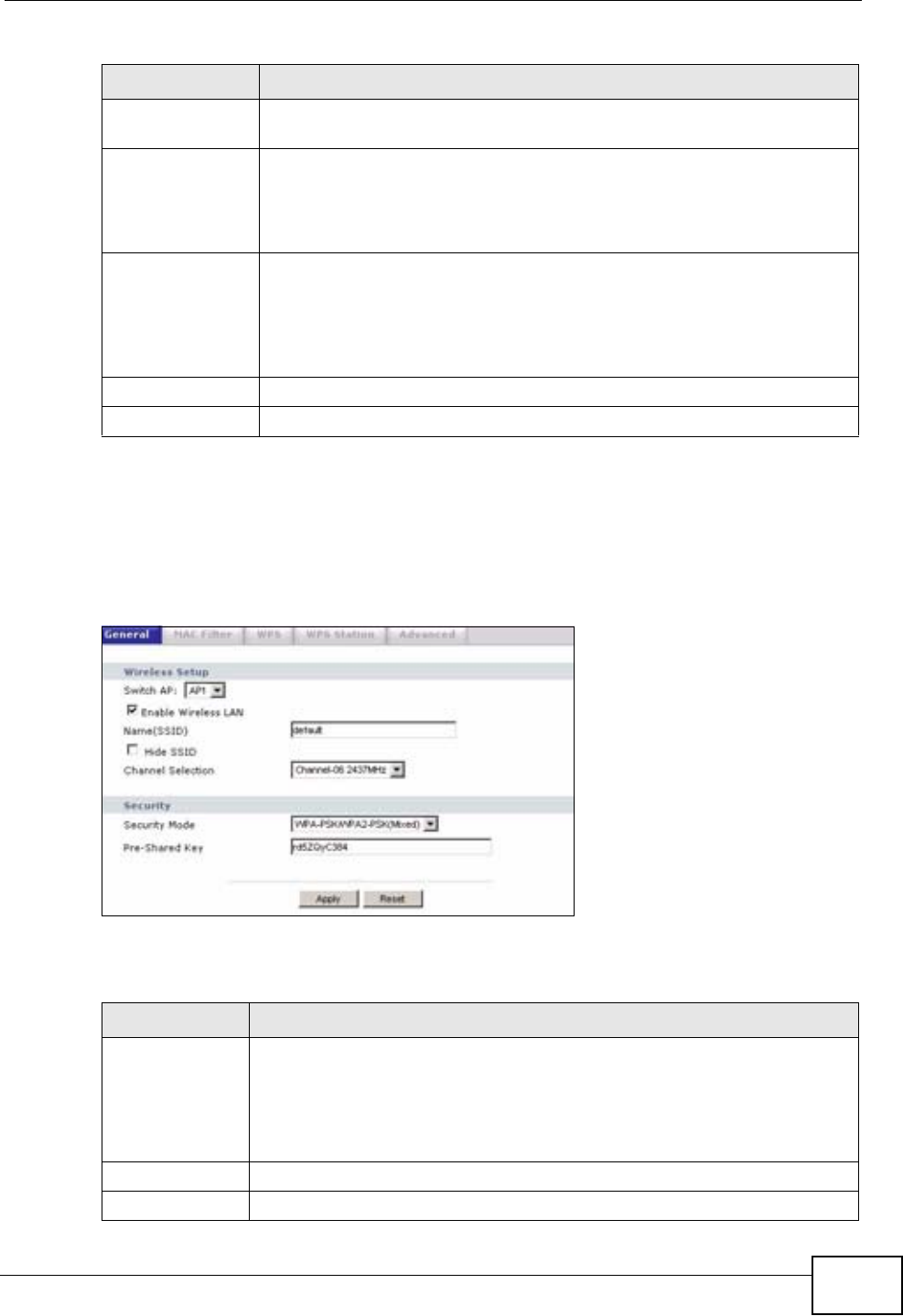
Chapter 4 Wireless LAN
P-320W v3 User’s Guide 67
4.4.6 WPA-PSK/WPA2-PSK (Mixed)
Click Network > Wireless LAN to display the General screen. Select WPA-
PSK/WPA2-PSK (Mixed) from the Security Mode list.
Figure 38 Network > Wireless LAN > General: WPA-PSK/WPA2-PSK (Mixed)
The following table describes the labels in this screen.
IP Address Enter the IP address of the external authentication server in dotted
decimal notation.
Port Number Enter the port number of the external authentication server. The
default port number is 1812.
You need not change this value unless your network administrator
instructs you to do so with additional information.
Shared Secret Enter a password (up to 31 alphanumeric characters) as the key to be
shared between the external authentication server and the P-320W
v3.
The key must be the same on the external authentication server and
your P-320W v3. The key is not sent over the network.
Apply Click Apply to save your changes back to the P-320W v3.
Reset Click Reset to reload the previous configuration for this screen.
Table 28 Network > Wireless LAN > General: 802.1x + Dynamic WEP
LABEL DESCRIPTION
Table 29 Network > Wireless LAN > General: WPA-PSK
LABEL DESCRIPTION
Pre-Shared Key The encryption mechanisms used for WPA and WPA-PSK are the
same. The only difference between the two is that WPA-PSK uses a
simple common password, instead of user-specific credentials.
Type a pre-shared key from 8 to 63 case-sensitive ASCII characters
(including spaces and symbols).
Apply Click Apply to save your changes back to the P-320W v3.
Reset Click Reset to reload the previous configuration for this screen.
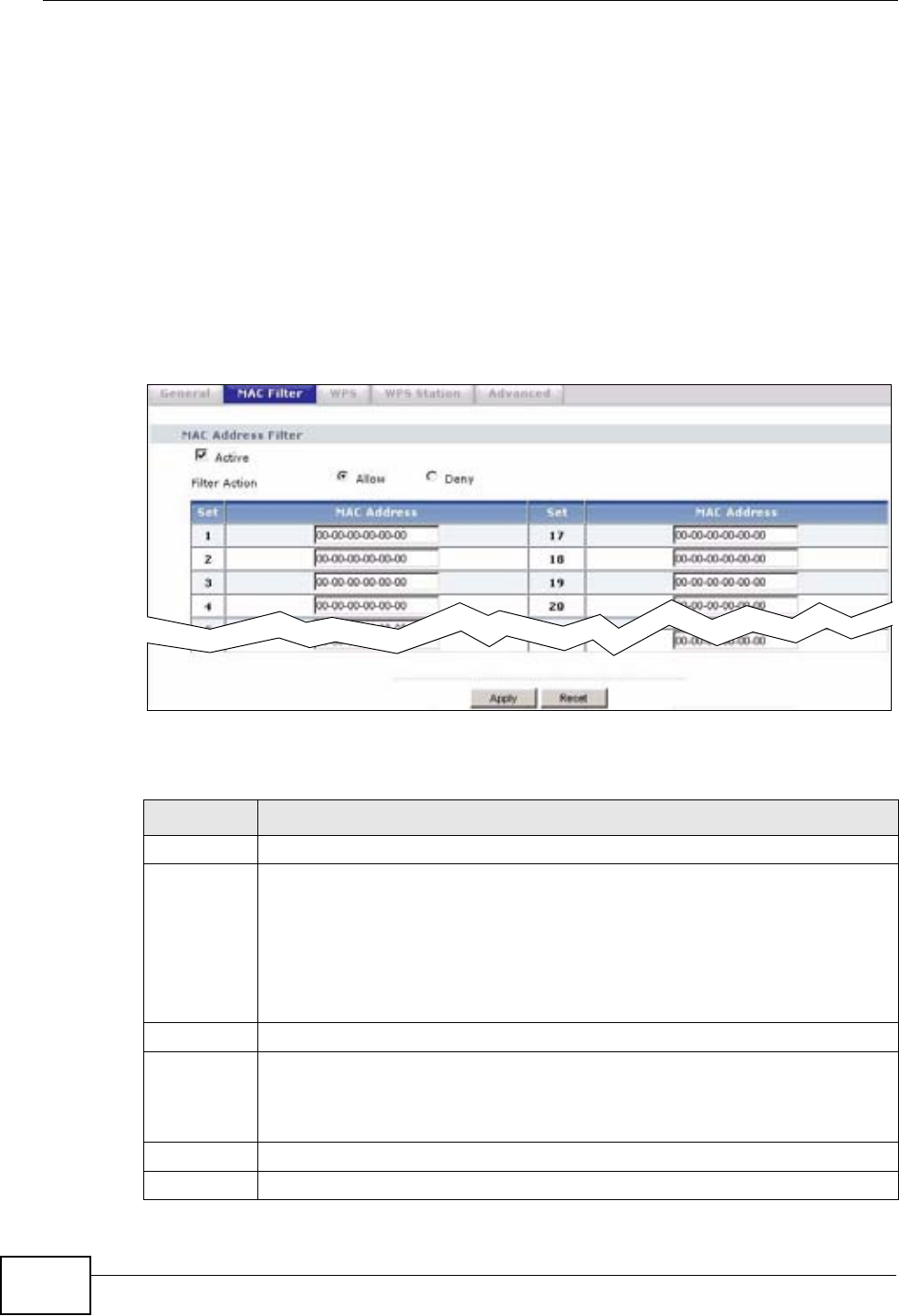
Chapter 4 Wireless LAN
P-320W v3 User’s Guide
68
4.5 MAC Filter
The MAC filter screen allows you to configure the P-320W v3 to give exclusive
access to up to 32 devices (Allow) or exclude up to 32 devices from accessing the
P-320W v3 (Deny). Every Ethernet device has a unique MAC (Media Access
Control) address. The MAC address is assigned at the factory and consists of six
pairs of hexadecimal characters, for example, 00:A0:C5:00:00:02. You need to
know the MAC address of the devices to configure this screen.
To change your P-320W v3’s MAC filter settings, click Network > Wireless LAN
>MAC Filter. The screen appears as shown.
Figure 39 Network > Wireless LAN > MAC Filter
The following table describes the labels in this menu.
Table 30 Network > Wireless LAN > MAC Filter
LABEL DESCRIPTION
Active Select Yes from the drop down list box to enable MAC address filtering.
Filter Action Define the filter action for the list of MAC addresses in the MAC Address
table.
Select Deny to block access to the P-320W v3, MAC addresses not listed
will be allowed to access the P-320W v3
Select Allow to permit access to the P-320W v3, MAC addresses not listed
will be denied access to the P-320W v3.
Set This is the index number of the MAC address.
MAC
Address
Enter the MAC addresses of the wireless station that are allowed or denied
access to the P-320W v3 in these address fields. Enter the MAC addresses
in a valid MAC address format, that is, six hexadecimal character pairs, for
example, 12:34:56:78:9a:bc.
Apply Click Apply to save your changes back to the P-320W v3.
Reset Click Reset to reload the previous configuration for this screen.
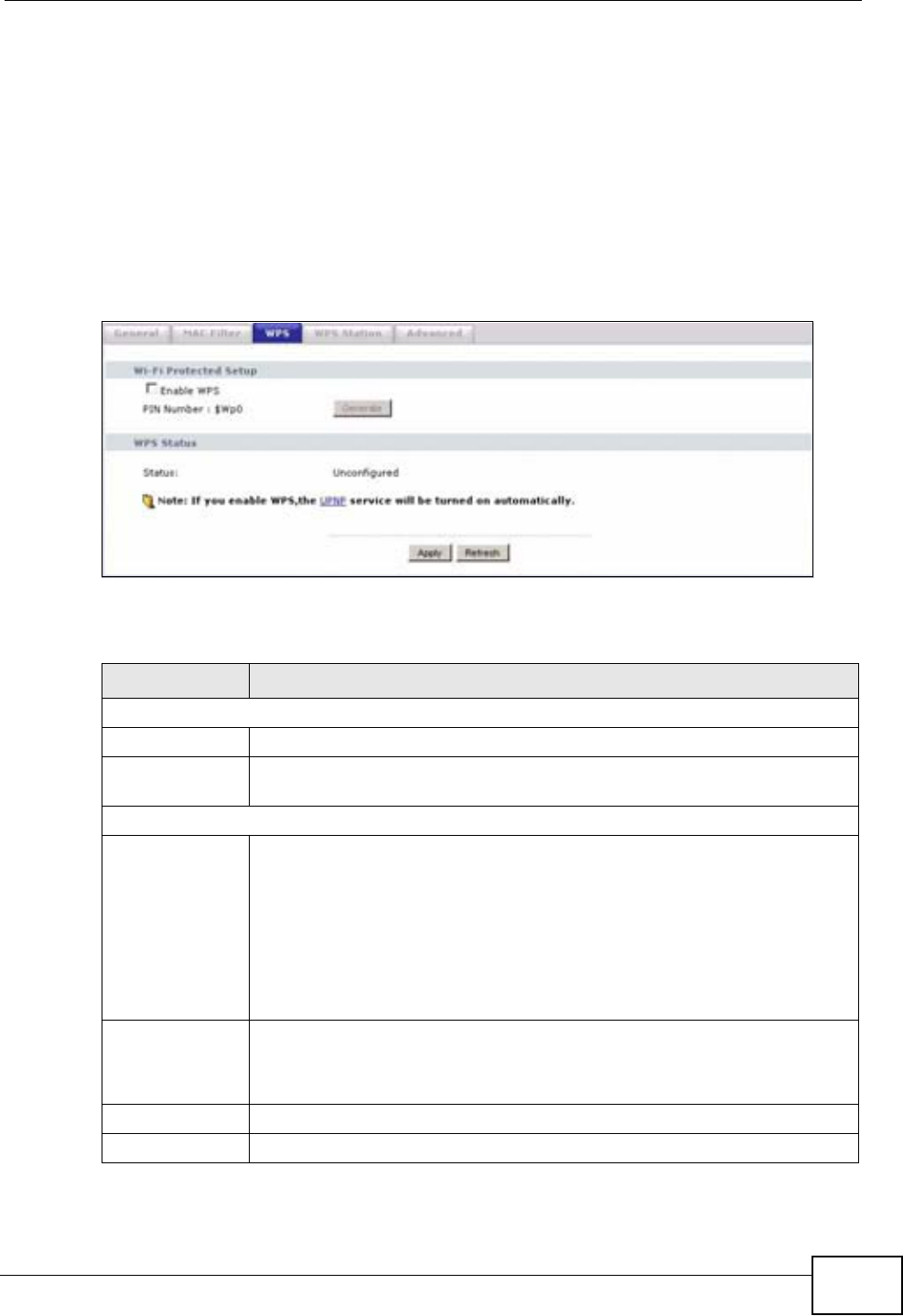
Chapter 4 Wireless LAN
P-320W v3 User’s Guide 69
4.6 WPS Screen
Use this screen to enable/disable WPS, view or generate a new PIN number and
check current WPS status. To open this screen, click Network >Wireless LAN >
WPS tab.
Figure 40 WPS
The following table describes the labels in this screen.
Table 31 WPS
LABEL DESCRIPTION
Wi-Fi Protected Setup
Enable Select this to enable the WPS feature.
PIN Number This displays a PIN number last time system generated. Click Generate
to generate a new PIN number.
WPS Status
Status This displays Configured when the P-320W v3 has connected to a
wireless network using WPS or Enable WPS is selected and wireless or
wireless security settings have been changed. The current wireless and
wireless security settings also appear in the screen.
This displays Unconfigured if WPS is disabled and there is no wireless
or wireless security changes on the P-320W v3 or you click
Release_Configuration to remove the configured wireless and
wireless security settings.
Release_Config
uration
This button is available when the WPS status is Configured.
Click this button to remove all configured wireless and wireless security
settings for WPS connections on the P-320W v3.
Apply Click Apply to save your changes back to the P-320W v3.
Refresh Click Refresh to get this screen information afresh.
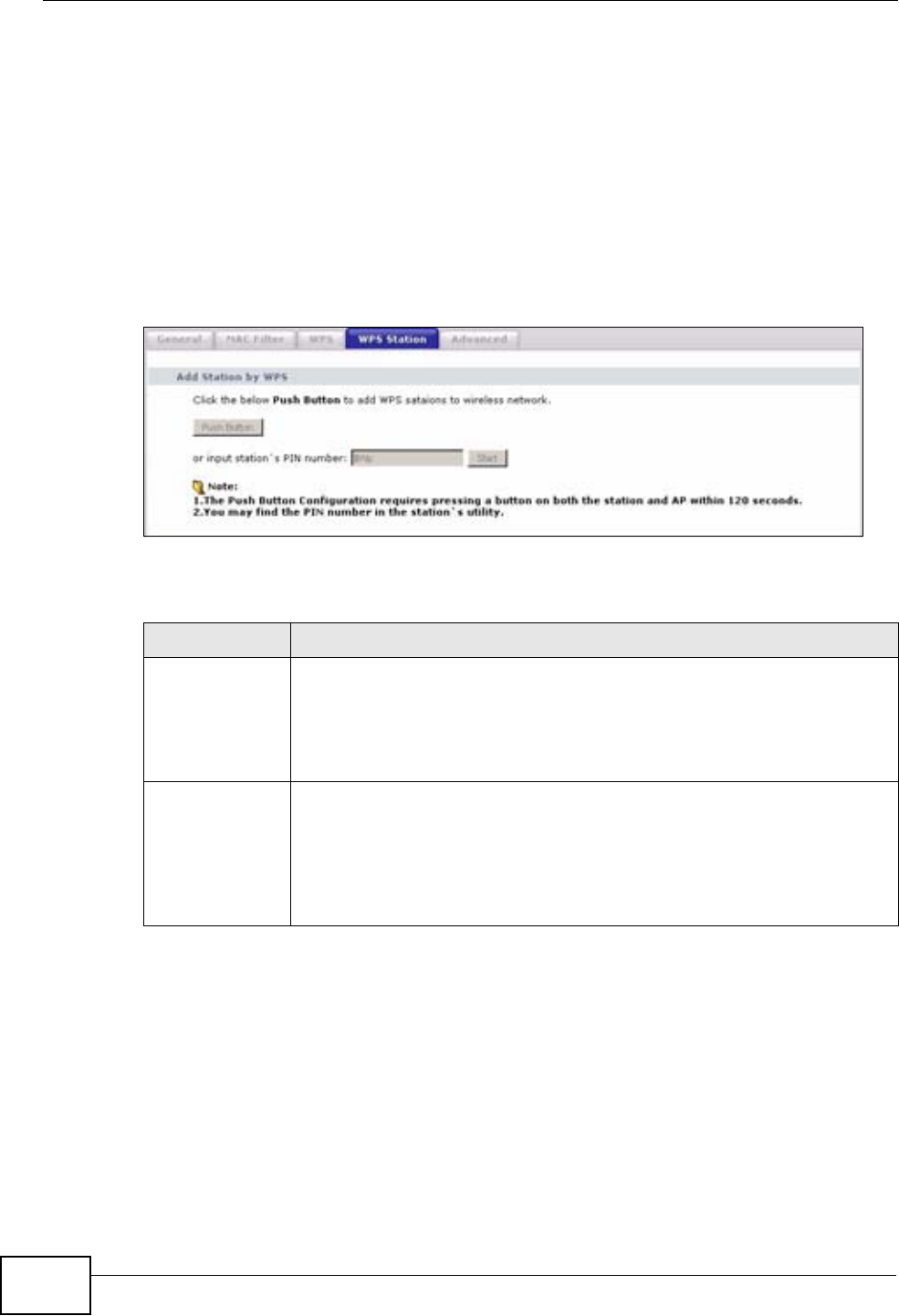
Chapter 4 Wireless LAN
P-320W v3 User’s Guide
70
4.7 WPS Station Screen
Use this screen when you want to add a wireless station using WPS. To open this
screen, click Network > Wireless LAN > WPS Station tab.
Note: Note: After you click Push Button on this screen, you have to press a similar
button in the wireless station utility within 2 minutes. To add the second wireless
station, you have to press these buttons on both device and the wireless station
again after the first 2 minutes.
Figure 41 WPS Station
The following table describes the labels in this screen.
4.8 Wireless LAN Advanced Screen
Use this screen to configure your P-320W v3’s advanced wireless setup.
Table 32 WPS Station
LABEL DESCRIPTION
Push Button Use this button when you use the PBC (Push Button Configuration)
method to configure wireless stations’s wireless settings. See Section
6.2.1 on page 78.
Click this to start WPS-aware wireless station scanning and the wireless
security information synchronization.
Or input
station’s PIN
number
Use this button when you use the PIN Configuration method to
configure wireless station’s wireless settings. See Section 6.2.2 on page
79.
Type the same PIN number generated in the wireless station’s utility.
Then click Start to associate to each other and perform the wireless
security information synchronization.
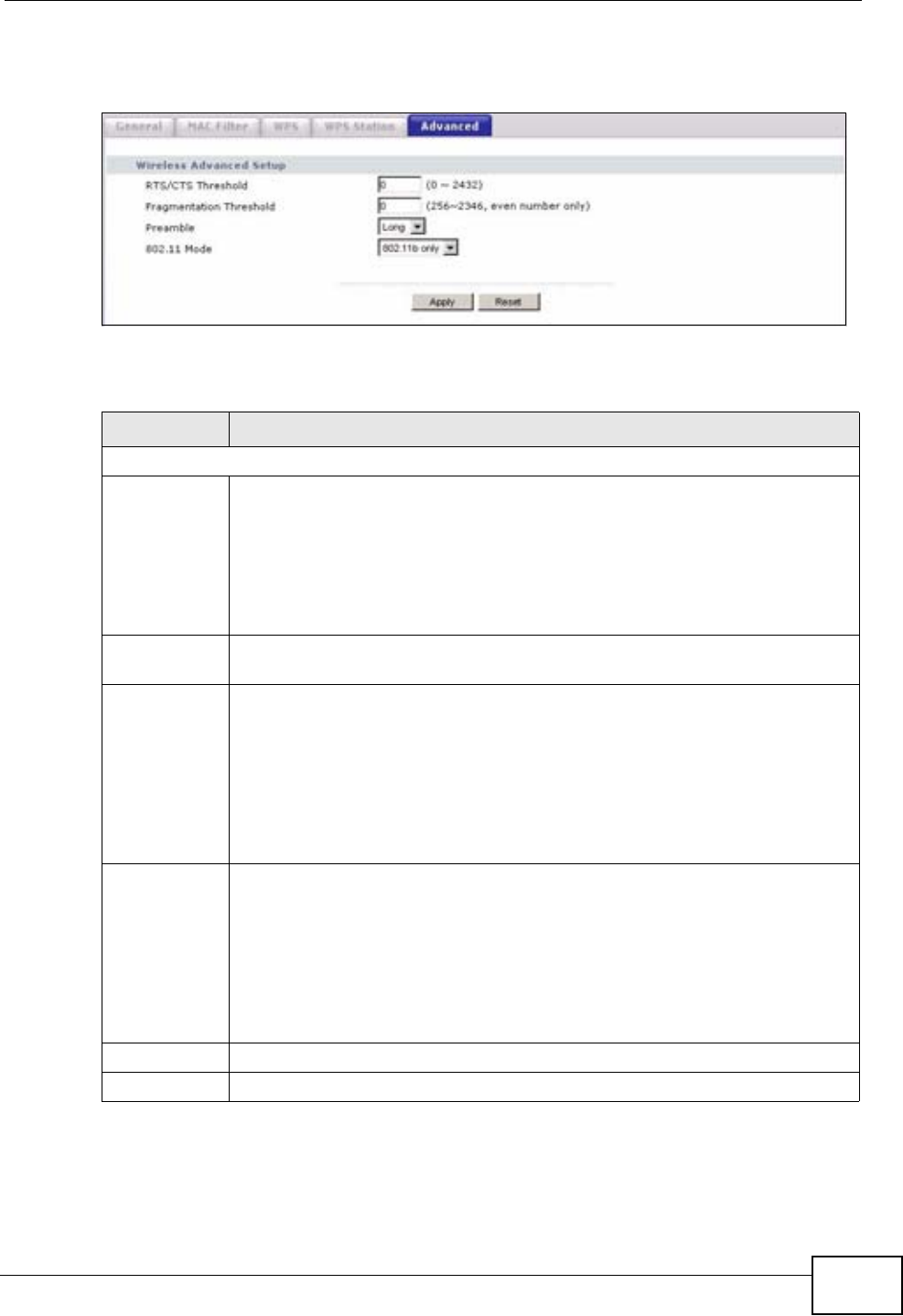
Chapter 4 Wireless LAN
P-320W v3 User’s Guide 71
Click Network > Wireless LAN > Advanced. The screen appears as shown.
Figure 42 Network > Wireless LAN > Advanced
The following table describes the labels in this screen.
Table 33 Network > Wireless LAN > Advanced
LABEL DESCRIPTION
Wireless Advanced Setup
RTS/CTS
Threshold
Data with its frame size larger than this value will perform the RTS
(Request To Send)/CTS (Clear To Send) handshake.
If the RTS/CTS value is greater than the Fragmentation Threshold
value, then the RTS/CTS handshake will never occur as data frames will be
fragmented before they reach RTS/CTS size.
Enter a value between 0 and 2432.
Fragmentatio
n Threshold
It is the maximum data fragment size that can be sent. Enter a value
between 256 and 2432.
Preamble Preamble is used to signal that data is coming to the receiver. Short and
Long refer to the length of the synchronization field in a packet.
Select Long preamble if you are unsure what preamble mode the wireless
adapters support, and to provide more reliable communications in busy
wireless networks.
Select Short preamble if you are sure the wireless adapters support it,
and to provide more efficient communications.
802.11 Mode Select 802.11b to allow only IEEE 802.11b compliant WLAN devices to
associate with the P-320W v3.
Select 802.11g to allow only IEEE 802.11g compliant WLAN devices to
associate with the P-320W v3.
Select Mixed to allow either IEEE802.11b or IEEE802.11g compliant
WLAN devices to associate with the P-320W v3. The transmission rate of
your P-320W v3 might be reduced.
Apply Click Apply to save your changes back to the P-320W v3.
Reset Click Reset to reload the previous configuration for this screen.

Chapter 4 Wireless LAN
P-320W v3 User’s Guide
72
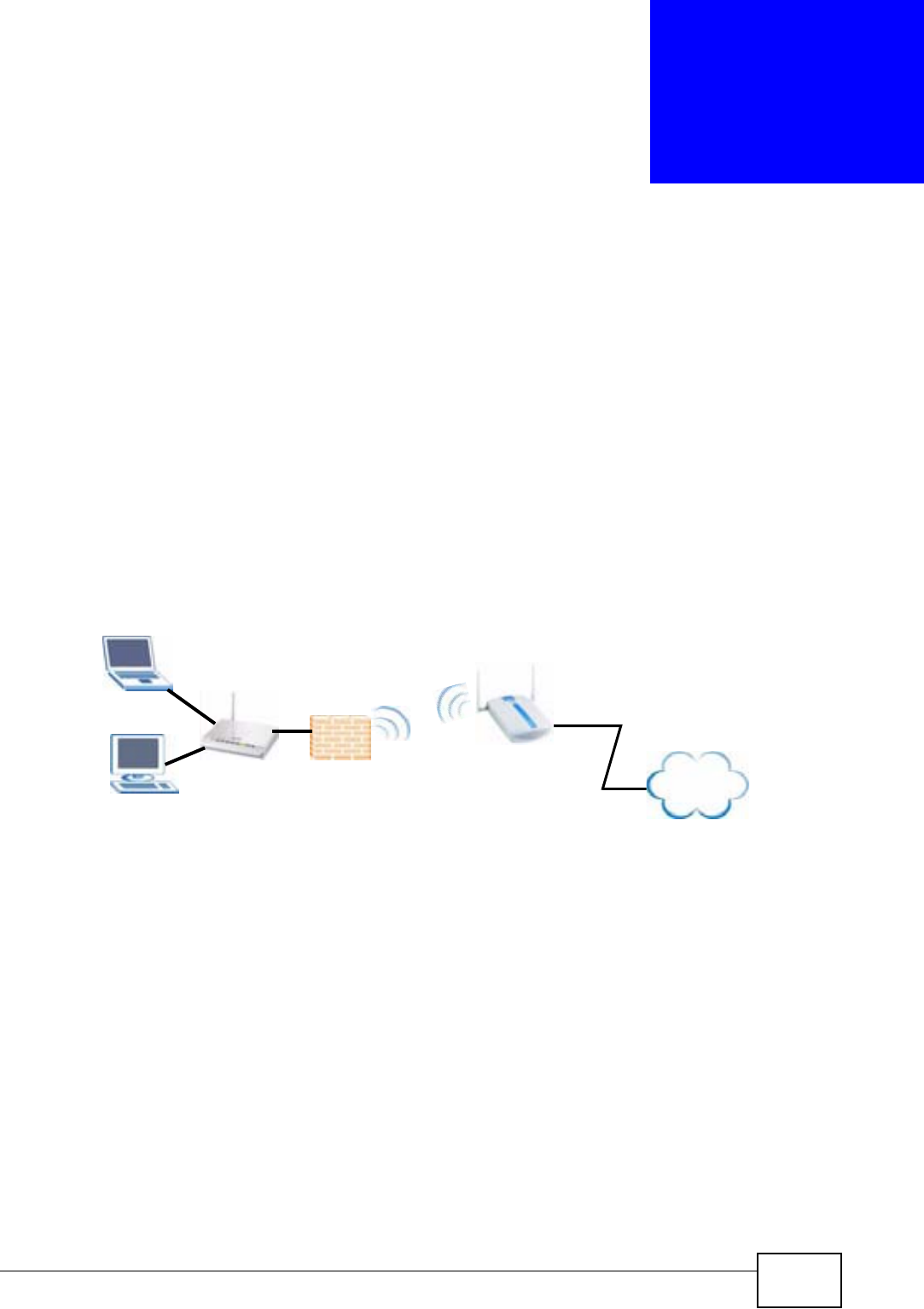
P-320W v3 User’s Guide 73
CHAPTER 5
Wireless Client Mode
5.1 Overview
Your P-320W v3 can act as a wireless client. In wireless client mode, it can
connect to an existing network via an access point.
In the example below, one P-320W v3 (A) is configured as a wireless client and
another is used as an access point (B). The wireless client has two clients that
need to connect to the Internet. The P-320W v3 wirelessly connects to the
available access point (B).
Figure 43 Wireless Client Mode
After the P-320W v3 and the access point connect, the P-320W v3 acquires its
WAN IP address from the access point. The clients of the P-320W v3 can now surf
the Internet.
5.2 What You Can Do
Use the Wireless Client Mode screen (Section 5.3 on page 74) to use your P-
320W v3 as a wireless client and connect to an existing AP.
AB
Internet
DSL
Firewall
ISP
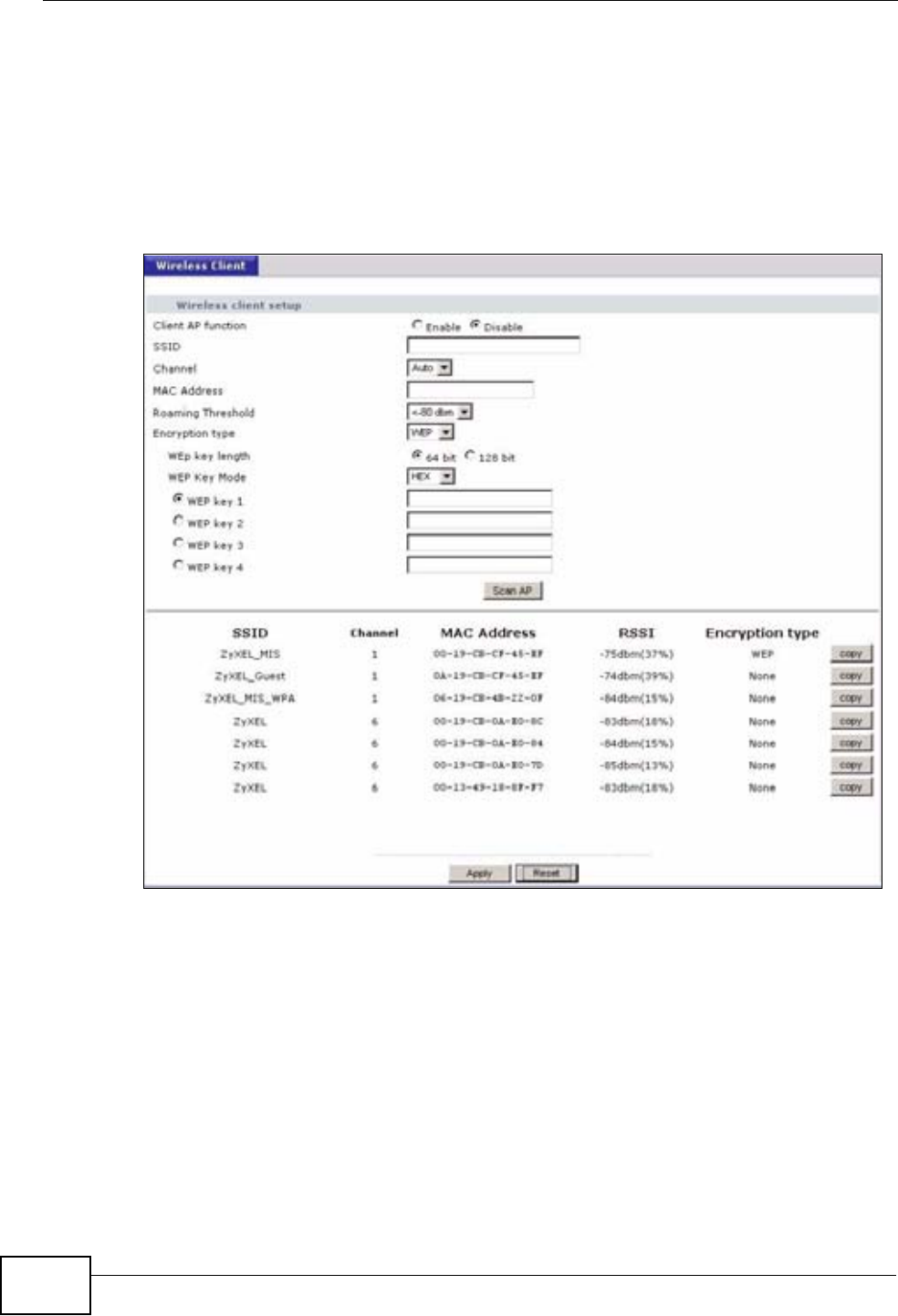
Chapter 5 Wireless Client Mode
P-320W v3 User’s Guide
74
5.3 Wireless Client Mode Screen
Use this screen to use your P-320W v3 as a wireless client and connect to an
existing AP.
Click Wireless Client Mode to open the following screen.
Figure 44 Wireless Client Mode

Chapter 5 Wireless Client Mode
P-320W v3 User’s Guide 75
The following table describes the labels in this screen.
Table 34 Summary: DHCP Table
LABEL DESCRIPTION
Client AP
Function
Select Enable to use your P-320W v3 as a wireless client and connect to
an existing AP.
Select Disable to use your P-320W v3 as a router or an access point if the
network to which you are connecting already has a router. Your P-320W v3
is configured as a router/access point by default.
SSID Enter the name of the access point to which you are connecting.
You can also copy the SSID of the access point to which you want to
connect by clicking copy in the list of access points that appears when you
click Scan AP.
Channel Select the channel of the access point to which you are connecting.
Note: To comply with US FCC regulation, the country selection
function has been completely removed from all US models. The
above function is for non-US models only.
MAC Address Enter the MAC address of the access point to which you are connecting.
Roaming
Threshold
Select the signal strength threshold between the wireless client and the
access point.
When the signal strength between the two devices goes below the value
you set in this field, the wireless client searches for and connects to
another access point within the roaming threshold.
Encryption
type
Select WEP if you want to secure the wireless connection.Otherwise,
select No Security.
WEP key
length
This field appears when you select WEP as the security type.
Select either 64 bit or 128 bit as the key length for your WEP key.
WEP Key
Mode
This field appears when you select WEP as the security type.
Select either HEX or ASCII as the key length for your WEP key.
WEP Key 1 to
4
This field appears when you select WEP as the security type.
Select which WEP key you want to use for your wireless connection. By
default, the P-320W v3 uses WEP key 1.
Scan AP Click this to view a list of available access points to which you can connect.
SSID This is the SSID of the access point.
Channel This is the channel of the access point.
MAC Address This is the MAC Address of the access point.
RSSI This is the RSSI or signal strength of the access point.
Encryption
type
This is the encryption type of the access point.
copy Click this to copy the SSID of the access point to the SSID field.
Apply Click Apply to save your changes back to the P-320W v3.
Reset Click Reset to reload the previous configuration for this screen.

Chapter 5 Wireless Client Mode
P-320W v3 User’s Guide
76
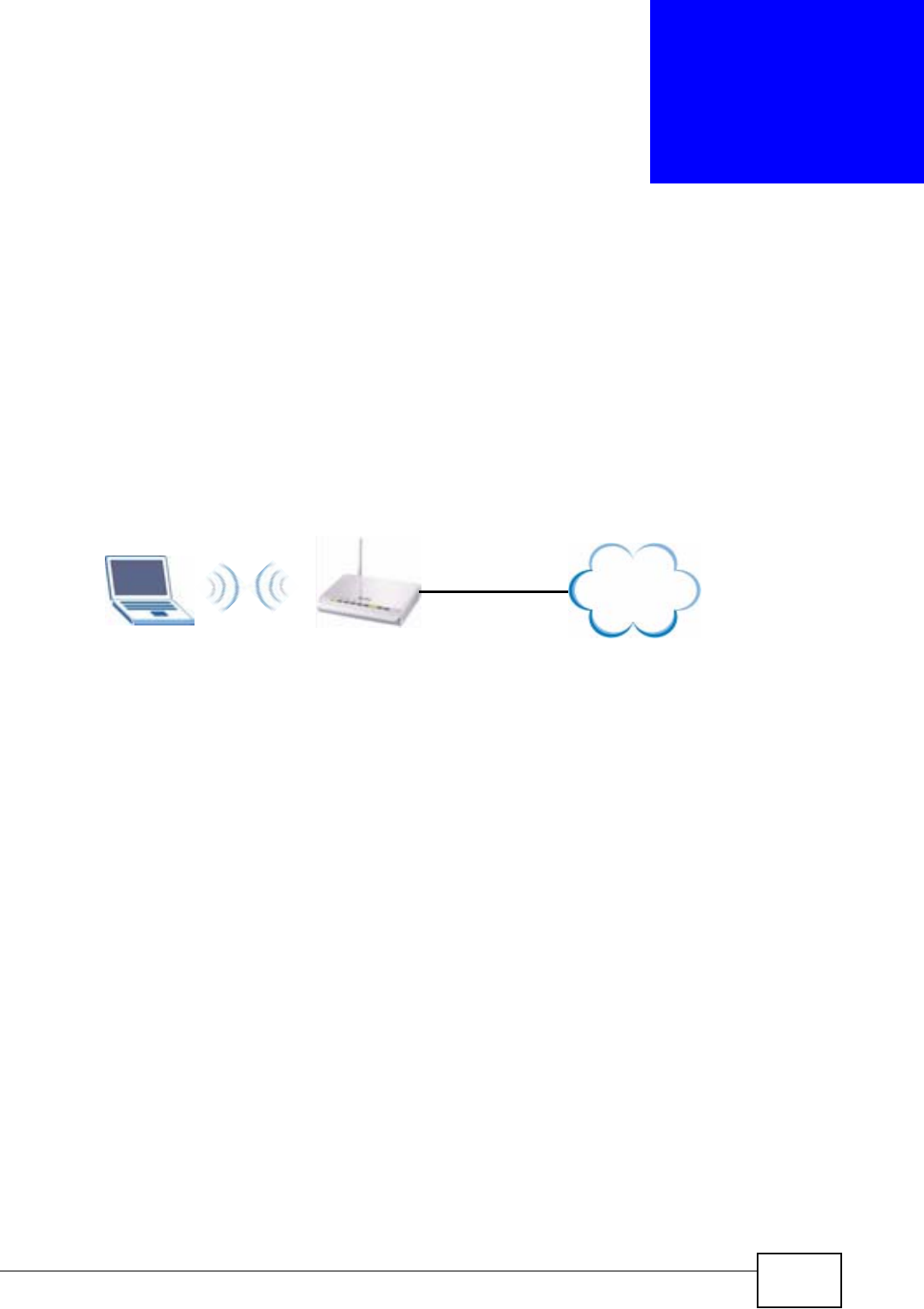
P-320W v3 User’s Guide 77
CHAPTER 6
Wireless Tutorial
6.1 How to Connect to the Internet from an AP
This section gives you an example of how to set up an access point (AP) and
wireless client (a notebook (B), in this example) for wireless communication. B
can access the Internet through the AP wirelessly.
Figure 45 Wireless AP Connection to the Internet
6.2 Configure Wireless Security Using WPS on
both your P-320W v3 and Wireless Client
This section gives you an example of how to set up wireless network using WPS.
This example uses the P-320W v3 as the AP and NWD210N as the wireless client
which connects to a notebook.
Note: The wireless client must be a WPS-aware device (for example, a WPS USB
adapter or PCI card).
There are two WPS methods for creating a secure connection. This tutorial shows
you how to do both.
•Push Button Configuration (PBC) - create a secure wireless network simply
by pressing a button. See Section 6.2.1 on page 78.This is the easier method.
•PIN Configuration - create a secure wireless network simply by entering a
wireless client's PIN (Personal Identification Number) in the P-320W v3’s
interface. See Section 6.2.2 on page 79. This is the more secure method, since
one device can authenticate the other.
Internet
AP
B

Chapter 6 Wireless Tutorial
P-320W v3 User’s Guide
78
6.2.1 Push Button Configuration (PBC)
1Make sure that your P-320W v3 is turned on and that it is within range of your
computer.
2Make sure that you have installed the wireless client (this example uses the
NWD210N) driver and utility in your notebook.
3In the wireless client utility, find the WPS settings. Enable WPS and press the WPS
button (Start or WPS button)
4Log into P-320W v3’s web configurator and press the Push Button button in the
Network > Wireless Client >WPS Station screen.
Note: Your P-320W v3 has a WPS button located on its panel, as well as a WPS
button in its configuration utility. Both buttons have exactly the same function;
you can use one or the other.
Note: It doesn’t matter which button is pressed first. You must press the second
button within two minutes of pressing the first one.
The P-320W v3 sends the proper configuration settings to the wireless client. This
may take up to two minutes. Then the wireless client is able to communicate with
the P-320W v3 securely.
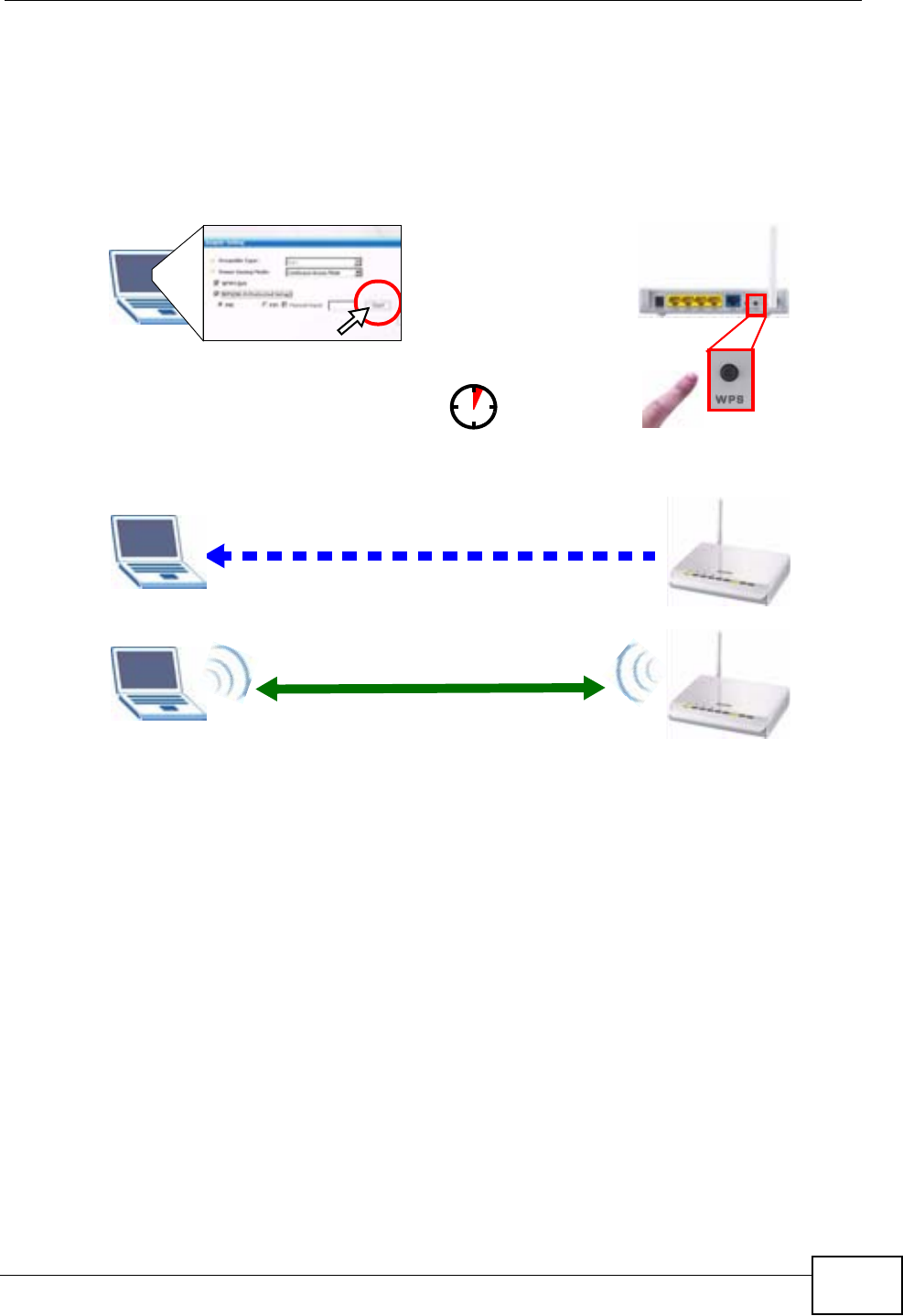
Chapter 6 Wireless Tutorial
P-320W v3 User’s Guide 79
The following figure shows you an example to set up wireless network and security
by pressing a button on both P-320W v3 and wireless client (the NWD210N in this
example).
Figure 46 Example WPS Process: PBC Method
6.2.2 PIN Configuration
When you use the PIN configuration method, you need to use both P-320W v3’s
configuration interface and the client’s utilities.
1Launch your wireless client’s configuration utility. go to the WPS settings and
select the PIN method to get a PIN number.
2Enter the PIN number to the PIN field in the Network > Wireless LAN >WPS
Station screen on the P-320W v3.
3Click Start buttons (or button next to the PIN field) on both the wireless client
utility screen and the P-320W v3’s WPS Station screen within two minutes.
The P-320W v3 authenticates the wireless client and sends the proper
configuration settings to the wireless client. This may take up to two minutes.
Then the wireless client is able to communicate with the P-320W v3 securely.
Wireless Client P-320W V3
SECURITY INFO
COMMUNICATION
WITHIN 2 MINUTES
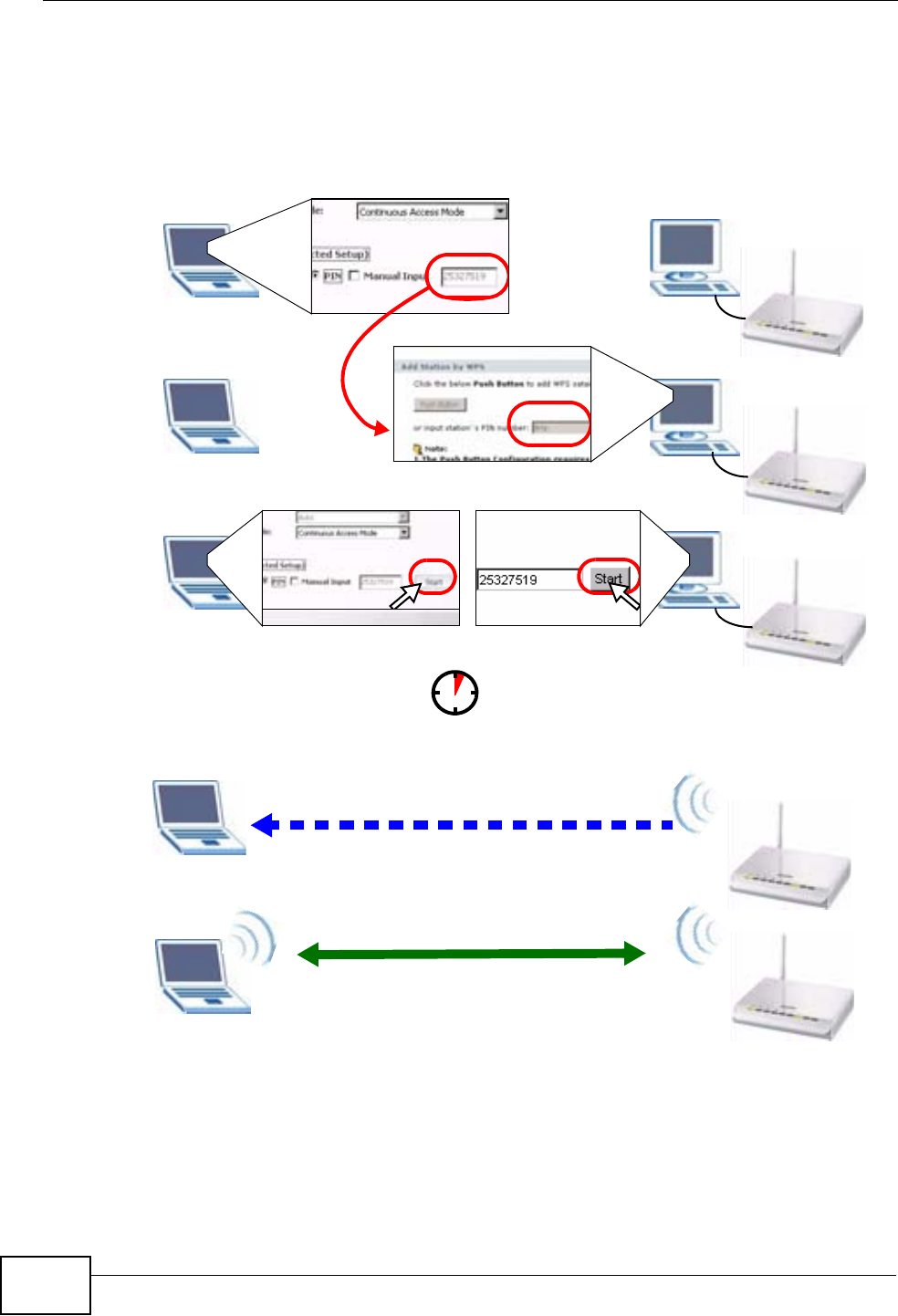
Chapter 6 Wireless Tutorial
P-320W v3 User’s Guide
80
The following figure shows you the example to set up wireless network and
security on P-320W v3 and wireless client (ex. NWD210N in this example) by
using PIN method.
Figure 47 Example WPS Process: PIN Method
Authentication by PIN
SECURITY INFO
WITHIN 2 MINUTES
Wireless Client
P-320W v3
COMMUNICATION
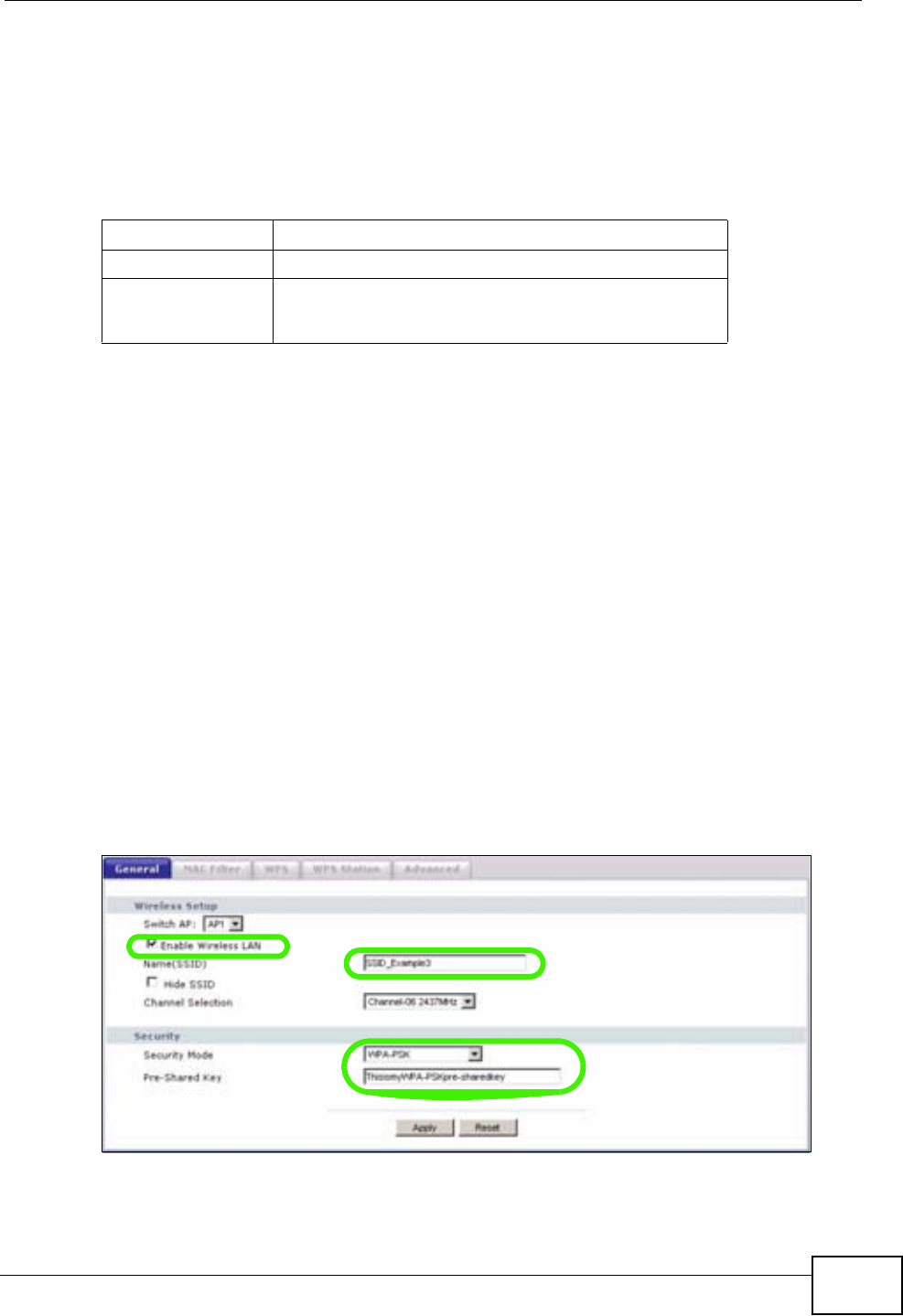
Chapter 6 Wireless Tutorial
P-320W v3 User’s Guide 81
6.3 Enable and Configure Wireless Security
without WPS on your P-320W v3
This example shows you how to configure wireless security settings with the
following parameters on your P-320W v3.
Follow the steps below to configure the wireless settings on your P-320W v3.
The instructions require that your hardware is connected (see the Quick Start
Guide) and you are logged into the web configurator through your LAN connection
(see Section 2.2 on page 25).
1Open the Wireless LAN > General screen in the AP’s web configurator.
2Make sure the Enable Wireless LAN check box is selected.
3Enter SSID_Example3 as the SSID and select a channel.
Note: To comply with US FCC regulation, the country selection function has been
completely removed from all US models. The above function is for non-US
models only.
4Set security mode to WPA-PSK and enter ThisismyWPA-PSKpre-sharedkey in
the Pre-Shared Key field. Click Apply.
Figure 48 Network > Wireless LAN > General
SSID SSID_Example3
Channel 6
Security WPA-PSK
(Pre-Shared Key: ThisismyWPA-PSKpre-sharedkey)
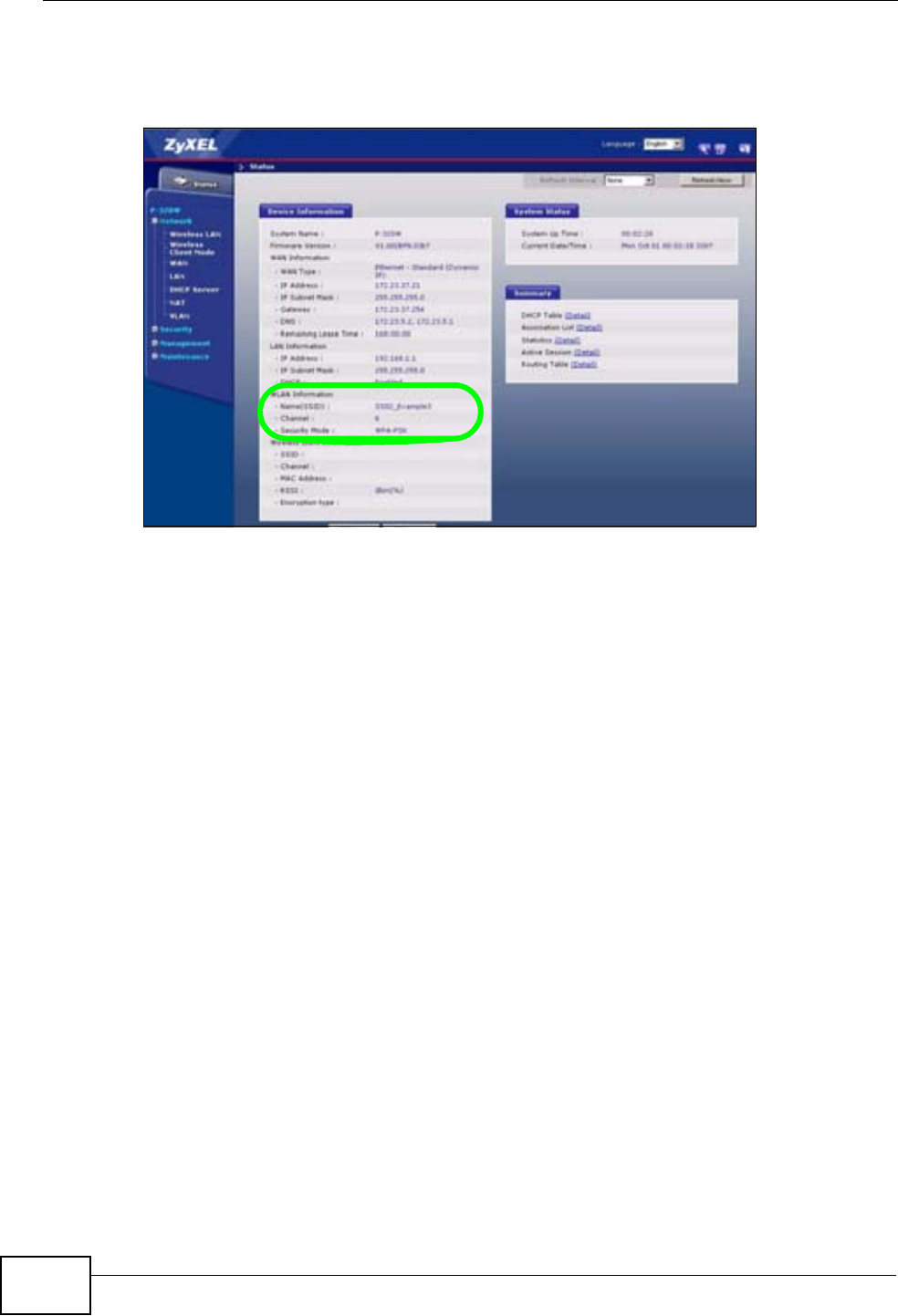
Chapter 6 Wireless Tutorial
P-320W v3 User’s Guide
82
5Open the Status screen. Verify your wireless and wireless security settings under
Device Information.
Figure 49 Status: AP Mode
6.4 Configure Your Notebook
Note: We use the ZyXEL M-302 wireless adapter utility screens as an example for the
wireless client. The screens may vary for different models.
1The P-320W v3 supports IEEE 802.11b and IEEE 802.11g wireless clients. Make
sure that your notebook or computer’s wireless adapter supports one of these
standards.
2Wireless adapters come with software sometimes called a “utility” that you install
on your computer. See your wireless adapter’s User’s Guide for information on
how to do that.
3After you’ve installed the utility, open it. If you cannot see your utility’s icon on
your screen, go to Start > Programs and click on your utility in the list of
programs that appears. The utility displays a list of APs within range, as shown in
the example screen below.
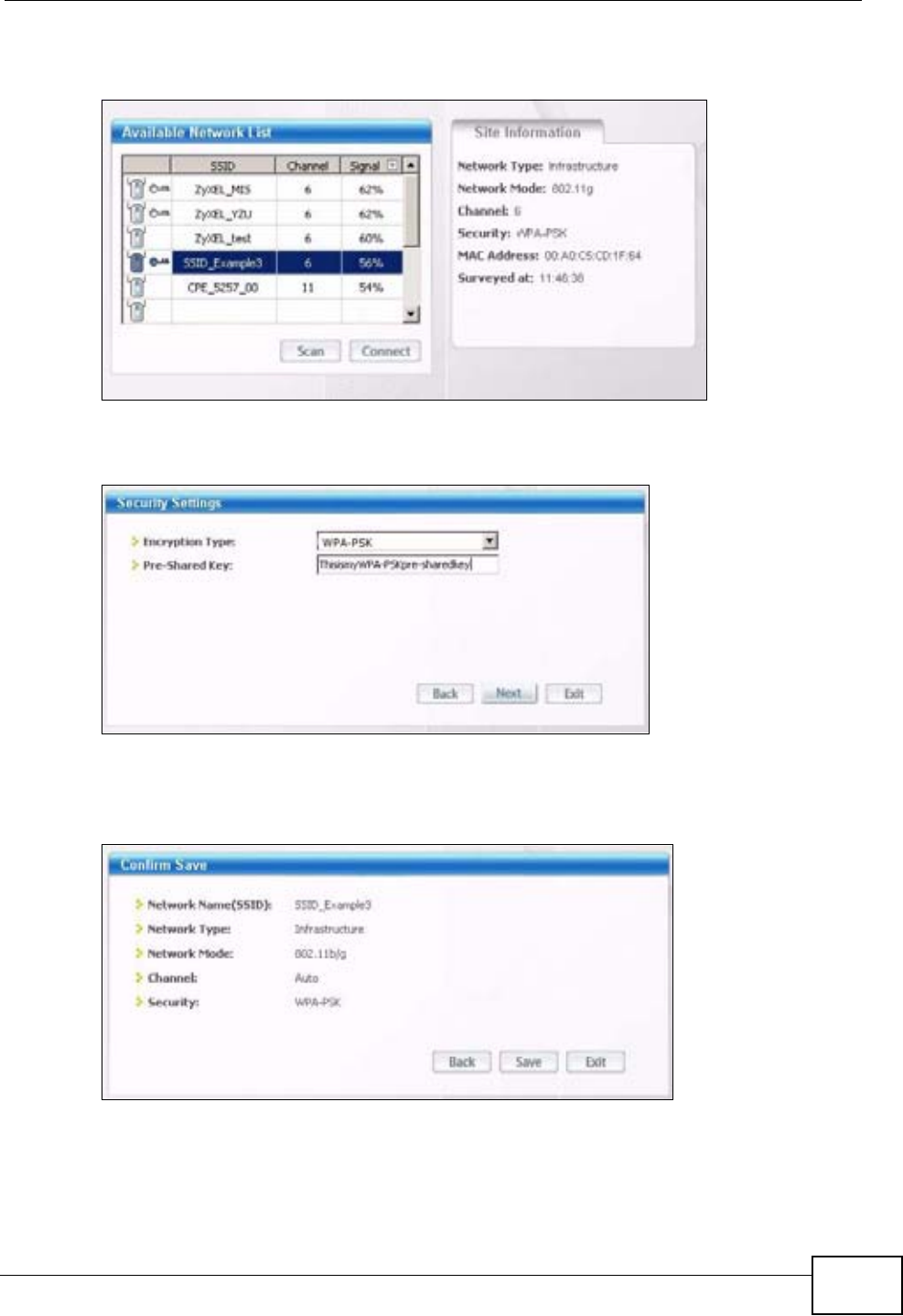
Chapter 6 Wireless Tutorial
P-320W v3 User’s Guide 83
4Select SSID_Example3 and click Connect.
Figure 50 Connecting a Wireless Client to a Wireless Network t
5Select WPA-PSK and type the security key in the following screen. Click Next.
Figure 51 Security Settings
6The Confirm Save window appears. Check your settings and click Save to
continue.
Figure 52 Confirm Save

Chapter 6 Wireless Tutorial
P-320W v3 User’s Guide
84
7Check the status of your wireless connection in the screen below. If your wireless
connection is weak or you have no connection, see the Troubleshooting section of
this User’s Guide.
Figure 53 Link Status
8If your connection is successful, open your Internet browser and enter http://
www.zyxel.com or the URL of any other web site in the address bar. If you are able
to access the web site, your wireless connection is successfully configured.
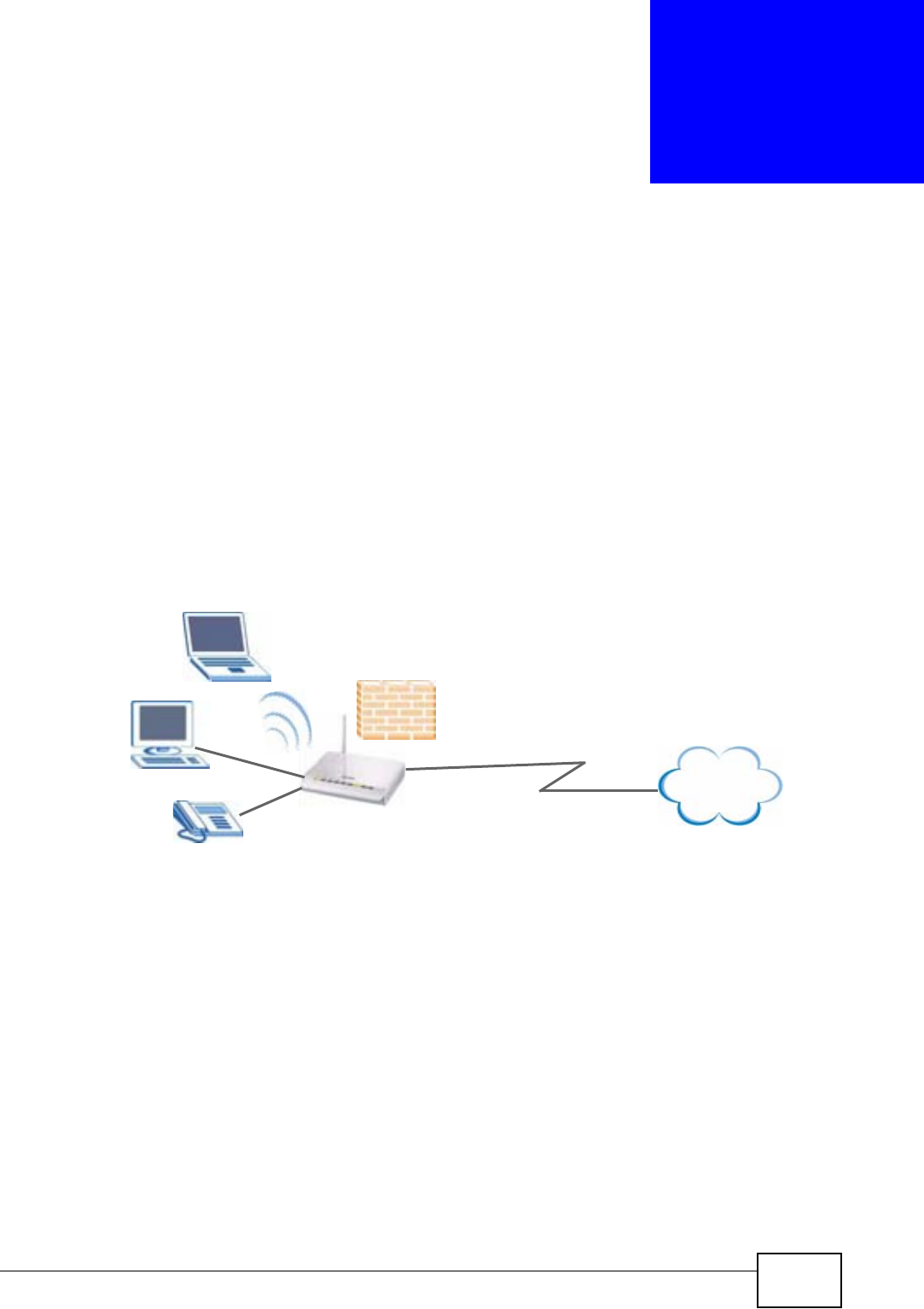
P-320W v3 User’s Guide 85
CHAPTER 7
LAN
7.1 Overview
This chapter describes how to configure LAN settings.
A Local Area Network (LAN) is a shared communication system to which many
computers are attached. A LAN is a computer network limited to the immediate
area, usually the same building or floor of a building. The LAN screen can help you
identify your local network.
Figure 54 Local Area Network
7.2 What You Can Do
Use the LAN IP screen (Section 7.4 on page 87) to change your basic LAN
settings.
7.3 What You Need to Know
The following sections provide information that you may need when configuring
the LAN IP screen.
DSL
LAN
Internet

Chapter 7 LAN
P-320W v3 User’s Guide
86
7.3.1 IP Pool Setup
The P-320W v3 is pre-configured with a pool of 32 IP addresses starting from
192.168.1.33 to 192.168.1.64. This configuration leaves 31 IP addresses
(excluding the P-320W v3 itself) in the lower range (192.168.1.2 to
192.168.1.32) for other server computers, for instance, servers for mail, FTP,
TFTP, web, etc., that you may have.
7.3.2 System DNS Servers
Refer to Section 3.4.6 on page 48 in the Connection Wizard chapter.
7.3.3 LAN TCP/IP
The P-320W v3 has built-in DHCP server capability that assigns IP addresses and
DNS servers to systems that support DHCP client capability.
7.3.4 Factory LAN Defaults
The LAN parameters of the P-320W v3 are preset in the factory with the following
values:
• IP address of 192.168.1.1 with subnet mask of 255.255.255.0 (24 bits)
• DHCP server enabled with 32 client IP addresses starting from 192.168.1.33.
These parameters should work for the majority of installations. If your ISP gives
you explicit DNS server address(es), read the embedded web configurator help
regarding what fields need to be configured.
7.3.5 IP Address and Subnet Mask
Refer to the IP address and subnet mask section in the Connection Wizard
chapter for this information.
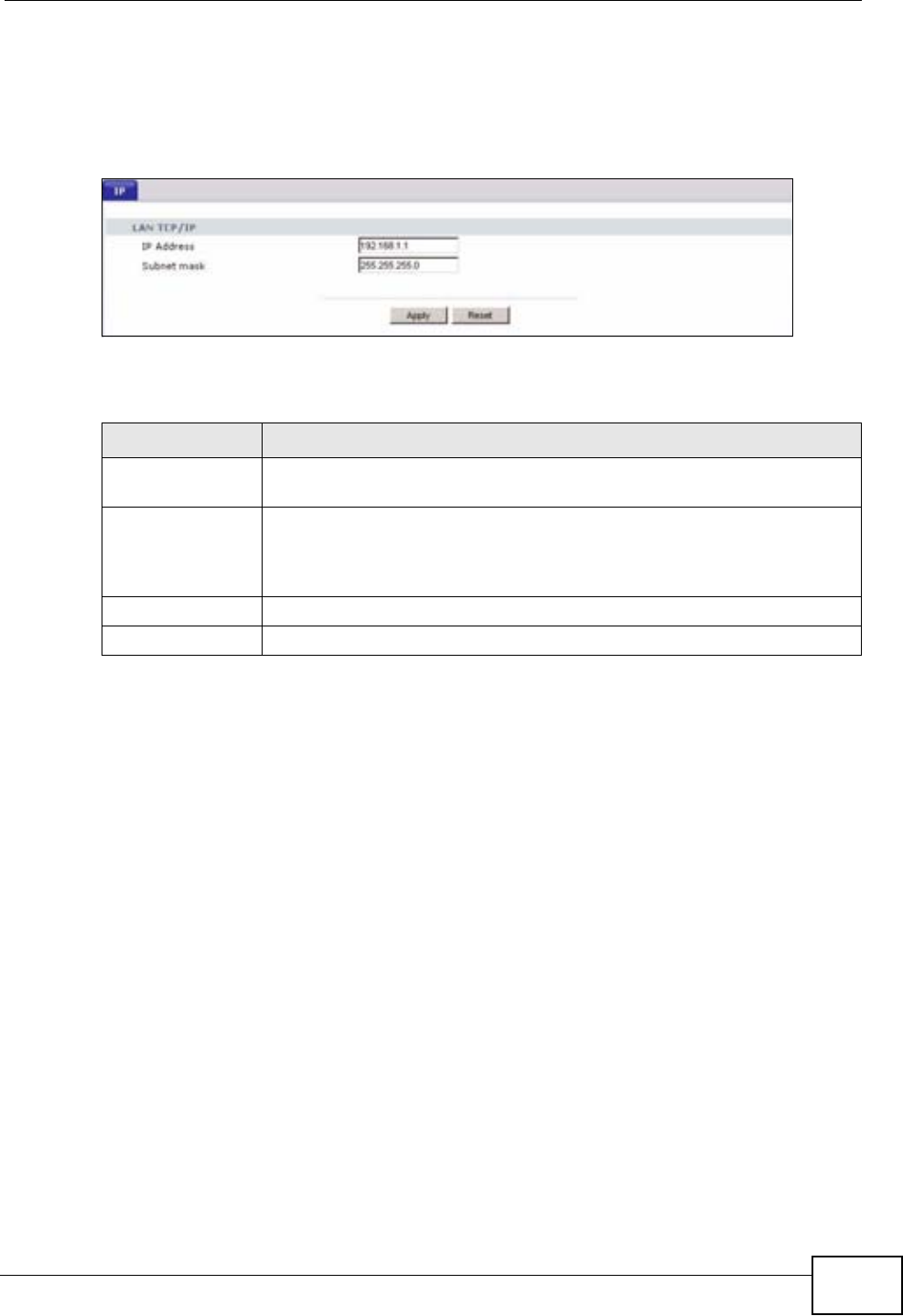
Chapter 7 LAN
P-320W v3 User’s Guide 87
7.4 LAN IP Screen
Use this screen to change your basic LAN settings. Click Network > LAN.
Figure 55 Network > LAN > IP
The following table describes the labels in this screen.
Table 35 Network > LAN > IP
LABEL DESCRIPTION
IP Address Type the IP address of your P-320W v3 in dotted decimal notation
192.168.1.1 (factory default).
IP Subnet Mask The subnet mask specifies the network number portion of an IP
address. Your P-320W v3 will automatically calculate the subnet mask
based on the IP address that you assign. Unless you are implementing
subnetting, use the subnet mask computed by the P-320W v3.
Apply Click Apply to save your changes back to the P-320W v3.
Reset Click Reset to begin configuring this screen afresh.

Chapter 7 LAN
P-320W v3 User’s Guide
88

P-320W v3 User’s Guide 89
CHAPTER 8
DHCP Server
8.1 Overview
DHCP (Dynamic Host Configuration Protocol, RFC 2131 and RFC 2132) allows
individual clients to obtain TCP/IP configuration at start-up from a server. You can
configure the P-320W v3’s DHCP server(s) or disable it.
When configured as a server, the P-320W v3 provides the TCP/IP configuration for
the clients. If DHCP service is disabled, you must have another DHCP server on
your LAN or Guest WLAN, or else the computer must be manually configured.
8.2 What You Can Do
•Use the DHCP Server General screen (Section 8.3 on page 89) to enable and
configure your DHCP server.
•Use the Static DHCP screen (Section 8.4 on page 91) to change your P-320W
v3’s Static DHCP settings.
•Use the Client List screen (Section 8.5 on page 91) to view a list of current
DHCP client information.
8.3 DHCP Server General Screen
Use this screen to enable and configure your DHCP server.
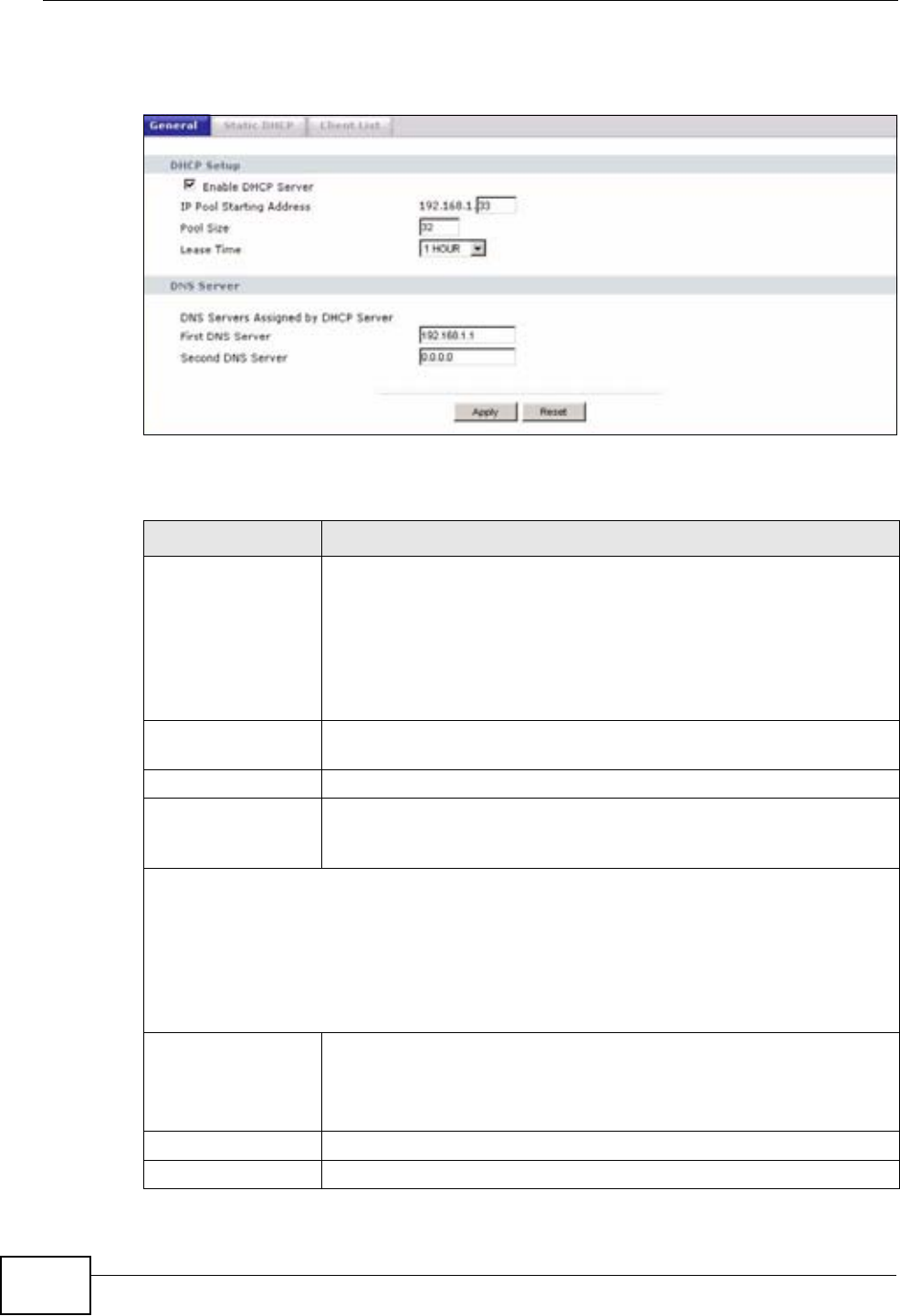
Chapter 8 DHCP Server
P-320W v3 User’s Guide
90
Click Network > DHCP Server. The following screen displays.
Figure 56 Network > DHCP Server > General
The following table describes the labels in this screen.
Table 36 Network > DHCP Server > General
LABEL DESCRIPTION
Enable DHCP
Server
Leave the check box selected unless your ISP instructs you to do
otherwise. Clear it to disable the P-320W v3 acting as a DHCP
server.
When configured as a server, the P-320W v3 provides TCP/IP
configuration for the clients. If not, DHCP service is disabled and
you must have another DHCP server on your LAN, or else the
computers must be manually configured.
IP Pool Starting
Address
This field specifies the first of the contiguous addresses in the IP
address pool.
Pool Size This field specifies the size, or count of the IP address pool.
Lease Time Select how long a computer can lease its IP address in the network.
You can select from 1 HOUR (default) to as long as Forever
(unlimited time).
DNS Servers
The P-320W v3 passes a DNS (Domain Name System) server IP address (in the order you
specify here) to the DHCP clients. The P-320W v3 only passes this information to the LAN
DHCP clients when you select the Enable DHCP Server check box. When you clear the
Enable DHCP Server check box, DHCP service is disabled and you must have another
DHCP sever on your LAN, or else the computers must have their DNS server addresses
manually configured.
First DNS Server
Second DNS Server
Enter the IP address(es) of the DNS server(s). If you do not
configure a DNS server, you must know the IP address of a
computer in order to access it.
Apply Click Apply to save your changes back to the P-320W v3.
Reset Click Reset to begin configuring this screen afresh.
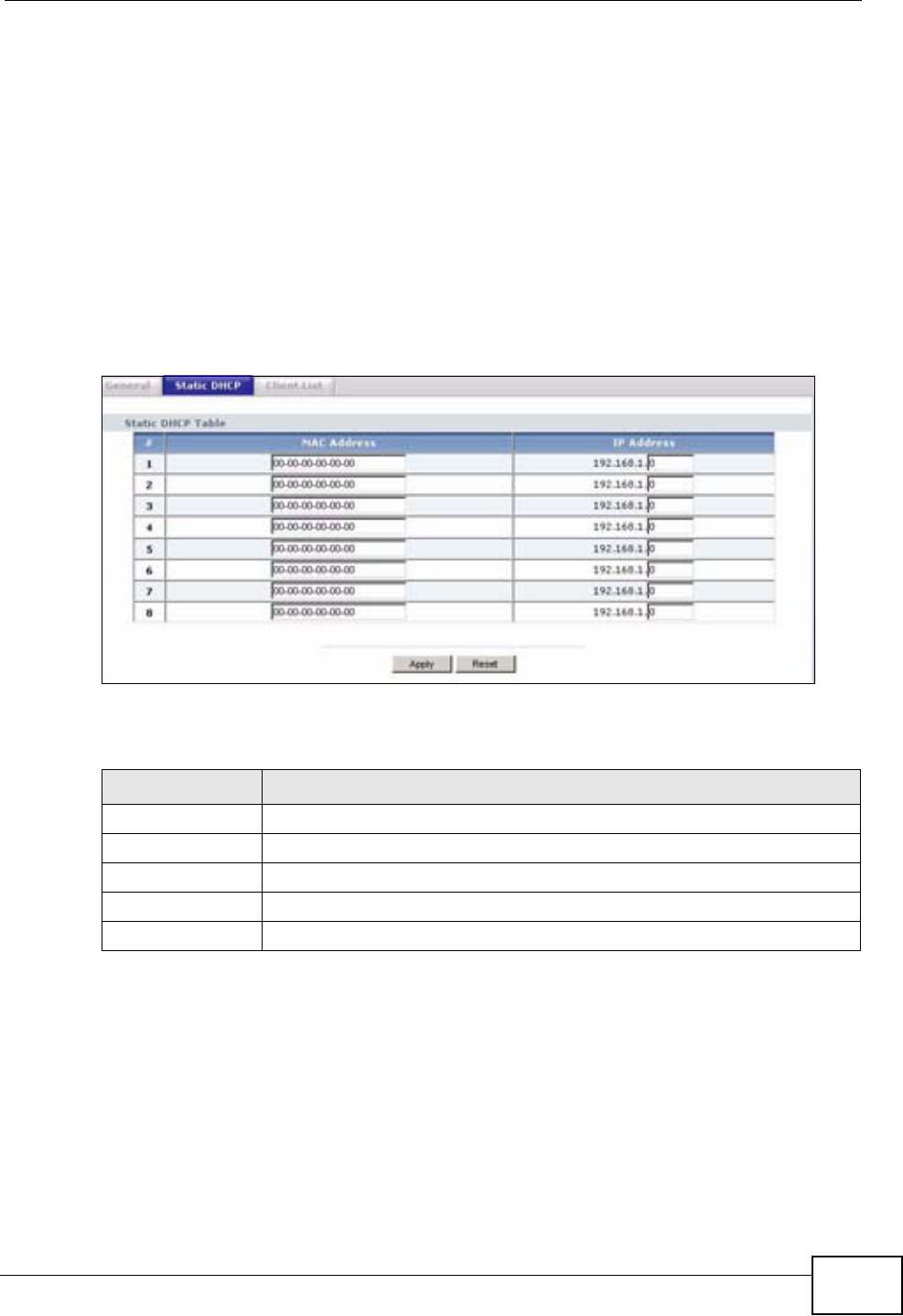
Chapter 8 DHCP Server
P-320W v3 User’s Guide 91
8.4 Static DHCP Screen
This table allows you to assign IP addresses on the LAN to specific individual
computers based on their MAC addresses.
Every Ethernet device has a unique MAC (Media Access Control) address. The MAC
address is assigned at the factory and consists of six pairs of hexadecimal
characters, for example, 00-A0-C5-00-00-02.
To change your P-320W v3’s Static DHCP settings, click the DHCP Server link
under Network and the Static DHCP tab. The following screen displays.
Figure 57 Network > DHCP Server > Advanced
The following table describes the labels in this screen.
8.5 Client List Screen
The DHCP table shows current DHCP client information (including IP Address,
Host Name and MAC Address) of LAN or Guest WLAN network clients using the
P-320W v3’s DHCP servers.
Table 37 Network > DHCP Server > Advanced
LABEL DESCRIPTION
# This is the index number of the static IP table entry (row).
MAC Address Type the MAC address (with colons) of a computer on your LAN.
IP Address Type the LAN IP address of a computer on your LAN.
Apply Click Apply to save your changes back to the P-320W v3.
Reset Click Reset to begin configuring this screen afresh.
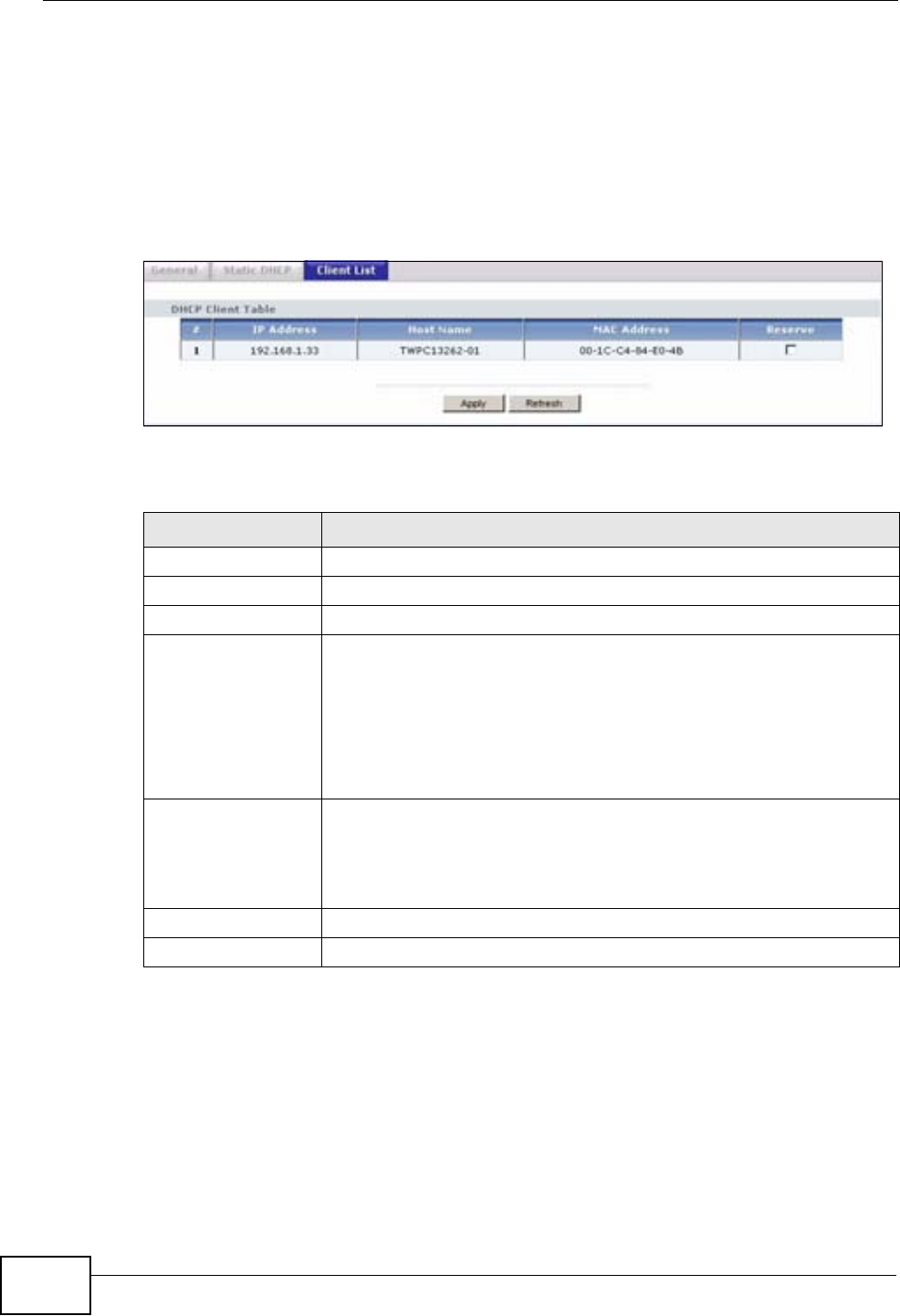
Chapter 8 DHCP Server
P-320W v3 User’s Guide
92
Configure this screen to always assign an IP address to a MAC address (and host
name). Click Network > DHCP Server > Client List.
Note: You can also view a read-only client list by clicking the DHCP Table (Details...)
hyperlink in the Status screen.
The following screen displays.
Figure 58 Network > DHCP Server > Client List
The following table describes the labels in this screen.
Table 38 Network > DHCP Server > Client List
LABEL DESCRIPTION
# This is the index number of the host computer.
IP Address This field displays the IP address relative to the # field listed above.
Host Name This field displays the computer host name.
MAC Address The MAC (Media Access Control) or Ethernet address on a LAN
(Local Area Network) is unique to your computer (six pairs of
hexadecimal notation).
A network interface card such as an Ethernet adapter has a
hardwired address that is assigned at the factory. This address
follows an industry standard that ensures no other adapter has a
similar address.
Reserve Select this check box in the LAN DHCP Setup or Guest WLAN
DHCP Setup section to have the P-320W v3 always assign the IP
address(es) to the MAC address(es) (and host name(s)). After you
click Apply, the MAC address and IP address also display in the
Advanced screen (where you can edit them).
Apply Click Apply to save your settings.
Refresh Click Refresh to reload the DHCP table.

P-320W v3 User’s Guide 93
CHAPTER 9
Network Address Translation
(NAT)
9.1 Overview
This chapter discusses how to configure NAT on the P-320W v3.
NAT (Network Address Translation - NAT, RFC 1631) is the translation of the IP
address of a host in a packet. For example, the source address of an outgoing
packet, used within one network is changed to a different IP address known within
another network.
9.2 What You Can Do
•Use the General NAT screen (Section 9.4 on page 96) to enable NAT on your P-
320W v3.
•Use the Port Forwarding screen (Section 9.5 on page 97) to define the local
servers to which the incoming services will be forwarded.
•Use the Trigger Port screen (Section 9.3.2 on page 95) change your P-320W
v3’s trigger port settings.
9.3 What You Need to Know
The following section provides information on how you can properly configure NAT.
Note: You must create a firewall rule in addition to setting up NAT, to allow traffic from
the WAN to be forwarded through the P-320W v3.
9.3.1 Port Forwarding: Services and Port Numbers
A port forwarding set is a list of inside (behind NAT on the LAN) servers, for
example, web or FTP, that you can make accessible to the outside world even
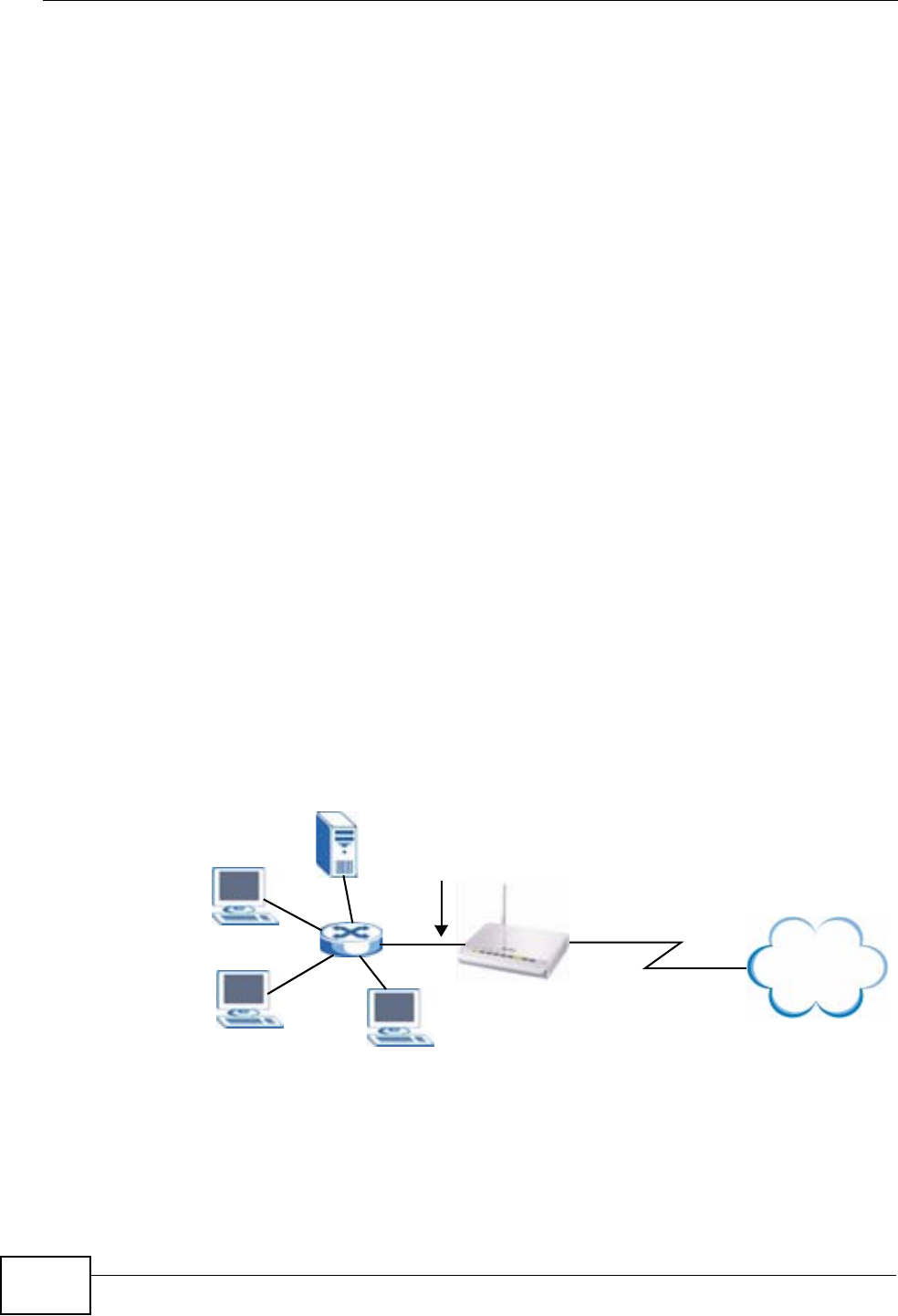
Chapter 9 Network Address Translation (NAT)
P-320W v3 User’s Guide
94
though NAT makes your whole inside network appear as a single machine to the
outside world.
Use the Application screen to forward incoming service requests to the server(s)
on your local network. You may enter a single port number or a range of port
numbers to be forwarded, and the local IP address of the desired server. The port
number identifies a service; for example, web service is on port 80 and FTP on
port 21. In some cases, such as for unknown services or where one server can
support more than one service (for example both FTP and web service), it might
be better to specify a range of port numbers.
In addition to the servers for specified services, NAT supports a default server. A
service request that does not have a server explicitly designated for it is forwarded
to the default server. If the default is not defined, the service request is simply
discarded.
Note: Many residential broadband ISP accounts do not allow you to run any server
processes (such as a Web or FTP server) from your location. Your ISP may
periodically check for servers and may suspend your account if it discovers any
active services at your location. If you are unsure, refer to your ISP.
9.3.1.1 Configuring Servers Behind Port Forwarding Example
Let's say you want to assign ports 21-25 to one FTP, Telnet and SMTP server (A in
the example), port 80 to another (B in the example) and assign a default server IP
address of 192.168.1.35 to a third (C in the example). You assign the LAN IP
addresses and the ISP assigns the WAN IP address. The NAT network appears as a
single host on the Internet
Figure 59 Multiple Servers Behind NAT Example
9.3.2 Trigger Port Forwarding
Some services use a dedicated range of ports on the client side and a dedicated
range of ports on the server side. With regular port forwarding you set a
forwarding port in NAT to forward a service (coming in from the server on the
Internet
LAN WAN
192.168.1.1
192.168.1.36
A=192.168.1.33
B=192.168.1.34
C=192.168.1.35
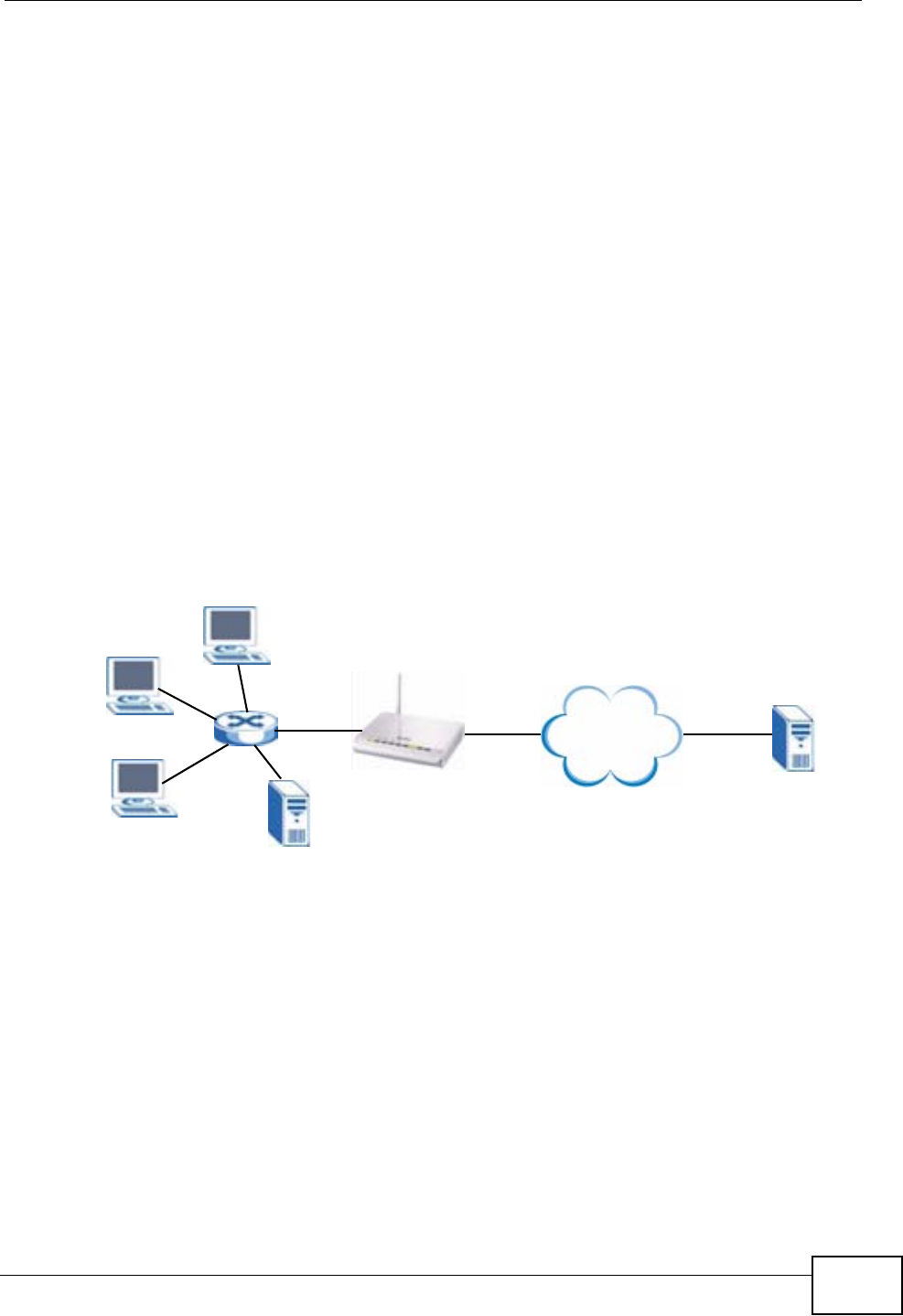
Chapter 9 Network Address Translation (NAT)
P-320W v3 User’s Guide 95
WAN) to the IP address of a computer on the client side (LAN). The problem is
that port forwarding only forwards a service to a single LAN IP address. In order to
use the same service on a different LAN computer, you have to manually replace
the LAN computer's IP address in the forwarding port with another LAN
computer's IP address.
Trigger port forwarding solves this problem by allowing computers on the LAN to
dynamically take turns using the service. The P-320W v3 records the IP address of
a LAN computer that sends traffic to the WAN to request a service with a specific
port number and protocol (a "trigger" port). When the P-320W v3's WAN port
receives a response with a specific port number and protocol ("incoming" port),
the P-320W v3 forwards the traffic to the LAN IP address of the computer that
sent the request. After that computer’s connection for that service closes, another
computer on the LAN can use the service in the same manner. This way you do not
need to configure a new IP address each time you want a different LAN computer
to use the application.
9.3.2.1 Trigger Port Forwarding Example
The following is an example of trigger port forwarding.
Figure 60 Trigger Port Forwarding Process: Example
1Jane requests a file from the Real Audio server (port 7070).
2Port 7070 is a “trigger” port and causes the P-320W v3 to record Jane’s computer
IP address. The P-320W v3 associates Jane's computer IP address with the
"incoming" port range of 6970-7170.
3The Real Audio server responds using a port number ranging between 6970-7170.
4The P-320W v3 forwards the traffic to Jane’s computer IP address.
5Only Jane can connect to the Real Audio server until the connection is closed or
times out. The P-320W v3 times out in three minutes with UDP (User Datagram
Protocol), or two hours with TCP/IP (Transfer Control Protocol/Internet Protocol).
Internet
Jane’s computer
Real Audio Server
Port 7070
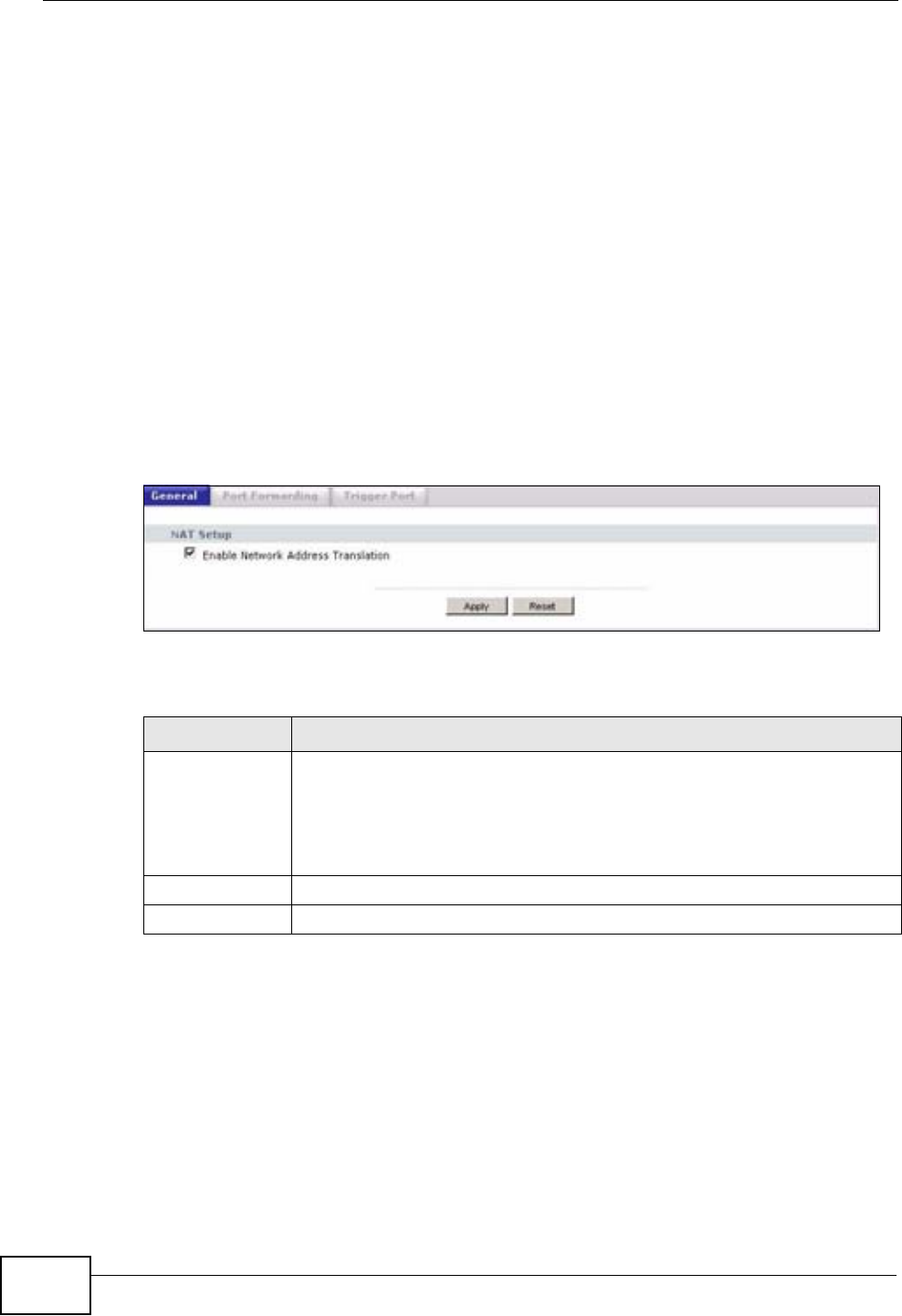
Chapter 9 Network Address Translation (NAT)
P-320W v3 User’s Guide
96
9.3.3 Two Points To Remember About Trigger Ports
1Trigger events only happen on data that is going coming from inside the P-320W
v3 and going to the outside.
2If an application needs a continuous data stream, that port (range) will be tied up
so that another computer on the LAN can’t trigger it.
9.4 General NAT Screen
Use this screen to enable NAT on your P-320W v3.
Click Network > NAT to open the General screen.
Figure 61 Network > NAT > General
The following table describes the labels in this screen.
9.5 Port Forwarding Screen
Port forwarding allows you to define the local servers to which the incoming
services will be forwarded. To change your P-320W v3’s port forwarding settings,
click Network > NAT > Application. The screen appears as shown.
Table 39 Network > NAT > General
LABEL DESCRIPTION
Enable Network
Address
Translation
Network Address Translation (NAT) allows the translation of an Internet
protocol address used within one network (for example a private IP
address used in a local network) to a different IP address known within
another network (for example a public IP address used on the Internet).
Select the check box to enable NAT.
Apply Click Apply to save your changes back to the P-320W v3.
Reset Click Reset to begin configuring this screen afresh.
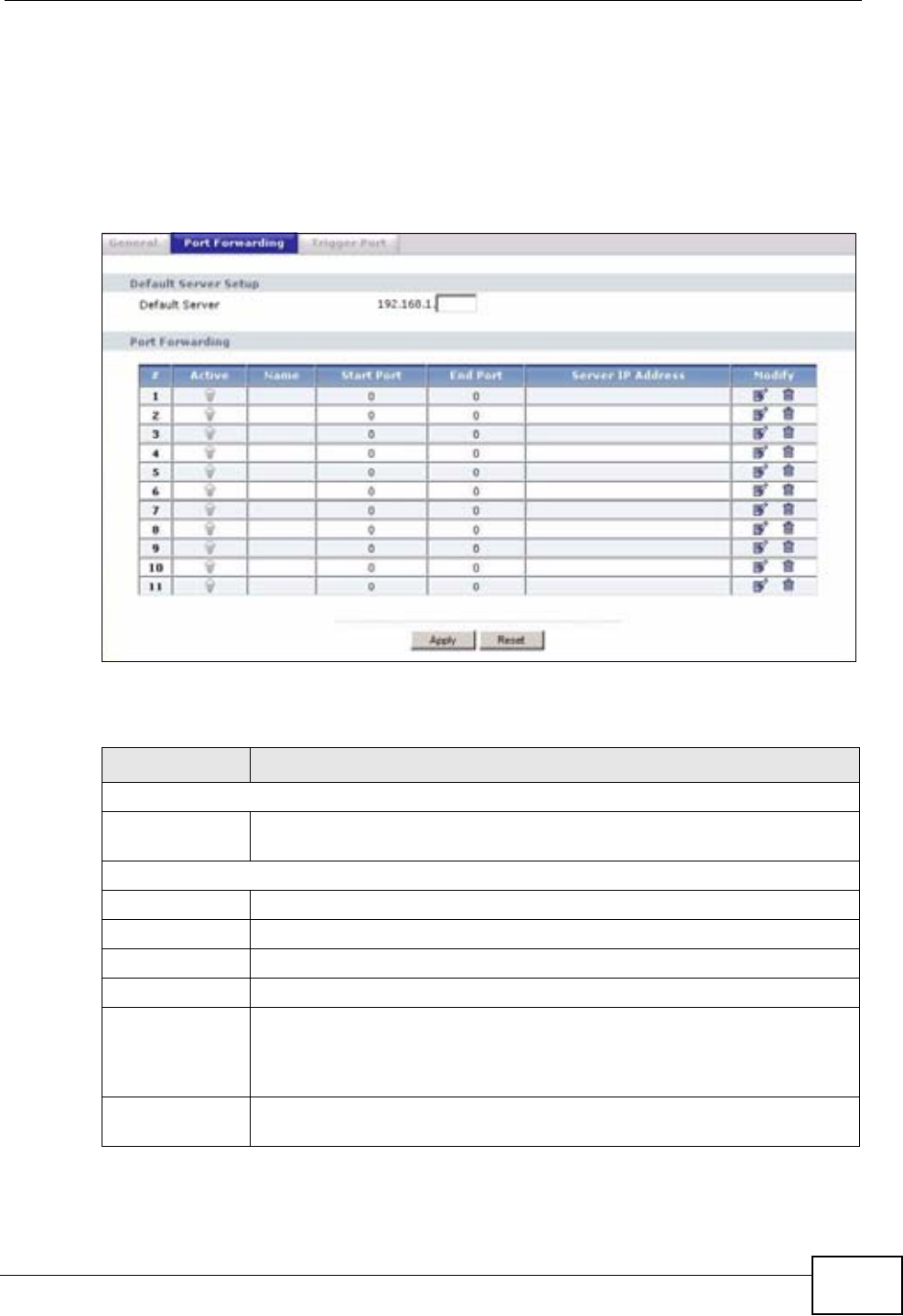
Chapter 9 Network Address Translation (NAT)
P-320W v3 User’s Guide 97
Note: If you do not assign a Default Server IP address in the NAT > General screen,
the P-320W v3 discards all packets received for ports that are not specified in
this screen or remote management.
Refer to Appendix E on page 247 for port numbers commonly used for particular
services.
Figure 62 Network > NAT > Application
The following table describes the labels in this screen.
Table 40 NAT Application
LABEL DESCRIPTION
Default Server Setup
Default Server Type the inside IP address of the server that receives packets from the
port(s) that are not specified in the Port field.
Port Forwarding
#This is the number of an individual port forwarding server entry.
Active This icon is turned on when the rule is enabled.
Name This field displays a name to identify this rule.
Start Port This field displays a start port number.
End Port This field displays an end port number. If the same port number as the
Start Port is displayed then a single port is forwarded. If a different
number to the Start Port number is displayed then a range of ports are
forwarded.
Server IP
Address
This field displays the inside IP address of the server.
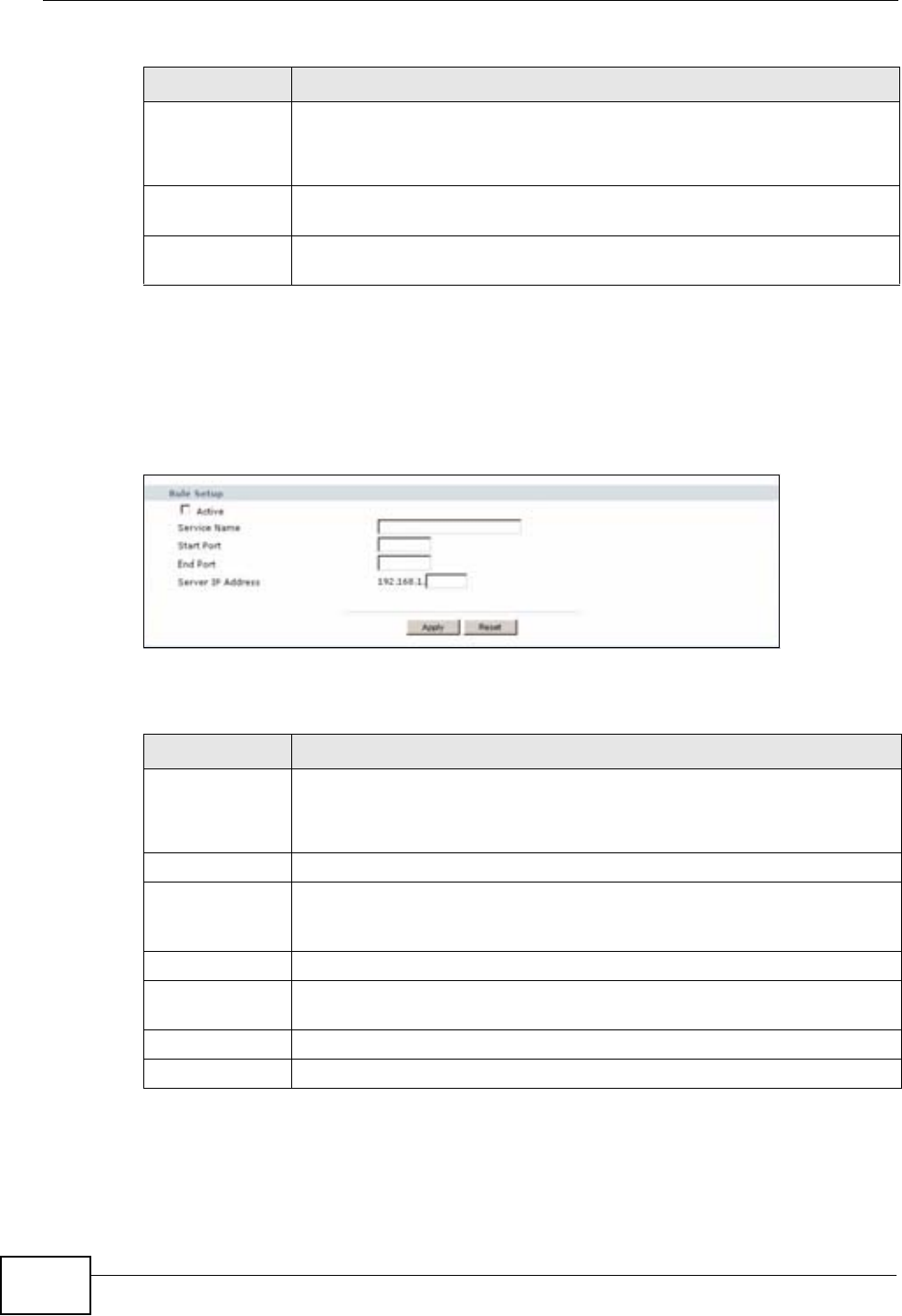
Chapter 9 Network Address Translation (NAT)
P-320W v3 User’s Guide
98
9.5.1 Rule Setup Screen
To edit a port forwarding rule, click the edit icon under Modify. The following
screen displays.
Figure 63 NAT: Port Forwarding: Rule Setup
The following table describes the labels in this screen.
Modify Click the Edit icon to display and modify an existing rule setting in the
fields under Add Application Rule.
Click the Remove icon to delete a rule.
Apply Click Apply to save your changes to the Application Rules Summary
table.
Reset Click Reset to not save and return your new changes in the Service
Name and Port fields to the previous one.
Table 40 NAT Application (continued)
LABEL DESCRIPTION
Table 41 Network > NAT > General
LABEL DESCRIPTION
Active Select the check box to enable this port forwarding entry.
Clear the checkbox to disallow forwarding of these ports to an inside
server without having to delete the entry.
Service Name Type a Service Name to identify this port-forwarding rule.
Start Port Type a start port number. To forward only one port, enter it again in the
End Port field. To specify a range of ports, enter the last port to be
forwarded in the End Port field.
End Port Type an end port number.
Server IP
Address
Type the inside IP address of the server.
Apply Click Apply to save your changes back to the P-320W v3.
Reset Click Reset to begin configuring this screen afresh.
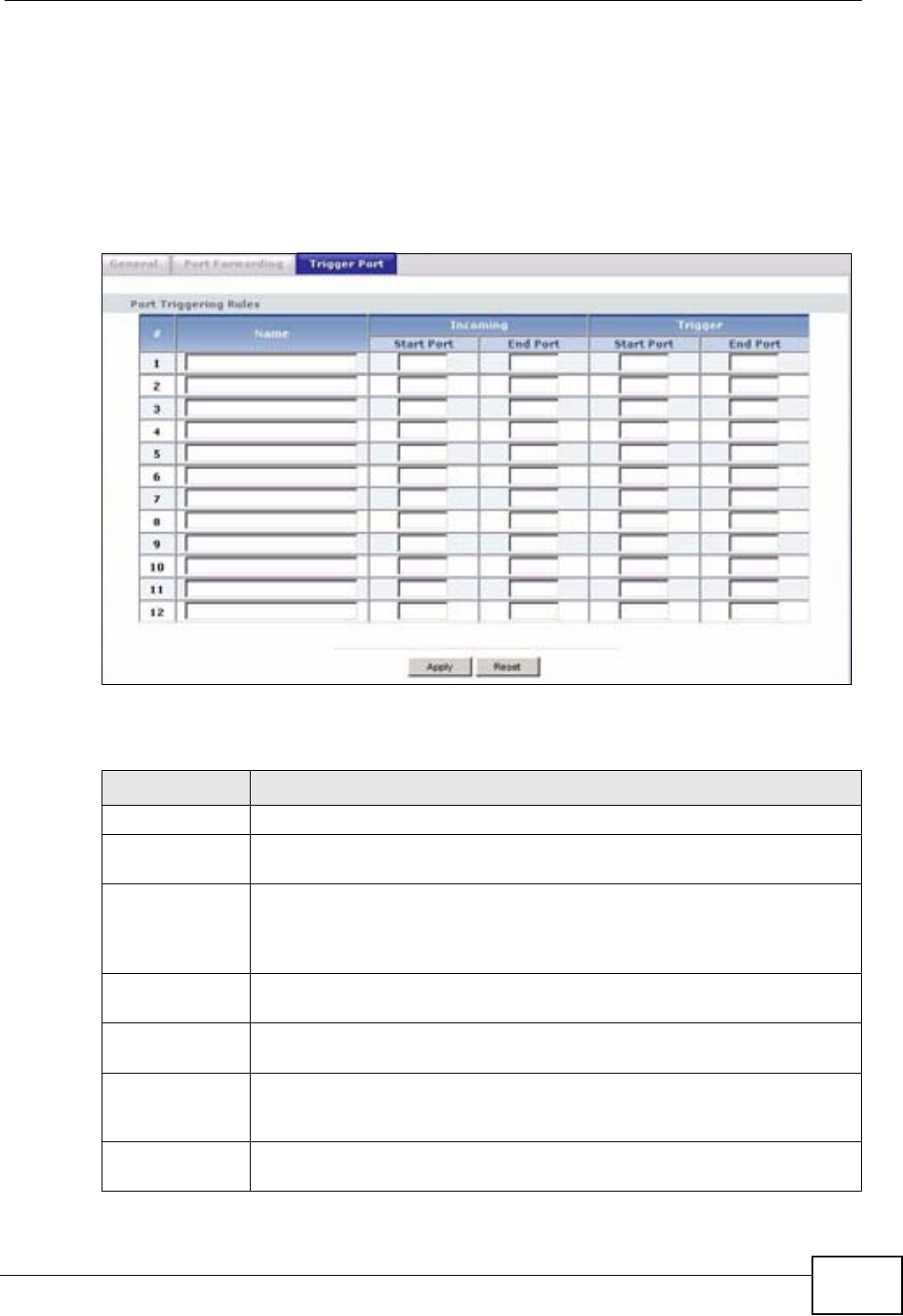
Chapter 9 Network Address Translation (NAT)
P-320W v3 User’s Guide 99
9.6 Trigger Port Screen
To change your P-320W v3’s trigger port settings, click Network > NAT >
Advanced. The screen appears as shown.
Note: Only one LAN computer can use a trigger port (range) at a time.
Figure 64 Network > NAT > Advanced
The following table describes the labels in this screen.
Table 42 Network > NAT > Advanced
LABEL DESCRIPTION
#This is the rule index number (read-only).
Name Type a unique name (up to 15 characters) for identification purposes. All
characters are permitted - including spaces.
Incoming Incoming is a port (or a range of ports) that a server on the WAN uses
when it sends out a particular service. The P-320W v3 forwards the
traffic with this port (or range of ports) to the client computer on the
LAN that requested the service.
Start Port Type a port number or the starting port number in a range of port
numbers.
End Port Type a port number or the ending port number in a range of port
numbers.
Trigger The trigger port is a port (or a range of ports) that causes (or triggers)
the P-320W v3 to record the IP address of the LAN computer that sent
the traffic to a server on the WAN.
Start Port Type a port number or the starting port number in a range of port
numbers.
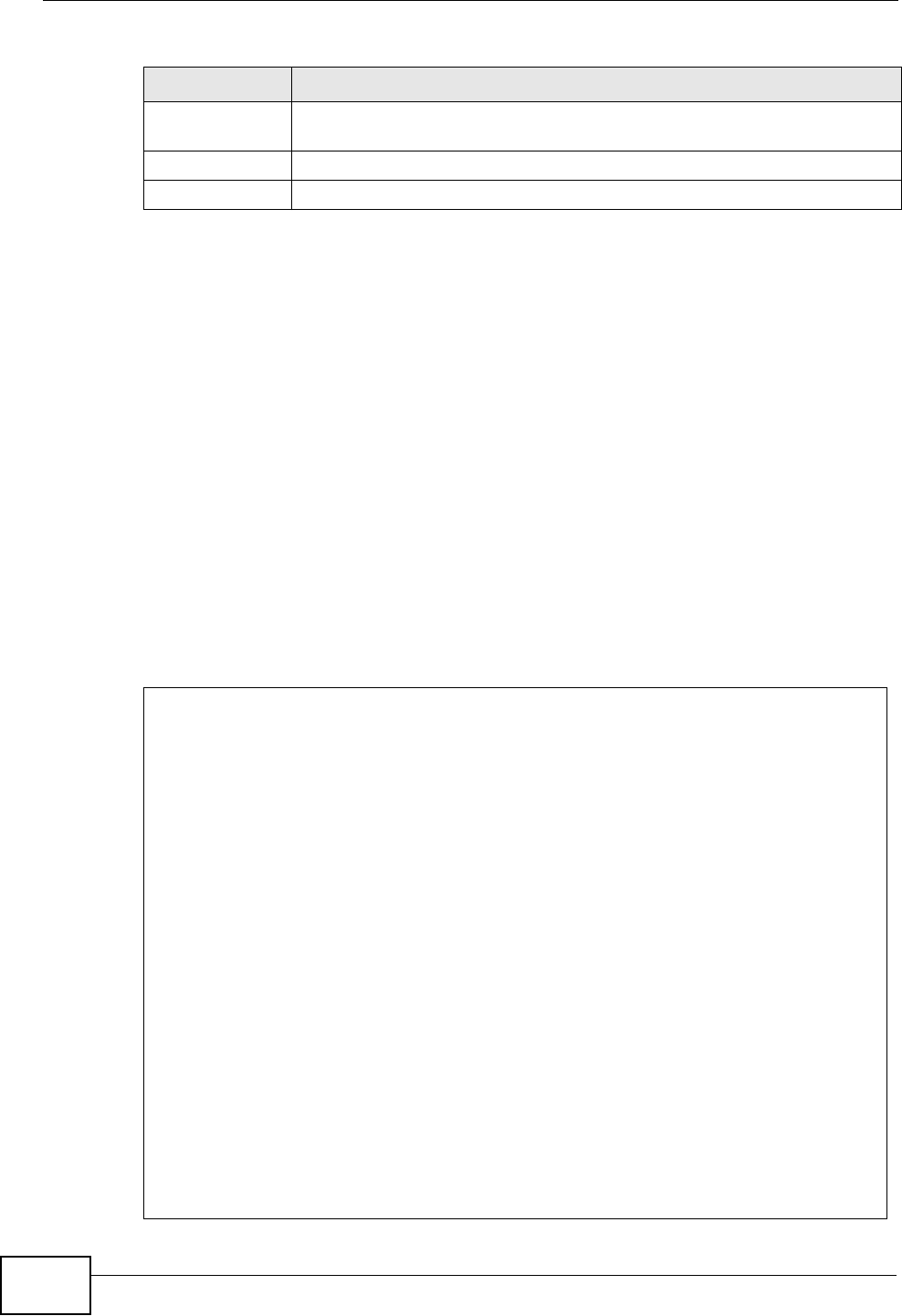
Chapter 9 Network Address Translation (NAT)
P-320W v3 User’s Guide
100
9.7 Technical Reference
This section provides some technical information about the topics covered in this
chapter.
9.7.1 Game List Example
Here is an example game list text file. The index number, service name and
associated port(s) are specified by semi-colons (no spaces). Use the name=xxx
(where xxx is the service name) to create a new service. Port range can be
separated with a hyphen (-) (no spaces). Multiple (non-consecutive) ports can be
separated by commas.
Figure 65 Game List Example
End Port Type a port number or the ending port number in a range of port
numbers.
Apply Click Apply to save your changes back to the P-320W v3.
Reset Click Reset to begin configuring this screen afresh.
Table 42 Network > NAT > Advanced
LABEL DESCRIPTION
version=1
1;name=Battlefield 1942;port=14567,22000,23000-23009,27900,28900
2;name=Call of Duty;port=28960
3;name=Civilization IV;port=2056
4;name=Diablo I and II;port=6112-6119,4000
5;name=Doom 3;port=27666
6;name=F.E.A.R;port=27888
7;name=Final Fantasy XI;port=25,80,110,443,50000-65535
8;name=Guild Wars;port=6112,80
9;name=Half Life;port=6003,7002,27005,27010,27011,27015
10;name=Jedi Knight III: Jedi Academy;port=28060-28062,28070-28081
11;name=Need for Speed: Hot Pursuit 2;port=1230,8511-
8512,27900,28900,61200-61230
12;name=Neverwinter Nights;port=5120-5300,6500,27900,28900
13;name=Quake 2;port=27910
14;name=Quake 3;port=27660,27960
15;name=Rainbow Six 3: Raven Shield;port=7777-7787,8777-8787
16;name=Serious Sam II;port=25600-25605
17;name=Silent Hunter III;port=17997-18003
18;name=Soldier of Fortune II;port=20100-20112
19;name=Starcraft;port=6112-6119,4000
20;name=Star Trek: Elite Force II;port=29250,29256
21;name=SWAT 4;port=10480-10483
22;name=Warcraft II and III;port=6112-6119,4000
23;name=World of Warcraft;port=3724
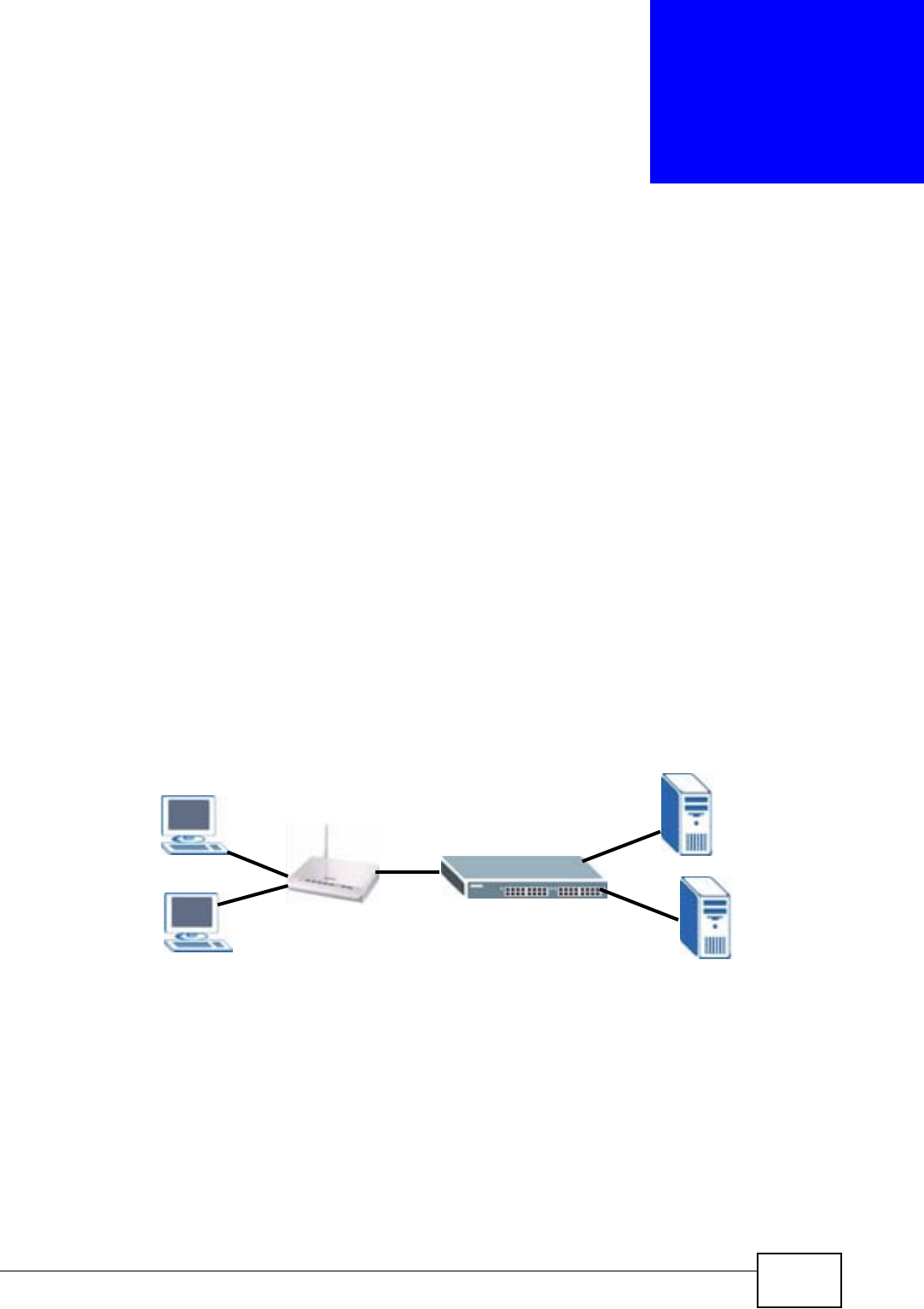
P-320W v3 User’s Guide 101
CHAPTER 10
VLAN
10.1 Overview
This chapter shows you how to configure VLANs on your P-320W v3.
A Virtual LAN (VLAN) allows a physical network to be partitioned into multiple
logical networks. Only stations within the same group can communicate with each
other. Stations on a logical network can belong to one or more groups.
In the figure below, your P-320W v3 (C) has VLAN configured on two of its ports.
Frames coming from computer A are tagged with Port VLAN ID (PVID) 1 and those
from computer B are tagged with PVID 2. When computers A and B request IP
addresses, the P-320W v3 forwards this to the VLAN-aware switch (D). The switch
sends each request to the corresponding DHCP server. Computer A gets its IP
address from DHCP Server 1, and computer B gets its IP address from DHCP
server 2.
Figure 66 VLAN Example
10.2 What You Can Do
Use the VLAN screen (Section 10.4 on page 102) to configure the Port VLAN ID
(PVID) on the physical ports of the P-320W v3.
VLAN 1
PVID 1
VLAN 2
PVID 2
VLAN 1
DHCP
Server 1
DHCP
Server 2
VLAN 2
A
B
CD

Chapter 10 VLAN
P-320W v3 User’s Guide
102
10.3 What You Need to Know
The following sections provide information that can help you configure the VLAN
screen of your P-320W v3.
10.3.1 How VLAN Works
A tagged VLAN uses an explicit tag (VLAN ID) in the MAC header to identify the
VLAN membership of a frame across bridges - they are not confined to the switch
on which they were created. The VLANs can be created statically by hand or
dynamically through GVRP (which is an 802.1 protocol). The VLAN ID associates a
frame with a specific VLAN and provides the information that switches need to
process the frame across the network. A tagged frame is four bytes longer than an
untagged frame and contains two bytes for the TPID (Tag Protocol Identifier,
residing within the type/length field of the Ethernet frame) and two bytes for the
TCI (Tag Control Information, starting after the source address field of the
Ethernet frame).
10.3.2 VLAN Tag
The CFI (Canonical Format Indicator) is a single-bit flag, always set to zero for
Ethernet switches. If a frame received at an Ethernet port has a CFI set to 1, then
that frame should not be forwarded as it is to an untagged port. The remaining
twelve bits define the VLAN ID, giving a possible maximum number of 4,096
VLANs. Note that user priority and VLAN ID are independent of each other. A
frame with VID (VLAN Identifier) of null (0) is called a priority frame, meaning that
only the priority level is significant and the default VID of the ingress port is given
as the VID of the frame. Of the 4096 possible VIDs, a VID of 0 is used to identify
priority frames and the value 4095 (FFF) is reserved, so the maximum possible
number of VLAN configurations is 4,094.
10.4 VLAN Screen
Use this screen to configure the Port VLAN ID (PVID) on the physical ports of the
P-320W v3. The P-320W v3 forwards tagged frames to a VLAN-aware switch that
can send the frames to its corresponding destination.
Note: Tagged traffic remains in the same VLAN and cannot be seen by other VLANs.
TPID
2 Bytes
User Priority
3 Bits
CFI
1 Bit
VLAN ID
12 bits
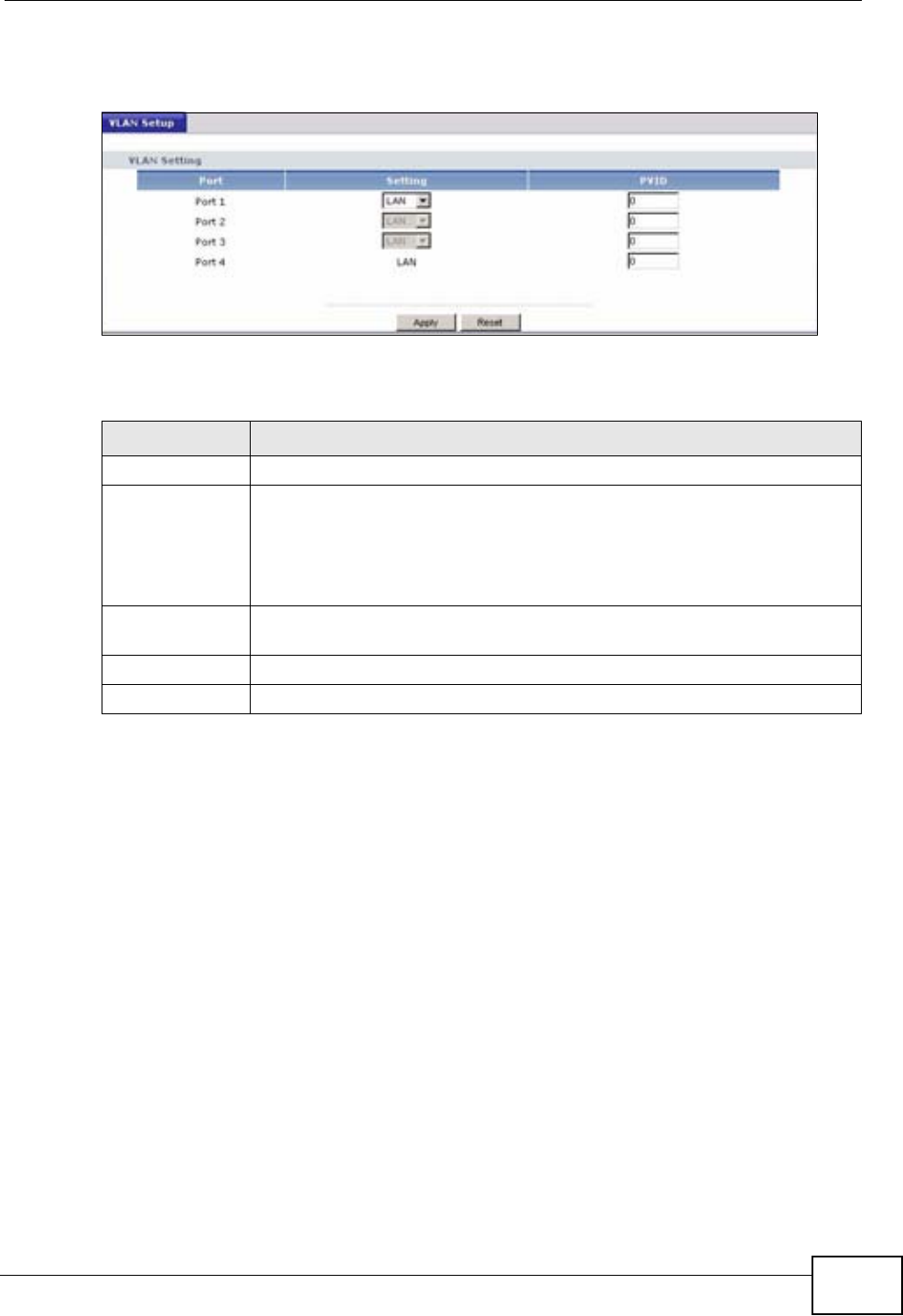
Chapter 10 VLAN
P-320W v3 User’s Guide 103
Click Network > VLAN to open the following screen.
Figure 67 Network > VLAN
The following table describes the labels in this screen.
Table 43 Network > VLAN
LABEL DESCRIPTION
Port This column displays the port name (LAN1 ~ LAN4).
Setting Specify whether a port is LAN (default for all ports) or is part of a
VLAN.
Note: Port 4’s setting is always set to LAN. This ensures that you
can manage the P-320W v3 through a LAN port if necessary.
PVID Enter the Port VLAN ID (1 ~ 4094) to add to untagged frames received
on each port.
Apply Click Apply to save your changes back to the P-320W v3.
Reset Click Reset to begin configuring this screen afresh.

Chapter 10 VLAN
P-320W v3 User’s Guide
104

105
PART III
Security
Firewall (117)
Content Filtering (125)

106
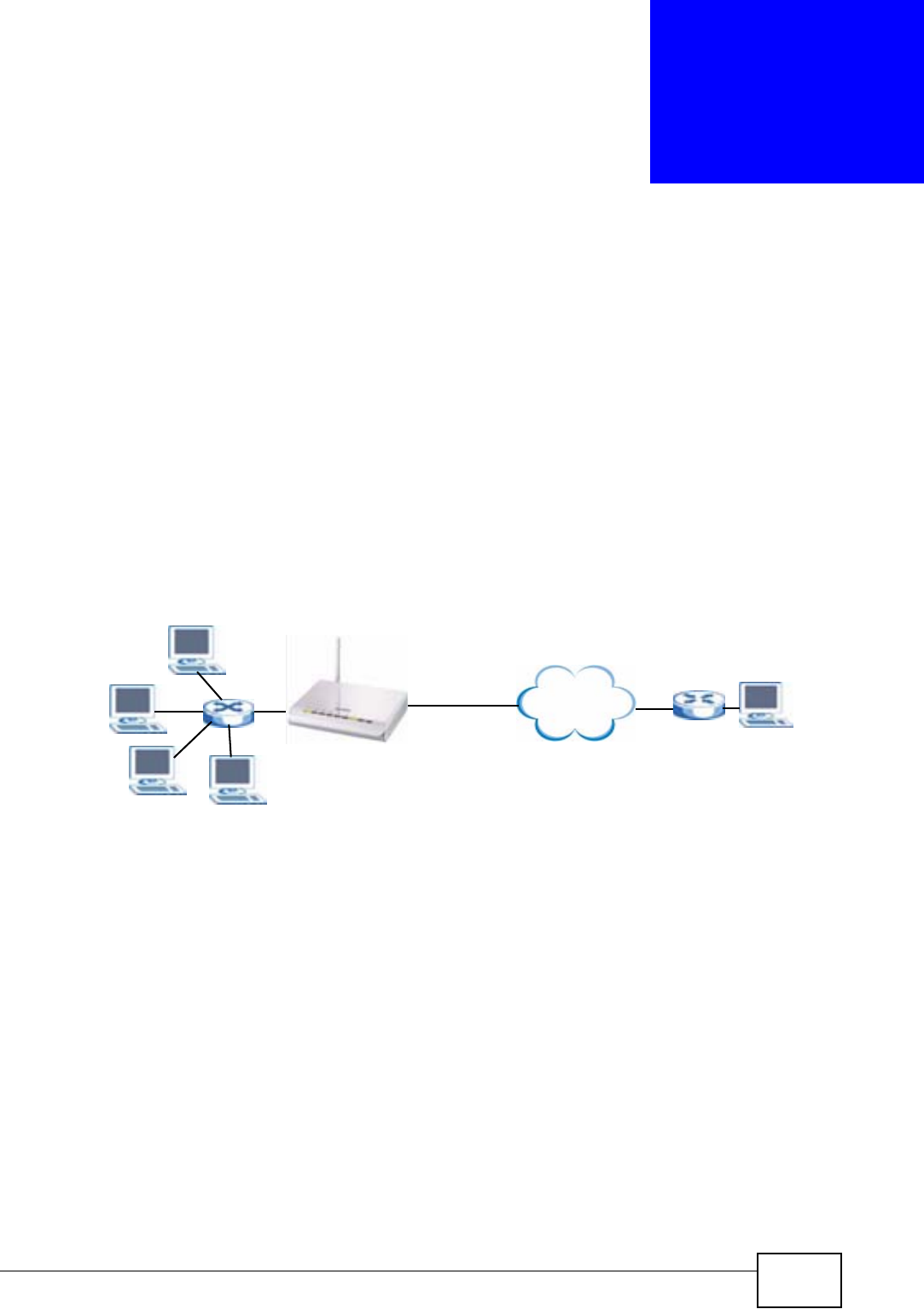
P-320W v3 User’s Guide 107
CHAPTER 11
WAN
11.1 Overview
This chapter discusses the P-320W v3’s WAN screens. Use these screens to
configure your P-320W v3 for Internet access.
A WAN (Wide Area Network) connection is an outside connection to another
network or the Internet. It connects your private networks (such as a LAN (Local
Area Network) and other networks, so that a computer in one location can
communicate with computers in other locations.
Figure 68 LAN and WAN
See the chapter about the connection wizard for more information on the fields in
the WAN screens.
11.2 What You Can Do
•Use the Internet Connection screen (Section 11.3 on page 108) to configure
your P-320W v3’s Internet access settings.
•Use the Advanced screen (Section 11.4 on page 114) to change your P-320W
v3’s advanced WAN settings.
•Use the Traffic Redirect screen (Section 11.5 on page 114) to enable the P-
320W v3 to redirect traffic.
WAN
LAN
Internet
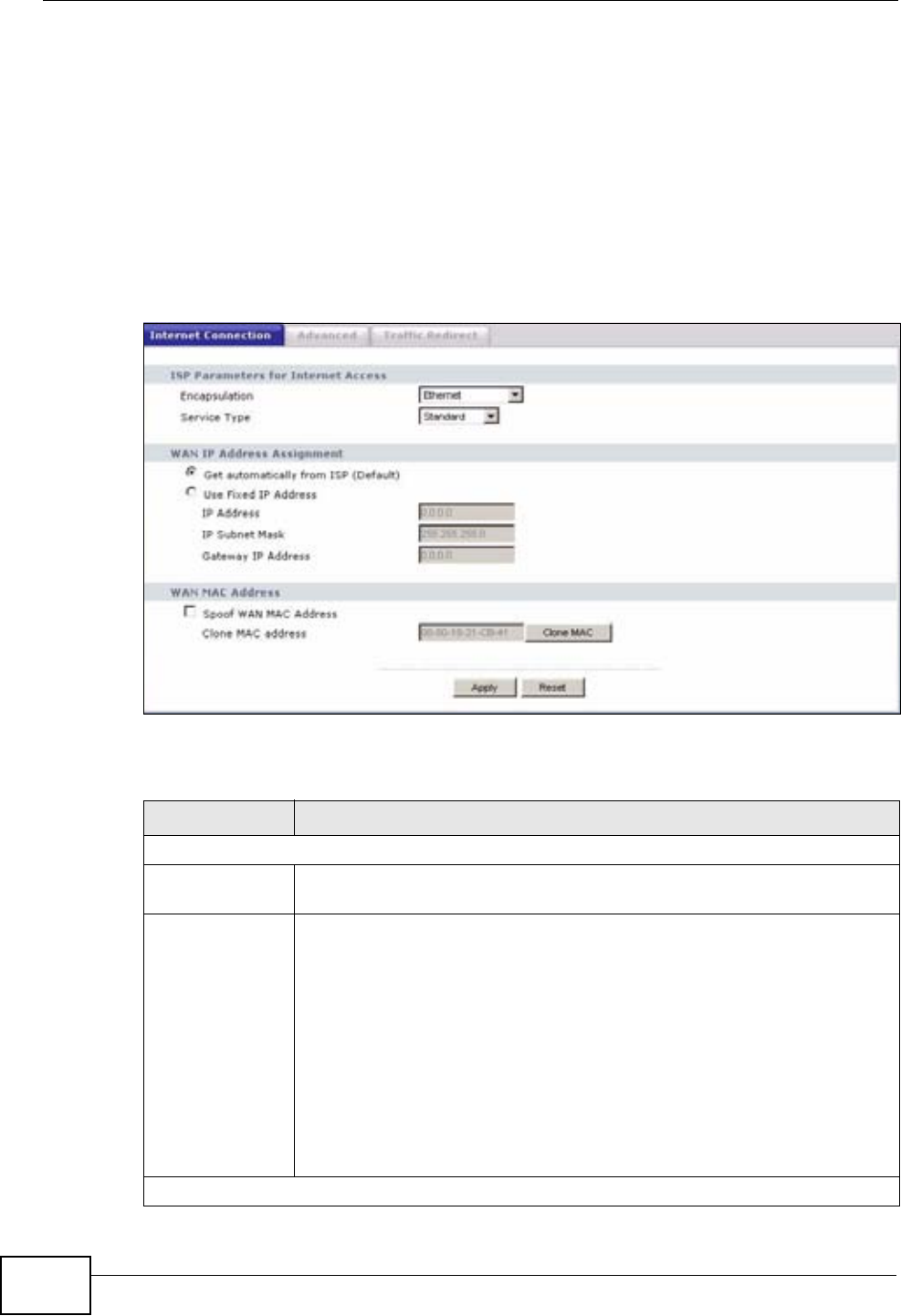
Chapter 11 WAN
P-320W v3 User’s Guide
108
11.3 Internet Connection Screen
Use this screen to configure your P-320W v3’s Internet access settings. Click
Network > WAN. The screen differs according to the encapsulation you choose.
11.3.1 Ethernet Encapsulation
This screen displays when you select Ethernet encapsulation.
Figure 69 Network > WAN > Internet Connection: Ethernet Encapsulation
The following table describes the labels in this screen.
Table 44 Network > WAN > Internet Connection: Ethernet Encapsulation
LABEL DESCRIPTION
ISP Parameters for Internet Access
Encapsulation Choose the Ethernet option when the WAN port is used as a regular
Ethernet.
Service Type Choose from Standard,RR-Toshiba (Roadrunner Toshiba
authentication method), RR-Manager (Roadrunner Manager
authentication method), RR-Telstra (RoadRunner Telstra
authentication method) or Telia Login.
The following fields do not appear with the Standard service type.
•User Name - Enter the user name for the account.
•Password - Enter the password associated with the user name
above.
•Retype to Confirm - Type your password again to make sure that
you have entered is correctly.
•Login Server - Enter the IP address of the server you want to use.
WAN IP Address Assignment

Chapter 11 WAN
P-320W v3 User’s Guide 109
11.3.2 PPPoE Encapsulation
The P-320W v3 supports PPPoE (Point-to-Point Protocol over Ethernet). PPPoE is
an IETF standard (RFC 2516) specifying how a personal computer (PC) interacts
with a broadband modem (DSL, cable, wireless, etc.) connection. The PPP over
Ethernet option is for a dial-up connection using PPPoE.
For the service provider, PPPoE offers an access and authentication method that
works with existing access control systems (for example RADIUS).
One of the benefits of PPPoE is the ability to let you access one of multiple network
services, a function known as dynamic service selection. This enables the service
provider to easily create and offer new IP services for individuals.
Operationally, PPPoE saves significant effort for both you and the ISP or carrier, as
it requires no specific configuration of the broadband modem at the customer site.
By implementing PPPoE directly on the P-320W v3 (rather than individual
computers), the computers on the LAN do not need PPPoE software installed,
since the P-320W v3 does that part of the task. Furthermore, with NAT, all of the
LANs’ computers will have access.
Get
automatically
from ISP
Select this option If your ISP did not assign you a fixed IP address. This
is the default selection.
Use Fixed IP
Address
Select this option If the ISP assigned a fixed IP address.
IP Address Enter your WAN IP address in this field if you selected Use Fixed IP
Address.
IP Subnet
Mask Enter the IP Subnet Mask in this field.
Gateway IP
Address Enter a Gateway IP Address (if your ISP gave you one) in this field.
WAN MAC
Address
The MAC address section allows users to configure the WAN port's MAC
address by either using the P-320W v3’s MAC address, copying the
MAC address from a computer on your LAN or manually entering a MAC
address.
Spoof WAN MAC
address
Select this if you want to hide your computer’s MAC address. Enter the
MAC address you want to use and click Clone MAC.
Clear the check box to use the factory assigned default MAC Address.
Apply Click Apply to save your changes back to the P-320W v3.
Reset Click Reset to begin configuring this screen afresh.
Table 44 Network > WAN > Internet Connection: Ethernet Encapsulation
LABEL DESCRIPTION
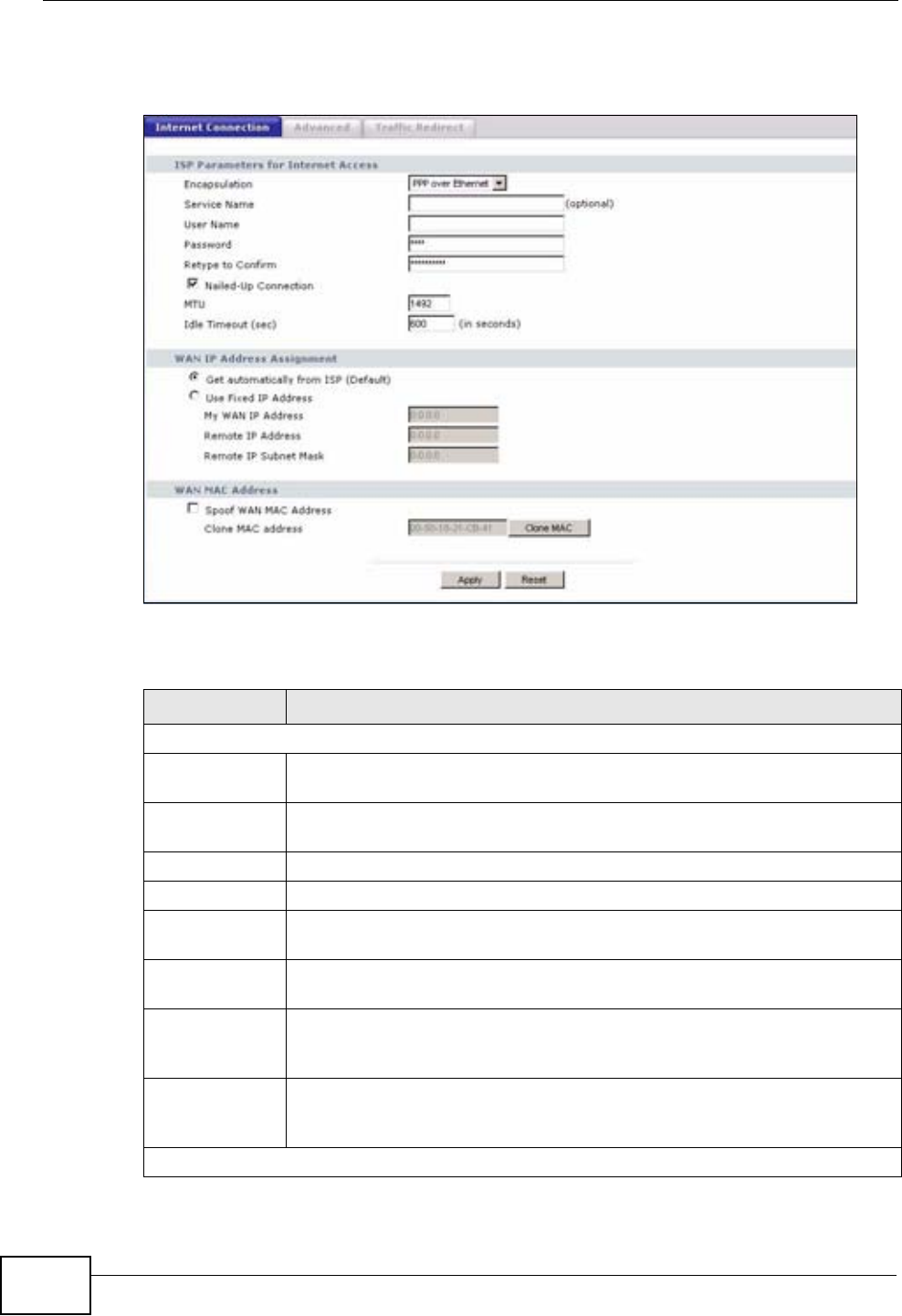
Chapter 11 WAN
P-320W v3 User’s Guide
110
This screen displays when you select PPPoE encapsulation.
Figure 70 Network > WAN > Internet Connection: PPPoE Encapsulation
The following table describes the labels in this screen.
Table 45 Network > WAN > Internet Connection: PPPoE Encapsulation
LABEL DESCRIPTION
ISP Parameters for Internet Access
Encapsulation Choose the PPP over Ethernet if you connect to the Internet using
dial-up.
Service Name Type the PPPoE service name provided to you. PPPoE uses a service
name to identify and reach the PPPoE server.
User Name Type the user name given to you by your ISP.
Password Type the password associated with the user name above.
Retype to
Confirm
Type your password again to make sure that you have entered is
correctly.
Nailed-Up
Connection
Select Nailed-Up Connection if you do not want the connection to time
out.
MTU The Maximum Transmission Unit (MTU) refers to the largest packet size
that a device can forward. Enter the value (in bytes) that you want the
P-320W v3 to be able to handle. The default value is 1492 bytes.
Idle Timeout This value specifies the time in seconds that elapses before the router
automatically disconnects from the PPPoE server. The default value is
600 seconds.
WAN IP Address Assignment

Chapter 11 WAN
P-320W v3 User’s Guide 111
11.3.3 PPTP Encapsulation
Point-to-Point Tunneling Protocol (PPTP) is a network protocol that enables secure
transfer of data from a remote client to a private server, creating a Virtual Private
Network (VPN) using TCP/IP-based networks.
PPTP supports on-demand, multi-protocol and virtual private networking over
public networks, such as the Internet.
Get
automatically
from ISP
Select this option If your ISP did not assign you a fixed IP address. This
is the default selection.
Use Fixed IP
Address
Select this option If the ISP assigned a fixed IP address.
My WAN IP
Address Enter your WAN IP address in this field if you selected Use Fixed IP
Address.
Remote IP
Address Enter the remote IP address (if your ISP gave you one) in this field.
Remote IP
Subnet
Mask
Enter the remote IP subnet mask in this field.
WAN MAC
Address
The MAC address section allows users to configure the WAN port's MAC
address by using the P-320W v3’s MAC address, copying the MAC
address from a computer on your LAN or manually entering a MAC
address.
Spoof the
computer’s
MAC address
Select this if you want to hide your computer’s MAC address. Enter the
MAC address you want to use and click Clone MAC.
Clear the check box to use the factory assigned default MAC Address.
Apply Click Apply to save your changes back to the P-320W v3.
Reset Click Reset to begin configuring this screen afresh.
Table 45 Network > WAN > Internet Connection: PPPoE Encapsulation
LABEL DESCRIPTION
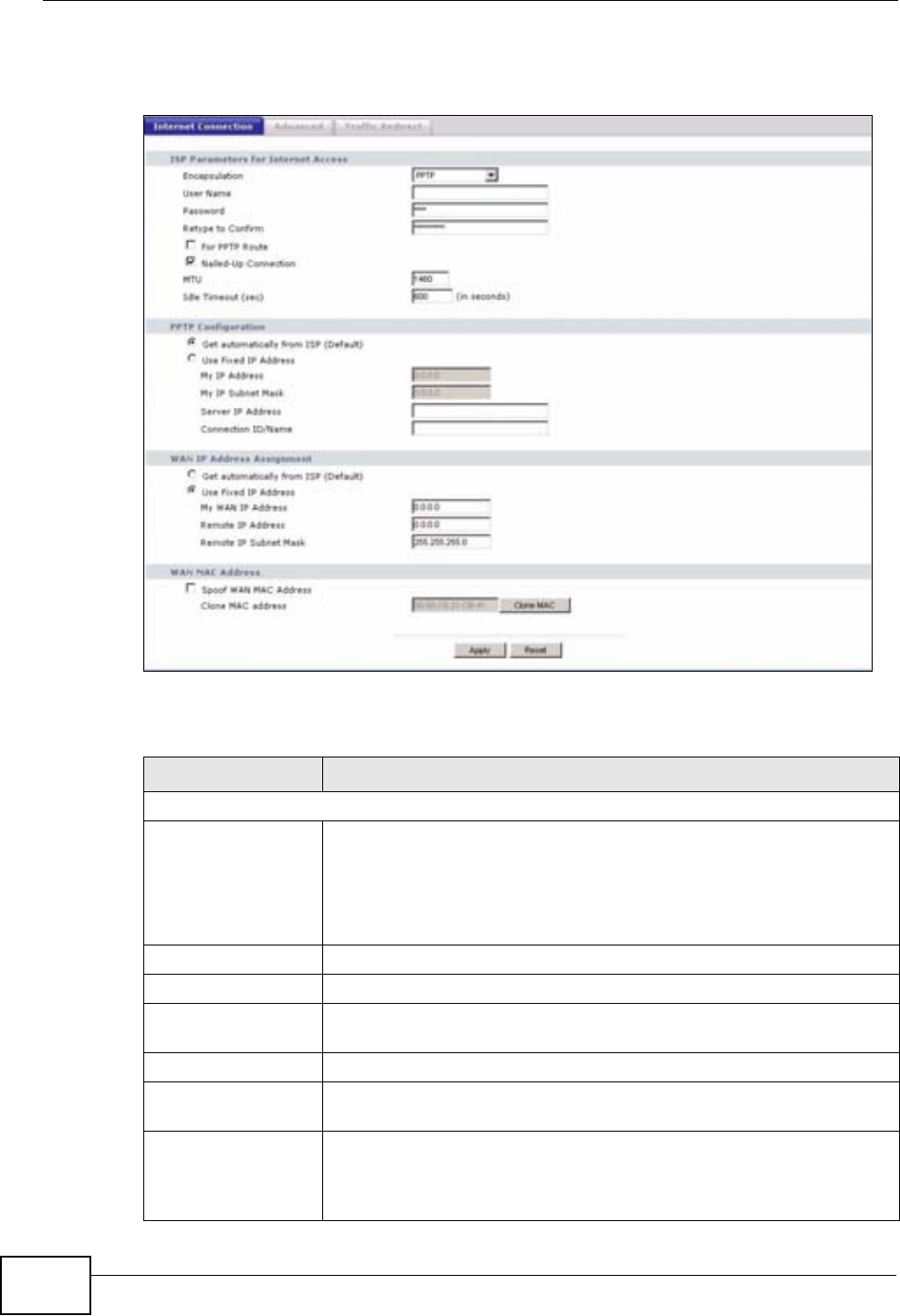
Chapter 11 WAN
P-320W v3 User’s Guide
112
This screen displays when you select PPTP encapsulation.
Figure 71 Network > WAN > Internet Connection: PPTP Encapsulation
The following table describes the labels in this screen.
Table 46 Network > WAN > Internet Connection: PPTP Encapsulation
LABEL DESCRIPTION
ISP Parameters for Internet Access
Encapsulation Choose PPTP to enable secure transfer of data from a remote client
to a private server.
To configure a PPTP client, you must configure the User Name and
Password fields for a PPP connection and the PPTP parameters for
a PPTP connection.
User Name Type the user name given to you by your ISP.
Password Type the password associated with the user name above.
Retype to Confirm Type your password again to make sure that you have entered is
correctly.
For PPTP Route
Nailed-up
Connection
Select Nailed-Up Connection if you do not want the connection to
time out.
MTU The Maximum Transmission Unit (MTU) refers to the largest packet
size that a device can forward. Enter the value (in bytes) that you
want the P-320W v3 to be able to handle. The default value is 1460
bytes.

Chapter 11 WAN
P-320W v3 User’s Guide 113
Idle Timeout This value specifies the time in seconds that elapses before the P-
320W v3 automatically disconnects from the PPTP server. The
default value is 600 seconds.
PPTP Configuration
Get automatically
from ISP
Select this option If your ISP did not assign you a fixed IP address.
This is the default selection.
Use Fixed IP
Address
Select this option If the ISP assigned a fixed IP address.
My IP Address Type the (static) IP address assigned to you by your ISP.
My IP Subnet
Mask Your P-320W v3 will automatically calculate the subnet mask based
on the IP address that you assign. Unless you are implementing
subnetting, use the subnet mask computed by the P-320W v3.
Server IP
Address Type the IP address of the PPTP server.
Connection ID/
Name Type your identification name for the PPTP server.
WAN IP Address Assignment
Get automatically
from ISP
Select this option If your ISP did not assign you a fixed IP address.
This is the default selection.
Use Fixed IP
Address
Select this option If the ISP assigned a fixed IP address.
My WAN IP
Address Enter your WAN IP address in this field if you selected Use Fixed IP
Address.
Remote IP
Address Enter the remote IP address (if your ISP gave you one) in this field.
Remote IP
Subnet Mask Enter the remote IP subnet mask in this field.
WAN MAC Address The MAC address section allows users to configure the WAN port's
MAC address by either using the P-320W v3’s MAC address, copying
the MAC address from a computer on your LAN or manually entering
a MAC address.
Spoof the
computer’s MAC
address
Select this if you want to hide your computer’s MAC address. Enter
the MAC address you want to use and click Clone MAC.
Clear the check box to use the factory assigned default MAC
Address.
Apply Click Apply to save your changes back to the P-320W v3.
Reset Click Reset to begin configuring this screen afresh.
Table 46 Network > WAN > Internet Connection: PPTP Encapsulation
LABEL DESCRIPTION
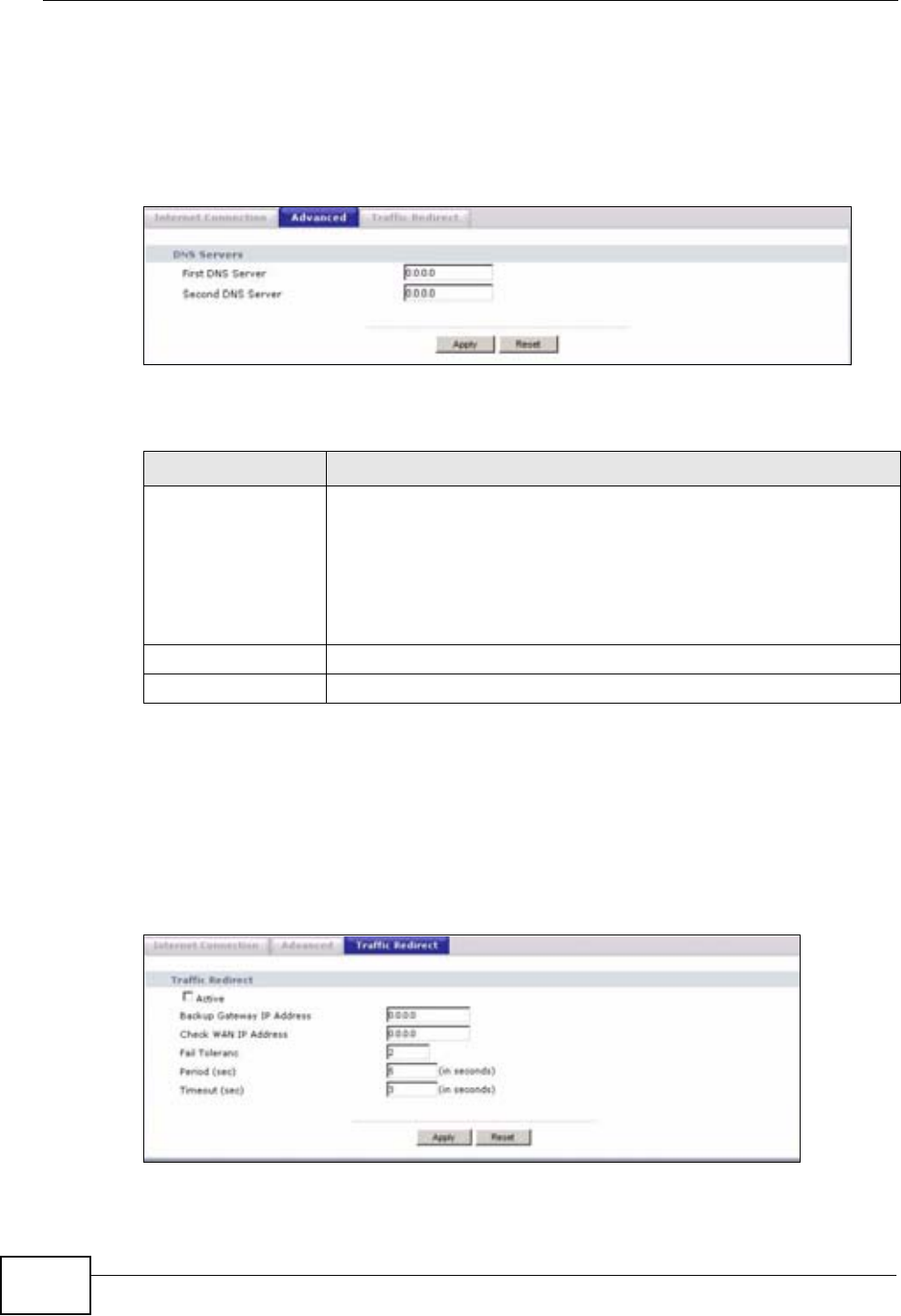
Chapter 11 WAN
P-320W v3 User’s Guide
114
11.4 Advanced Screen
To change your P-320W v3’s advanced WAN settings, click Network > WAN >
Advanced. The screen appears as shown.
Figure 72 Network > WAN > Advanced
The following table describes the labels in this screen.
11.5 Traffic Redirect Screen
To enable the P-320W v3 to redirect traffic, click Network > WAN > Advanced.
The screen appears as shown.
Figure 73 Network > WAN > Advanced
Table 47 WAN > Advanced
LABEL DESCRIPTION
First DNS Server
Second DNS Server
Enter the DNS server's IP address in the field to the right.
If you set a second choice to User-Defined, and enter the same IP
address, the second User-Defined changes to None after you click
Apply.
If you do not configure a DNS server, you must know the IP address
of a computer in order to access it.
Apply Click Apply to save your changes back to the P-320W v3.
Reset Click Reset to begin configuring this screen afresh.

Chapter 11 WAN
P-320W v3 User’s Guide 115
The following table describes the labels in this screen.
Table 48 WAN > Advanced
LABEL DESCRIPTION
Active Select this check box to have the P-320W v3 use traffic redirect if
the normal WAN connection goes down.
Backup Gateway IP
Address
Type the IP address of your backup gateway in dotted decimal
notation. The P-320W v3 automatically forwards traffic to this IP
address if the P-320W v3's Internet connection terminates.
Check WAN IP
Address
Configuration of this field is optional. If you do not enter an IP
address here, the P-320W v3 will use the default gateway IP
address. Configure this field to test your P-320W v3's WAN
accessibility. Type the IP address of a reliable nearby computer (for
example, your ISP's DNS server address). If you are using PPTP or
PPPoE Encapsulation, type "0.0.0.0" to configure the P-320W v3 to
check the PVC (Permanent Virtual Circuit) or PPTP tunnel.
Fail Tolerance Type the number of times your P-320W v3 may attempt and fail to
connect to the Internet before traffic is forwarded to the backup
gateway.
Period Type the number of seconds for the P-320W v3 to wait between
checks to see if it can connect to the WAN IP address (Check WAN
IP Address field) or default gateway. Allow more time if your
destination IP address handles lots of traffic.
Timeout Type the number of seconds for your P-320W v3 to wait for a ping
response from the IP Address in the Check WAN IP Address field
before it times out. The WAN connection is considered "down" after
the P-320W v3 times out the number of times specified in the Fail
Tolerance field. Use a higher value in this field if your network is
busy or congested.
Apply Click Apply to save your changes back to the P-320W v3.
Reset Click Reset to begin configuring this screen afresh.

Chapter 11 WAN
P-320W v3 User’s Guide
116

P-320W v3 User’s Guide 117
CHAPTER 12
Firewall
12.1 Overview
This chapter gives some background information on firewalls and explains how to
get started with the P-320W v3’s firewall.
Originally, the term “firewall” referred to a construction technique designed to
prevent the spread of fire from one room to another. The networking term
"firewall" is a system or group of systems that enforces an access-control policy
between two networks. It may also be defined as a mechanism used to protect a
trusted network from a network that is not trusted. Of course, firewalls cannot
solve every security problem. A firewall is one of the mechanisms used to
establish a network security perimeter in support of a network security policy. It
should never be the only mechanism or method employed. For a firewall to guard
effectively, you must design and deploy it appropriately. This requires integrating
the firewall into a broad information-security policy. In addition, specific policies
must be implemented within the firewall itself.
12.2 What You Can Do
•Use the General screen (Section 12.4 on page 119) to enable or disable the P-
320W v3’s firewall.
•Use the Services screen (Section 12.5 on page 119) to to enable service
blocking, enter/delete/modify the services you want to block and the date/time
you want to block them.
12.3 What You Need to Know
The following sections provide more information about the P-320W v3’s firewalls.

Chapter 12 Firewall
P-320W v3 User’s Guide
118
12.3.1 About the P-320W v3 Firewall
The P-320W v3 firewall is a stateful inspection firewall and is designed to protect
against Denial of Service attacks when activated (click the General tab under
Firewall and then click the Enable Firewall check box). The P-320W v3's
purpose is to allow a private Local Area Network (LAN) to be securely connected to
the Internet. The P-320W v3 can be used to prevent theft, destruction and
modification of data, as well as log events, which may be important to the security
of your network.
The P-320W v3 is installed between the LAN and a broadband modem connecting
to the Internet. This allows it to act as a secure gateway for all data passing
between the Internet and the LAN.
The P-320W v3 has one Ethernet WAN port and four Ethernet LAN ports, which are
used to physically separate the network into two areas.The WAN (Wide Area
Network) port attaches to the broadband (cable or DSL) modem to the Internet.
The LAN (Local Area Network) port attaches to a network of computers, which
needs security from the outside world. These computers will have access to
Internet services such as e-mail, FTP and the World Wide Web. However, "inbound
access" is not allowed (by default) unless the remote host is authorized to use a
specific service.
12.3.1.1 Stateful Inspection Firewall
Stateful inspection firewalls restrict access by screening data packets against
defined access rules. They make access control decisions based on IP address and
protocol. They also "inspect" the session data to assure the integrity of the
connection and to adapt to dynamic protocols. These firewalls generally provide
the best speed and transparency; however, they may lack the granular application
level access control or caching that some proxies support. Firewalls, of one type or
another, have become an integral part of standard security solutions for
enterprises.
12.3.2 Security Parameter Index (SPI)
An SPI is used to distinguish different SAs terminating at the same destination and
using the same IPSec protocol. This data allows for the multiplexing of SAs to a
single gateway. The SPI (Security Parameter Index) along with a destination IP
address uniquely identify a particular Security Association (SA). The SPI is
transmitted from the remote VPN gateway to the local VPN gateway. The local VPN
gateway then uses the network, encryption and key values that the administrator
associated with the SPI to establish the tunnel. Current ZyXEL implementation
assumes identical outgoing and incoming SPIs.
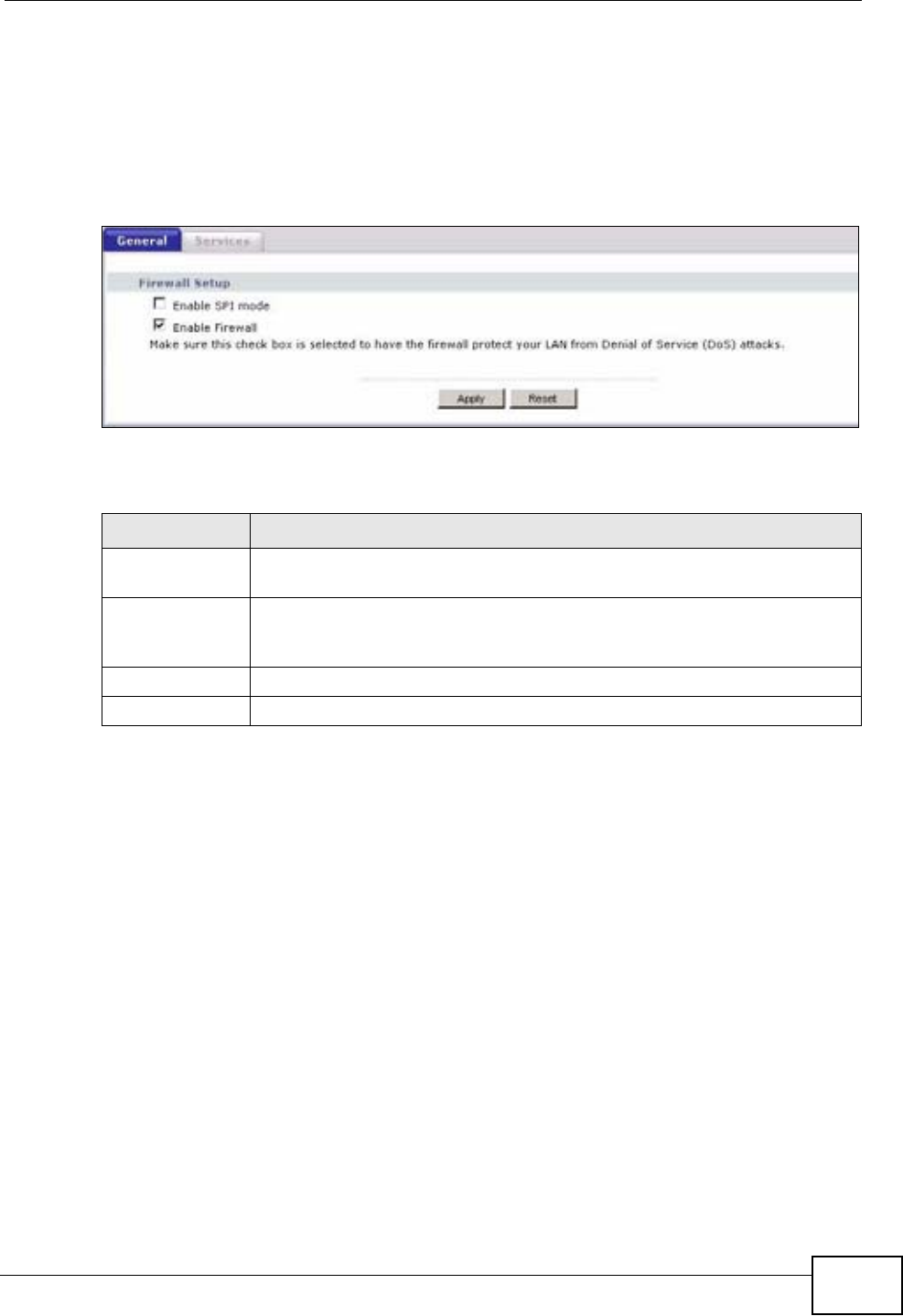
Chapter 12 Firewall
P-320W v3 User’s Guide 119
12.4 General Firewall Screen
Use this screen to enable or disable the P-320W v3’s firewall.
Click Security > Firewall to open the General screen.
Figure 74 Security > Firewall > General l
The following table describes the labels in this screen.
12.5 Services Screen
Use this screen to enable service blocking, enter/delete/modify the services you
want to block and the date/time you want to block them.
Table 49 Security > Firewall > General
LABEL DESCRIPTION
Enable SPI
mode
Check this to enable SPI. The inspects incoming packets and determines
whether the destination and source port is in the session table or not.
Enable Firewall Select this check box to activate the firewall. The P-320W v3 performs
access control and protects against Denial of Service (DoS) attacks
when the firewall is activated.
Apply Click Apply to save the settings.
Reset Click Reset to start configuring this screen again.
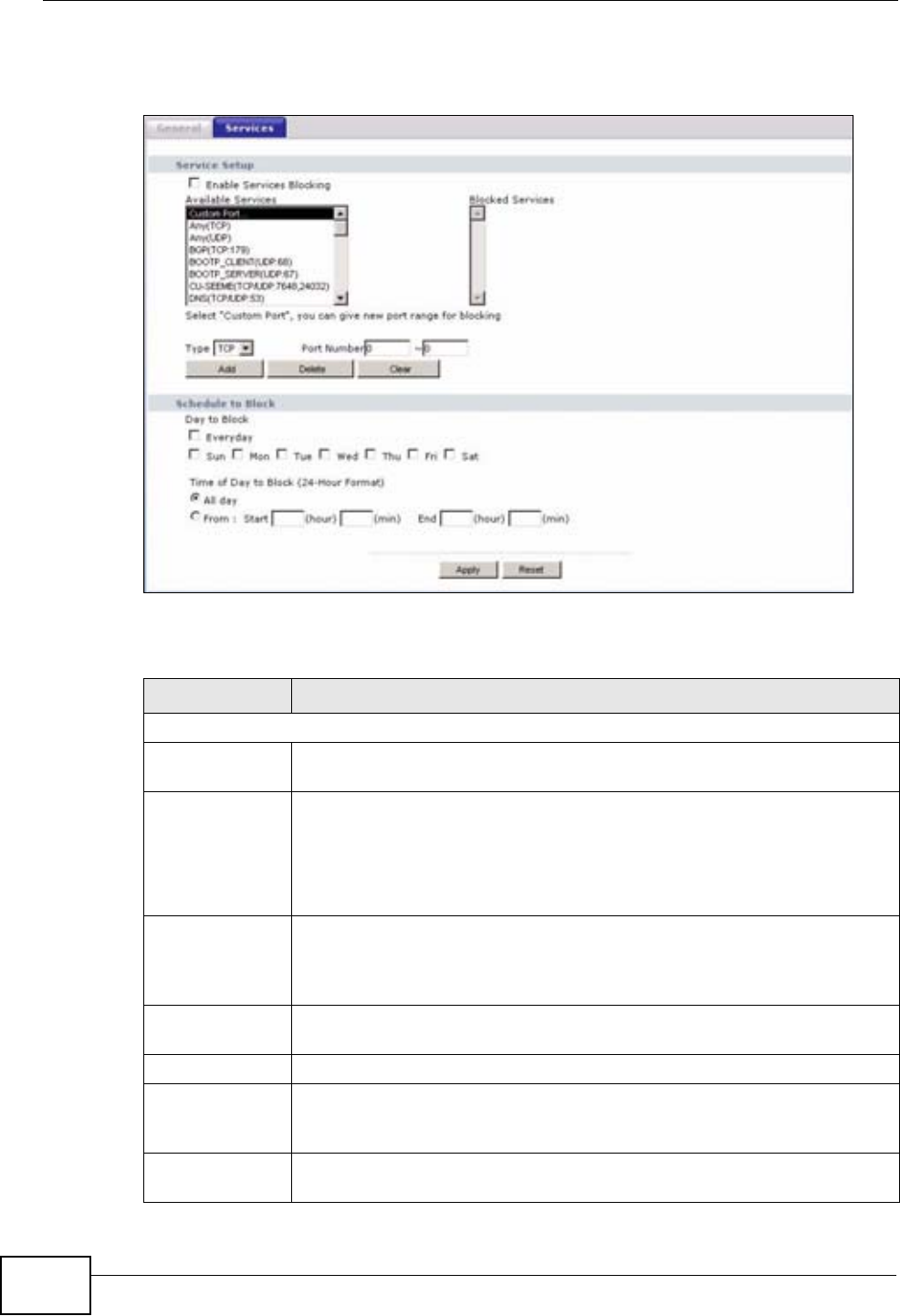
Chapter 12 Firewall
P-320W v3 User’s Guide
120
Click Security > Firewall > Services. The screen appears as shown next.
Figure 75 Security > Firewall > Services
The following table describes the labels in this screen.
Table 50 Security > Firewall > Services
LABEL DESCRIPTION
Service Setup
Enable Services
Blocking
Select this check box to enable this feature.
Available
Services
This is a list of pre-defined services (ports) you may prohibit your LAN
computers from using. Please see Section 9.3.1 on page 111 for more
information on services available.
Select the port you want to block using the drop-down list and click Add
to add the port to the Blocked Services field.
Blocked
Services
This is a list of services (ports) that will be inaccessible to computers on
your LAN once you enable service blocking. Choose the IP port (TCP,
UDP or TCP/UDP) that defines your customized port from the drop down
list box.
Custom Port A custom port is a service that is not available in the pre-defined
Available Services list and you must define using the next two fields.
Type Services are either TCP and/or UDP. Select from either TCP or UDP.
Port Number Enter the port number range that defines the service. For example,
suppose you want to define the Gnutella service. Select TCP type and
enter a port range from 6345-6349.
Add Select a service from the Available Services drop-down list and then
click Add to add a service to the Blocked Services.

Chapter 12 Firewall
P-320W v3 User’s Guide 121
12.6 Technical Reference
This section provides some technical information about the topics covered in this
chapter.
12.6.1 Guidelines For Enhancing Security With Your Firewall
1Change the default password via web configurator.
2Think about access control before you connect to the network in any way,
including attaching a modem to the port.
3Limit who can access your router.
4Don't enable any local service (such as SNMP or NTP) that you don't use. Any
enabled service could present a potential security risk. A determined hacker might
be able to find creative ways to misuse the enabled services to access the firewall
or the network.
5For local services that are enabled, protect against misuse. Protect by configuring
the services to communicate only with specific peers, and protect by configuring
rules to block packets for the services at specific interfaces.
6Protect against IP spoofing by making sure the firewall is active.
Keep the firewall in a secured (locked) room.
Delete Select a service from the Blocked Services list and then click Delete to
remove this service from the list.
Clear Click Clear to empty the Blocked Services.
Schedule to Block
Day to Block Select a check box to configure which days of the week (or everyday)
you want the content filtering to be active.
Time of Day to
Block (24-Hour
Format)
Select the time of day you want service blocking to take effect.
Configure blocking to take effect all day by selecting the All Day check
box. You can also configure specific times that by entering the start
time in the Start (hr) and Start (min) fields and the end time in the End
(hr) and End (min) fields. Enter times in 24-hour format, for example,
"3:00pm" should be entered as "15:00".
Apply Click Apply to save the settings.
Reset Click Reset to start configuring this screen again.
Table 50 Security > Firewall > Services
LABEL DESCRIPTION

Chapter 12 Firewall
P-320W v3 User’s Guide
122
12.6.2 Services
The commonly used services and port numbers are shown in the following table.
Please refer to RFC 1700 for further information about port numbers. Next to the
name of the service, two fields appear in brackets. The first field indicates the IP
protocol type (TCP, UDP, or ICMP). The second field indicates the IP port number
that defines the service. (Note that there may be more than one IP protocol type.
For example, look at the DNS service. (UDP/TCP:53) means UDP port 53 and TCP
port 53..
Table 51 Services
SERVICE DESCRIPTION
AIM/NEW_ICQ(TCP:5190) AOL’s Internet Messenger service, used as a listening port by
ICQ.
AUTH(TCP:113) Authentication protocol used by some servers.
BGP(TCP:179) Border Gateway Protocol.
BOOTP_CLIENT(UDP:68) DHCP Client.
BOOTP_SERVER(UDP:67) DHCP Server.
CU-SEEME(TCP/
UDP:7648, 24032)
A popular videoconferencing solution from White Pines
Software.
DNS(UDP/TCP:53) Domain Name Server, a service that matches web names
(e.g. www.zyxel.com) to IP numbers.
FINGER(TCP:79) Finger is a UNIX or Internet related command that can be
used to find out if a user is logged on.
FTP(TCP:20.21) File Transfer Program, a program to enable fast transfer of
files, including large files that may not be possible by e-mail.
H.323(TCP:1720) Net Meeting uses this protocol.
HTTP(TCP:80) Hyper Text Transfer Protocol - a client/server protocol for the
world wide web.
HTTPS HTTPS is a secured http session often used in e-commerce.
ICQ(UDP:4000) This is a popular Internet chat program.
IPSEC_TRANSPORT/
TUNNEL(AH:0)
The IPSEC AH (Authentication Header) tunneling protocol
uses this service.
IPSEC_TUNNEL(ESP:0) The IPSEC ESP (Encapsulation Security Protocol) tunneling
protocol uses this service.
IRC(TCP/UDP:6667) This is another popular Internet chat program.
MSN
Messenger(TCP:1863)
Microsoft Networks’ messenger service uses this protocol.
MULTICAST(IGMP:0) Internet Group Multicast Protocol is used when sending
packets to a specific group of hosts.
NEWS(TCP:144) A protocol for news groups.
NFS(UDP:2049) Network File System - NFS is a client/server distributed file
service that provides transparent file-sharing for network
environments.
NNTP(TCP:119) Network News Transport Protocol is the delivery mechanism
for the USENET newsgroup service.

Chapter 12 Firewall
P-320W v3 User’s Guide 123
PING(ICMP:0) Packet INternet Groper is a protocol that sends out ICMP echo
requests to test whether or not a remote host is reachable.
POP3(TCP:110) Post Office Protocol version 3 lets a client computer get e-mail
from a POP3 server through a temporary connection (TCP/IP
or other).
PPTP(TCP:1723) Point-to-Point Tunneling Protocol enables secure transfer of
data over public networks. This is the control channel.
PPTP_TUNNEL(GRE:0) Point-to-Point Tunneling Protocol enables secure transfer of
data over public networks. This is the data channel.
RCMD(TCP:512) Remote Command Service.
REAL_AUDIO(TCP:7070) A streaming audio service that enables real time sound over
the web.
REXEC(TCP:514) Remote Execution Daemon.
RLOGIN(TCP:513) Remote Login.
RTELNET(TCP:107) Remote Telnet.
RTSP(TCP/UDP:554) The Real Time Streaming (media control) Protocol (RTSP) is a
remote control for multimedia on the Internet.
SFTP(TCP:115) Simple File Transfer Protocol.
SMTP(TCP:25) Simple Mail Transfer Protocol is the message-exchange
standard for the Internet. SMTP enables you to move
messages from one e-mail server to another.
SNMP(TCP/UDP:161) Simple Network Management Program.
SNMP-TRAPS (TCP/
UDP:162)
Traps for use with the SNMP (RFC:1215).
SQL-NET(TCP:1521) Structured Query Language is an interface to access data on
many different types of database systems, including
mainframes, midrange systems, UNIX systems and network
servers.
SSDP(UDP:1900) Simole Service Discovery Protocol (SSDP) is a discovery
service searching for Universal Plug and Play devices on your
home network or upstream Internet gateways using DUDP
port 1900.
SSH(TCP/UDP:22) Secure Shell Remote Login Program.
STRMWORKS(UDP:1558) Stream Works Protocol.
SYSLOG(UDP:514) Syslog allows you to send system logs to a UNIX server.
TACACS(UDP:49) Login Host Protocol used for (Terminal Access Controller
Access Control System).
TELNET(TCP:23) Telnet is the login and terminal emulation protocol common
on the Internet and in UNIX environments. It operates over
TCP/IP networks. Its primary function is to allow users to log
into remote host systems.
TFTP(UDP:69) Trivial File Transfer Protocol is an Internet file transfer
protocol similar to FTP, but uses the UDP (User Datagram
Protocol) rather than TCP (Transmission Control Protocol).
VDOLIVE(TCP:7000) Another videoconferencing solution.
Table 51 Services (continued)
SERVICE DESCRIPTION

Chapter 12 Firewall
P-320W v3 User’s Guide
124

P-320W v3 User’s Guide 125
CHAPTER 13
Content Filtering
13.1 Overview
This chapter provides a brief overview of content filtering using the embedded
web GUI.
Internet content filtering allows you to create and enforce Internet access policies
tailored to your needs. Content filtering is the ability to block certain web features
or specific URL keywords.
The P-320W v3 can block web features such as ActiveX controls, Java applets,
cookies and disable web proxies.
13.2 What You Can Do
Use the Filter screen (Section 13.3 on page 125) to configure filter rules on your
P-320W v3.
13.3 Filter Screen
Use this screen to block web features such as ActiveX controls, Java applets,
cookies and disable web proxies. You can create a list of keywords to block so that
web pages containing these words cannot be viewed by users.
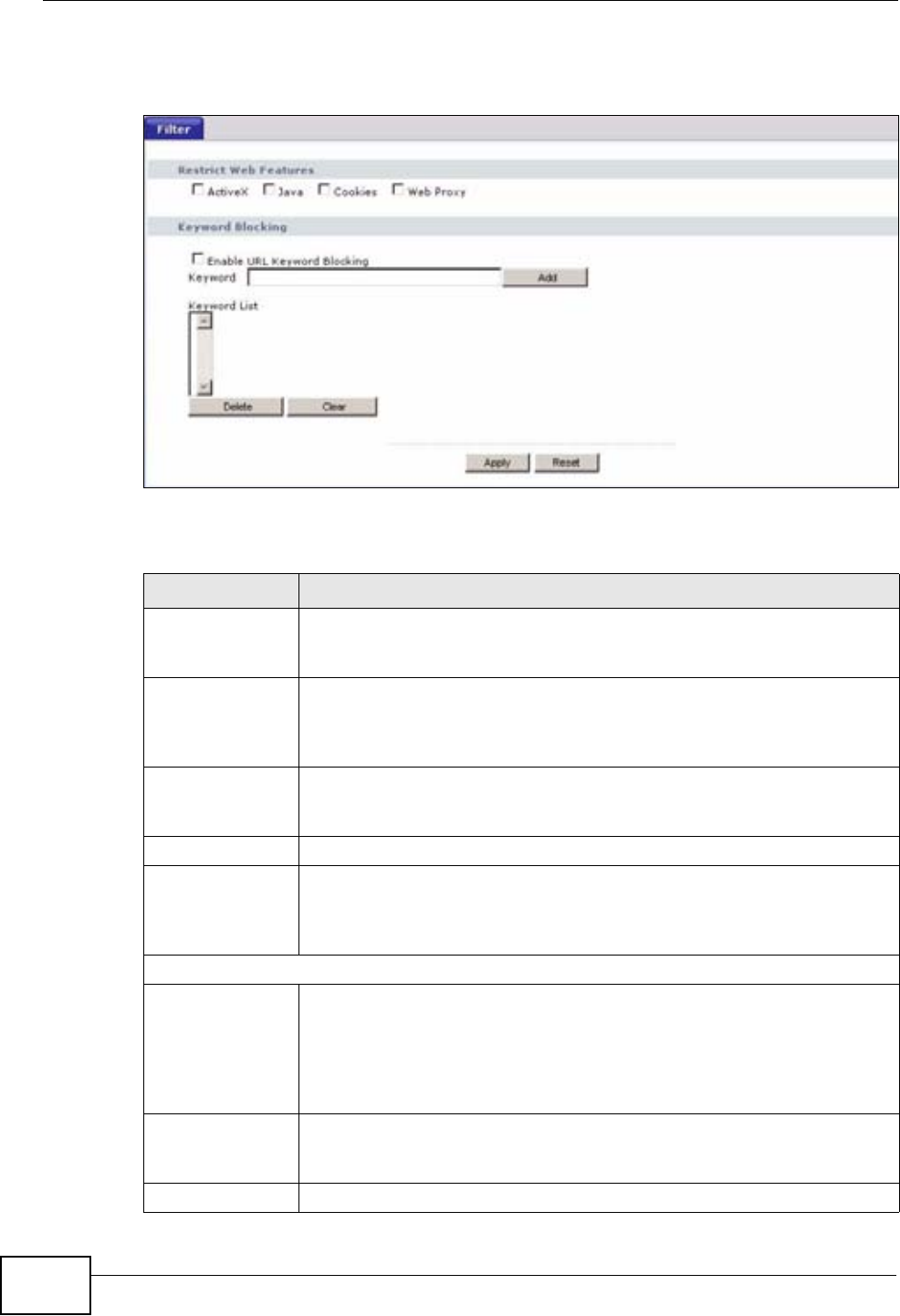
Chapter 13 Content Filtering
P-320W v3 User’s Guide
126
Click Security > Content Filter to open the Filter screen.
Figure 76 Security > Content Filter > Filter
The following table describes the labels in this screen.
Table 52 Security > Content Filter > Filter
LABEL DESCRIPTION
Restrict Web
Features
Select the box(es) to restrict a feature. When you download a page
containing a restricted feature, that part of the web page will appear
blank or grayed out.
ActiveX A tool for building dynamic and active Web pages and distributed
object applications. When you visit an ActiveX Web site, ActiveX
controls are downloaded to your browser, where they remain in case
you visit the site again.
Java A programming language and development environment for building
downloadable Web components or Internet and intranet business
applications of all kinds.
Cookies Used by Web servers to track usage and provide service based on ID.
Web Proxy A server that acts as an intermediary between a user and the Internet
to provide security, administrative control, and caching service. When
a proxy server is located on the WAN it is possible for LAN users to
circumvent content filtering by pointing to this proxy server.
Keyword Blocking
Enable URL
Keyword
Blocking
The P-320W v3 can block Web sites with URLs that contain certain
keywords in the domain name or IP address. For example, if the
keyword "bad" was enabled, all sites containing this keyword in the
domain name or IP address will be blocked, e.g., URL http://
www.website.com/bad.html would be blocked. Select this check box to
enable this feature.
Keyword Type a keyword in this field. You may use any character (up to 64
characters). Wildcards are not allowed. You can also enter a numerical
IP address.
Keyword List This list displays the keywords already added.

Chapter 13 Content Filtering
P-320W v3 User’s Guide 127
13.4 Technical Reference
This section provides some technical information about the topics covered in this
chapter.
You can use commands to set how much of a website’s URL the content filter is to
check for keyword blocking. See the appendices for information on how to access
and use the command interpreter.
13.4.1 Domain Name or IP Address URL Checking
By default, the P-320W v3 checks the URL’s domain name or IP address when
performing keyword blocking.
This means that the P-320W v3 checks the characters that come before the first
slash in the URL.
For example, with the URL www.zyxel.com.tw/news/pressroom.php, content
filtering only searches for keywords within www.zyxel.com.tw.
13.4.2 Full Path URL Checking
Full path URL checking has the P-320W v3 check the characters that come before
the last slash in the URL.
For example, with the URL www.zyxel.com.tw/news/pressroom.php, full path URL
checking searches for keywords within www.zyxel.com.tw/news/.
Add Click Add after you have typed a keyword.
Repeat this procedure to add other keywords. Up to 64 keywords are
allowed.
When you try to access a web page containing a keyword, you will get
a message telling you that the content filter is blocking this request.
Delete Highlight a keyword in the lower box and click Delete to remove it.
The keyword disappears from the text box after you click Apply.
Clear Click this button to remove all of the listed keywords.
Apply Click Apply to save your changes.
Reset Click Reset to begin configuring this screen afresh
Table 52 Security > Content Filter > Filter
LABEL DESCRIPTION

Chapter 13 Content Filtering
P-320W v3 User’s Guide
128
Use the ip urlfilter customize actionFlags 6 [disable | enable]
command to extend (or not extend) the keyword blocking search to include the
URL's full path.
13.4.3 File Name URL Checking
Filename URL checking has the P-320W v3 check all of the characters in the URL.
For example, filename URL checking searches for keywords within the URL
www.zyxel.com.tw/news/pressroom.php.
Use the ip urlfilter customize actionFlags 8 [disable | enable]
command to extend (or not extend) the keyword blocking search to include the
URL's complete filename.

129
PART IV
Management
Static Route (131)
Remote Management (135)
Universal Plug-and-Play (UPnP) (141)

130
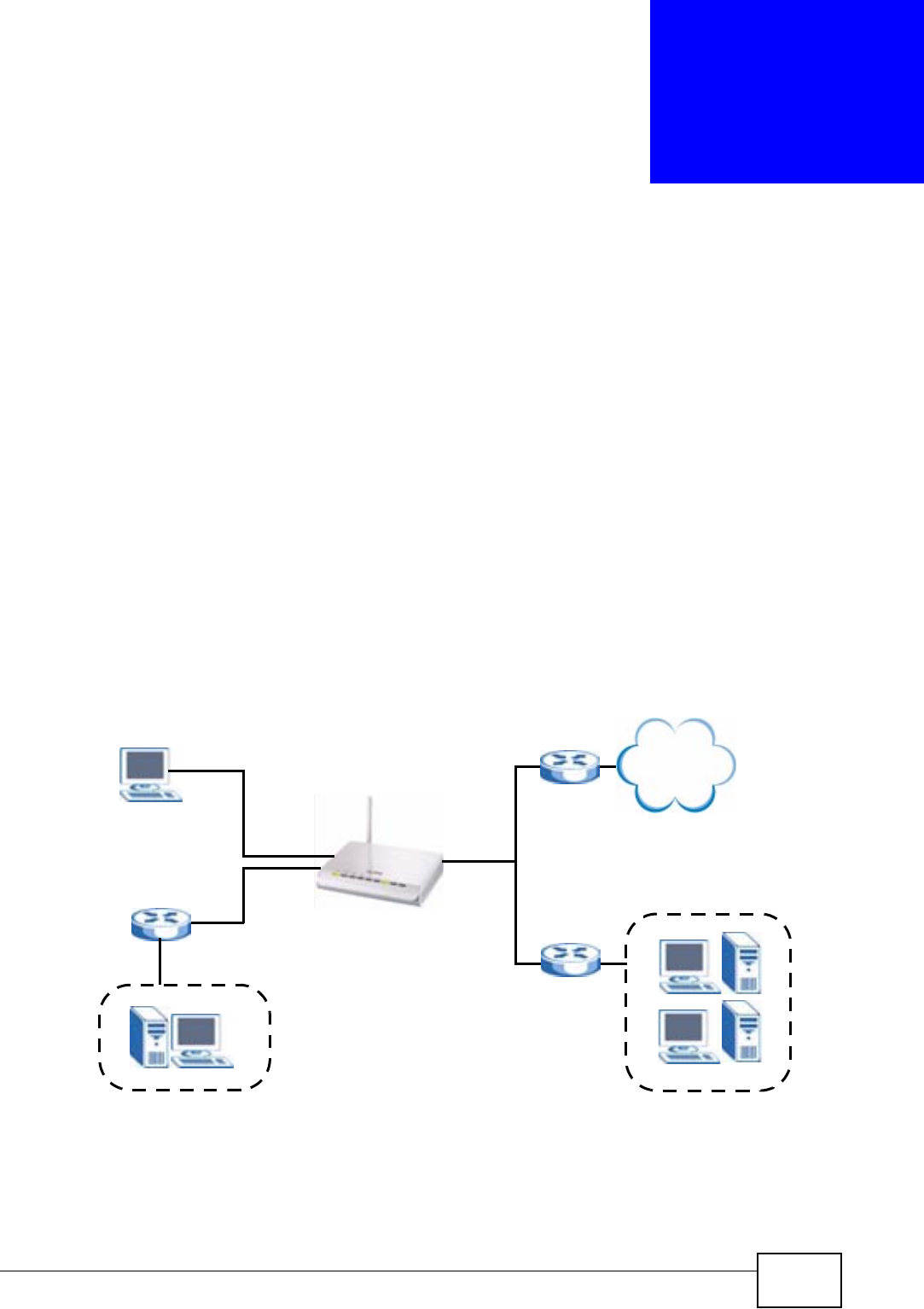
P-320W v3 User’s Guide 131
CHAPTER 14
Static Route
14.1 Overview
This chapter shows you how to configure static routes for your P-320W v3.
The P-320W v3 usually uses the default gateway to route outbound traffic from
computers on the LAN to the Internet. To have the P-320W v3 send data to
devices not reachable through the default gateway, use static routes.
For example, the next figure shows a computer (A) connected to the P-320W v3’s
LAN interface. The P-320W v3 routes most traffic from Ato the Internet through
the P-320W v3’s default gateway (R1). You create one static route to connect to
services offered by your ISP behind router R2. You create another static route to
communicate with a separate network behind a router R3 connected to the LAN.
Figure 77 Example of Static Routing Topology
WAN
R1
R2
A
R3
LAN
Internet
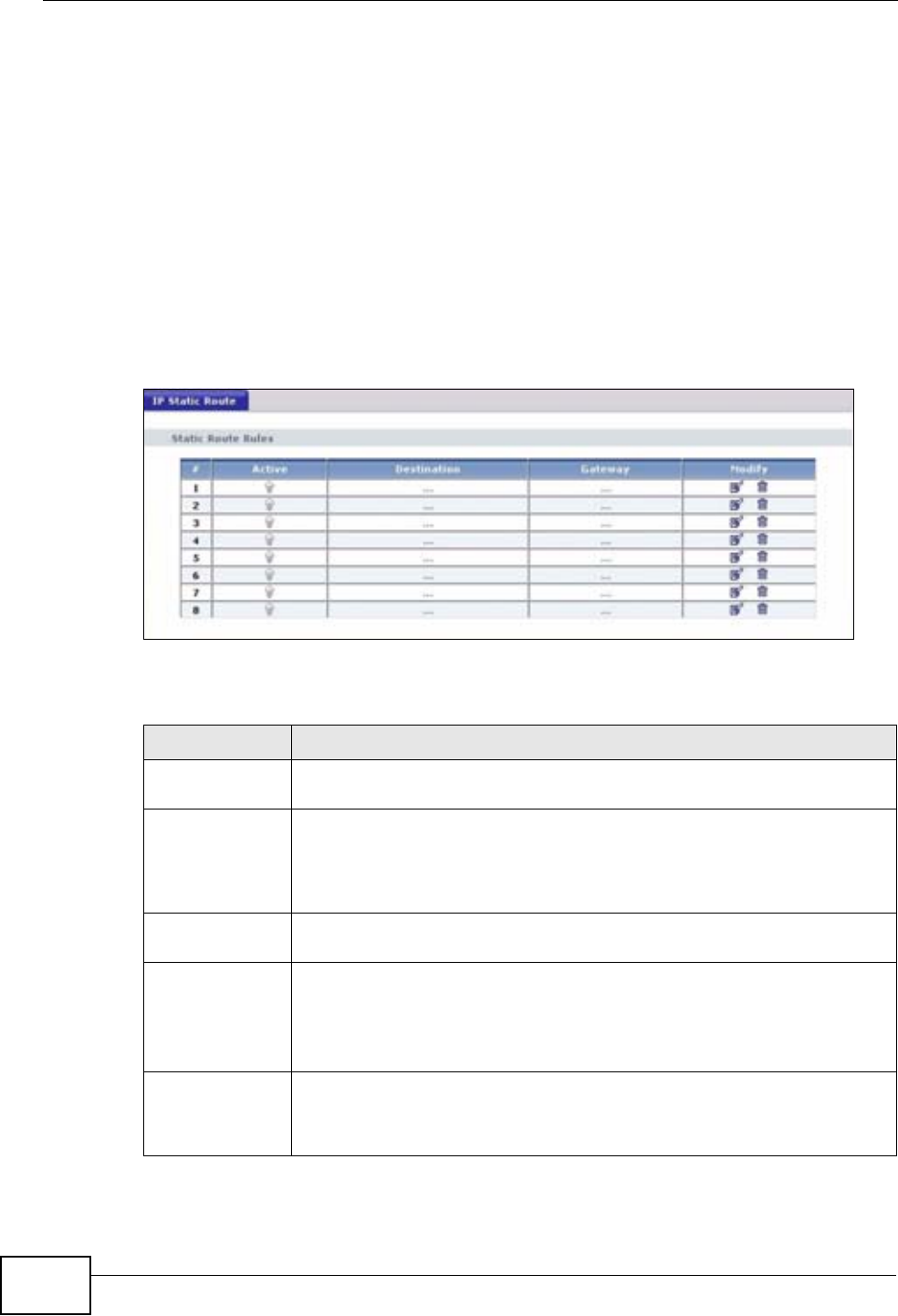
Chapter 14 Static Route
P-320W v3 User’s Guide
132
14.2 What You Can Do
Use the IP Static Route screen (Section 14.3 on page 132) to create and edit
static routes on your P-320W v3.
14.3 IP Static Route Screen
Click Management > Static Route to open the IP Static Route screen. The
following screen displays.
Figure 78 Management > Static Route > IP Static Route
The following table describes the labels in this screen.
Table 53 Management > Static Route > IP Static Route
LABEL DESCRIPTION
#This is the index number of an individual static route. The first entry is
for the default route and not editable.
Active This icon is turned on when this static route is active.
Click the Edit icon under Modify and select the Active checkbox in the
Static Route Setup screen to enable the static route. Clear the
checkbox to disable this static route without having to delete the entry.
Destination This parameter specifies the IP network address of the final destination.
Routing is always based on network number.
Gateway This is the IP address of the gateway. The gateway is an immediate
neighbor of your P-320W v3 that will forward the packet to the
destination. On the LAN, the gateway must be a router on the same
segment as your P-320W v3; over the WAN, the gateway must be the
IP address of one of the remote nodes.
Modify Click the Edit icon to open the static route setup screen. Modify a static
route or create a new static route in the Static Route Setup screen.
Click the Remove icon to delete a static route.
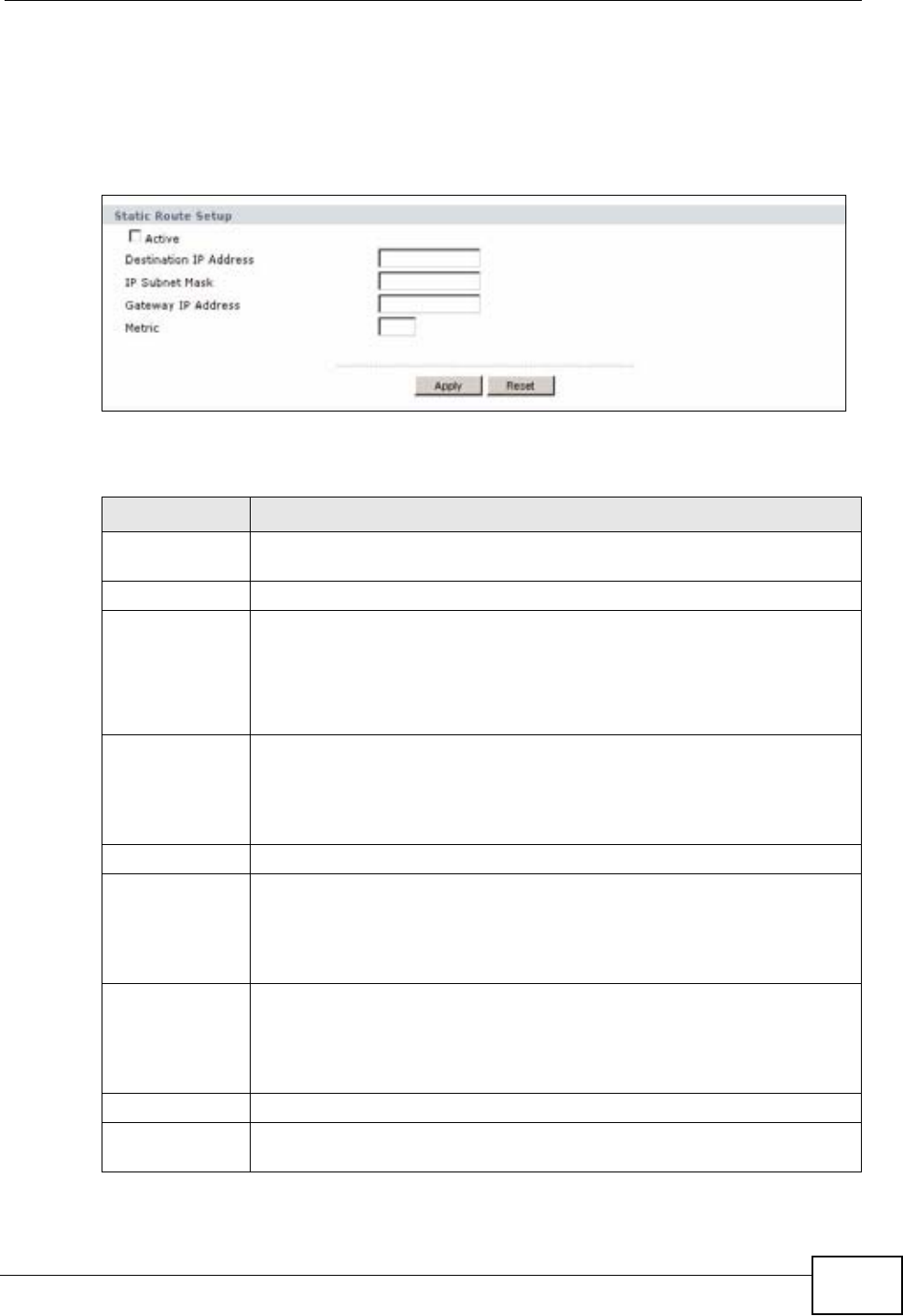
Chapter 14 Static Route
P-320W v3 User’s Guide 133
14.3.1 Static Route Setup Screen
To edit a static route, click the edit icon under Modify. The following screen
displays. Fill in the required information for each static route.
Figure 79 Management > Static Route > IP Static Route: Static Route Setup
The following table describes the labels in this screen.
Table 54 Management > Static Route > IP Static Route: Static Route Setup
LABEL DESCRIPTION
Route Name Enter the name of the IP static route. Leave this field blank to delete
this static route.
Active This field allows you to activate/deactivate this static route.
Private This parameter determines if the P-320W v3 will include this route to a
remote node in its RIP broadcasts.
Select this check box to keep this route private and not included in RIP
broadcasts. Clear this checkbox to propagate this route to other hosts
through RIP broadcasts.
Destination IP
Address
This parameter specifies the IP network address of the final destination.
Routing is always based on network number. If you need to specify a
route to a single host, use a subnet mask of 255.255.255.255 in the
subnet mask field to force the network number to be identical to the
host ID.
IP Subnet Mask Enter the IP subnet mask here.
Gateway IP
Address
Enter the IP address of the gateway. The gateway is an immediate
neighbor of your P-320W v3 that will forward the packet to the
destination. On the LAN, the gateway must be a router on the same
segment as your P-320W v3; over the WAN, the gateway must be the
IP address of one of the Remote Nodes.
Metric Metric represents the “cost” of transmission for routing purposes. IP
routing uses hop count as the measurement of cost, with a minimum of
1 for directly connected networks. Enter a number that approximates
the cost for this link. The number need not be precise, but it must be
between 1 and 15. In practice, 2 or 3 is usually a good number.
Apply Click Apply to save your changes back to the P-320W v3.
Cancel Click Cancel to return to the previous screen and not save your
changes.

Chapter 14 Static Route
P-320W v3 User’s Guide
134
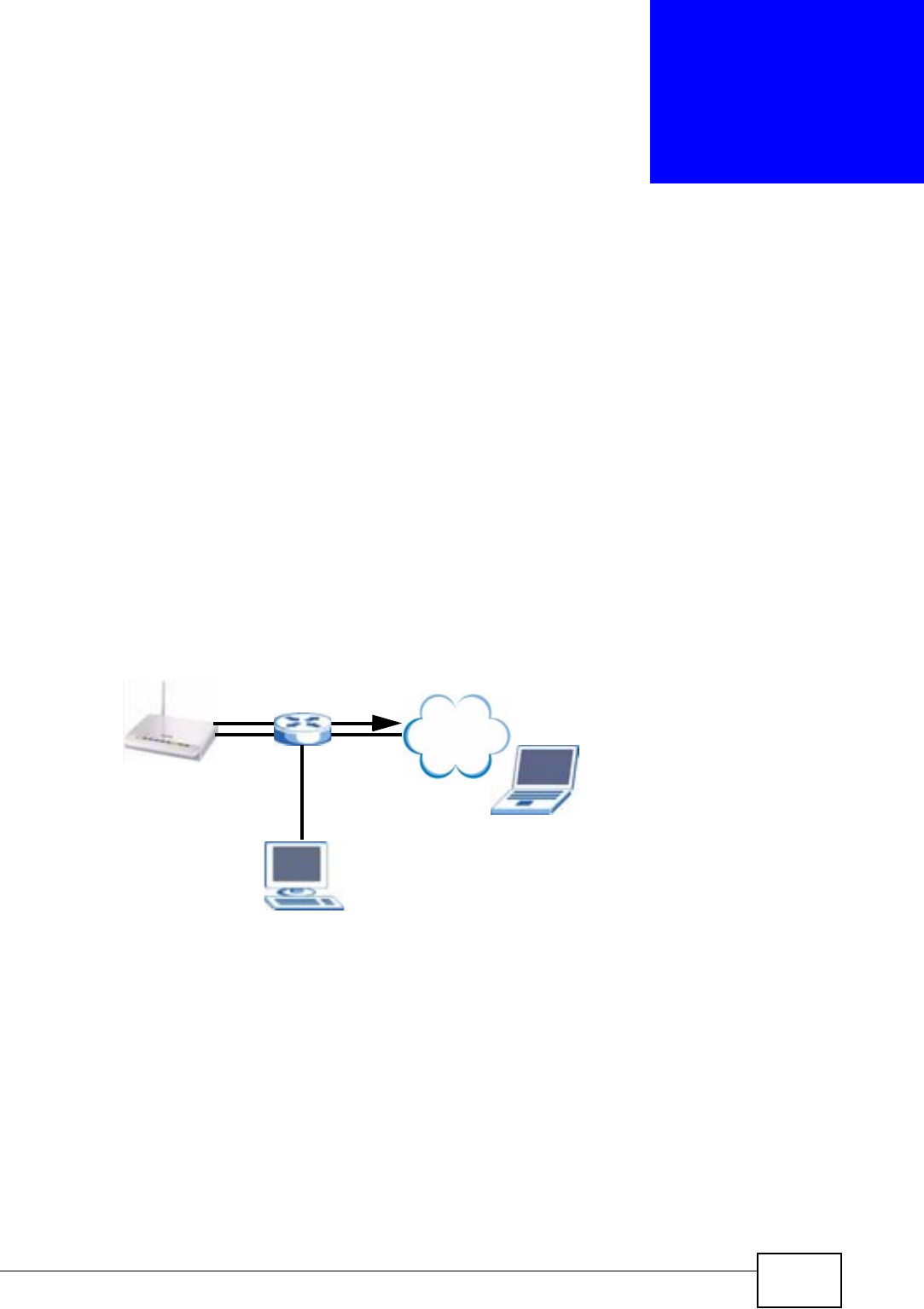
P-320W v3 User’s Guide 135
CHAPTER 15
Remote Management
15.1 Overview
This chapter provides information on the Remote Management screens.
Remote management allows you to determine which services/protocols can access
which P-320W v3 interface (if any) from which computers. You may manage your
P-320W v3 from a remote location via:
•LAN only
•Both WAN and LAN
Figure 80 Remote Management Example
In the figure above, the P-320W v3 (A) is being managed by a desktop computer
(B) connected via LAN (Land Area Network). It is also being accessed by a
notebook (C) connected via WAN (Wide Area Network).
You may only have one remote management session running at a time.
A
B
C
LAN WAN
Internet

Chapter 15 Remote Management
P-320W v3 User’s Guide
136
15.2 What You Can Do
•Use the WWW screen (Section 15.4 on page 137) to change your P-320W v3’s
World Wide Web settings.
•Use the SNMP screen (Section 15.5 on page 138) to have a manager station
administrate your P-320W v3 over the network.
•Use the Security screen (Section 15.6 on page 139) to configure how your P-
320W v3 responds to ping from WAN.
15.3 What You Need to Know
The following sections provide helpful information needed to configure the screens
in this chapter.
15.3.1 Remote Management Limitations
Remote management over LAN or LAN and WAN will not work when:
1You have disabled that service in one of the remote management screens.
2The IP address in the Secured Client IP Address field (Section 15.4 on page
137) does not match the client IP address. If it does not match, the P-320W v3
will disconnect the session immediately.
3There is already another remote management session with an equal or higher
priority running. You may only have one remote management session running at
one time.
4There is a firewall rule that blocks it.
15.3.2 Remote Management and NAT
When NAT is enabled:
• Use the P-320W v3’s WAN IP address when configuring from the WAN.
• Use the P-320W v3’s LAN IP address when configuring from the LAN.
15.3.3 System Timeout
There is a default system management idle timeout of five minutes (three
hundred seconds). The P-320W v3 automatically logs you out if the management
session remains idle for longer than this timeout period. The management session
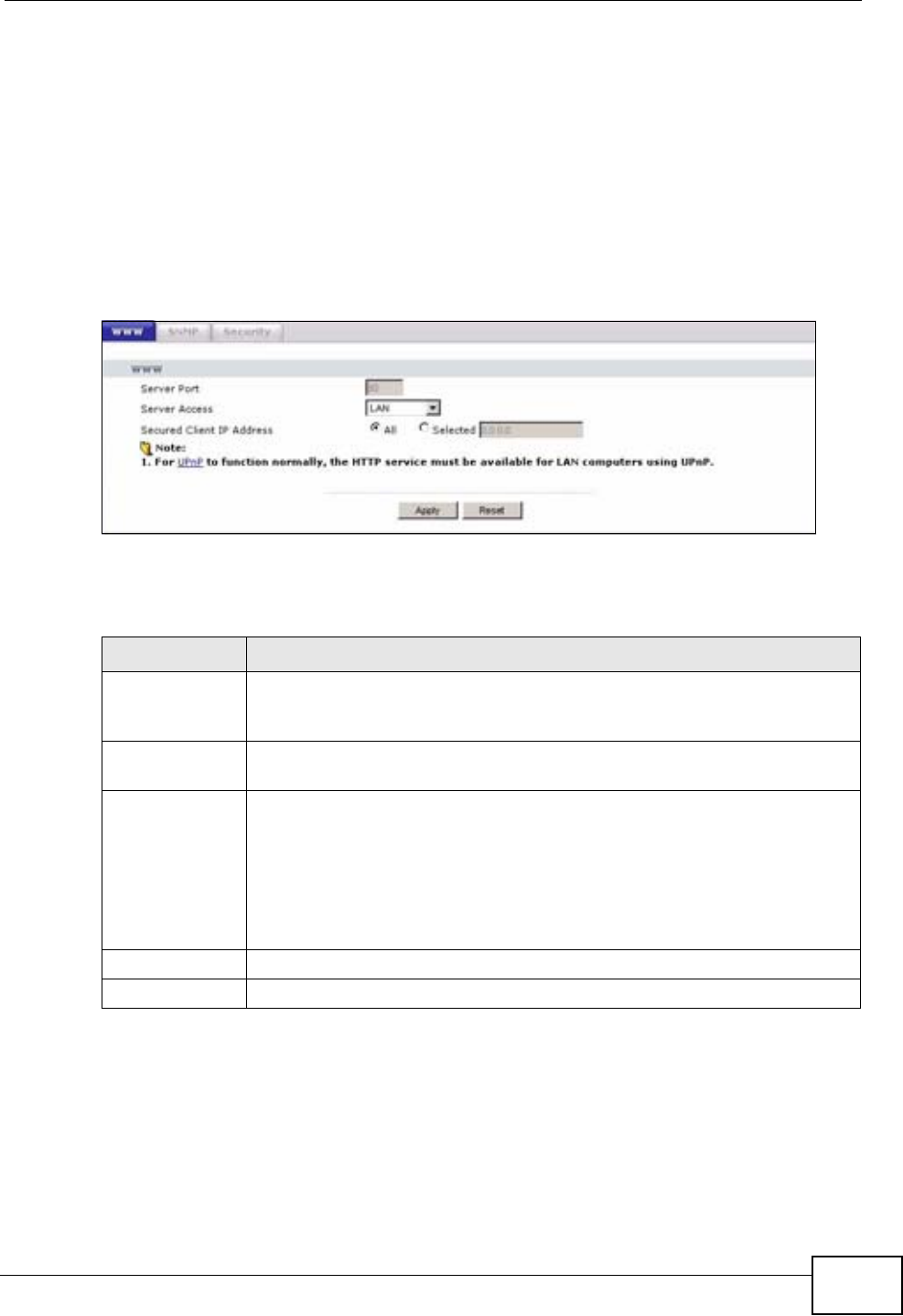
Chapter 15 Remote Management
P-320W v3 User’s Guide 137
does not time out when a statistics screen is polling. You can change the timeout
period in the System screen.
15.4 WWW Screen
To change your P-320W v3’s World Wide Web settings, click Management >
Remote MGMT to display the WWW screen.
Figure 81 Management > Remote MGMT > WWW
The following table describes the labels in this screen
Table 55 Management > Remote MGMT > WWW
LABEL DESCRIPTION
Server Port You may change the server port number for a service if needed,
however you must use the same port number in order to use that
service for remote management.
Server Access Select the interface(s) through which a computer may access the P-
320W v3 using this service.
Secured Client
IP Address
A secured client is a “trusted” computer that is allowed to communicate
with the P-320W v3 using this service.
Select All to allow any computer to access the P-320W v3 using this
service.
Choose Selected to just allow the computer with the IP address that
you specify to access the P-320W v3 using this service.
Apply Click Apply to save your customized settings and exit this screen.
Reset Click Reset to begin configuring this screen afresh.
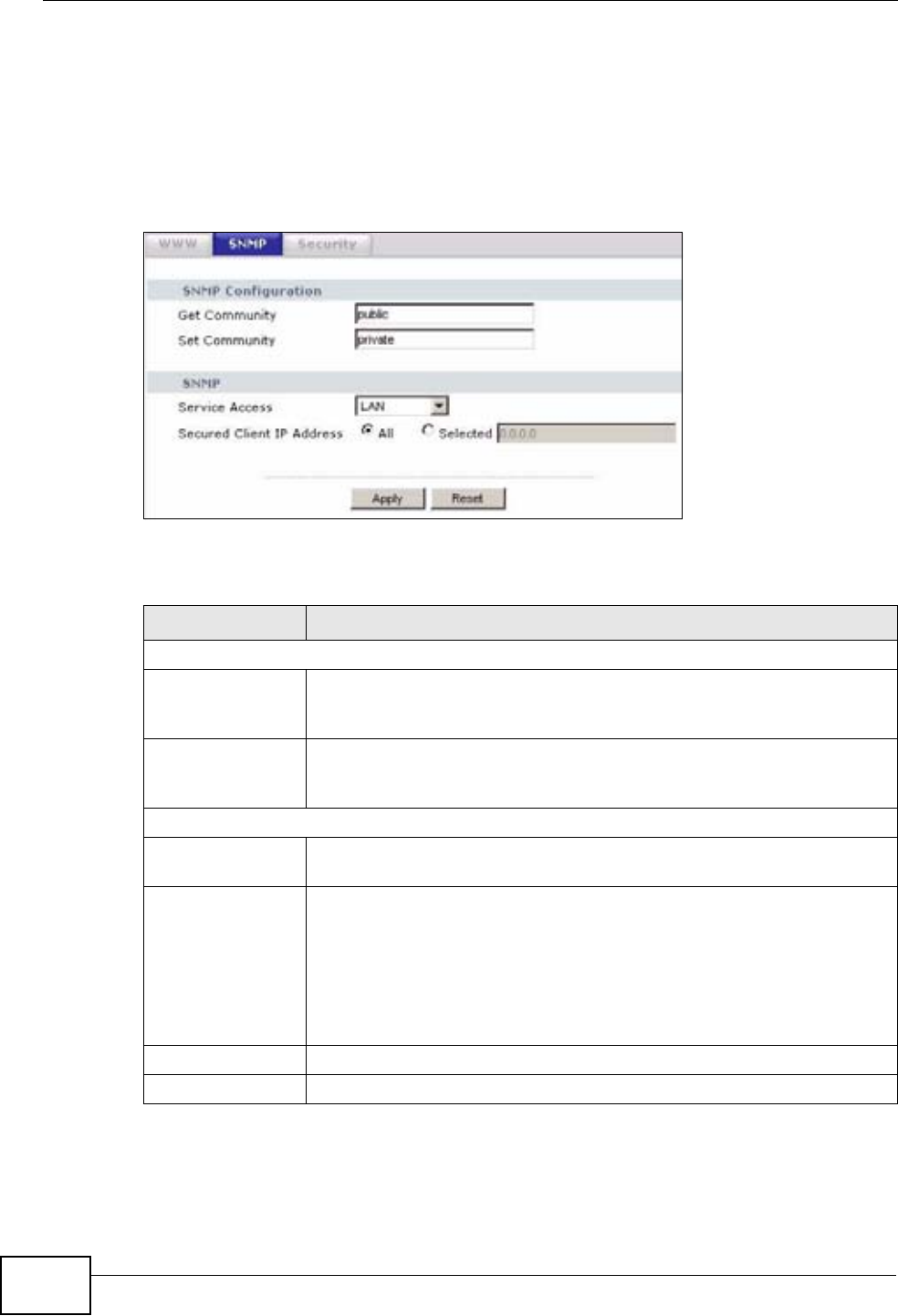
Chapter 15 Remote Management
P-320W v3 User’s Guide
138
15.5 The SNMP Screen
Use this screen to have a manager station administrate your P-320W v3 over the
network. To change your P-320W v3’s SNMP settings, click Management >
Remote MGMT > SNMP. The following screen displays.
Figure 82 Management > Remote MGMT > SNMP
The following table describes the labels in this screen.
Table 56 Remote MGNT > Remote MGMT > SNMP
LABEL DESCRIPTION
SNMP Configuration
Get Community Enter the Get Community, which is the password for the incoming
Get and GetNext requests from the management station. The default
is public and allows all requests.
Set Community Enter the Set community, which is the password for incoming Set
requests from the management station. The default is public and
allows all requests.
SNMP
Service Access Select the interface(s) through which a computer may access the P-
320W v3 using this service.
Secured Client IP
Address
A secured client is a “trusted” computer that is allowed to
communicate with the P-320W v3 using this service.
Select All to allow any computer to access the P-320W v3 using this
service.
Choose Selected to just allow the computer with the IP address that
you specify to access the P-320W v3 using this service.
Apply Click Apply to save your customized settings and exit this screen.
Reset Click Reset to begin configuring this screen afresh.
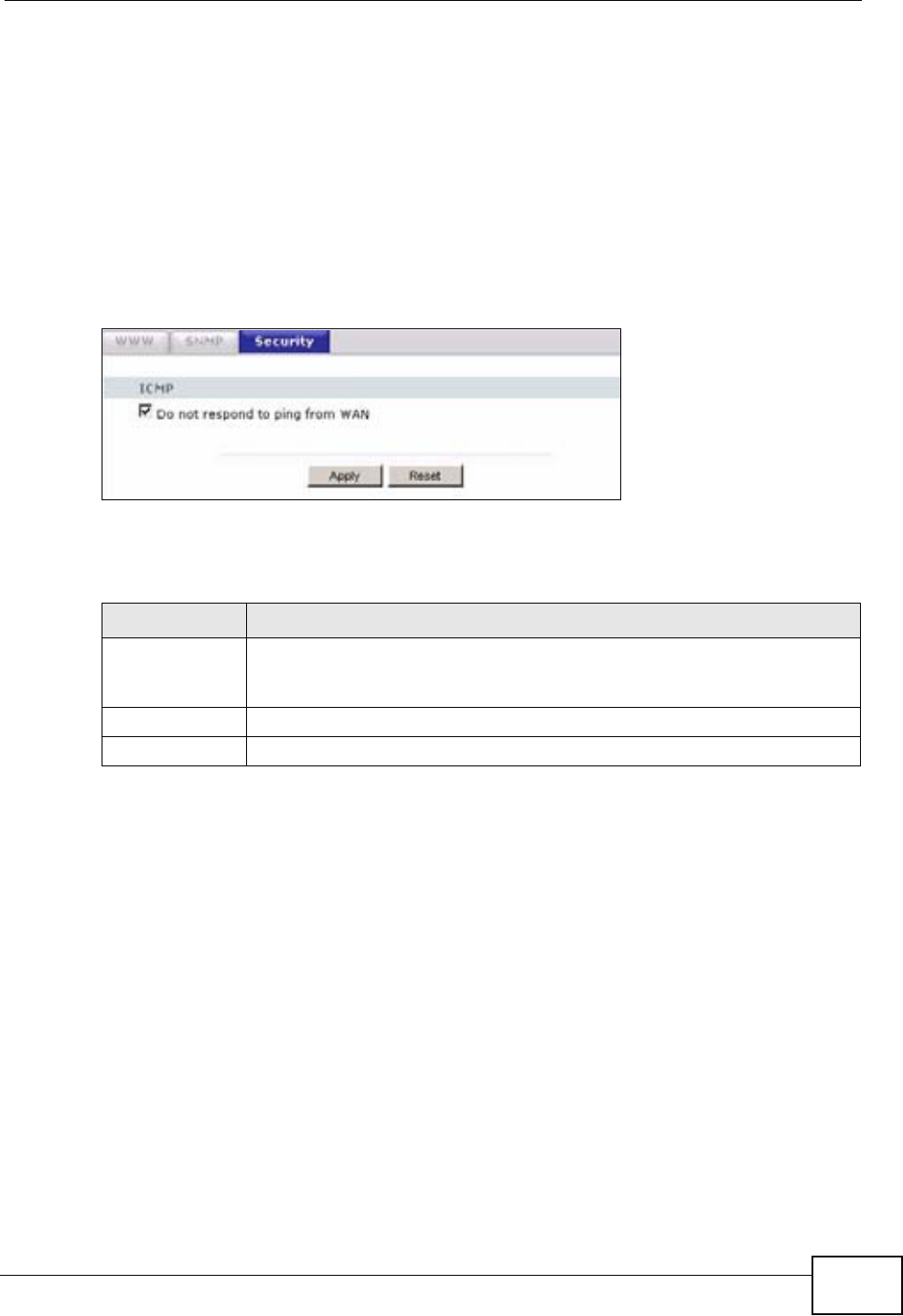
Chapter 15 Remote Management
P-320W v3 User’s Guide 139
15.6 Security Screen
Internet Control Message Protocol is a message control and error-reporting
protocol between a host server and a gateway to the Internet. ICMP uses Internet
Protocol (IP) datagrams, but the messages are processed by the TCP/IP software
and directly apparent to the application user.
To configure how your P-320W v3 responds to ping from WAN, click Management
>Remote MGMT to display the Security screen.
Figure 83 Management > Remote MGMT > Security
The following table describes the labels in this screen.
Table 57 Management > Remote MGMT > Security
LABEL DESCRIPTION
Do not respond
to ping from
WAN
Check this if you do not want the P-320W v3 respond to any incoming
WAN Ping requests.
Apply Click Apply to save your customized settings and exit this screen.
Reset Click Reset to begin configuring this screen afresh.

Chapter 15 Remote Management
P-320W v3 User’s Guide
140

P-320W v3 User’s Guide 141
CHAPTER 16
Universal Plug-and-Play (UPnP)
16.1 Overview
This chapter introduces the UPnP feature in the web configurator.
Universal Plug and Play (UPnP) is a distributed, open networking standard that
uses TCP/IP for simple peer-to-peer network connectivity between devices. A
UPnP device can dynamically join a network, obtain an IP address, convey its
capabilities and learn about other devices on the network. In turn, a device can
leave a network smoothly and automatically when it is no longer in use.
See Section 16.4 on page 143 for configuration instructions.
16.2 What You Can Do
Use the General screen (Section 16.4 on page 143) to activate UPnP.
16.3 What You Need to Know
The following sections provide information that can help you configure the UPnP
screen.
16.3.1 How do I know if I'm using UPnP?
UPnP hardware is identified as an icon in the Network Connections folder
(Windows XP). Each UPnP compatible device installed on your network will appear
as a separate icon. Selecting the icon of a UPnP device will allow you to access the
information and properties of that device.

Chapter 16 Universal Plug-and-Play (UPnP)
P-320W v3 User’s Guide
142
16.3.2 NAT Traversal
UPnP NAT traversal automates the process of allowing an application to operate
through NAT. UPnP network devices can automatically configure network
addressing, announce their presence in the network to other UPnP devices and
enable exchange of simple product and service descriptions. NAT traversal allows
the following:
• Dynamic port mapping
• Learning public IP addresses
• Assigning lease times to mappings
Windows Messenger is an example of an application that supports NAT traversal
and UPnP.
See the NAT chapter for more information on NAT.
16.3.3 Cautions with UPnP
The automated nature of NAT traversal applications in establishing their own
services and opening firewall ports may present network security issues. Network
information and configuration may also be obtained and modified by users in some
network environments.
When a UPnP device joins a network, it announces its presence with a multicast
message. For security reasons, the P-320W v3 allows multicast messages on the
LAN only.
All UPnP-enabled devices may communicate freely with each other without
additional configuration. Disable UPnP if this is not your intention.
16.3.4 UPnP and ZyXEL
ZyXEL has achieved UPnP certification from the Universal Plug and Play Forum
UPnP™ Implementers Corp. (UIC). ZyXEL's UPnP implementation supports
Internet Gateway Device (IGD) 1.0.
See the following sections for examples of installing and using UPnP.
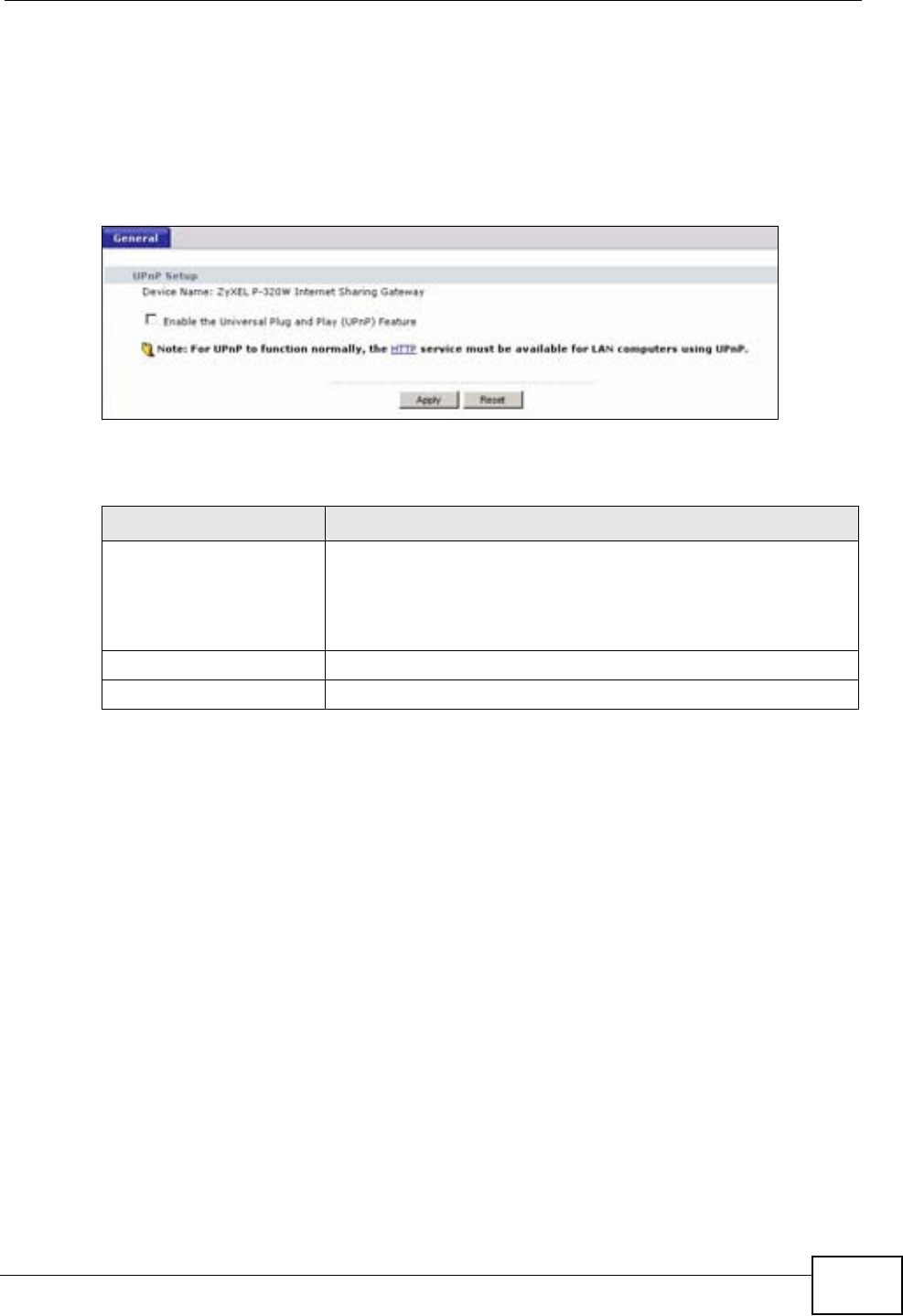
Chapter 16 Universal Plug-and-Play (UPnP)
P-320W v3 User’s Guide 143
16.4 UPnP Screen
Use this screen to activate UPnP.
Click the Management > UPnP to display the UPnP screen.
Figure 84 Management > UPnP > General
The following table describes the labels in this screen.
16.5 Technical Reference
This section provides some technical information about the topics covered in this
chapter.
16.5.1 Installing UPnP in Windows Example
This section shows how to install UPnP in Windows Me and Windows XP.
16.5.1.1 Installing UPnP in Windows Me
Follow the steps below to install the UPnP in Windows Me.
1Click Start and Control Panel. Double-click Add/Remove Programs.
Table 58 Management > UPnP > General
LABEL DESCRIPTION
Enable the Universal Plug
and Play (UPnP) Feature
Select this check box to activate UPnP. Be aware that anyone
could use a UPnP application to open the web configurator's
login screen without entering the P-320W v3's IP address
(although you must still enter the password to access the web
configurator).
Apply Click Apply to save the setting to the P-320W v3.
Reset Click Reset to return to the previously saved settings.
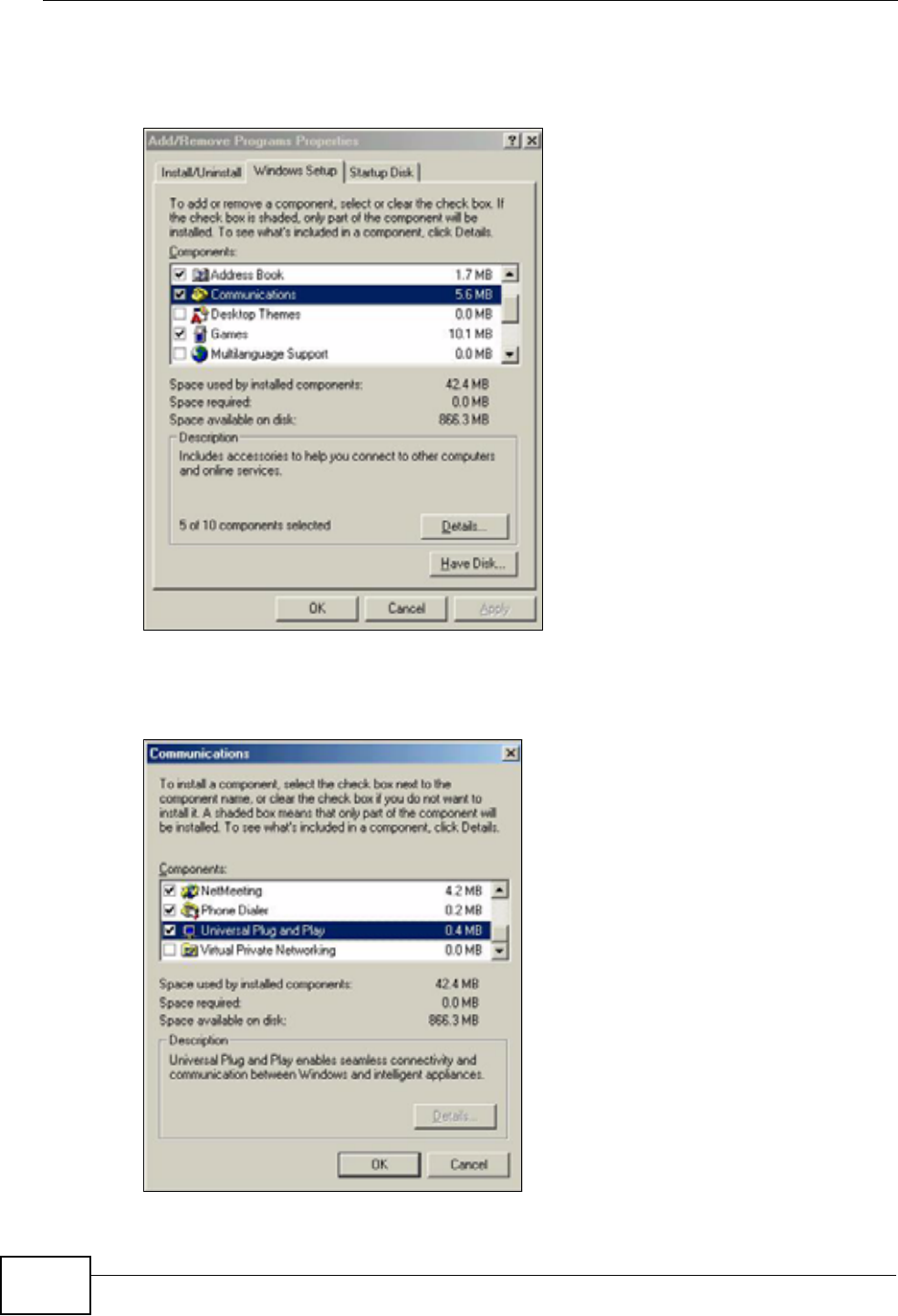
Chapter 16 Universal Plug-and-Play (UPnP)
P-320W v3 User’s Guide
144
2Click on the Windows Setup tab and select Communication in the
Components selection box. Click Details.
Figure 85 Add/Remove Programs: Windows Setup: Communication
3In the Communications window, select the Universal Plug and Play check box
in the Components selection box.
Figure 86 Add/Remove Programs: Windows Setup: Communication: Components
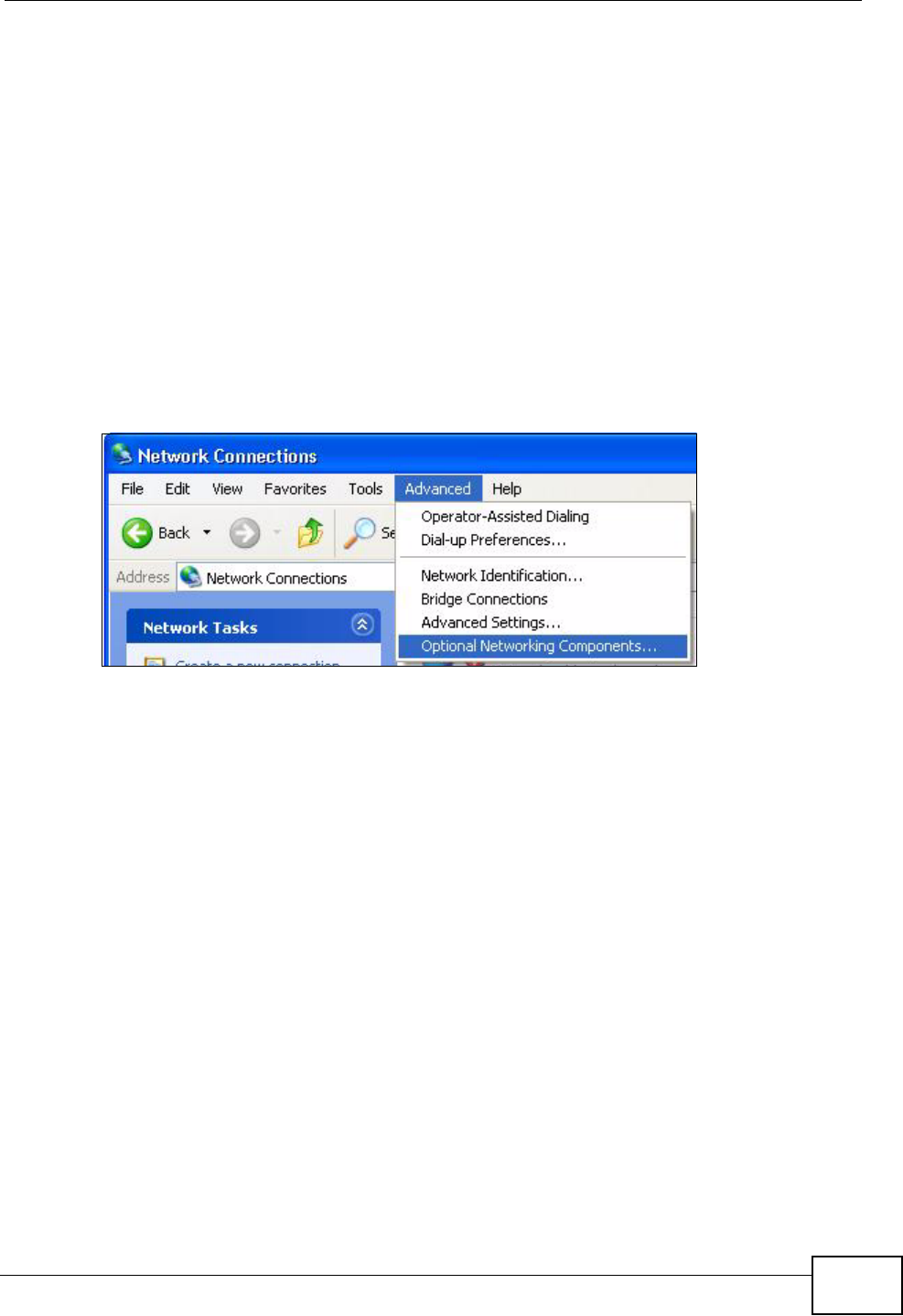
Chapter 16 Universal Plug-and-Play (UPnP)
P-320W v3 User’s Guide 145
4Click OK to go back to the Add/Remove Programs Properties window and click
Next.
5Restart the computer when prompted.
Installing UPnP in Windows XP
Follow the steps below to install the UPnP in Windows XP.
1Click Start and Control Panel.
2Double-click Network Connections.
3In the Network Connections window, click Advanced in the main menu and
select Optional Networking Components ….
Figure 87 Network Connections
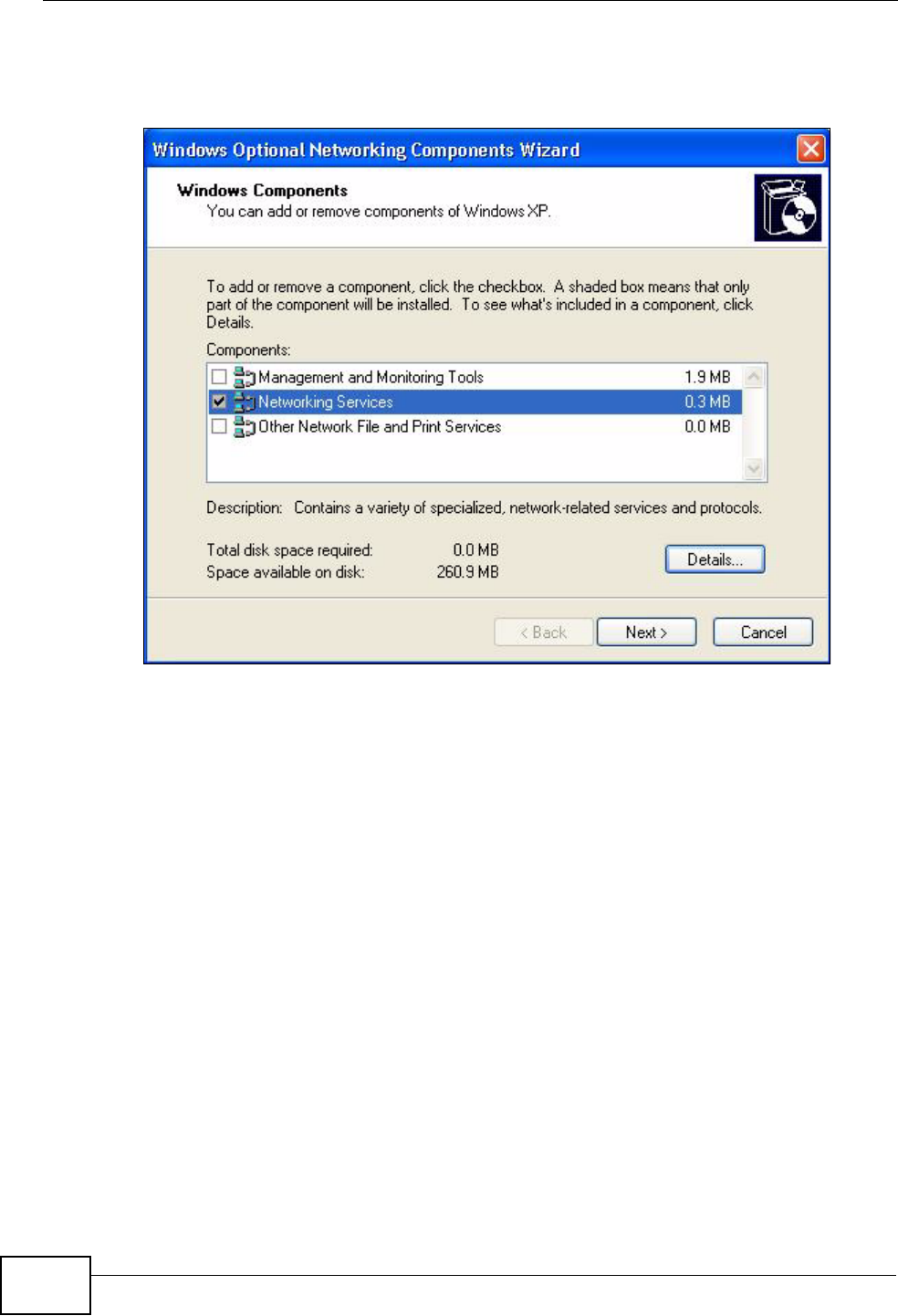
Chapter 16 Universal Plug-and-Play (UPnP)
P-320W v3 User’s Guide
146
4The Windows Optional Networking Components Wizard window displays.
Select Networking Service in the Components selection box and click Details.
Figure 88 Windows Optional Networking Components Wizard
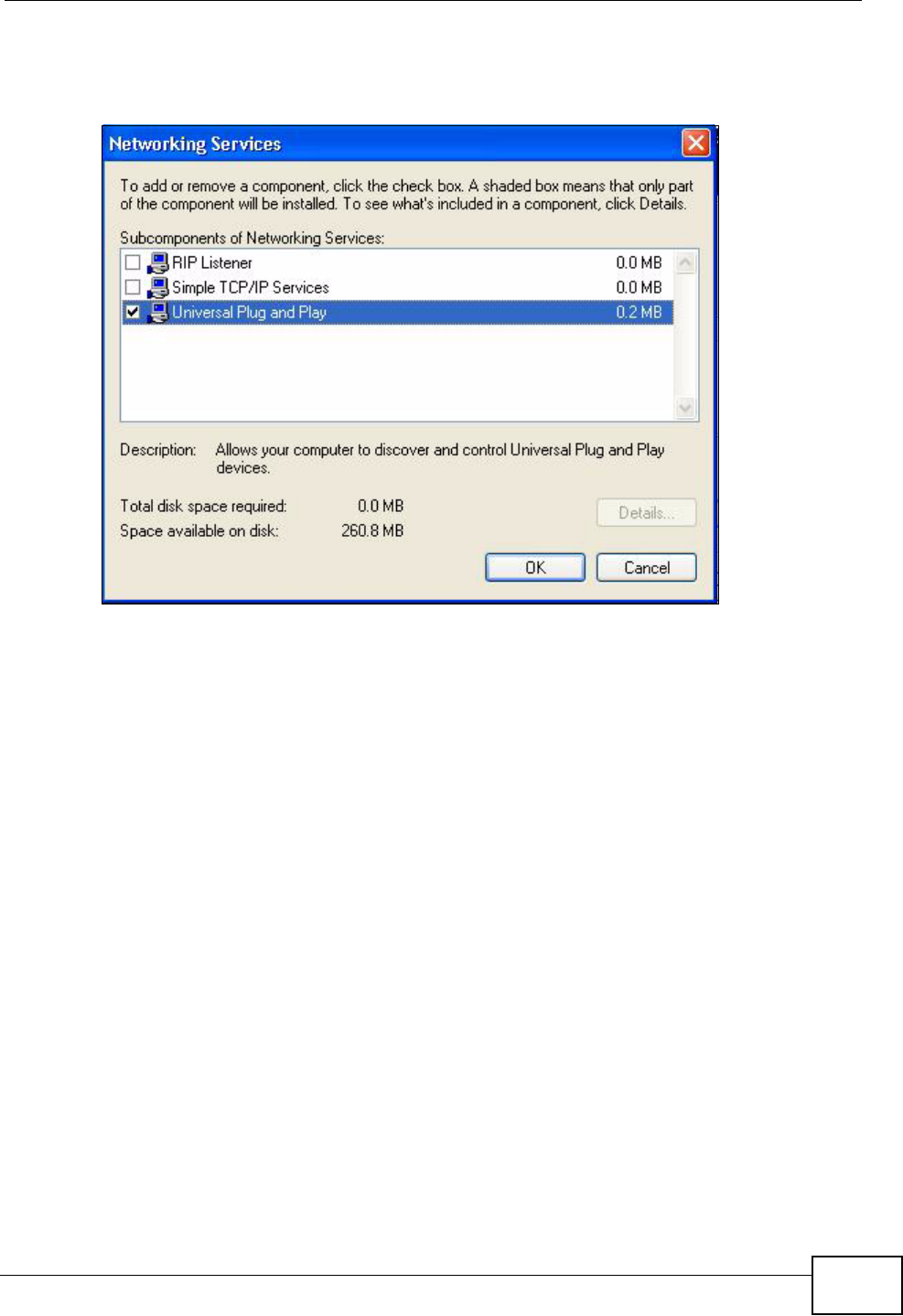
Chapter 16 Universal Plug-and-Play (UPnP)
P-320W v3 User’s Guide 147
5In the Networking Services window, select the Universal Plug and Play check
box.
Figure 89 Networking Services
6Click OK to go back to the Windows Optional Networking Component Wizard
window and click Next.
16.5.1.2 Using UPnP in Windows XP Example
This section shows you how to use the UPnP feature in Windows XP. You must
already have UPnP installed in Windows XP and UPnP activated on the P-320W v3.
Make sure the computer is connected to a LAN port of the P-320W v3. Turn on
your computer and the P-320W v3.
Auto-discover Your UPnP-enabled Network Device
1Click Start and Control Panel. Double-click Network Connections. An icon
displays under Internet Gateway.
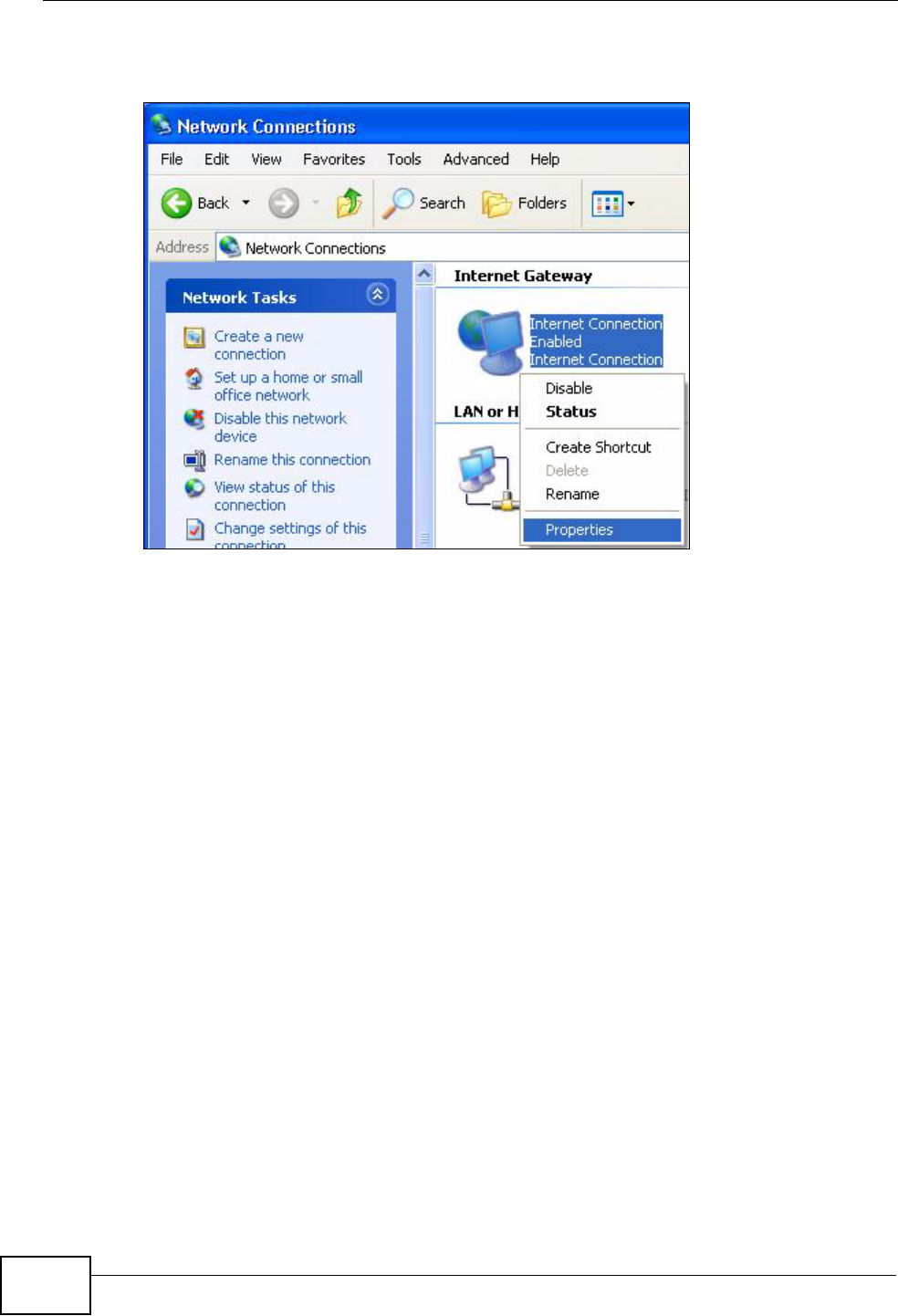
Chapter 16 Universal Plug-and-Play (UPnP)
P-320W v3 User’s Guide
148
2Right-click the icon and select Properties.
Figure 90 Network Connections
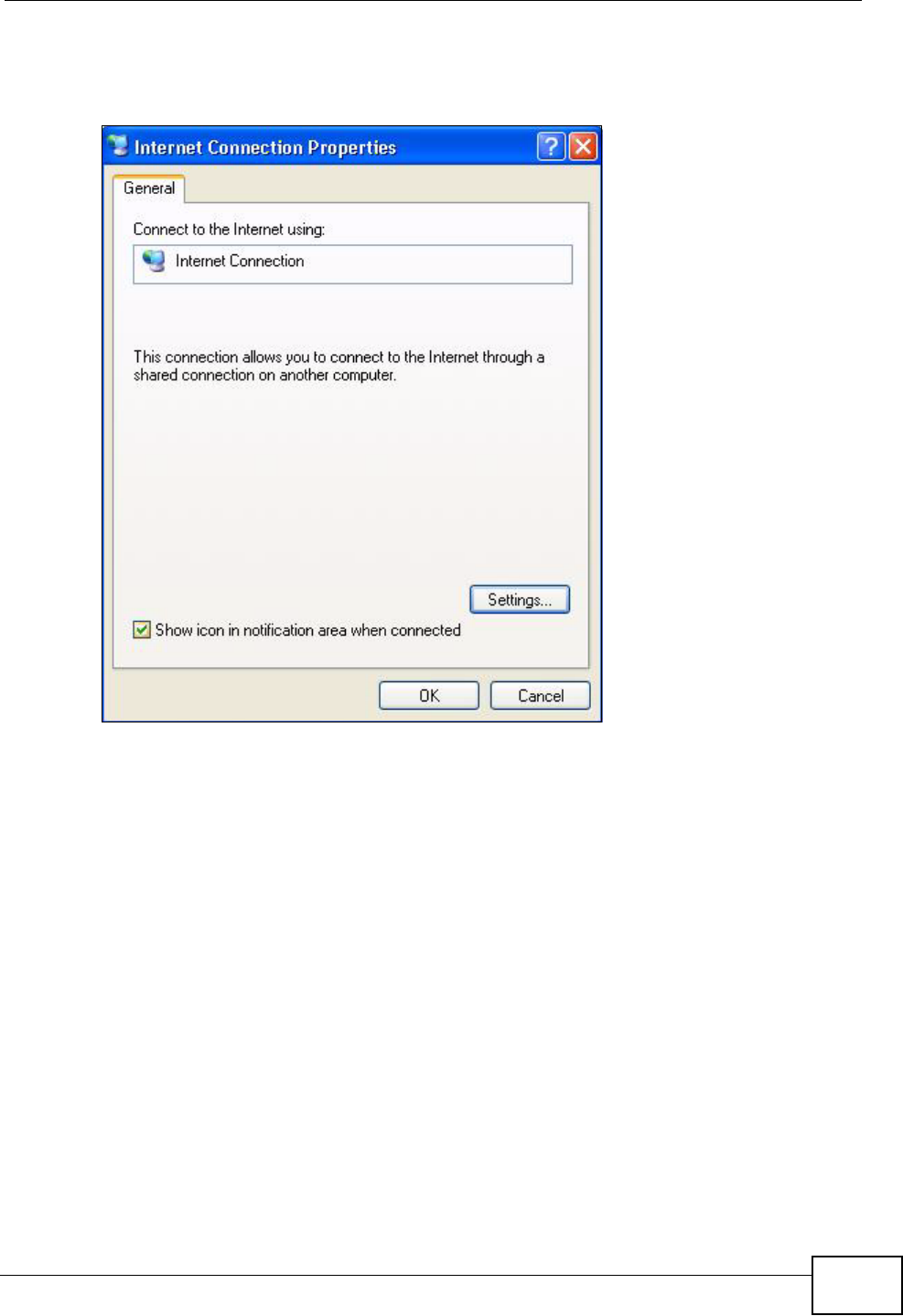
Chapter 16 Universal Plug-and-Play (UPnP)
P-320W v3 User’s Guide 149
3In the Internet Connection Properties window, click Settings to see the port
mappings there were automatically created.
Figure 91 Internet Connection Properties
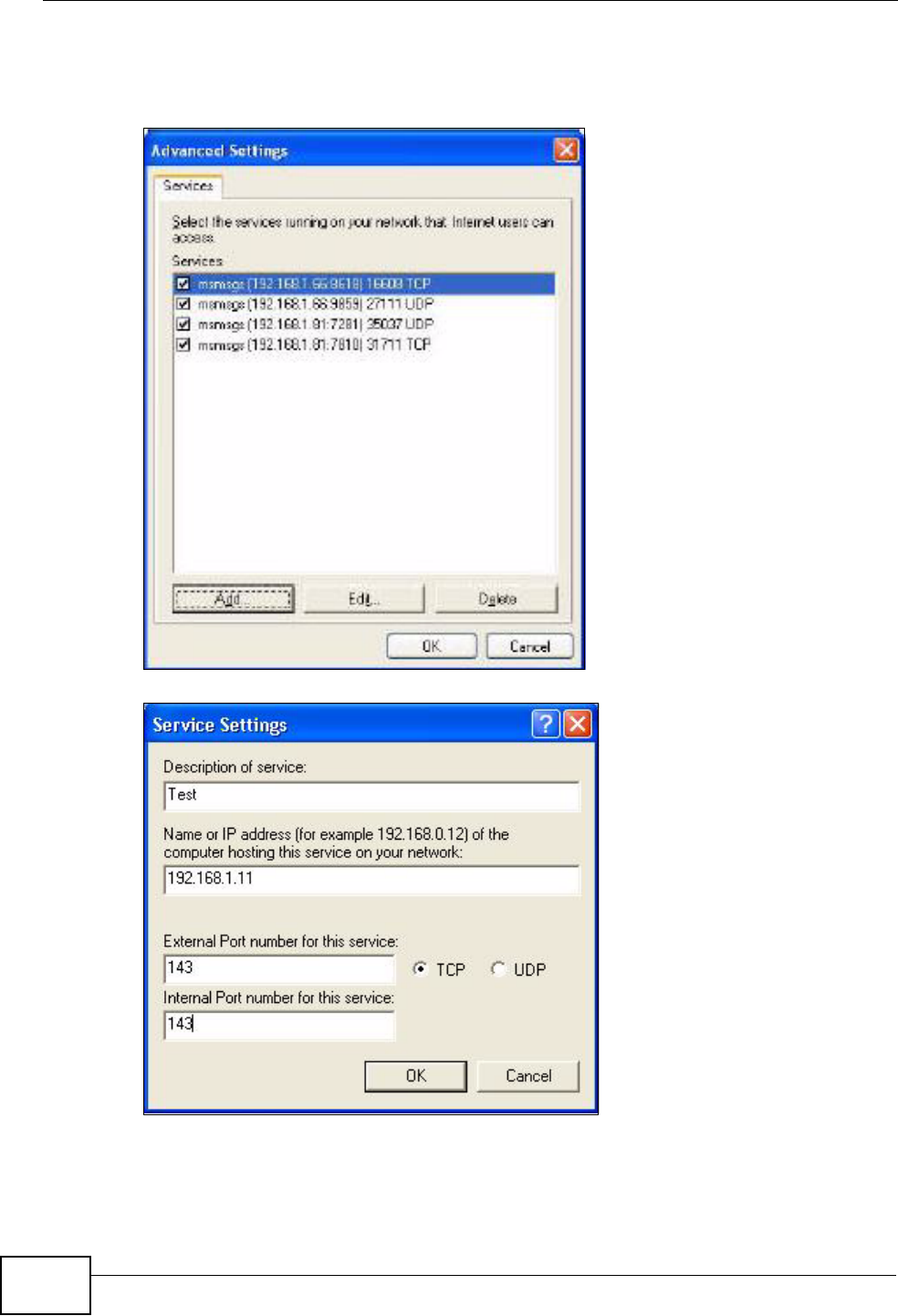
Chapter 16 Universal Plug-and-Play (UPnP)
P-320W v3 User’s Guide
150
4You may edit or delete the port mappings or click Add to manually add port
mappings.
Figure 92 Internet Connection Properties: Advanced Settings
Figure 93 Internet Connection Properties: Advanced Settings: Add
5When the UPnP-enabled device is disconnected from your computer, all port
mappings will be deleted automatically.
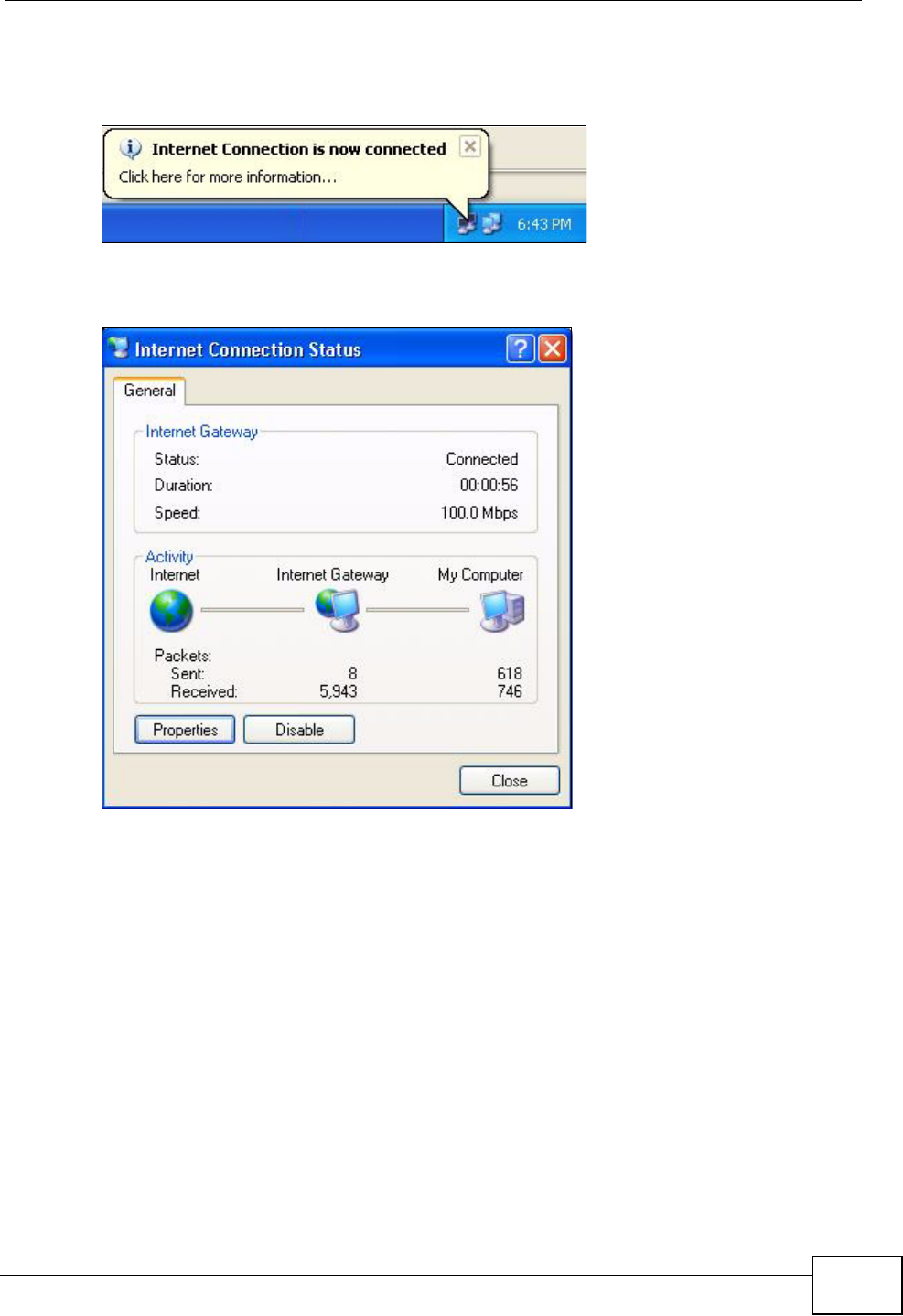
Chapter 16 Universal Plug-and-Play (UPnP)
P-320W v3 User’s Guide 151
6Select Show icon in notification area when connected option and click OK.
An icon displays in the system tray.
Figure 94 System Tray Icon
7Double-click on the icon to display your current Internet connection status.
Figure 95 Internet Connection Status
Web Configurator Easy Access
With UPnP, you can access the web-based configurator on the P-320W v3 without
finding out the IP address of the P-320W v3 first. This comes helpful if you do not
know the IP address of the P-320W v3.
Follow the steps below to access the web configurator.
1Click Start and then Control Panel.
2Double-click Network Connections.
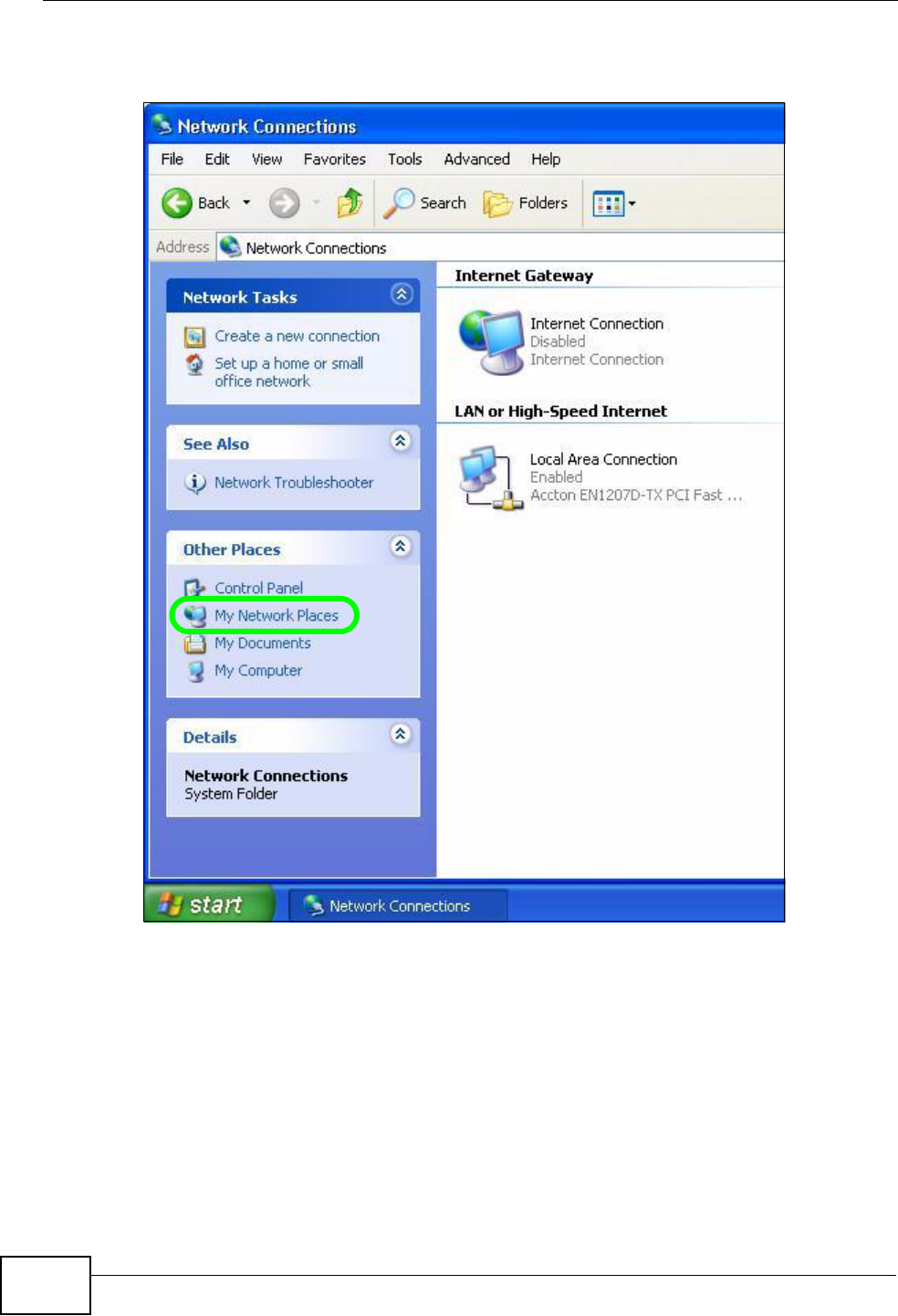
Chapter 16 Universal Plug-and-Play (UPnP)
P-320W v3 User’s Guide
152
3Select My Network Places under Other Places.
Figure 96 Network Connections
4An icon with the description for each UPnP-enabled device displays under Local
Network.
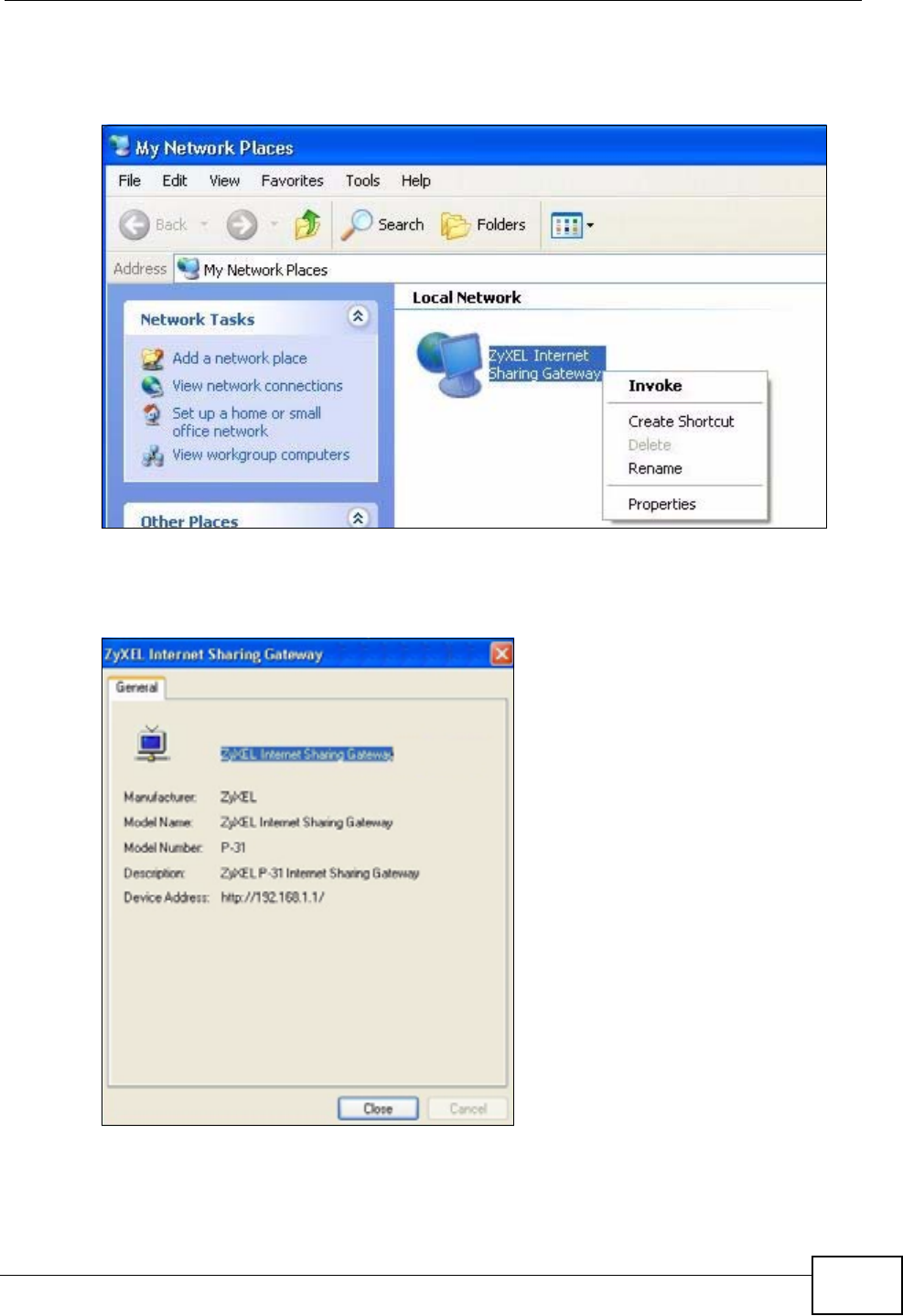
Chapter 16 Universal Plug-and-Play (UPnP)
P-320W v3 User’s Guide 153
5Right-click on the icon for your P-320W v3 and select Invoke. The web
configurator login screen displays.
Figure 97 Network Connections: My Network Places
6Right-click on the icon for your P-320W v3 and select Properties. A properties
window displays with basic information about the P-320W v3.
Figure 98 Network Connections: My Network Places: Properties: Example

Chapter 16 Universal Plug-and-Play (UPnP)
P-320W v3 User’s Guide
154

155
PART V
Maintenance and
Troubleshooting
System (157)
Logs (163)
Product Specifications (193)

156

P-320W v3 User’s Guide 157
CHAPTER 17
System
17.1 Overview
This chapter provides information on the System screens.
See the chapter about wizard setup for more information on the next few screens.
17.2 What You Can Do
•Use the General screen (Section 17.4 on page 158) to identify the P-320W v3
in an Ethernet network.
•Use the Dynamic DNS screen (Section 17.5 on page 160) to change your P-
320W v3’s DDNS settings
•Use the Time Setting screen (Section 17.6 on page 161) to change your P-
320W v3’s time and date.
17.3 What You Need to Know
The following sections provide information that can be helpful in configuring the
screens in this chapter.
17.3.1 Dynamic DNS Introduction
Dynamic DNS allows you to update your current dynamic IP address with one or
many dynamic DNS services so that anyone can contact you (in NetMeeting, CU-
SeeMe, etc.). You can also access your FTP server or Web site on your own
computer using a domain name (for instance myhost.dhs.org, where myhost is a
name of your choice) that will never change instead of using an IP address that
changes each time you reconnect. Your friends or relatives will always be able to
call you even if they don't know your IP address.
First of all, you need to have registered a dynamic DNS account with
www.dyndns.org. This is for people with a dynamic IP from their ISP or DHCP
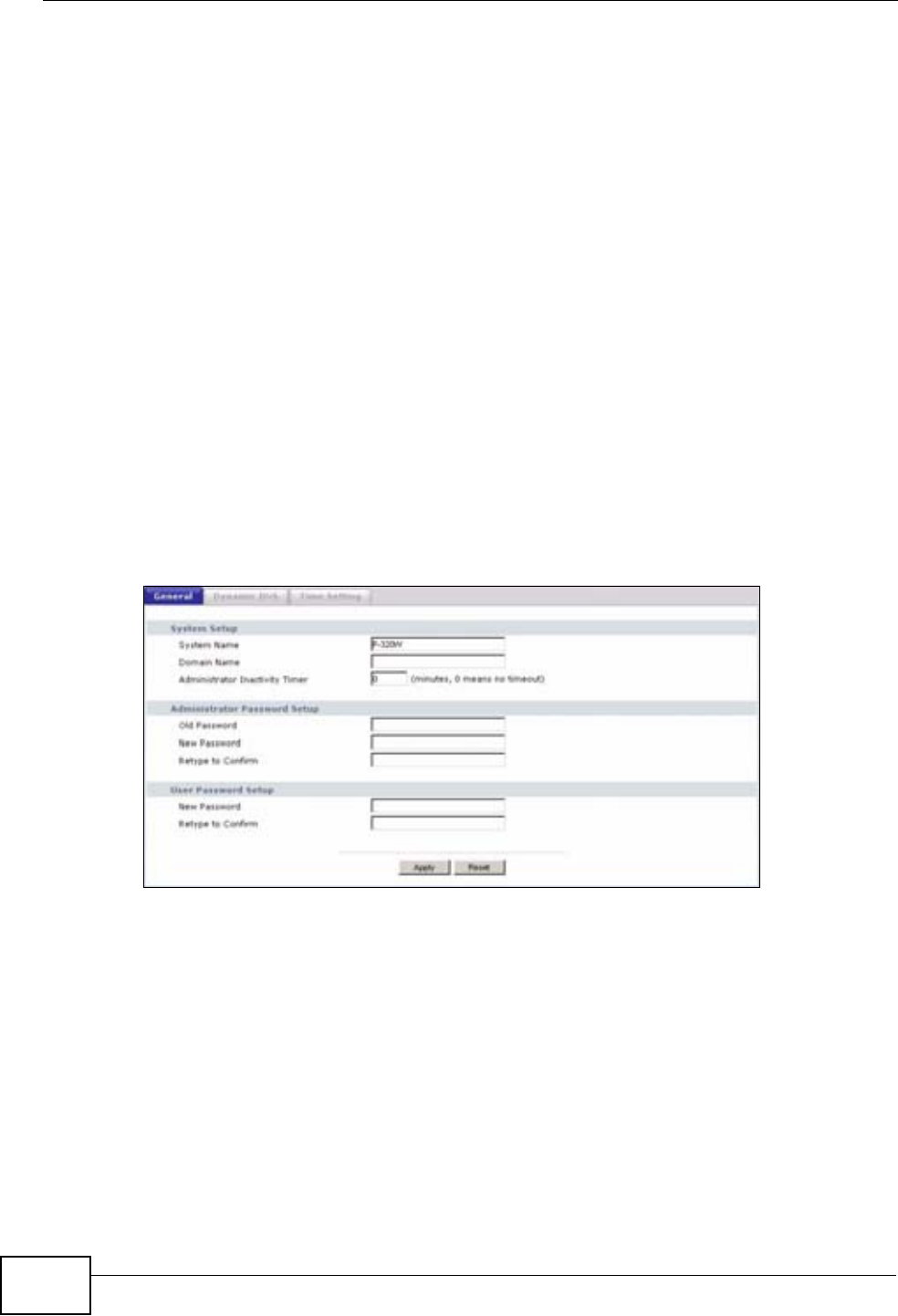
Chapter 17 System
P-320W v3 User’s Guide
158
server that would still like to have a domain name. The Dynamic DNS service
provider will give you a password or key.
17.3.2 DynDNS Wildcard
Enabling the wildcard feature for your host causes *.yourhost.dyndns.org to be
aliased to the same IP address as yourhost.dyndns.org. This feature is useful if
you want to be able to use, for example, www.yourhost.dyndns.org and still reach
your hostname.
If you have a private WAN IP address, then you cannot use Dynamic DNS.
17.4 System General Screen
Use this screen to identify the P-320W v3 in an Ethernet network.
Click Maintenance > System. The following screen displays.
Figure 99 Maintenance > System > General

Chapter 17 System
P-320W v3 User’s Guide 159
The following table describes the labels in this screen.
Table 59 Maintenance > System > General
LABEL DESCRIPTION
System Name System Name is a unique name to identify the P-320W v3 in an
Ethernet network. It is recommended you enter your computer’s
“Computer name” in this field (see the chapter about wizard setup for
how to find your computer’s name).
This name can be up to 30 alphanumeric characters long. Spaces are
not allowed, but dashes “-” and underscores "_" are accepted.
Domain Name Enter the domain name (if you know it) here. If you leave this field
blank, the ISP may assign a domain name via DHCP.
The domain name entered by you is given priority over the ISP
assigned domain name.
Administrator
Inactivity Timer
Type how many minutes a management session can be left idle before
the session times out. The default is 5 minutes. After it times out you
have to log in with your password again. Very long idle timeouts may
have security risks. A value of "0" means a management session never
times out, no matter how long it has been left idle (not
recommended).
Administrator Password Setup
Change the administrator’s password using the fields as shown.
Old Password Type the default password or the existing password you use to access
the system in this field.
New Password Type your new system password (up to 30 characters). Note that as
you type a password, the screen displays an asterisk (*) for each
character you type.
Retype to
Confirm
Type the new password again in this field.
User Password Setup
Change the user password using the fields as shown.
New Password Type your new system password (up to 30 characters). Note that as
you type a password, the screen displays an asterisk (*) for each
character you type.
Retype to
Confirm
Type the new password again in this field.
Apply Click Apply to save your changes back to the P-320W v3.
Reset Click Reset to begin configuring this screen afresh.
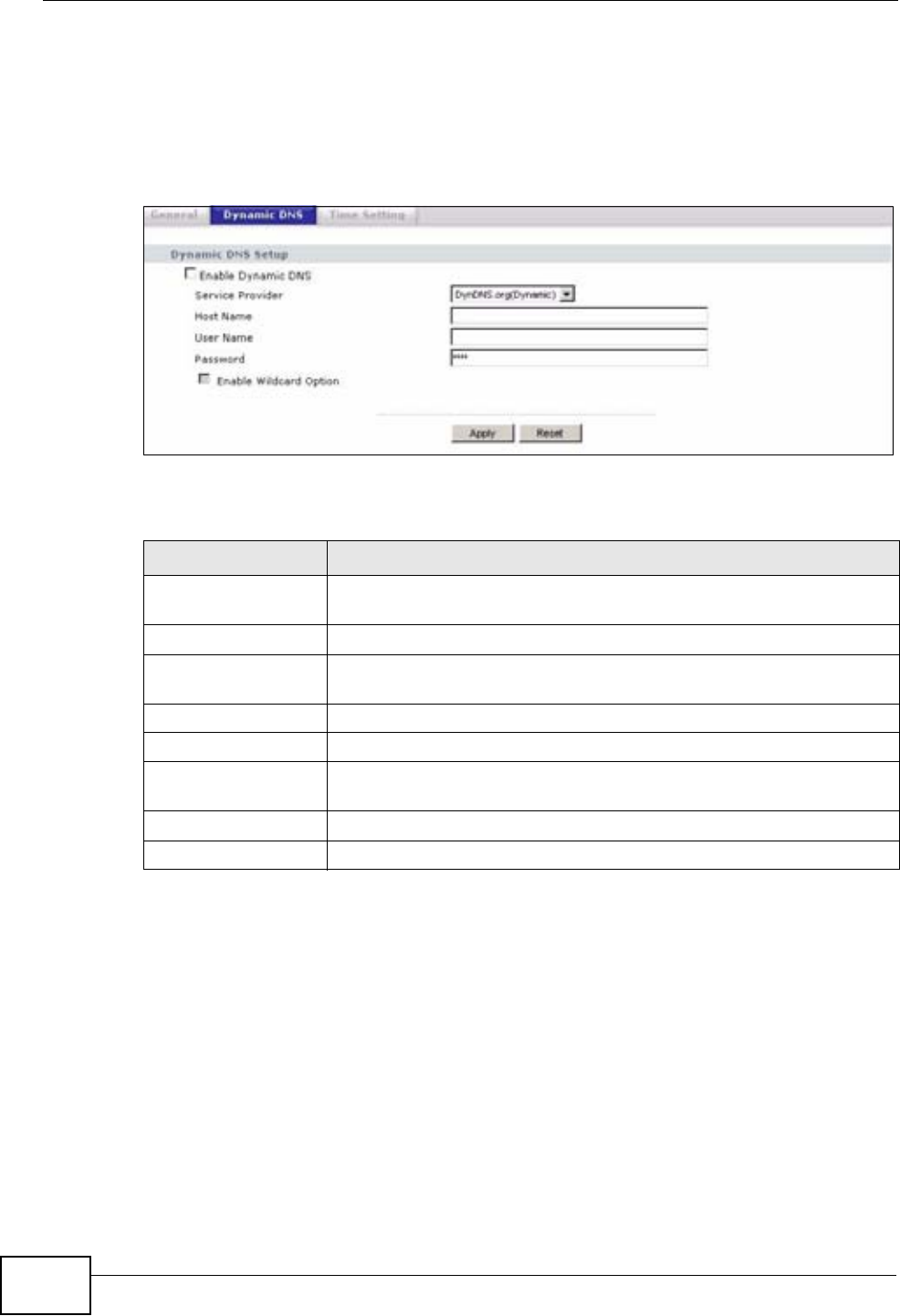
Chapter 17 System
P-320W v3 User’s Guide
160
17.5 Dynamic DNS Screen
To change your P-320W v3’s DDNS settings, click Network > DDNS. The screen
appears as shown.
Figure 100 Dynamic DNS
The following table describes the labels in this screen.
Table 60 Dynamic DNS
LABEL DESCRIPTION
Enable Dynamic
DNS
Select this check box to use dynamic DNS.
Service Provider Select the name of your Dynamic DNS service provider.
Host Name Enter a host names in the field provided. You can specify up to two
host names in the field separated by a comma (",").
User Name Enter your user name.
Password Enter the password assigned to you.
Enable Wildcard
Option
Select the check box to enable DynDNS Wildcard.
Apply Click Apply to save your changes back to the P-320W v3.
Reset Click Reset to begin configuring this screen afresh.
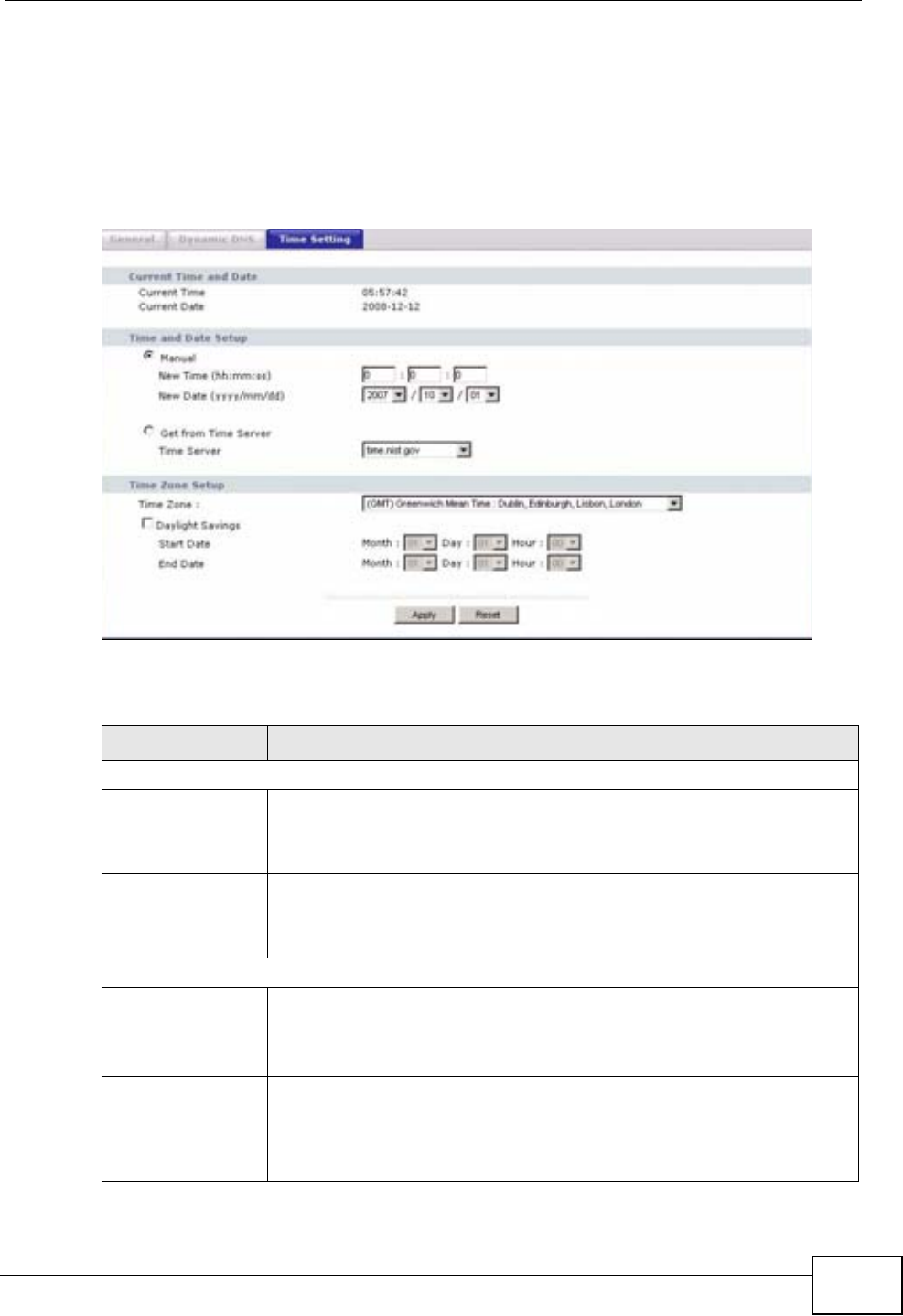
Chapter 17 System
P-320W v3 User’s Guide 161
17.6 Time Setting Screen
To change your P-320W v3’s time and date, click Maintenance > System >
Time Setting. The screen appears as shown. Use this screen to configure the P-
320W v3’s time based on your local time zone.
Figure 101 Maintenance > System > Time Setting
The following table describes the labels in this screen.
Table 61 Maintenance > System > Time Setting
LABEL DESCRIPTION
Current Time and Date
Current Time This field displays the time of your P-320W v3.
Each time you reload this page, the P-320W v3 synchronizes the time
with the time server.
Current Date This field displays the date of your P-320W v3.
Each time you reload this page, the P-320W v3 synchronizes the date
with the time server.
Time and Date Setup
Manual Select this radio button to enter the time and date manually. If you
configure a new time and date, Time Zone and Daylight Saving at the
same time, the new time and date you entered has priority and the
Time Zone and Daylight Saving settings do not affect it.
New Time
(hh:mm:ss)
This field displays the last updated time from the time server or the
last time configured manually.
When you set Time and Date Setup to Manual, enter the new time
in this field and then click Apply.

Chapter 17 System
P-320W v3 User’s Guide
162
New Date
(yyyy/mm/dd)
This field displays the last updated date from the time server or the
last date configured manually.
When you set Time and Date Setup to Manual, enter the new date
in this field and then click Apply.
Get from Time
Server
Select this radio button to have the P-320W v3 get the time and date
from the time server you specified below.
Time Zone Setup
Time Zone Choose the time zone of your location. This will set the time
difference between your time zone and Greenwich Mean Time (GMT).
Daylight Savings Daylight saving is a period from late spring to early fall when many
countries set their clocks ahead of normal local time by one hour to
give more daytime light in the evening.
Select this option if you use Daylight Saving Time.
Start Date Configure the day and time when Daylight Saving Time starts if you
selected Daylight Savings. The o'clock field uses the 24 hour
format. Here are a couple of examples:
Daylight Saving Time starts in most parts of the United States on the
first Sunday of April. Each time zone in the United States starts using
Daylight Saving Time at 2 A.M. local time. So in the United States you
would select First,Sunday,April and type 2 in the o'clock field.
Daylight Saving Time starts in the European Union on the last Sunday
of March. All of the time zones in the European Union start using
Daylight Saving Time at the same moment (1 A.M. GMT or UTC). So
in the European Union you would select Last,Sunday,March. The
time you type in the o'clock field depends on your time zone. In
Germany for instance, you would type 2 because Germany's time
zone is one hour ahead of GMT or UTC (GMT+1).
End Date Configure the day and time when Daylight Saving Time ends if you
selected Daylight Savings. The o'clock field uses the 24 hour
format. Here are a couple of examples:
Daylight Saving Time ends in the United States on the last Sunday of
October. Each time zone in the United States stops using Daylight
Saving Time at 2 A.M. local time. So in the United States you would
select Last,Sunday,October and type 2 in the o'clock field.
Daylight Saving Time ends in the European Union on the last Sunday
of October. All of the time zones in the European Union stop using
Daylight Saving Time at the same moment (1 A.M. GMT or UTC). So
in the European Union you would select Last,Sunday,October. The
time you type in the o'clock field depends on your time zone. In
Germany for instance, you would type 2 because Germany's time
zone is one hour ahead of GMT or UTC (GMT+1).
Apply Click Apply to save your changes back to the P-320W v3.
Reset Click Reset to begin configuring this screen afresh.
Table 61 Maintenance > System > Time Setting
LABEL DESCRIPTION

P-320W v3 User’s Guide 163
CHAPTER 18
Logs
18.1 Overview
This chapter contains information about configuring general log settings and
viewing the P-320W v3’s logs.
Refer to the appendices for example log message explanations.
18.2 What You Can Do
•Use the View Log screen (Section 18.4 on page 164) to look at all of the P-
320W v3’s logs in one location.
•Use the Log Settings screen (Section 18.5 on page 165) to configure to where
the P-320W v3 is to send logs and which logs and/or immediate alerts the P-
320W v3 to send.
18.3 What You Need to Know
An alert is a type of log that warrants more serious attention. They include system
errors, attacks (access control) and attempted access to blocked web sites or web
sites with restricted web features such as cookies, active X and so on. Some
categories such as System Errors consist of both logs and alerts. You may
differentiate them by their color in the View Log screen (Section 18.4 on page
164). Alerts display in red and logs display in black.
Alerts are e-mailed as soon as they happen. Logs may be e-mailed as soon as the
log is full (see Log Schedule). Selecting many alert and/or log categories
(especially Access Control) may result in many e-mails being sent.
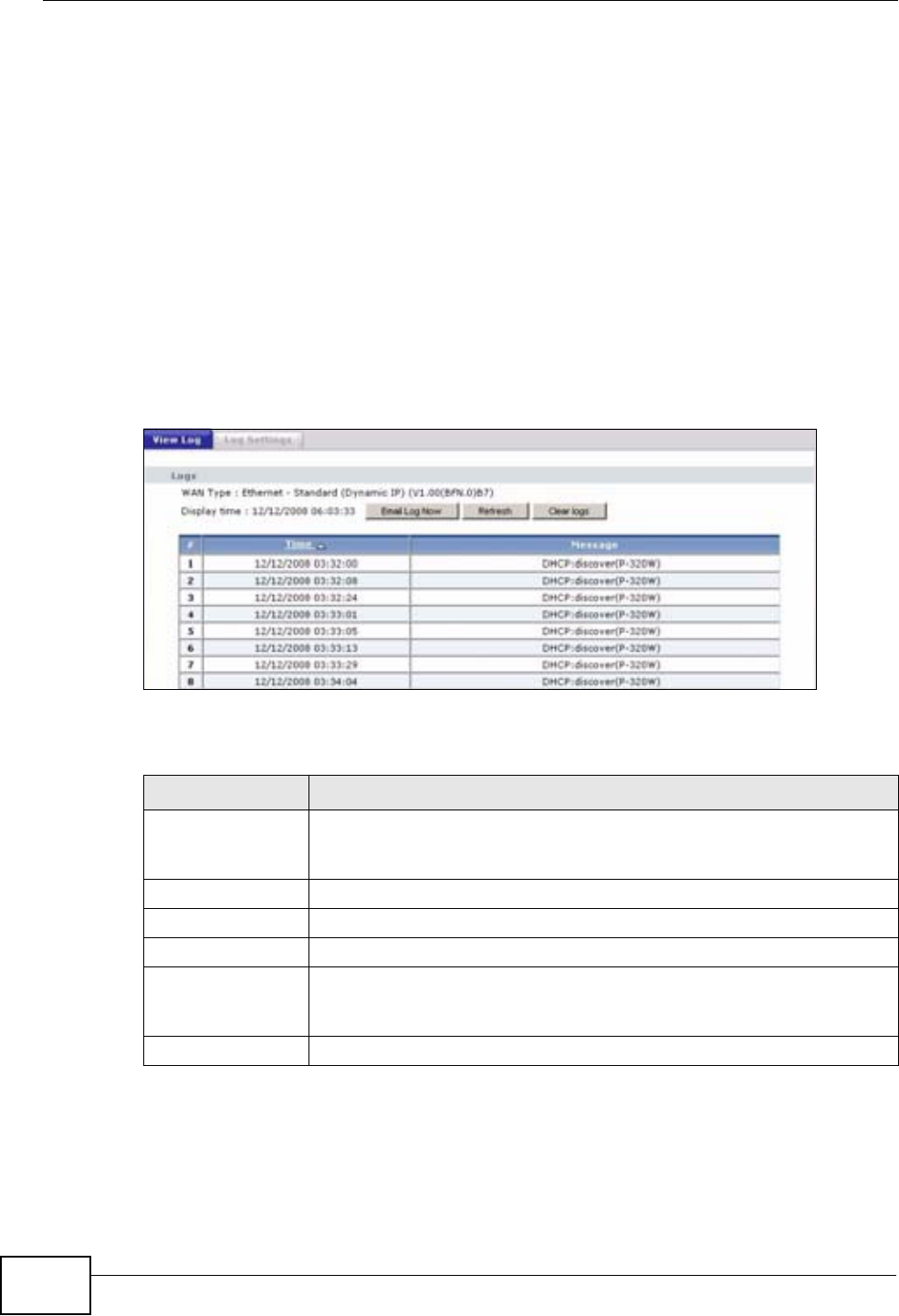
Chapter 18 Logs
P-320W v3 User’s Guide
164
18.4 View Log Screen
Use the View Log screen to see the logs for the categories that you selected in
the Log Settings screen (see Section 18.5 on page 165). Options include logs
about system maintenance, system errors, access control, allowed or blocked web
sites, blocked web features (such as ActiveX controls, Java and cookies), attacks
(such as DoS) and IPSec.
Log entries in red indicate system error logs. The log wraps around and deletes
the old entries after it fills. Click a column heading to sort the entries. A triangle
indicates ascending or descending sort order.
Click Maintenance > Logs to open the View Log screen.
Figure 102 Maintenance > Logs > View Log
The following table describes the labels in this screen.
Table 62 Maintenance > Logs > View Log
LABEL DESCRIPTION
Email Log Now Click Email Log Now to send the log screen to the e-mail address
specified in the Log Settings page (make sure that you have first
filled in the Address Info fields in Log Settings).
Refresh Click Refresh to renew the log screen.
Clear logs Click Clear Log to delete all the logs.
#Number of an individual log.
Time This field displays the time the log was recorded. See the chapter on
system maintenance and information to configure the P-320W v3’s
time and date.
Message This field states the reason for the log.
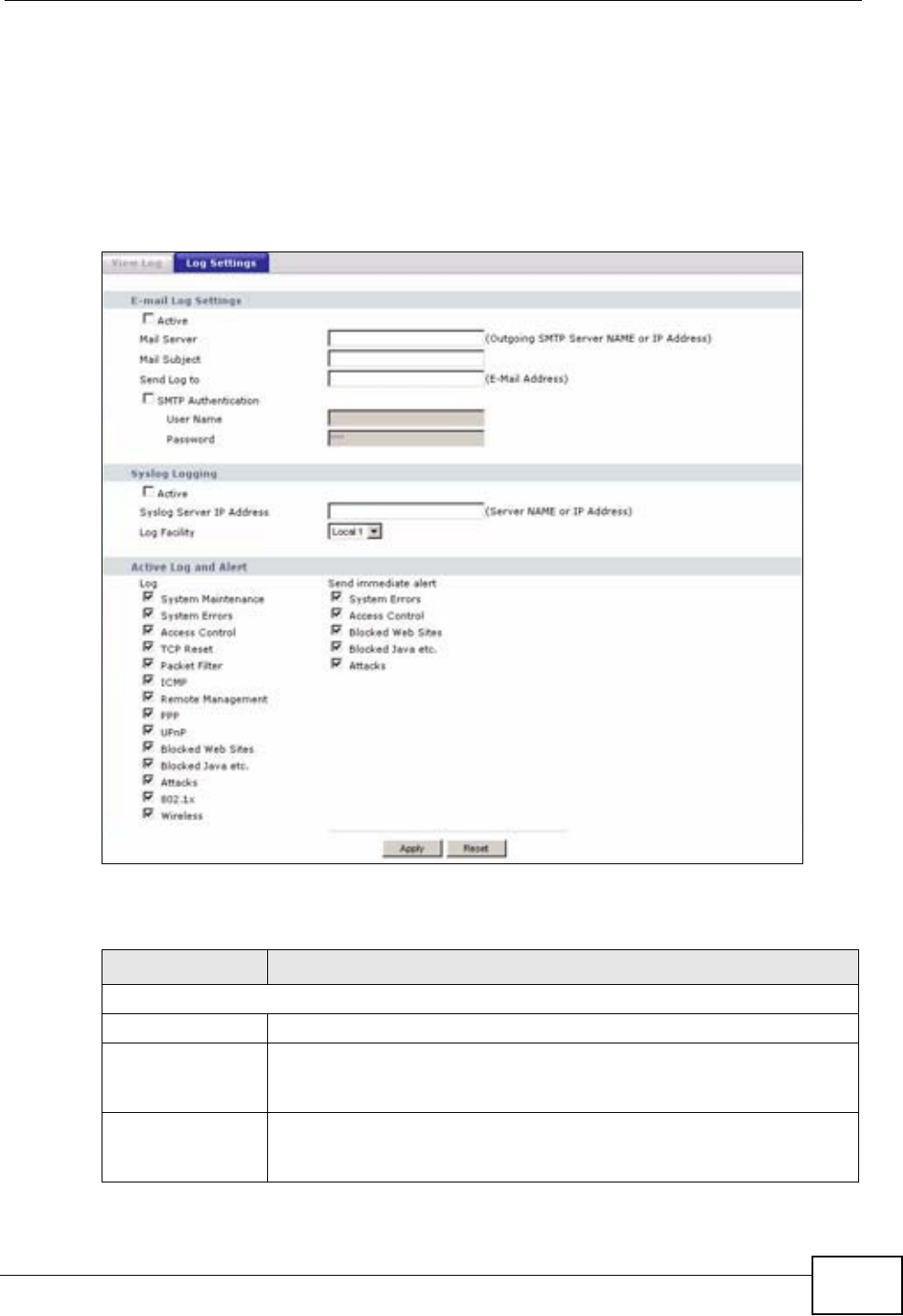
Chapter 18 Logs
P-320W v3 User’s Guide 165
18.5 Log Settings Screen
Use this screen to configure to where the P-320W v3 is to send logs and which
logs and/or immediate alerts the P-320W v3 to send.
Click Maintenance > Logs > Log Settings to open the Log Settings screen.
Figure 103 Maintenance > Logs > Log Settings
The following table describes the labels in this screen.
Table 63 Maintenance > Logs > Log Settings
LABEL DESCRIPTION
E-mail Log Settings
Active Click Active to enable the log feature.
Mail Server Enter the server name or the IP address of the mail server for the e-
mail addresses specified below. If this field is left blank, logs and alert
messages will not be sent via E-mail.
Mail Subject Type a title that you want to be in the subject line of the log e-mail
message that the P-320W v3 sends. Not all P-320W v3 models have
this field.
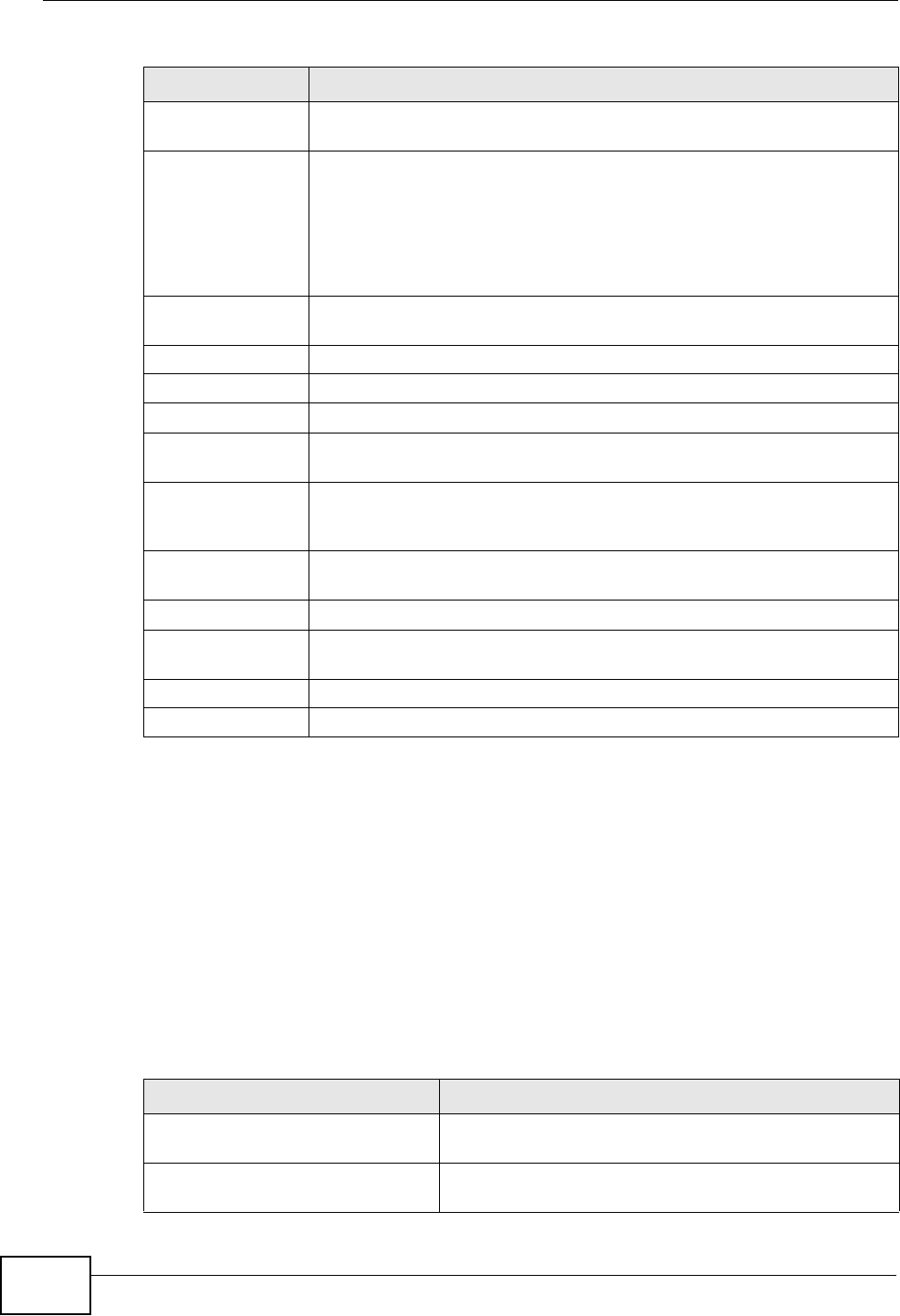
Chapter 18 Logs
P-320W v3 User’s Guide
166
18.6 Technical Reference
This section provides some technical information about the topics covered in this
chapter.
18.6.1 Log Descriptions
This section provides descriptions of example log messages.
Send Log To The P-320W v3 sends logs to the e-mail address specified in this field.
If this field is left blank, the P-320W v3 does not send logs via e-mail.
SMTP
Authentication
SMTP (Simple Mail Transfer Protocol) is the message-exchange
standard for the Internet. SMTP enables you to move messages from
one e-mail server to another.
Select the check box to activate SMTP authentication. If mail server
authentication is needed but this feature is disabled, you will not
receive the e-mail logs.
User Name Enter the user name (up to 31 characters) (usually the user name of
a mail account).
Password Enter the password associated with the user name above.
Syslog Logging The P-320W v3 sends a log to an external syslog server.
Active Click Active to enable syslog logging.
Syslog Server IP
Address
Enter the server name or IP address of the syslog server that will log
the selected categories of logs.
Log Facility Select a location from the drop down list box. The log facility allows
you to log the messages to different files in the syslog server. Refer to
the syslog server manual for more information.
Active Log and
Alert
Log Select the categories of logs that you want to record.
Send Immediate
Alert
Select log categories for which you want the P-320W v3 to send E-
mail alerts immediately.
Apply Click Apply to save your changes.
Reset Click Reset to begin configuring this screen afresh.
Table 63 Maintenance > Logs > Log Settings
LABEL DESCRIPTION
Table 64 System Maintenance Logs
LOG MESSAGE DESCRIPTION
Time calibration is
successful
The router has adjusted its time based on information
from the time server.
Time calibration failed The router failed to get information from the time
server.

Chapter 18 Logs
P-320W v3 User’s Guide 167
WAN interface gets IP:%s A WAN interface got a new IP address from the DHCP,
PPPoE, PPTP or dial-up server.
DHCP client IP expired A DHCP client's IP address has expired.
DHCP server assigns%s The DHCP server assigned an IP address to a client.
Successful WEB login Someone has logged on to the router's web
configurator interface.
WEB login failed Someone has failed to log on to the router's web
configurator interface.
Successful TELNET login Someone has logged on to the router via telnet.
TELNET login failed Someone has failed to log on to the router via telnet.
Successful FTP login Someone has logged on to the router via ftp.
FTP login failed Someone has failed to log on to the router via ftp.
NAT Session Table is Full! The maximum number of NAT session table entries
has been exceeded and the table is full.
Starting Connectivity
Monitor
Starting Connectivity Monitor.
Time initialized by Daytime
Server
The router got the time and date from the Daytime
server.
Time initialized by Time
server
The router got the time and date from the time
server.
Time initialized by NTP
server
The router got the time and date from the NTP server.
Connect to Daytime server
fail
The router was not able to connect to the Daytime
server.
Connect to Time server fail The router was not able to connect to the Time server.
Connect to NTP server fail The router was not able to connect to the NTP server.
Too large ICMP packet has
been dropped
The router dropped an ICMP packet that was too
large.
Configuration Change: PC =
0x%x, Task ID = 0x%x
The router is saving configuration changes.
Successful SSH login Someone has logged on to the router’s SSH server.
SSH login failed Someone has failed to log on to the router’s SSH
server.
Successful HTTPS login Someone has logged on to the router's web
configurator interface using HTTPS protocol.
HTTPS login failed Someone has failed to log on to the router's web
configurator interface using HTTPS protocol.
Table 64 System Maintenance Logs (continued)
LOG MESSAGE DESCRIPTION

Chapter 18 Logs
P-320W v3 User’s Guide
168
Table 65 System Error Logs
LOG MESSAGE DESCRIPTION
%s exceeds the max.
number of session per
host!
This attempt to create a NAT session exceeds the
maximum number of NAT session table entries allowed to
be created per host.
setNetBIOSFilter: calloc
error
The router failed to allocate memory for the NetBIOS
filter settings.
readNetBIOSFilter: calloc
error
The router failed to allocate memory for the NetBIOS
filter settings.
WAN connection is down. A WAN connection is down. You cannot access the
network through this interface.
Table 66 Access Control Logs
LOG MESSAGE DESCRIPTION
Firewall default policy: [TCP |
UDP | IGMP | ESP | GRE | OSPF]
<Packet Direction>
Attempted TCP/UDP/IGMP/ESP/GRE/OSPF access
matched the default policy and was blocked or
forwarded according to the default policy’s
setting.
Firewall rule [NOT] match:[TCP |
UDP | IGMP | ESP | GRE | OSPF]
<Packet Direction>, <rule:%d>
Attempted TCP/UDP/IGMP/ESP/GRE/OSPF access
matched (or did not match) a configured firewall
rule (denoted by its number) and was blocked or
forwarded according to the rule.
Triangle route packet forwarded:
[TCP | UDP | IGMP | ESP | GRE |
OSPF]
The firewall allowed a triangle route session to
pass through.
Packet without a NAT table entry
blocked: [TCP | UDP | IGMP | ESP
| GRE | OSPF]
The router blocked a packet that didn't have a
corresponding NAT table entry.
Router sent blocked web site
message: TCP
The router sent a message to notify a user that
the router blocked access to a web site that the
user requested.
Table 67 TCP Reset Logs
LOG MESSAGE DESCRIPTION
Under SYN flood attack,
sent TCP RST
The router sent a TCP reset packet when a host was
under a SYN flood attack (the TCP incomplete count is per
destination host.)
Exceed TCP MAX
incomplete, sent TCP RST
The router sent a TCP reset packet when the number of
TCP incomplete connections exceeded the user configured
threshold. (the TCP incomplete count is per destination
host.) Note: Refer to TCP Maximum Incomplete in the
Firewall Attack Alerts screen.

Chapter 18 Logs
P-320W v3 User’s Guide 169
Peer TCP state out of
order, sent TCP RST
The router sent a TCP reset packet when a TCP
connection state was out of order.Note: The firewall refers
to RFC793 Figure 6 to check the TCP state.
Firewall session time
out, sent TCP RST
The router sent a TCP reset packet when a dynamic
firewall session timed out.
The default timeout values are as follows:
ICMP idle timeout: 3 minutes
UDP idle timeout: 3 minutes
TCP connection (three way handshaking) timeout: 270
seconds
TCP FIN-wait timeout: 2 MSL (Maximum Segment
Lifetime set in the TCP header).
TCP idle (established) timeout (s): 150 minutes
TCP reset timeout: 10 seconds
Exceed MAX incomplete,
sent TCP RST
The router sent a TCP reset packet when the number of
incomplete connections (TCP and UDP) exceeded the
user-configured threshold. (Incomplete count is for all
TCP and UDP connections through the firewall.)Note:
When the number of incomplete connections (TCP + UDP)
> “Maximum Incomplete High”, the router sends TCP RST
packets for TCP connections and destroys TOS (firewall
dynamic sessions) until incomplete connections <
“Maximum Incomplete Low”.
Access block, sent TCP
RST
The router sends a TCP RST packet and generates this log
if you turn on the firewall TCP reset mechanism (via CI
command: "sys firewall tcprst").
Table 68 Packet Filter Logs
LOG MESSAGE DESCRIPTION
[TCP | UDP | ICMP | IGMP |
Generic] packet filter
matched (set:%d, rule:%d)
Attempted access matched a configured filter rule
(denoted by its set and rule number) and was blocked
or forwarded according to the rule.
Table 67 TCP Reset Logs (continued)
LOG MESSAGE DESCRIPTION

Chapter 18 Logs
P-320W v3 User’s Guide
170
Table 69 ICMP Logs
LOG MESSAGE DESCRIPTION
Firewall default policy: ICMP
<Packet Direction>, <type:%d>,
<code:%d>
ICMP access matched the default policy and was
blocked or forwarded according to the user's
setting. For type and code details, see Ta bl e 78 o n
page 175.
Firewall rule [NOT] match: ICMP
<Packet Direction>, <rule:%d>,
<type:%d>, <code:%d>
ICMP access matched (or didn’t match) a firewall
rule (denoted by its number) and was blocked or
forwarded according to the rule. For type and
code details, see Table 78 on page 175.
Triangle route packet forwarded:
ICMP
The firewall allowed a triangle route session to
pass through.
Packet without a NAT table entry
blocked: ICMP
The router blocked a packet that didn’t have a
corresponding NAT table entry.
Unsupported/out-of-order ICMP:
ICMP
The firewall does not support this kind of ICMP
packets or the ICMP packets are out of order.
Router reply ICMP packet: ICMP The router sent an ICMP reply packet to the
sender.
Table 70 CDR Logs
LOG MESSAGE DESCRIPTION
board%d line%d channel%d,
call%d,%s C01 Outgoing Call
dev=%x ch=%x%s
The router received the setup requirements for a call.
“call” is the reference (count) number of the call.
“dev” is the device type (3 is for dial-up, 6 is for
PPPoE, 10 is for PPTP). "channel" or “ch” is the call
channel ID.For example,"board 0 line 0 channel 0, call
3, C01 Outgoing Call dev=6 ch=0 "Means the router
has dialed to the PPPoE server 3 times.
board%d line%d channel%d,
call%d,%s C02 OutCall
Connected%d%s
The PPPoE, PPTP or dial-up call is connected.
board%d line%d channel%d,
call%d,%s C02 Call
Terminated
The PPPoE, PPTP or dial-up call was disconnected.
Table 71 PPP Logs
LOG MESSAGE DESCRIPTION
ppp:LCP Starting The PPP connection’s Link Control Protocol stage has started.
ppp:LCP Opening The PPP connection’s Link Control Protocol stage is opening.
ppp:CHAP Opening The PPP connection’s Challenge Handshake Authentication Protocol
stage is opening.
ppp:IPCP
Starting
The PPP connection’s Internet Protocol Control Protocol stage is
starting.

Chapter 18 Logs
P-320W v3 User’s Guide 171
ppp:IPCP Opening The PPP connection’s Internet Protocol Control Protocol stage is
opening.
ppp:LCP Closing The PPP connection’s Link Control Protocol stage is closing.
ppp:IPCP Closing The PPP connection’s Internet Protocol Control Protocol stage is
closing.
Table 72 UPnP Logs
LOG MESSAGE DESCRIPTION
UPnP pass through Firewall UPnP packets can pass through the firewall.
Table 73 Content Filtering Logs
LOG MESSAGE DESCRIPTION
%s: Keyword blocking The content of a requested web page matched a user defined
keyword.
%s: Not in trusted web
list
The web site is not in a trusted domain, and the router blocks
all traffic except trusted domain sites.
%s: Forbidden Web site The web site is in the forbidden web site list.
%s: Contains ActiveX The web site contains ActiveX.
%s: Contains Java
applet
The web site contains a Java applet.
%s: Contains cookie The web site contains a cookie.
%s: Proxy mode
detected
The router detected proxy mode in the packet.
%s The content filter server responded that the web site is in the
blocked category list, but it did not return the category type.
%s:%s The content filter server responded that the web site is in the
blocked category list, and returned the category type.
%s(cache hit) The system detected that the web site is in the blocked list
from the local cache, but does not know the category type.
%s:%s(cache hit) The system detected that the web site is in blocked list from
the local cache, and knows the category type.
%s: Trusted Web site The web site is in a trusted domain.
%s When the content filter is not on according to the time
schedule or you didn't select the "Block Matched Web Site”
check box, the system forwards the web content.
Waiting content filter
server timeout
The external content filtering server did not respond within
the timeout period.
DNS resolving failed The P-320W v3 cannot get the IP address of the external
content filtering via DNS query.
Creating socket failed The P-320W v3 cannot issue a query because TCP/IP socket
creation failed, port:port number.
Table 71 PPP Logs (continued)
LOG MESSAGE DESCRIPTION
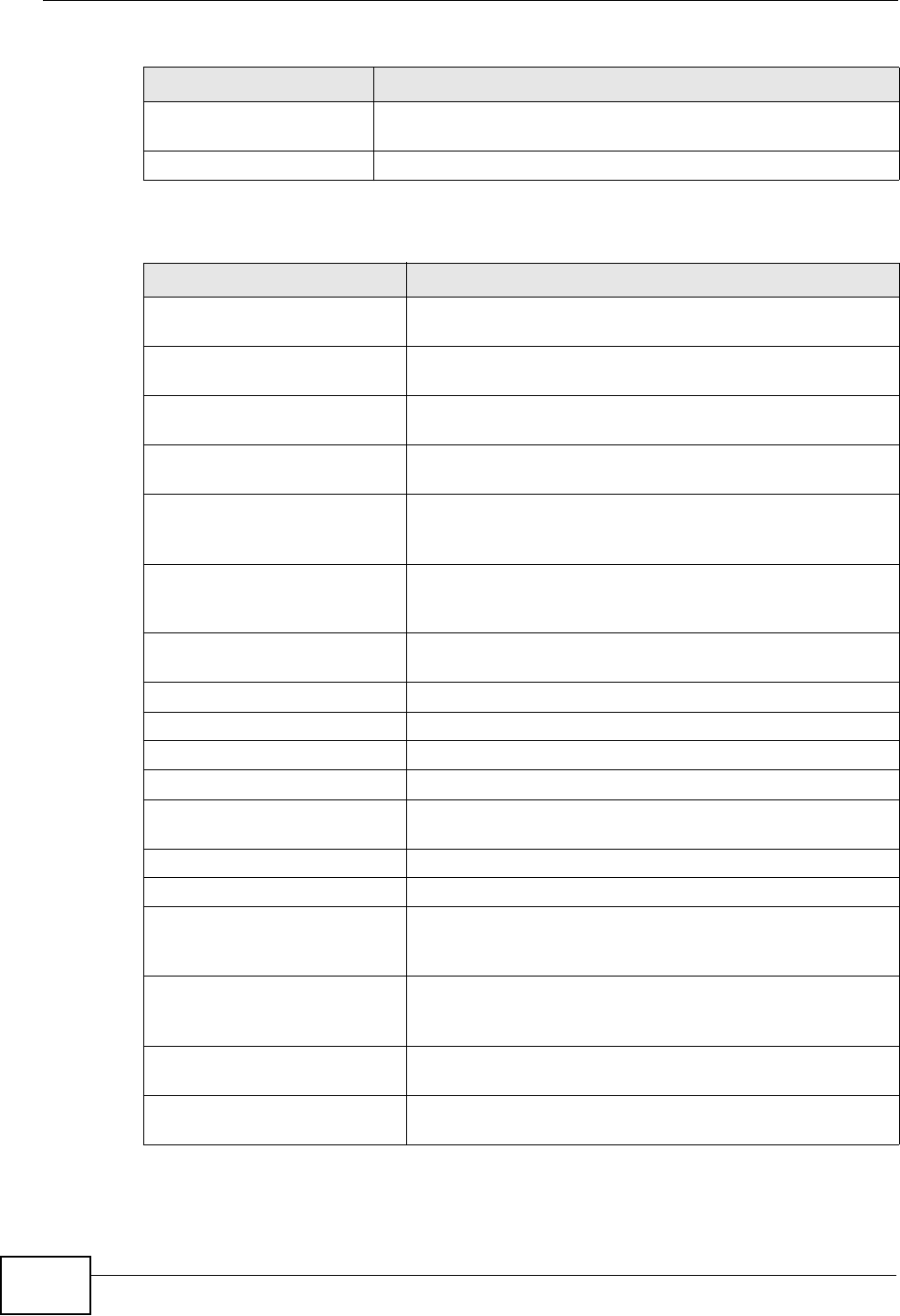
Chapter 18 Logs
P-320W v3 User’s Guide
172
Connecting to content
filter server fail
The connection to the external content filtering server failed.
License key is invalid The external content filtering license key is invalid.
Table 74 Attack Logs
LOG MESSAGE DESCRIPTION
attack [TCP | UDP | IGMP
| ESP | GRE | OSPF]
The firewall detected a TCP/UDP/IGMP/ESP/GRE/OSPF
attack.
attack ICMP (type:%d,
code:%d)
The firewall detected an ICMP attack. For type and code
details, see Table 78 on page 175.
land [TCP | UDP | IGMP |
ESP | GRE | OSPF]
The firewall detected a TCP/UDP/IGMP/ESP/GRE/OSPF
land attack.
land ICMP (type:%d,
code:%d)
The firewall detected an ICMP land attack. For type and
code details, see Table 78 on page 175.
ip spoofing - WAN [TCP |
UDP | IGMP | ESP | GRE |
OSPF]
The firewall detected an IP spoofing attack on the WAN
port.
ip spoofing - WAN ICMP
(type:%d, code:%d)
The firewall detected an ICMP IP spoofing attack on the
WAN port. For type and code details, see Table 78 on
page 175.
icmp echo: ICMP (type:%d,
code:%d)
The firewall detected an ICMP echo attack. For type and
code details, see Table 78 on page 175.
syn flood TCP The firewall detected a TCP syn flood attack.
ports scan TCP The firewall detected a TCP port scan attack.
teardrop TCP The firewall detected a TCP teardrop attack.
teardrop UDP The firewall detected an UDP teardrop attack.
teardrop ICMP (type:%d,
code:%d)
The firewall detected an ICMP teardrop attack. For type
and code details, see Table 78 on page 175.
illegal command TCP The firewall detected a TCP illegal command attack.
NetBIOS TCP The firewall detected a TCP NetBIOS attack.
ip spoofing - no routing
entry [TCP | UDP | IGMP |
ESP | GRE | OSPF]
The firewall classified a packet with no source routing
entry as an IP spoofing attack.
ip spoofing - no routing
entry ICMP (type:%d,
code:%d)
The firewall classified an ICMP packet with no source
routing entry as an IP spoofing attack.
vulnerability ICMP
(type:%d, code:%d)
The firewall detected an ICMP vulnerability attack. For
type and code details, see Table 78 on page 175.
traceroute ICMP (type:%d,
code:%d)
The firewall detected an ICMP traceroute attack. For type
and code details, see Table 78 on page 175.
Table 73 Content Filtering Logs (continued)
LOG MESSAGE DESCRIPTION

Chapter 18 Logs
P-320W v3 User’s Guide 173
Table 75 PKI Logs
LOG MESSAGE DESCRIPTION
Enrollment successful The SCEP online certificate enrollment was successful. The
Destination field records the certification authority server IP
address and port.
Enrollment failed The SCEP online certificate enrollment failed. The Destination
field records the certification authority server’s IP address and
port.
Failed to resolve
<SCEP CA server url>
The SCEP online certificate enrollment failed because the
certification authority server’s address cannot be resolved.
Enrollment successful The CMP online certificate enrollment was successful. The
Destination field records the certification authority server’s IP
address and port.
Enrollment failed The CMP online certificate enrollment failed. The Destination
field records the certification authority server’s IP address and
port.
Failed to resolve <CMP
CA server url>
The CMP online certificate enrollment failed because the
certification authority server’s IP address cannot be resolved.
Rcvd ca cert: <subject
name>
The router received a certification authority certificate, with
subject name as recorded, from the LDAP server whose IP
address and port are recorded in the Source field.
Rcvd user cert:
<subject name>
The router received a user certificate, with subject name as
recorded, from the LDAP server whose IP address and port
are recorded in the Source field.
Rcvd CRL <size>:
<issuer name>
The router received a CRL (Certificate Revocation List), with
size and issuer name as recorded, from the LDAP server
whose IP address and port are recorded in the Source field.
Rcvd ARL <size>:
<issuer name>
The router received an ARL (Authority Revocation List), with
size and issuer name as recorded, from the LDAP server
whose address and port are recorded in the Source field.
Failed to decode the
received ca cert
The router received a corrupted certification authority
certificate from the LDAP server whose address and port are
recorded in the Source field.
Failed to decode the
received user cert
The router received a corrupted user certificate from the
LDAP server whose address and port are recorded in the
Source field.
Failed to decode the
received CRL
The router received a corrupted CRL (Certificate Revocation
List) from the LDAP server whose address and port are
recorded in the Source field.
Failed to decode the
received ARL
The router received a corrupted ARL (Authority Revocation
List) from the LDAP server whose address and port are
recorded in the Source field.
Rcvd data <size> too
large! Max size
allowed: <max size>
The router received directory data that was too large (the size
is listed) from the LDAP server whose address and port are
recorded in the Source field. The maximum size of directory
data that the router allows is also recorded.

Chapter 18 Logs
P-320W v3 User’s Guide
174
Cert trusted: <subject
name>
The router has verified the path of the certificate with the
listed subject name.
Due to <reason codes>,
cert not trusted:
<subject name>
Due to the reasons listed, the certificate with the listed
subject name has not passed the path verification. The
recorded reason codes are only approximate reasons for not
trusting the certificate. Please see Table 78 on page 175 for
the corresponding descriptions of the codes.
Table 76 802.1X Logs
LOG MESSAGE DESCRIPTION
Local User Database accepts
user.
A user was authenticated by the local user
database.
Local User Database reports user
credential error.
A user was not authenticated by the local user
database because of an incorrect user password.
Local User Database does not
find user`s credential.
A user was not authenticated by the local user
database because the user is not listed in the
local user database.
RADIUS accepts user. A user was authenticated by the RADIUS Server.
RADIUS rejects user. Pls check
RADIUS Server.
A user was not authenticated by the RADIUS
Server. Please check the RADIUS Server.
Local User Database does not
support authentication method.
The local user database only supports the EAP-
MD5 method. A user tried to use another
authentication method and was not
authenticated.
User logout because of session
timeout expired.
The router logged out a user whose session
expired.
User logout because of user
deassociation.
The router logged out a user who ended the
session.
User logout because of no
authentication response from
user.
The router logged out a user from which there
was no authentication response.
User logout because of idle
timeout expired.
The router logged out a user whose idle timeout
period expired.
User logout because of user
request.
A user logged out.
Local User Database does not
support authentication method.
A user tried to use an authentication method that
the local user database does not support (it only
supports EAP-MD5).
No response from RADIUS. Pls
check RADIUS Server.
There is no response message from the RADIUS
server, please check the RADIUS server.
Use Local User Database to
authenticate user.
The local user database is operating as the
authentication server.
Use RADIUS to authenticate user. The RADIUS server is operating as the
authentication server.
Table 75 PKI Logs (continued)
LOG MESSAGE DESCRIPTION

Chapter 18 Logs
P-320W v3 User’s Guide 175
No Server to authenticate user. There is no authentication server to authenticate
a user.
Local User Database does not
find user`s credential.
A user was not authenticated by the local user
database because the user is not listed in the
local user database.
Table 77 ACL Setting Notes
PACKET
DIRECTION DIRECTION DESCRIPTION
(L to W) LAN to WAN ACL set for packets traveling from the LAN to the
WAN.
(W to L) WAN to LAN ACL set for packets traveling from the WAN to the
LAN.
(L to L/P) LAN to LAN/P-
320W v3
ACL set for packets traveling from the LAN to the
LAN or the P-320W v3.
(W to W/P) WAN to WAN/P-
320W v3
ACL set for packets traveling from the WAN to the
WAN or the P-320W v3.
Table 78 ICMP Notes
TYPE CODE DESCRIPTION
0Echo Reply
0Echo reply message
3Destination Unreachable
0Net unreachable
1Host unreachable
2Protocol unreachable
3Port unreachable
4A packet that needed fragmentation was dropped because it was set
to Don't Fragment (DF)
5Source route failed
4Source Quench
0A gateway may discard internet datagrams if it does not have the
buffer space needed to queue the datagrams for output to the next
network on the route to the destination network.
5Redirect
0Redirect datagrams for the Network
1Redirect datagrams for the Host
2Redirect datagrams for the Type of Service and Network
3Redirect datagrams for the Type of Service and Host
Table 76 802.1X Logs (continued)
LOG MESSAGE DESCRIPTION

Chapter 18 Logs
P-320W v3 User’s Guide
176
The following table shows RFC-2408 ISAKMP payload types that the log displays.
Please refer to the RFC for detailed information on each type.
8Echo
0Echo message
11 Time Exceeded
0Time to live exceeded in transit
1Fragment reassembly time exceeded
12 Parameter Problem
0Pointer indicates the error
13 Timestamp
0Timestamp request message
14 Timestamp Reply
0Timestamp reply message
15 Information Request
0Information request message
16 Information Reply
0Information reply message
Table 79 Syslog Logs
LOG MESSAGE DESCRIPTION
<Facility*8 + Severity>Mon dd
hr:mm:ss hostname
src="<srcIP:srcPort>"
dst="<dstIP:dstPort>"
msg="<msg>" note="<note>"
devID="<mac address last three
numbers>" cat="<category>
"This message is sent by the system ("RAS"
displays as the system name if you haven’t
configured one) when the router generates a
syslog. The facility is defined in the web MAIN
MENU->LOGS->Log Settings page. The severity is
the log’s syslog class. The definition of messages
and notes are defined in the various log charts
throughout this appendix. The “devID” is the last
three characters of the MAC address of the router’s
LAN port. The “cat” is the same as the category in
the router’s logs.
Table 80 RFC-2408 ISAKMP Payload Types
LOG DISPLAY PAYLOAD TYPE
SA Security Association
PROP Proposal
TRANS Transform
KE Key Exchange
ID Identification
CER Certificate
Table 78 ICMP Notes (continued)
TYPE CODE DESCRIPTION

Chapter 18 Logs
P-320W v3 User’s Guide 177
CER_REQ Certificate Request
HASH Hash
SIG Signature
NONCE Nonce
NOTFY Notification
DEL Delete
VID Vendor ID
Table 80 RFC-2408 ISAKMP Payload Types (continued)
LOG DISPLAY PAYLOAD TYPE

Chapter 18 Logs
P-320W v3 User’s Guide
178

P-320W v3 User’s Guide 179
CHAPTER 19
Tools
19.1 Overview
This chapter shows you how to upload a new firmware, upload or save backup
configuration files and restart the P-320W v3.
19.2 What You Can Do
•Use the Firmware screen (Section 19.3 on page 179) to upload a new firmware
to your P-320W v3.
•Use the Configuration screen (Section 19.4 on page 181) to backup or restore
a configuration file to your P-320W v3. You can also reset the P-320W v3 to its
factory default settings.
•Use the Restart screen (Section 19.5 on page 183) to reboot your P-320W v3.
19.3 Firmware Upload Screen
Find firmware at www.zyxel.com in a file that (usually) uses the system model
name with a “*.bin” extension, e.g., “P-320W v3.bin”. The upload process uses
HTTP (Hypertext Transfer Protocol) and may take up to two minutes. After a
successful upload, the system will reboot. See the Firmware and Configuration File
Maintenance chapter for upgrading firmware using FTP/TFTP commands.
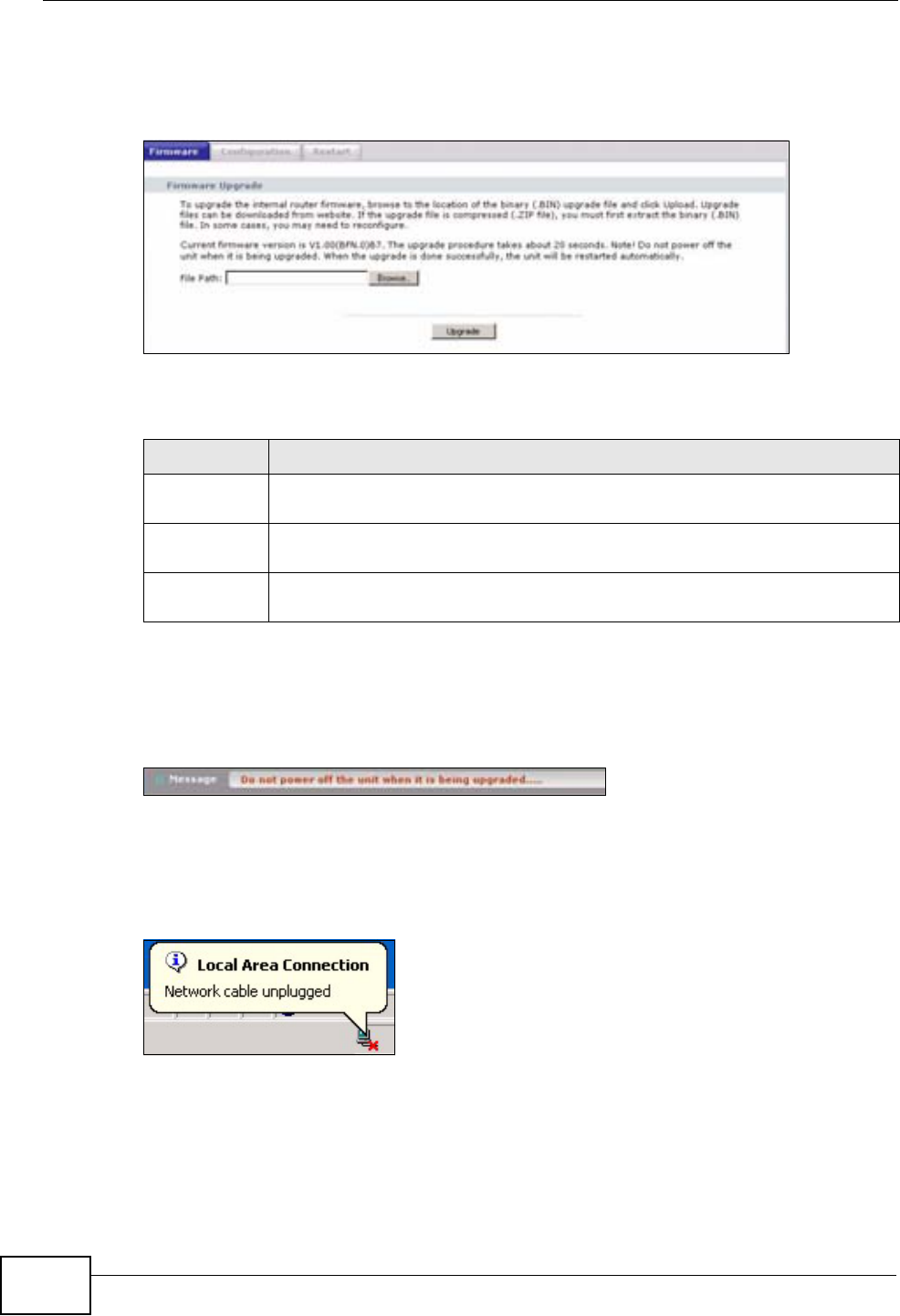
Chapter 19 Tools
P-320W v3 User’s Guide
180
Click Maintenance > Tools. Follow the instructions in this screen to upload
firmware to your P-320W v3.
Figure 104 Maintenance > Tools > Firmware
The following table describes the labels in this screen.
Note: Do not turn off the P-320W v3 while firmware upload is in progress!
Wait two minutes before logging into the P-320W v3 again.
Figure 105 Upload Warning
The P-320W v3 automatically restarts in this time causing a temporary network
disconnect. In some operating systems, you may see the following icon on your
desktop.
Figure 106 Network Temporarily Disconnected
After two minutes, log in again and check your new firmware version in the
Status screen.
Table 81 Maintenance > Tools > Firmware
LABEL DESCRIPTION
File Path Type in the location of the file you want to upload in this field or click
Browse... to find it.
Browse... Click Browse... to find the .bin file you want to upload. Remember that
you must decompress compressed (.zip) files before you can upload them.
Upgrade Click Upload to begin the upload process. This process may take up to
two minutes.
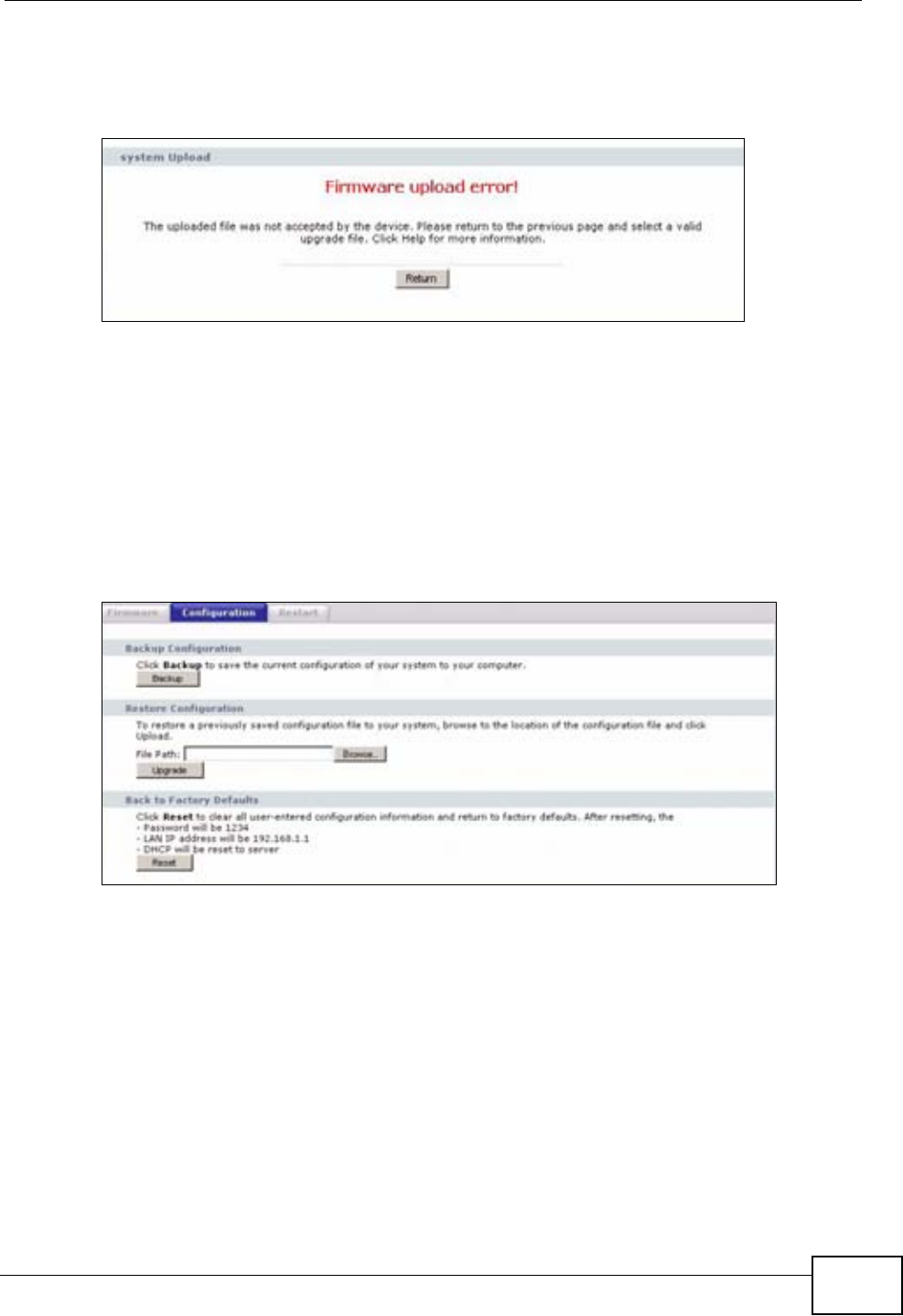
Chapter 19 Tools
P-320W v3 User’s Guide 181
If the upload was not successful, the following screen will appear. Click Return to
go back to the Firmware screen.
Figure 107 Upload Error Message
19.4 Configuration Screen
Information related to factory defaults, backup configuration, and restoring
configuration appears as shown next.
Click Maintenance > Tools > Configuration.
Figure 108 Maintenance > Tools > Configuration
19.4.1 Backup Configuration
Backup configuration allows you to back up (save) the P-320W v3’s current
configuration to a file on your computer. Once your P-320W v3 is configured and
functioning properly, it is highly recommended that you back up your configuration
file before making configuration changes. The backup configuration file will be
useful in case you need to return to your previous settings.
Click Backup to save the P-320W v3’s current configuration to your computer.
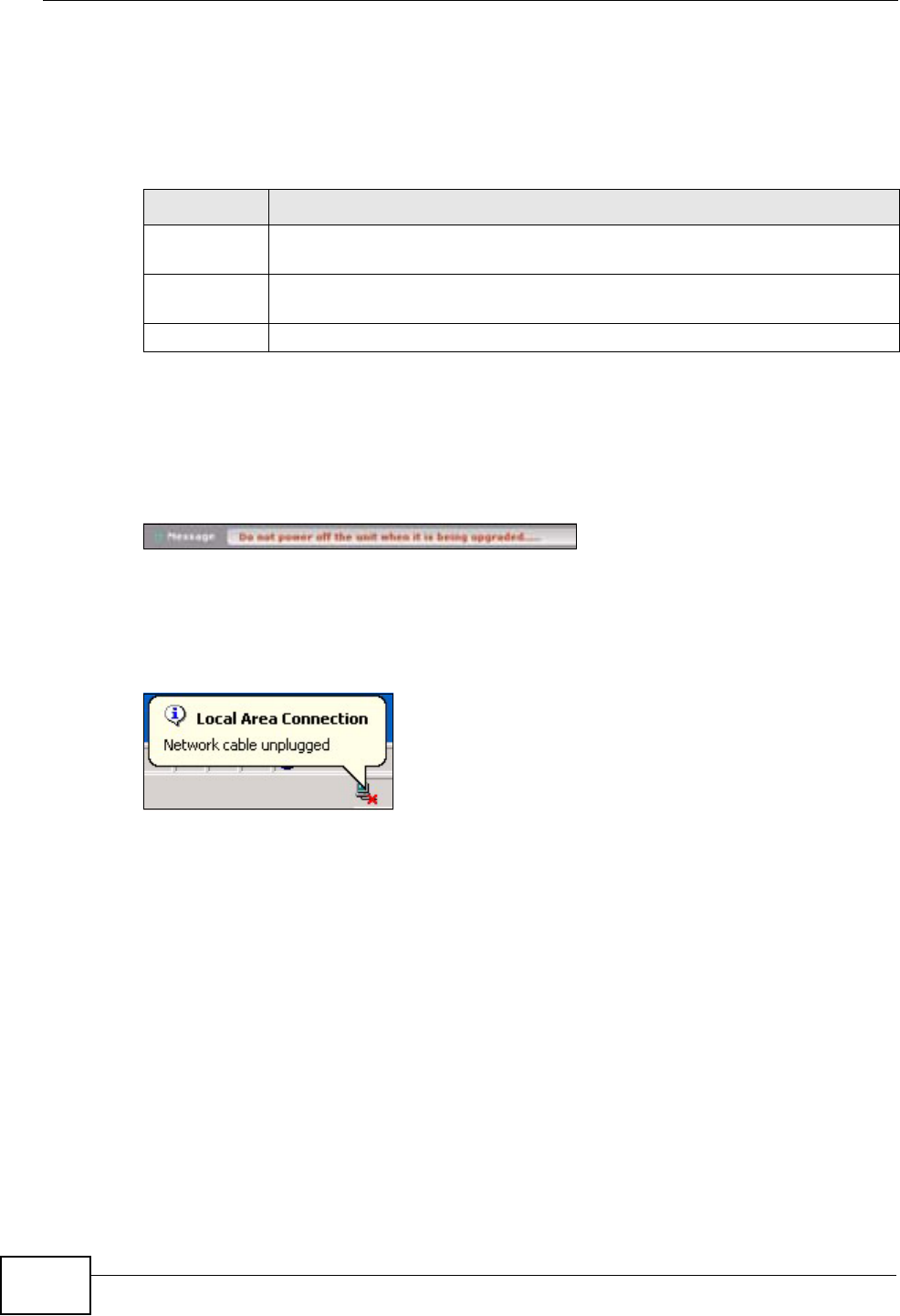
Chapter 19 Tools
P-320W v3 User’s Guide
182
19.4.2 Restore Configuration
Restore configuration allows you to upload a new or previously saved
configuration file from your computer to your P-320W v3.
Note: Do not turn off the P-320W v3 while configuration file upload is in progress
After you see the following message in the screen, you must then wait one minute
before logging into the P-320W v3 again.
Figure 109 Configuration Restore Successful
The P-320W v3 automatically restarts in this time causing a temporary network
disconnect. In some operating systems, you may see the following icon on your
desktop.
Figure 110 Temporarily Disconnected
If you uploaded the default configuration file you may need to change the IP
address of your computer to be in the same subnet as that of the default P-320W
v3 IP address (192.168.1.1). See Appendix C on page 217 for details on how to
set up your computer’s IP address.
Table 82 Maintenance Restore Configuration
LABEL DESCRIPTION
File Path Type in the location of the file you want to upload in this field or click
Browse... to find it.
Browse... Click Browse... to find the file you want to upload. Remember that you
must decompress compressed (.ZIP) files before you can upload them.
Upload Click Upload to begin the upload process.
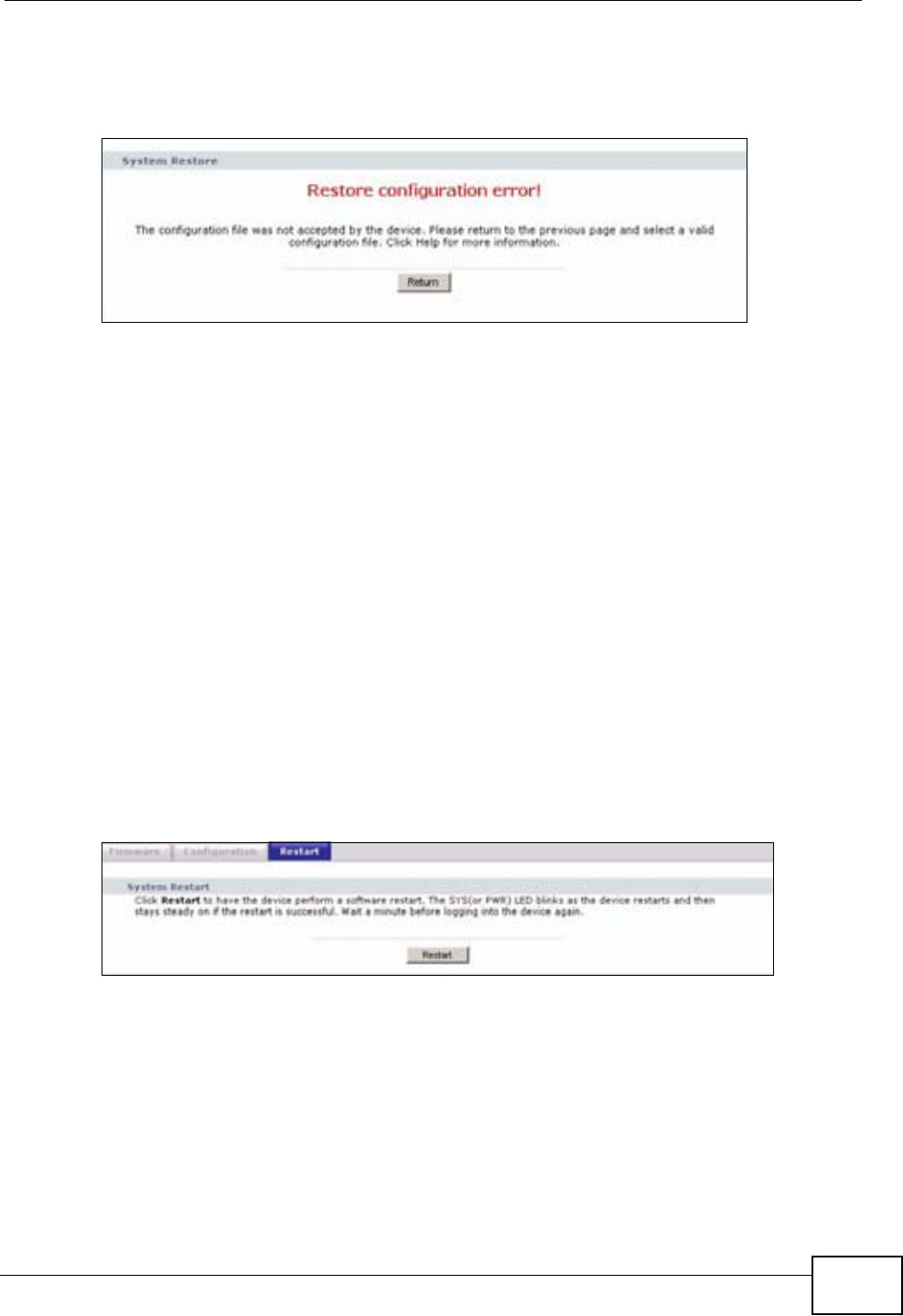
Chapter 19 Tools
P-320W v3 User’s Guide 183
If the upload was not successful, the following screen will appear. Click Return to
go back to the Configuration screen.
Figure 111 Configuration Restore Error
19.4.3 Back to Factory Defaults
Pressing the Reset button in this section clears all user-entered configuration
information and returns the P-320W v3 to its factory defaults.
You can also press the RESET button on the rear panel to reset the factory
defaults of your P-320W v3. Refer to the chapter about introducing the web
configurator for more information on the RESET button.
19.5 Restart Screen
System restart allows you to reboot the P-320W v3 without turning the power off.
Click Maintenance > Tools > Restart. Click Restart to have the P-320W v3
reboot. This does not affect the P-320W v3's configuration.
Figure 112 Maintenance > Tools > Restart

Chapter 19 Tools
P-320W v3 User’s Guide
184

P-320W v3 User’s Guide 185
CHAPTER 20
Troubleshooting
This chapter offers some suggestions to solve problems you might encounter. The
potential problems are divided into the following categories.
•Power, Hardware Connections, and LEDs
•P-320W v3 Access and Login
•Internet Access
•Resetting the P-320W v3 to Its Factory Defaults
•Wireless Router Troubleshooting
•Advanced Features
20.1 Power, Hardware Connections, and LEDs
The P-320W v3 does not turn on. None of the LEDs turn on.
1Make sure you are using the power adaptor or cord included with the P-320W v3.
2Make sure the power adaptor or cord is connected to the P-320W v3 and plugged
in to an appropriate power source. Make sure the power source is turned on.
3Disconnect and re-connect the power adaptor or cord to the P-320W v3.
4If the problem continues, contact the vendor.
One of the LEDs does not behave as expected.
1Make sure you understand the normal behavior of the LED. See Section 1.4 on
page 23.

Chapter 20 Troubleshooting
P-320W v3 User’s Guide
186
2Check the hardware connections. See the Quick Start Guide.
3Inspect your cables for damage. Contact the vendor to replace any damaged
cables.
4Disconnect and re-connect the power adaptor to the P-320W v3.
5If the problem continues, contact the vendor.
20.2 P-320W v3 Access and Login
I don’t know the IP address of my P-320W v3.
1The default IP address is 192.168.1.1.
2If you changed the IP address and have forgotten it, you might get the IP address
of the P-320W v3 by looking up the IP address of the default gateway for your
computer. To do this in most Windows computers, click Start > Run, enter cmd,
and then enter ipconfig. The IP address of the Default Gateway might be the IP
address of the P-320W v3 (it depends on the network), so enter this IP address in
your Internet browser. Login (see the Quick Start Guide for instructions) and go to
the Device Information table in the Status screen. Your P-320W v3’s IP address
is available in the Device Information table.
If the DHCP setting under LAN information is Enabled. The P-320W v3 is a
DHCP server on LAN.
3If your P-320W v3 is a DHCP client, you can find your IP address from the DHCP
server. This information is only available from the DHCP server which allocates IP
addresses on your network. Find this information directly from the DHCP server or
contact your system administrator for more information.
4Reset your P-320W v3 to change all settings back to their default. This means
your current settings are lost. See Section 20.4 on page 189 in the
Troubleshooting for information on resetting your P-320W v3.
I forgot the password.
1The default password is 1234.

Chapter 20 Troubleshooting
P-320W v3 User’s Guide 187
2If this does not work, you have to reset the device to its factory defaults. See
Section 20.4 on page 189.
I cannot see or access the Login screen in the web configurator.
1Make sure you are using the correct IP address.
• The default IP address is 192.168.1.1.
• If you changed the IP address (Section 7.3 on page 102), use the new IP
address.
• If you changed the IP address and have forgotten it, see the troubleshooting
suggestions for I don’t know the IP address of my P-320W v3.
2Check the hardware connections, and make sure the LEDs are behaving as
expected. See the Quick Start Guide.
3Make sure your Internet browser does not block pop-up windows and has
JavaScripts and Java enabled. See Appendix A on page 199.
4Make sure your computer is in the same subnet as the P-320W v3. (If you know
that there are routers between your computer and the P-320W v3, skip this step.)
• If there is a DHCP server on your network, make sure your computer is using
a dynamic IP address. See Section 7.3 on page 102.
• If there is no DHCP server on your network, make sure your computer’s IP
address is in the same subnet as the P-320W v3. See Section 7.3 on page
102.
5Reset the device to its factory defaults, and try to access the P-320W v3 with the
default IP address. See Section 7.3 on page 102.
6If the problem continues, contact the network administrator or vendor, or try one
of the advanced suggestions.
Advanced Suggestions
• Try to access the P-320W v3 using another service, such as Telnet. If you can
access the P-320W v3, check the remote management settings and firewall
rules to find out why the P-320W v3 does not respond to HTTP.
• If your computer is connected to the WAN port or is connected wirelessly, use a
computer that is connected to a LAN/ETHERNET port.
I can see the Login screen, but I cannot log in to the P-320W v3.

Chapter 20 Troubleshooting
P-320W v3 User’s Guide
188
1Make sure you have entered the password correctly. The default password is
1234. This field is case-sensitive, so make sure [Caps Lock] is not on.
2You cannot log in to the web configurator while someone is using Telnet to access
the P-320W v3. Log out of the P-320W v3 in the other session, or ask the person
who is logged in to log out.
3Disconnect and re-connect the power adaptor or cord to the P-320W v3.
4If this does not work, you have to reset the device to its factory defaults. See
Section 20.4 on page 189.
20.3 Internet Access
I cannot access the Internet.
1Check the hardware connections, and make sure the LEDs are behaving as
expected. See the Quick Start Guide.
2Make sure you entered your ISP account information correctly in the wizard. These
fields are case-sensitive, so make sure [Caps Lock] is not on.
3If you are trying to access the Internet wirelessly, make sure the wireless settings
in the wireless client are the same as the settings in the AP.
4Disconnect all the cables from your device, and follow the directions in the Quick
Start Guide again.
5If the problem continues, contact your ISP.
I cannot access the Internet anymore. I had access to the Internet (with the P-
320W v3), but my Internet connection is not available anymore.
1Check the hardware connections, and make sure the LEDs are behaving as
expected. See the Quick Start Guide and Section 1.4 on page 23.
2Reboot the P-320W v3.
3If the problem continues, contact your ISP.

Chapter 20 Troubleshooting
P-320W v3 User’s Guide 189
The Internet connection is slow or intermittent.
1There might be a lot of traffic on the network. Look at the LEDs, and check Section
1.4 on page 23. If the P-320W v3 is sending or receiving a lot of information, try
closing some programs that use the Internet, especially peer-to-peer applications.
2Check the signal strength. If the signal strength is low, try moving the P-320W v3
closer to the AP if possible, and look around to see if there are any devices that
might be interfering with the wireless network (for example, microwaves, other
wireless networks, and so on).
3Reboot the P-320W v3.
4If the problem continues, contact the network administrator or vendor, or try one
of the advanced suggestions.
Advanced Suggestions
• Check the settings for bandwidth management. If it is disabled, you might
consider activating it. If it is enabled, you might consider changing the
allocations.
• Check the settings for QoS. If it is disabled, you might consider activating it. If it
is enabled, you might consider raising or lowering the priority for some
applications.
20.4 Resetting the P-320W v3 to Its Factory
Defaults
If you reset the P-320W v3, you lose all of the changes you have made. The P-
320W v3 re-loads its default settings, and the password resets to 1234. You have
to make all of your changes again.
You will lose all of your changes when you push the RESET button.
To reset the P-320W v3,
1Make sure the power LED is on and not blinking.

Chapter 20 Troubleshooting
P-320W v3 User’s Guide
190
2Press and hold the RESET button for five to ten seconds. The default settings
have been restored.
If the P-320W v3 restarts automatically, wait for the P-320W v3 to finish
restarting, and log in to the web configurator. The password is “1234”.
If the P-320W v3 does not restart automatically, disconnect and reconnect the P-
320W v3’s power. Then, follow the directions above again.
20.5 Wireless Router Troubleshooting
I cannot access the P-320W v3 or ping any computer from the WLAN (wireless
router).
1Make sure the wireless LAN is enabled on the P-320W v3
2Make sure the wireless adapter on the wireless station is working properly.
3Make sure the wireless adapter installed on your computer is IEEE 802.11
compatible and supports the same wireless standard as the P-320W v3.
4Make sure your computer (with a wireless adapter installed) is within the
transmission range of the P-320W v3.
5Check that both the P-320W v3 and your wireless station are using the same
wireless and wireless security settings.
6Make sure traffic between the WLAN and the LAN is not blocked by the firewall on
the P-320W v3.
7Make sure you allow the P-320W v3 to be remotely accessed through the WLAN
interface. Check your remote management settings.
• See the chapter on Wireless LAN in the User’s Guide for more information.

Chapter 20 Troubleshooting
P-320W v3 User’s Guide 191
20.6 Advanced Features
I set up URL keyword blocking, but I can still access a website that should be
blocked.
Make sure that you select the Enable URL Keyword Blocking check box in the
Content Filtering screen. Make sure that the keywords that you type are listed in
the Keyword List.
If a keyword that is listed in the Keyword List is not blocked when it is found in a
URL, customize the keyword blocking using commands. See the Customizing
Keyword Blocking URL Checking section in the Content Filter chapter.

Chapter 20 Troubleshooting
P-320W v3 User’s Guide
192

P-320W v3 User’s Guide 193
CHAPTER 21
Product Specifications
The following tables summarize the P-320W v3’s hardware and firmware features.
Table 83 Hardware Features
Dimensions (W x D x
H)
162 x 115 x 33 mm
Weight 248 g
Power Specification Input: 120~240 AC, 50~60 Hz
Output: 5 V AC 1 A
Ethernet ports Auto-negotiating: 10 Mbps or 100 Mbps in either half-duplex or
full-duplex mode.
Auto-crossover: Use either crossover or straight-through Ethernet
cables.
4-5 Port Switch A combination of switch and router makes your P-320W v3 a cost-
effective and viable network solution. You can add up to four
computers to the P-320W v3 without the cost of a hub when
connecting to the Internet through the WAN port. You can add up
to five computers to the P-320W v3 when you connect to the
Internet in AP mode. Add more than four computers to your LAN
by using a hub.
LEDs PWR, LAN1-4, WAN, WLAN, WPS
Reset Button The reset button is built into the rear panel. Use this button to
restore the P-320W v3 to its factory default settings. Press for 1
second to restart the device. Press for 5 seconds to restore to
factory default settings.
Antenna The P-320W v3 is equipped with a 2dBi detachable antenna to
provide clear radio transmission and reception on the wireless
network.
Operation
Environment
Temperature: 0º C ~ 40º C
Humidity: 20% ~ 80% RH (Non-condensing)
Storage Environment Temperature: -20º C ~ 70º C
Humidity: 20% ~ 90% RH (Non-condensing)

Chapter 21 Product Specifications
P-320W v3 User’s Guide
194
Table 84 Firmware Features
FEATURE DESCRIPTION
Default IP Address 192.168.1.1
Default Subnet Mask 255.255.255.0 (24 bits)
Default Password 1234
DHCP Pool 192.168.1.33 to 192.168.1.64
Wireless Interface Wireless LAN
Default Wireless SSID Wireless LAN: ZyXEL
Default Wireless IP
Address
Wireless LAN: Same as LAN (192.168.1.1)
Default Wireless Subnet
Mask
Wireless LAN: Same as LAN (255.255.255.0)
Default Wireless DHCP
Pool Size
Wireless LAN: Same as LAN (32 from 192.168.1.33 to
192.168.1.64)
Device Management Use the web configurator to easily configure the rich range of
features on the P-320W v3.
Wireless Functionality Allows IEEE 802.11b and/or IEEE 802.11g wireless clients to
connect to the P-320W v3 wirelessly. Enable wireless security
(WEP, WPA, WPA-PSK) and/or MAC filtering to protect your
wireless network.
Note: The P-320W v3 may be prone to RF (Radio
Frequency) interference from other 2.4 GHz devices
such as microwave ovens, wireless phones,
Bluetooth enabled devices, and other wireless LANs.
Firmware Upgrade Download new firmware (when available) from the ZyXEL web
site and use the web configurator to put it on the P-320W v3.
Note: Only upload firmware for your specific model!
Configuration Backup &
Restoration
Make a copy of the P-320W v3’s configuration and put it back
on the P-320W v3 later if you decide you want to revert back to
an earlier configuration.
Network Address
Translation (NAT)
Each computer on your network must have its own unique IP
address. Use NAT to convert a single public IP address to
multiple private IP addresses for the computers on your
network.
Firewall You can configure firewall on the P-320W v3 for secure Internet
access. When the firewall is on, by default, all incoming traffic
from the Internet to your network is blocked unless it is
initiated from your network. This means that probes from the
outside to your network are not allowed, but you can safely
browse the Internet and download files for example.

Chapter 21 Product Specifications
P-320W v3 User’s Guide 195
Content Filter The P-320W v3 blocks or allows access to web sites that you
specify and blocks access to web sites with URLs that contain
keywords that you specify. You can define time periods and
days during which content filtering is enabled. You can also
include or exclude particular computers on your network from
content filtering.
You can also subscribe to category-based content filtering that
allows your P-320W v3 to check web sites against an external
database.
Time and Date Get the current time and date from an external server when
you turn on your P-320W v3. You can also set the time
manually. These dates and times are then used in logs.
Port Forwarding If you have a server (mail or web server for example) on your
network, then use this feature to let people access it from the
Internet.
DHCP (Dynamic Host
Configuration Protocol)
Use this feature to have the P-320W v3 assign IP addresses, an
IP default gateway and DNS servers to computers on your
network.
Dynamic DNS Support With Dynamic DNS (Domain Name System) support, you can
use a fixed URL, www.zyxel.com for example, with a dynamic
IP address. You must register for this service with a Dynamic
DNS service provider.
Logging Use logs for troubleshooting.
PPPoE PPPoE mimics a dial-up over Ethernet Internet access
connection.
PPTP Encapsulation Point-to-Point Tunneling Protocol (PPTP) enables secure
transfer of data through a Virtual Private Network (VPN). The
P-320W v3 supports one PPTP connection at a time.
Universal Plug and Play
(UPnP)
The P-320W v3 can communicate with other UPnP enabled
devices in a network.
Table 84 Firmware Features
FEATURE DESCRIPTION

Chapter 21 Product Specifications
P-320W v3 User’s Guide
196

197
PART VI
Appendices and
Index
Pop-up Windows, JavaScripts and Java
Permissions (199)
IP Addresses and Subnetting (207)
Setting up Your Computer’s IP Address
(217)
Wireless LANs (235)
Services (247)
Legal Information (251)
Index (255)

198
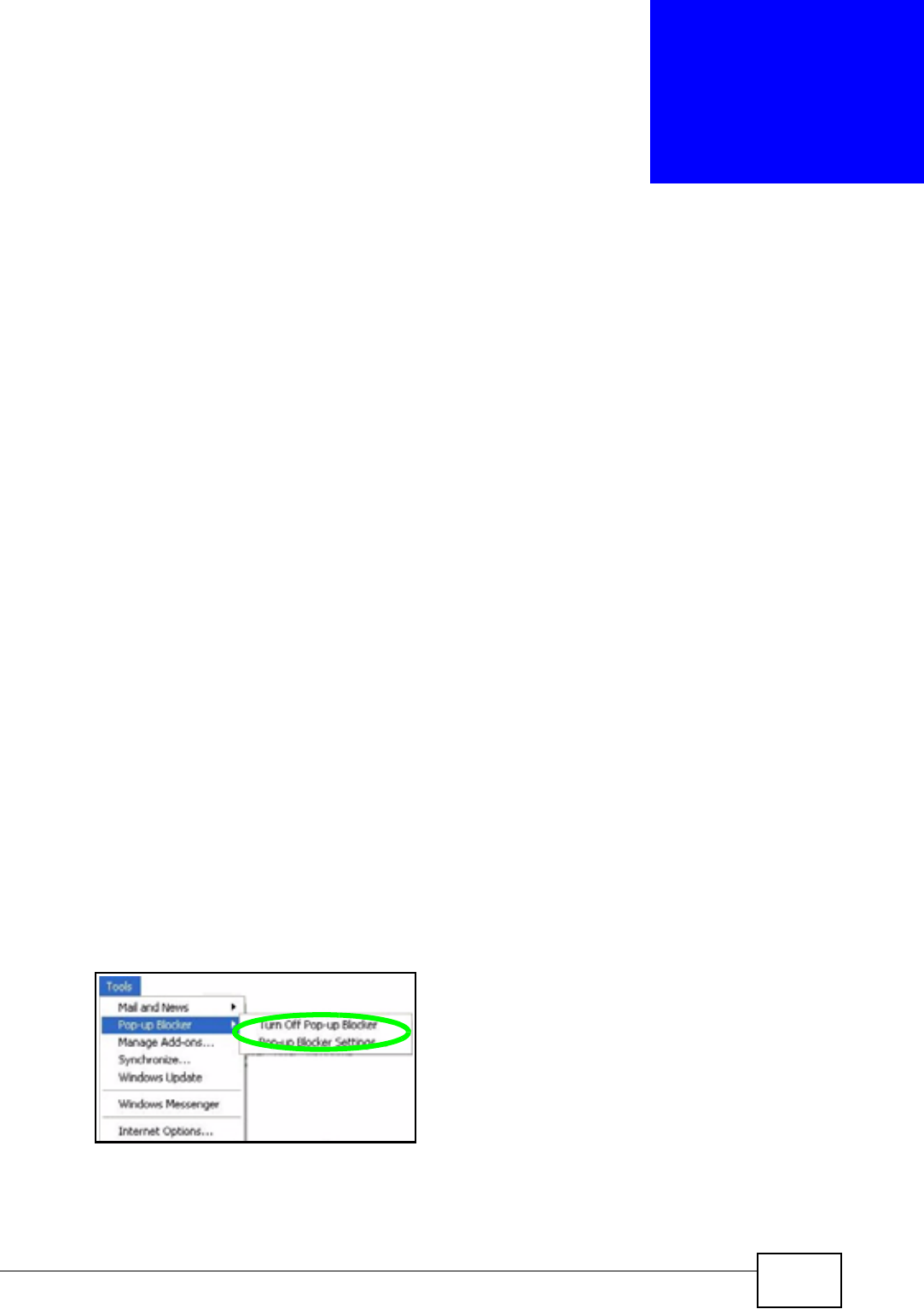
P-320W v3 User’s Guide 199
APPENDIX A
Pop-up Windows, JavaScripts
and Java Permissions
In order to use the web configurator you need to allow:
• Web browser pop-up windows from your device.
• JavaScripts (enabled by default).
• Java permissions (enabled by default).
Note: Internet Explorer 6 screens are used here. Screens for other Internet Explorer
versions may vary.
Internet Explorer Pop-up Blockers
You may have to disable pop-up blocking to log into your device.
Either disable pop-up blocking (enabled by default in Windows XP SP (Service
Pack) 2) or allow pop-up blocking and create an exception for your device’s IP
address.
Disable pop-up Blockers
1In Internet Explorer, select Tools,Pop-up Blocker and then select Turn Off
Pop-up Blocker.
Figure 113 Pop-up Blocker
You can also check if pop-up blocking is disabled in the Pop-up Blocker section in
the Privacy tab.
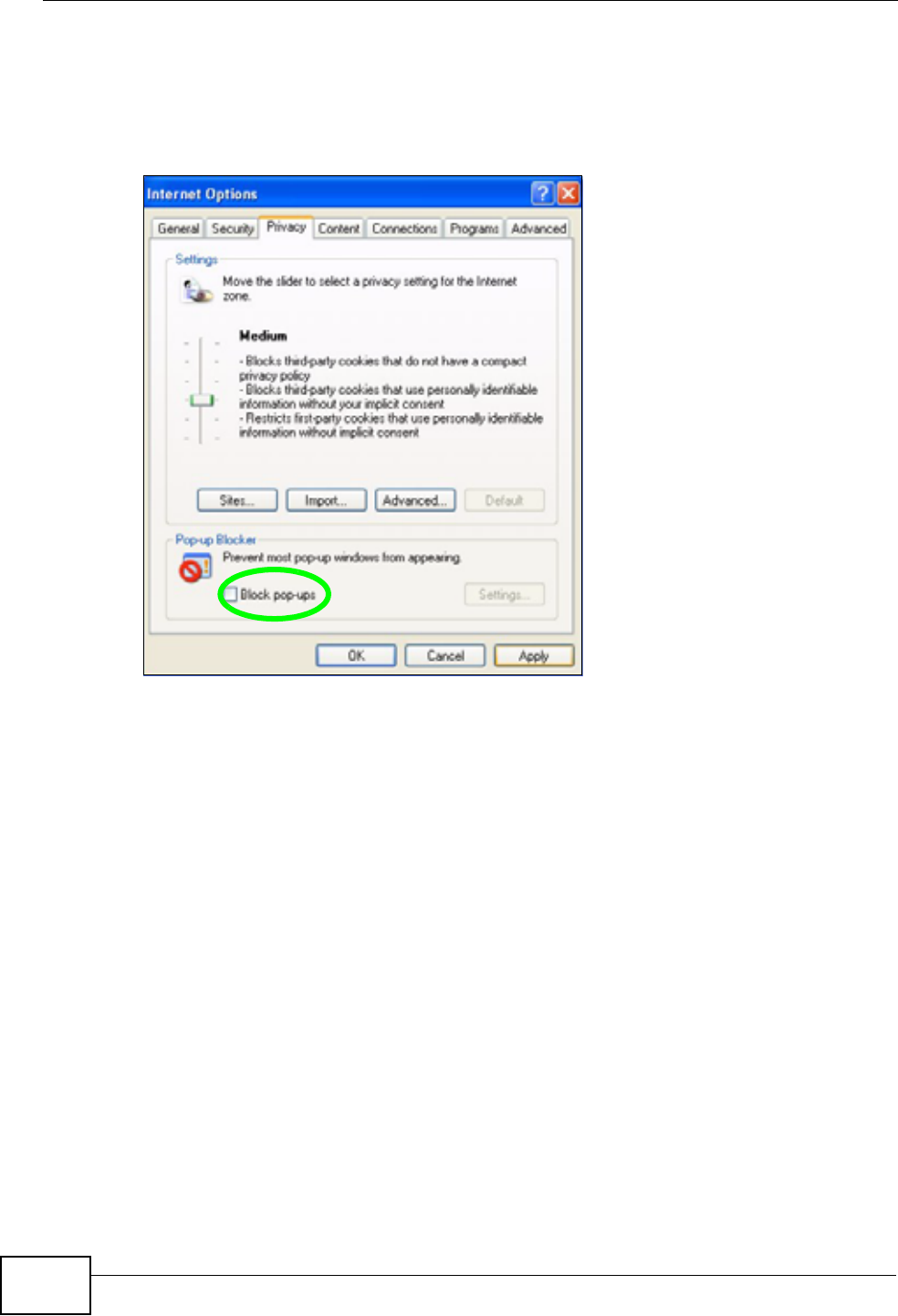
Appendix A Pop-up Windows, JavaScripts and Java Permissions
P-320W v3 User’s Guide
200
1In Internet Explorer, select Tools,Internet Options,Privacy.
2Clear the Block pop-ups check box in the Pop-up Blocker section of the screen.
This disables any web pop-up blockers you may have enabled.
Figure 114 Internet Options: Privacy
3Click Apply to save this setting.
Enable pop-up Blockers with Exceptions
Alternatively, if you only want to allow pop-up windows from your device, see the
following steps.
1In Internet Explorer, select Tools,Internet Options and then the Privacy tab.
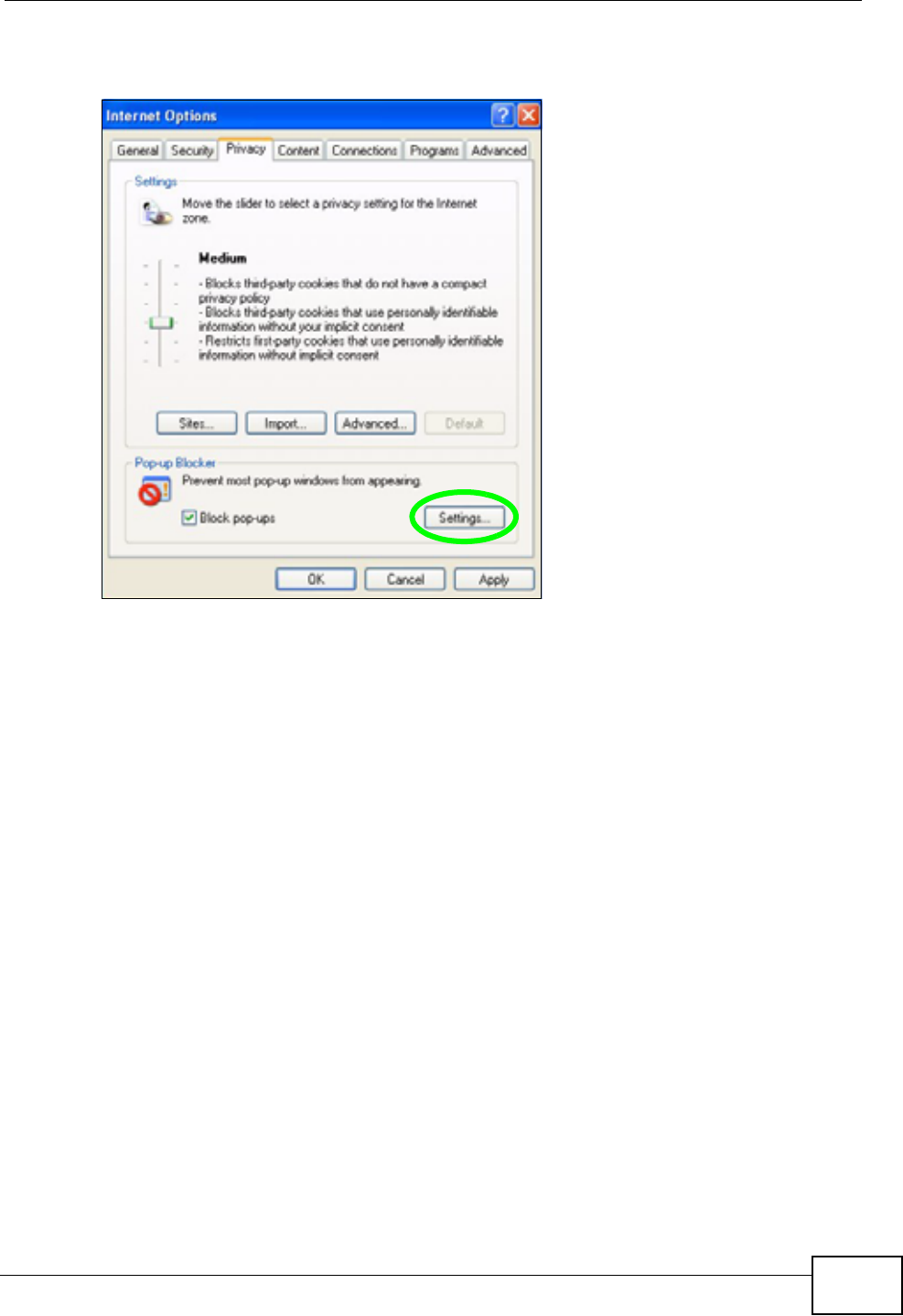
Appendix A Pop-up Windows, JavaScripts and Java Permissions
P-320W v3 User’s Guide 201
2Select Settings…to open the Pop-up Blocker Settings screen.
Figure 115 Internet Options: Privacy
3Type the IP address of your device (the web page that you do not want to have
blocked) with the prefix “http://”. For example, http://192.168.167.1.
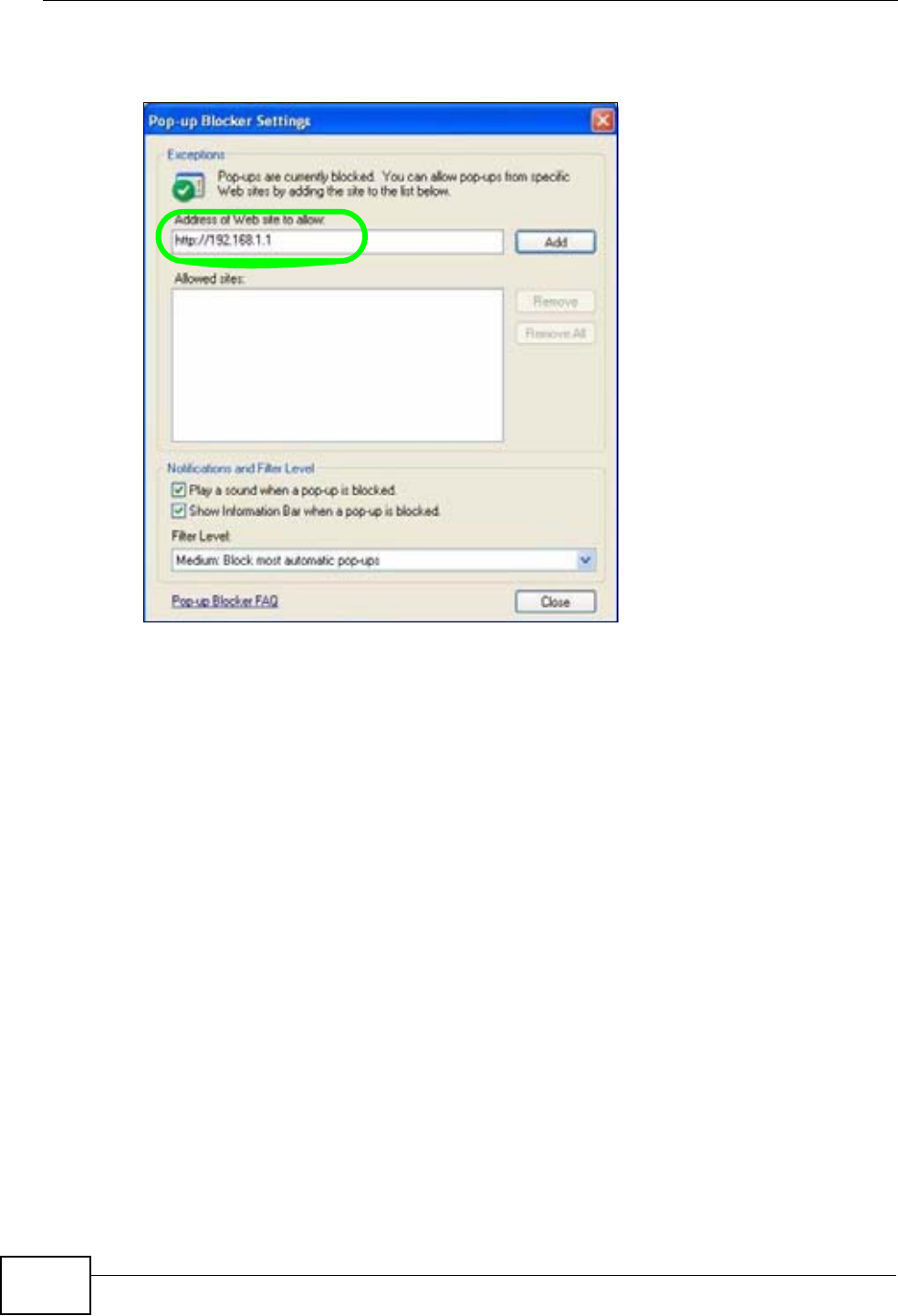
Appendix A Pop-up Windows, JavaScripts and Java Permissions
P-320W v3 User’s Guide
202
4Click Add to move the IP address to the list of Allowed sites.
Figure 116 Pop-up Blocker Settings
5Click Close to return to the Privacy screen.
6Click Apply to save this setting.
JavaScripts
If pages of the web configurator do not display properly in Internet Explorer, check
that JavaScripts are allowed.
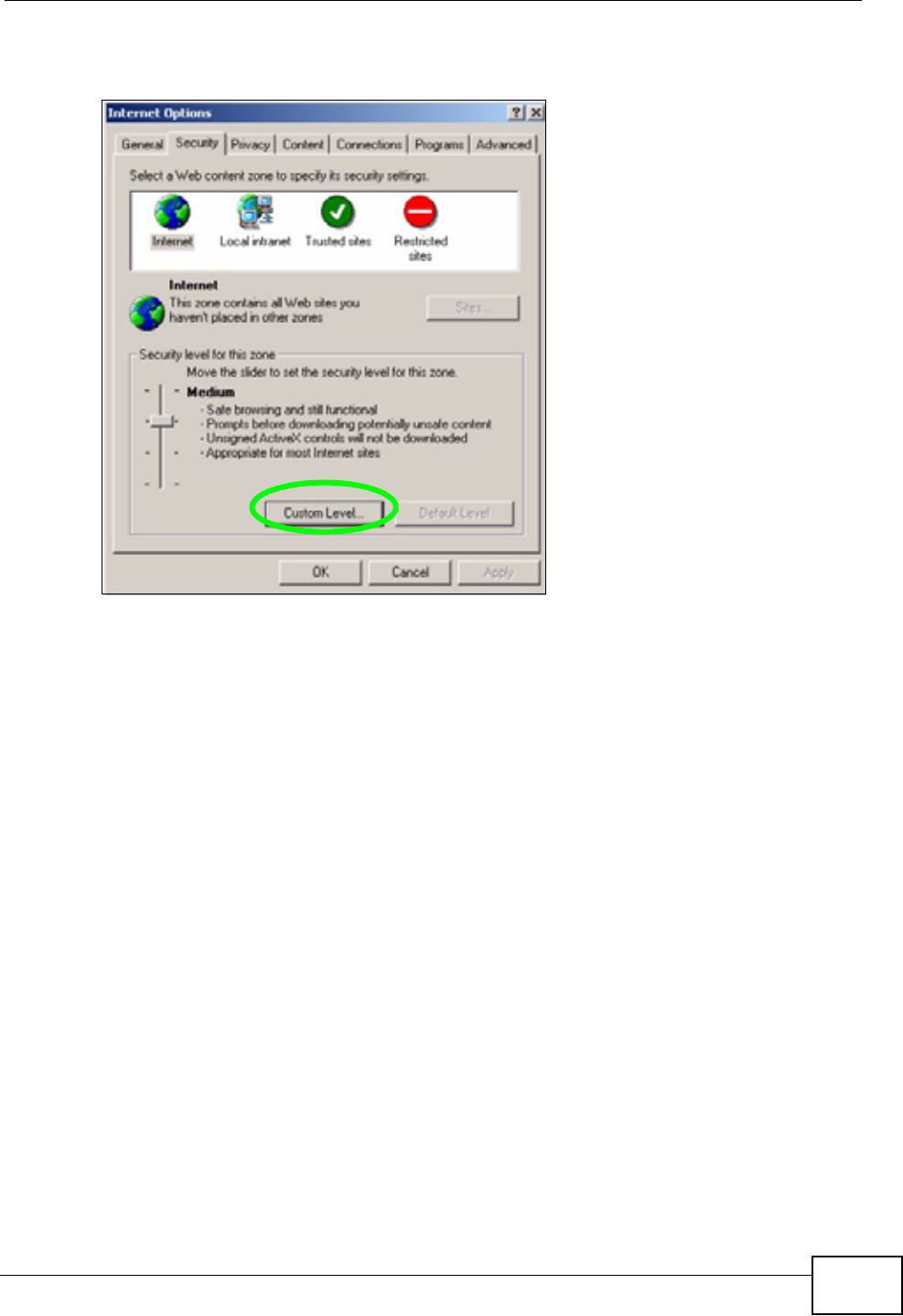
Appendix A Pop-up Windows, JavaScripts and Java Permissions
P-320W v3 User’s Guide 203
1In Internet Explorer, click Tools,Internet Options and then the Security tab.
Figure 117 Internet Options: Security
2Click the Custom Level... button.
3Scroll down to Scripting.
4Under Active scripting make sure that Enable is selected (the default).
5Under Scripting of Java applets make sure that Enable is selected (the
default).
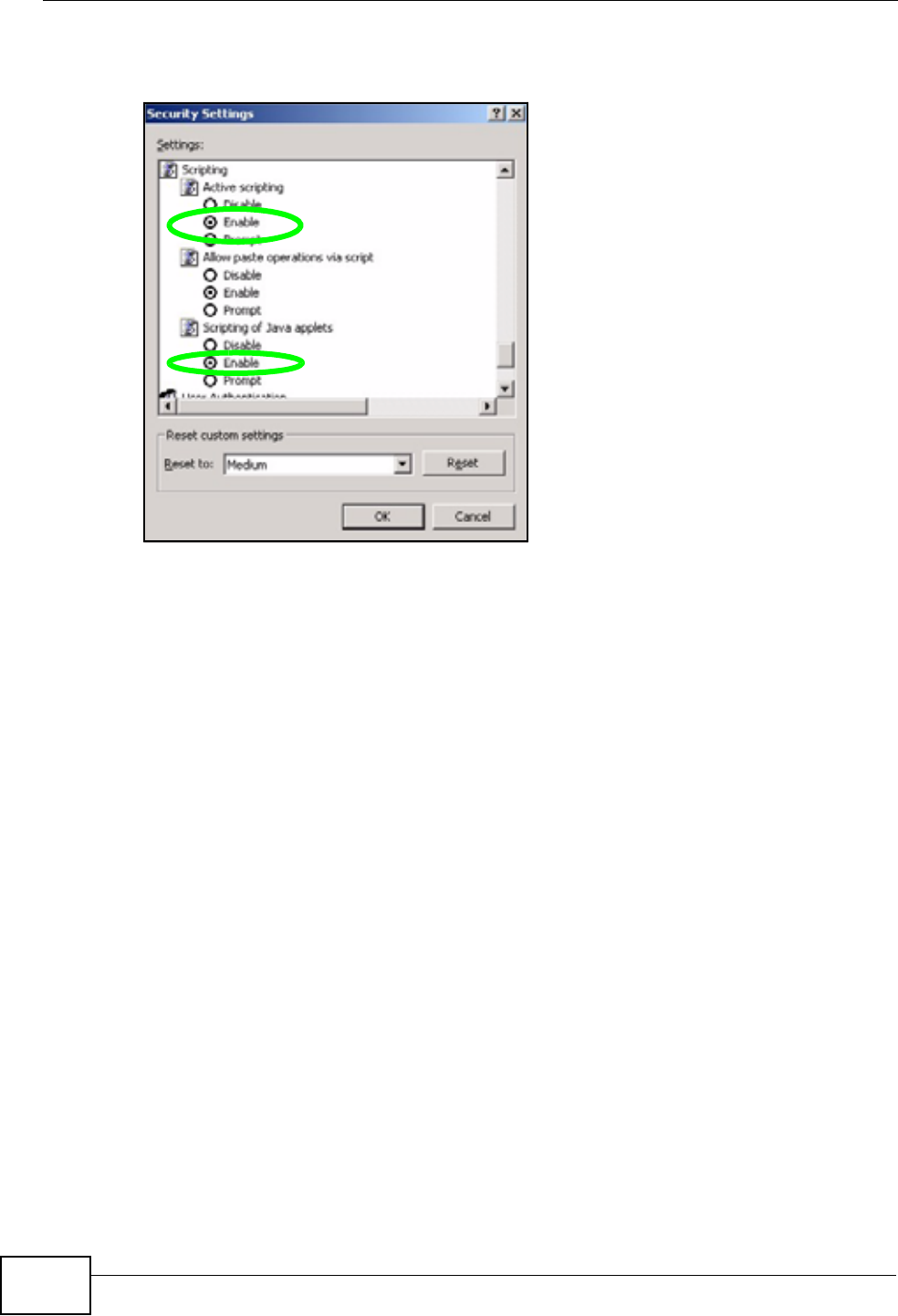
Appendix A Pop-up Windows, JavaScripts and Java Permissions
P-320W v3 User’s Guide
204
6Click OK to close the window.
Figure 118 Security Settings - Java Scripting
Java Permissions
1From Internet Explorer, click Tools,Internet Options and then the Security
tab.
2Click the Custom Level... button.
3Scroll down to Microsoft VM.
4Under Java permissions make sure that a safety level is selected.
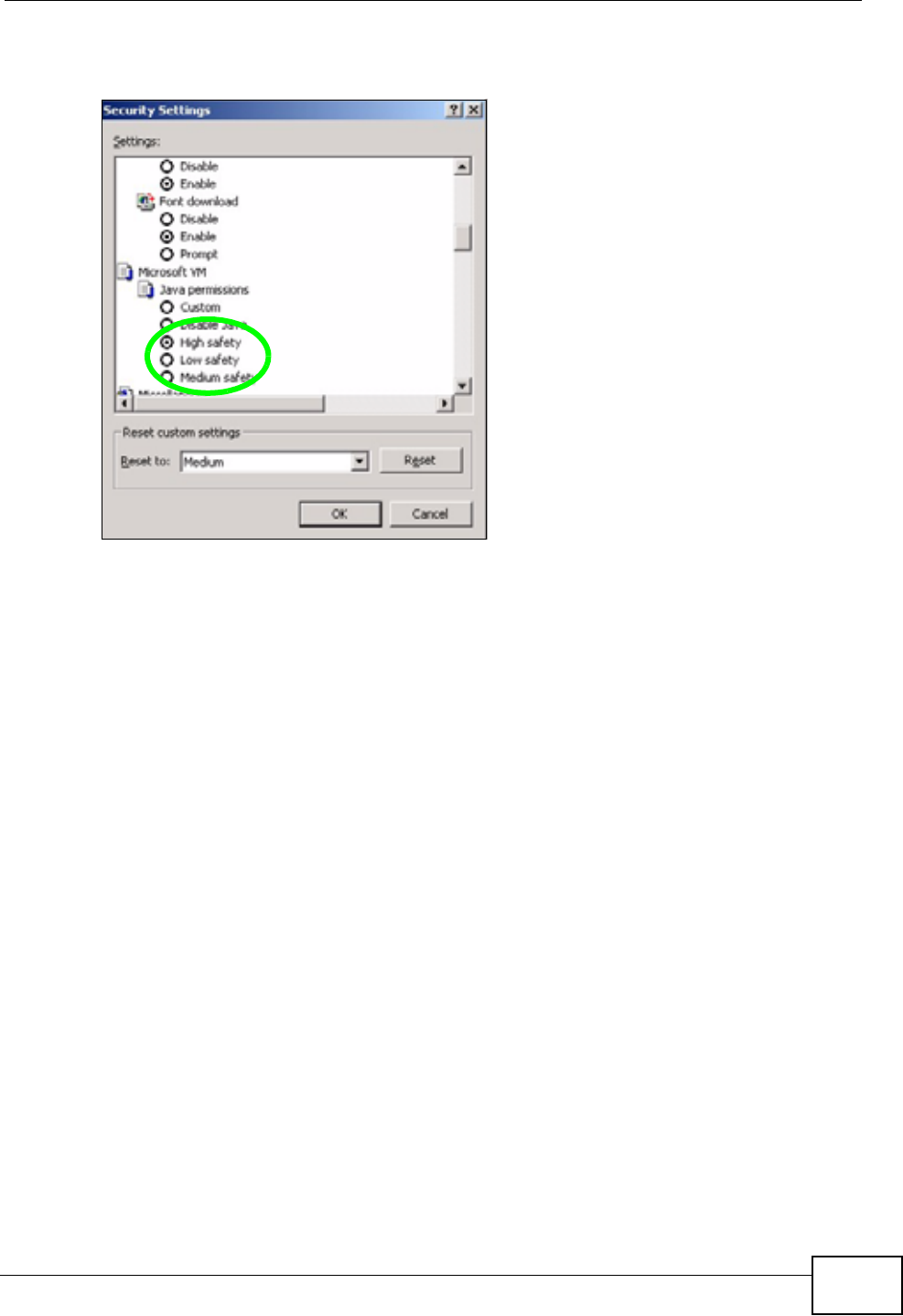
Appendix A Pop-up Windows, JavaScripts and Java Permissions
P-320W v3 User’s Guide 205
5Click OK to close the window.
Figure 119 Security Settings - Java
JAVA (Sun)
1From Internet Explorer, click Tools,Internet Options and then the Advanced
tab.
2Make sure that Use Java 2 for <applet> under Java (Sun) is selected.
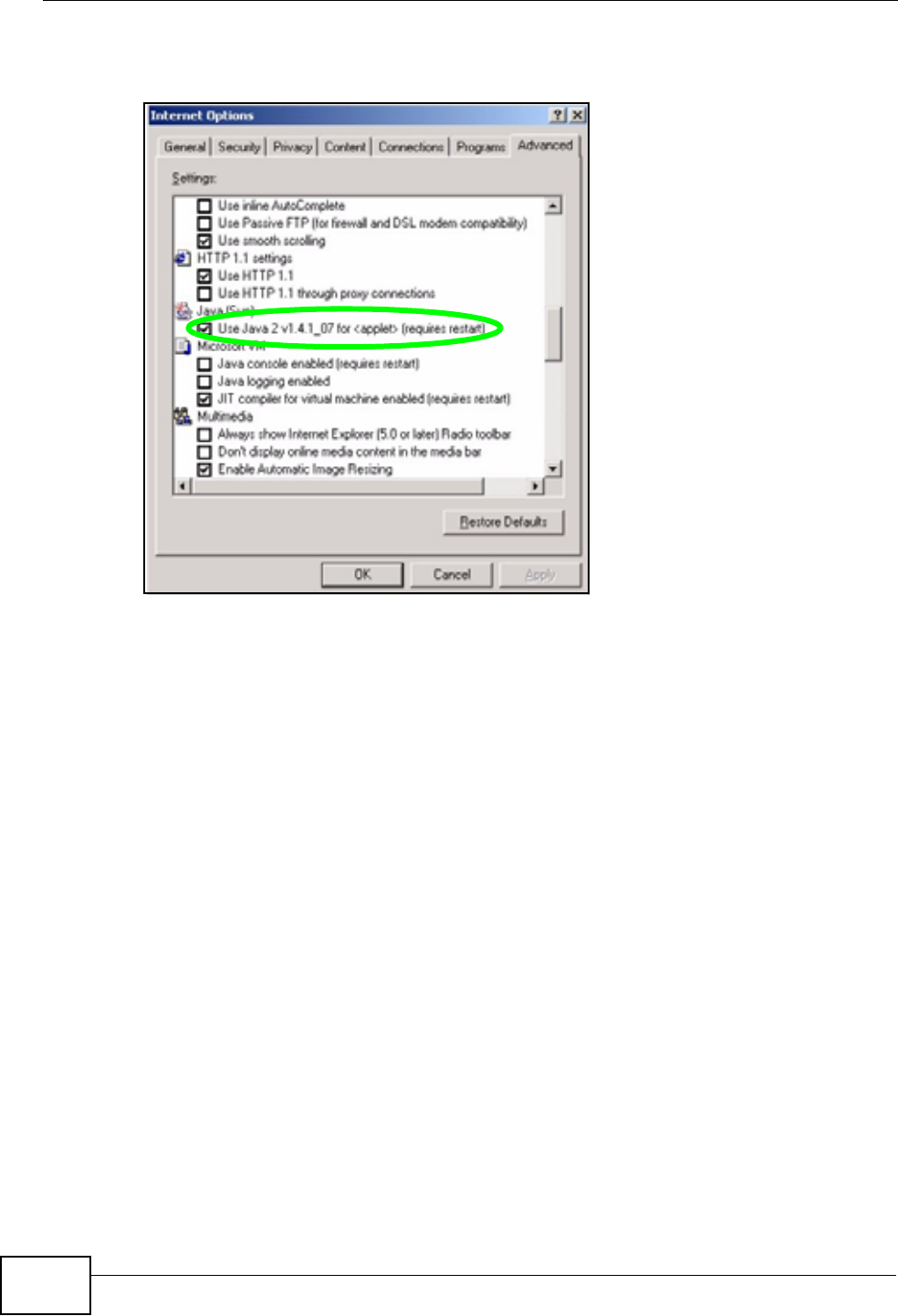
Appendix A Pop-up Windows, JavaScripts and Java Permissions
P-320W v3 User’s Guide
206
3Click OK to close the window.
Figure 120 Java (Sun)

P-320W v3 User’s Guide 207
APPENDIX B
IP Addresses and Subnetting
This appendix introduces IP addresses and subnet masks.
IP addresses identify individual devices on a network. Every networking device
(including computers, servers, routers, printers, etc.) needs an IP address to
communicate across the network. These networking devices are also known as
hosts.
Subnet masks determine the maximum number of possible hosts on a network.
You can also use subnet masks to divide one network into multiple sub-networks.
Introduction to IP Addresses
One part of the IP address is the network number, and the other part is the host
ID. In the same way that houses on a street share a common street name, the
hosts on a network share a common network number. Similarly, as each house
has its own house number, each host on the network has its own unique
identifying number - the host ID. Routers use the network number to send packets
to the correct network, while the host ID determines to which host on the network
the packets are delivered.
Structure
An IP address is made up of four parts, written in dotted decimal notation (for
example, 192.168.1.1). Each of these four parts is known as an octet. An octet is
an eight-digit binary number (for example 11000000, which is 192 in decimal
notation).
Therefore, each octet has a possible range of 00000000 to 11111111 in binary, or
0 to 255 in decimal.
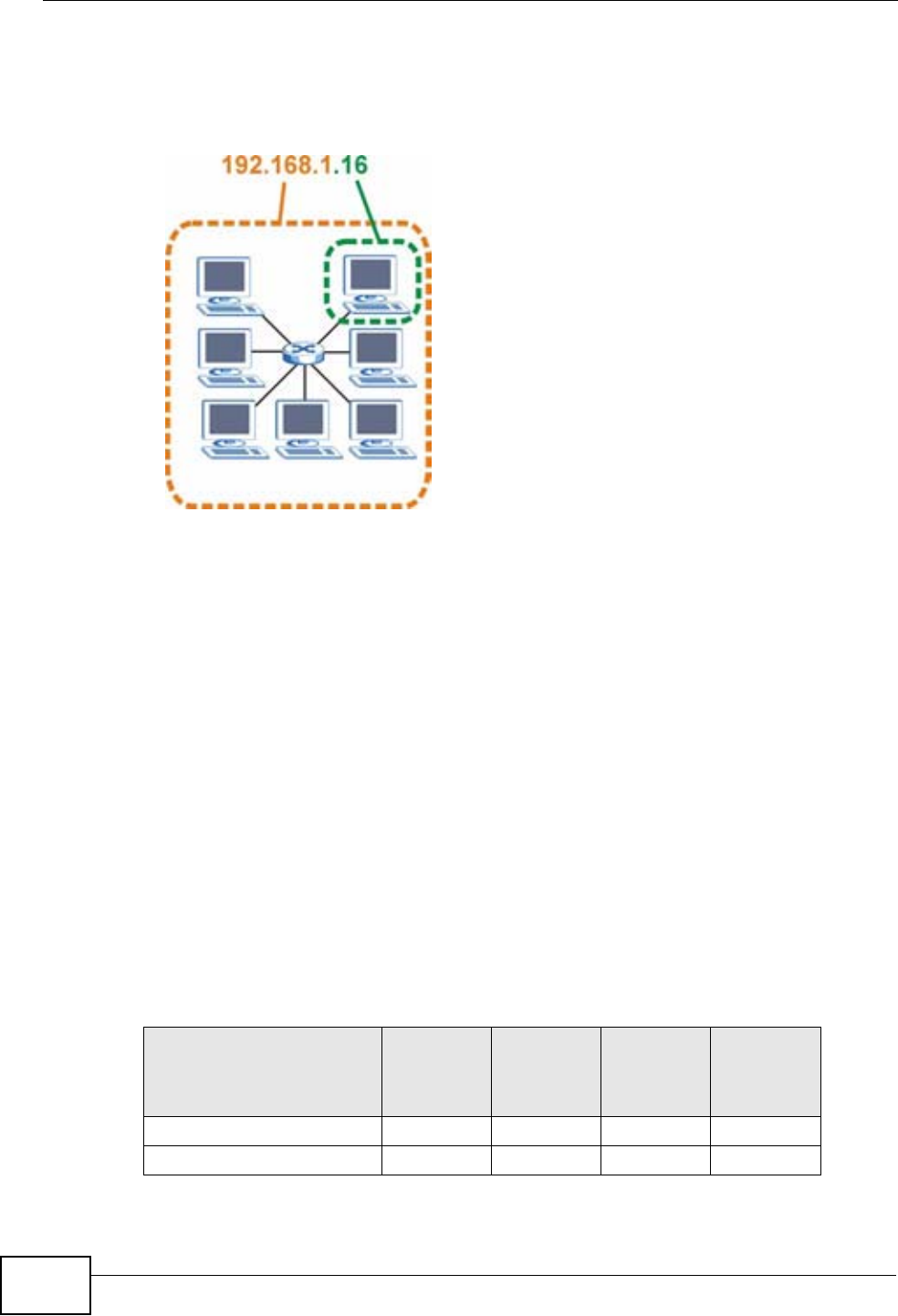
Appendix B IP Addresses and Subnetting
P-320W v3 User’s Guide
208
The following figure shows an example IP address in which the first three octets
(192.168.1) are the network number, and the fourth octet (16) is the host ID.
Figure 121 Network Number and Host ID
How much of the IP address is the network number and how much is the host ID
varies according to the subnet mask.
Subnet Masks
A subnet mask is used to determine which bits are part of the network number,
and which bits are part of the host ID (using a logical AND operation). The term
“subnet” is short for “sub-network”.
A subnet mask has 32 bits. If a bit in the subnet mask is a “1” then the
corresponding bit in the IP address is part of the network number. If a bit in the
subnet mask is “0” then the corresponding bit in the IP address is part of the host
ID.
The following example shows a subnet mask identifying the network number (in
bold text) and host ID of an IP address (192.168.1.2 in decimal).
Table 85 Subnet Mask - Identifying Network Number
1ST
OCTET:
(192)
2ND
OCTET:
(168)
3RD
OCTET:
(1)
4TH
OCTET
(2)
IP Address (Binary) 11000000 10101000 00000001 00000010
Subnet Mask (Binary) 11111111 11111111 11111111 00000000
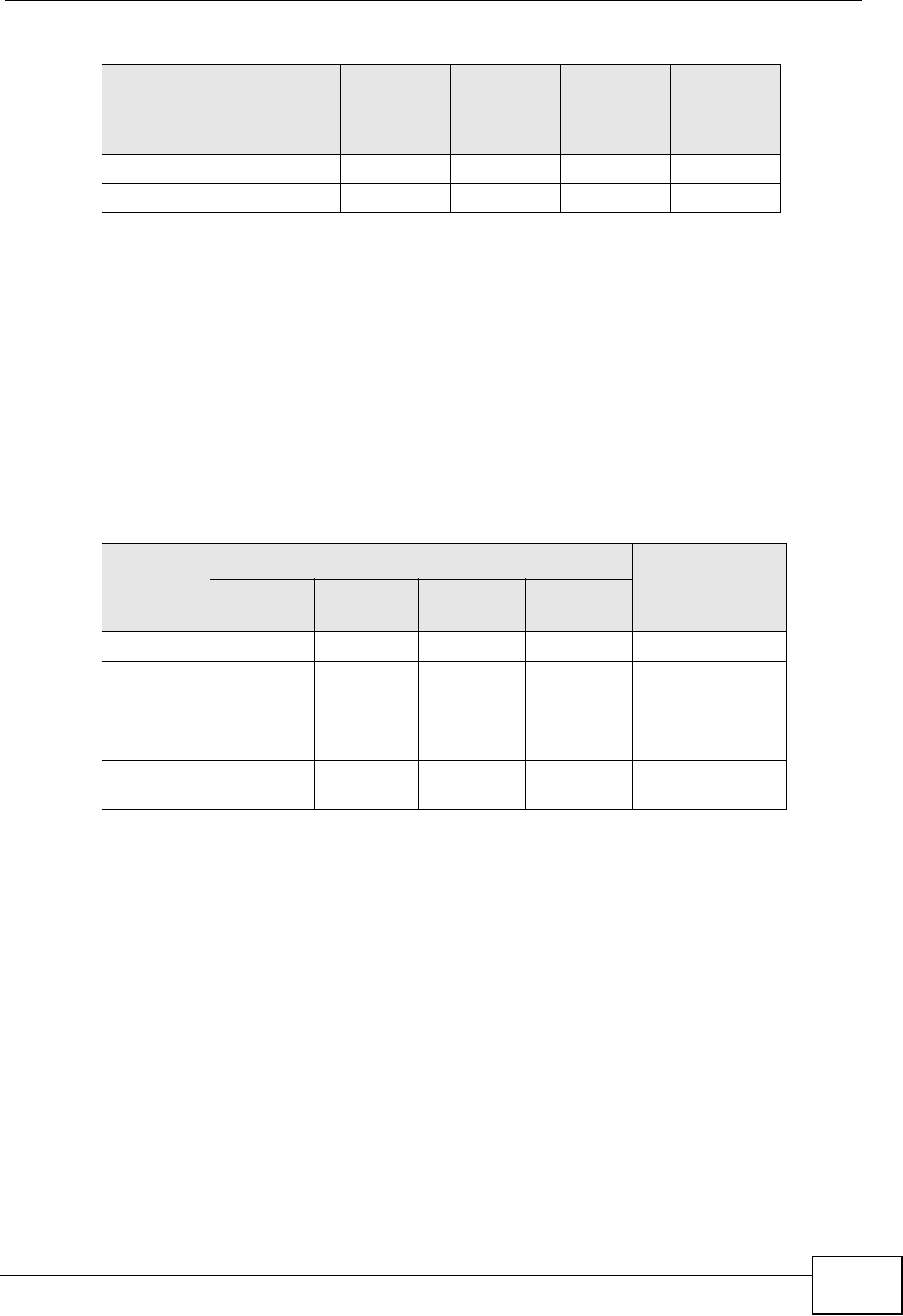
Appendix B IP Addresses and Subnetting
P-320W v3 User’s Guide 209
By convention, subnet masks always consist of a continuous sequence of ones
beginning from the leftmost bit of the mask, followed by a continuous sequence of
zeros, for a total number of 32 bits.
Subnet masks can be referred to by the size of the network number part (the bits
with a “1” value). For example, an “8-bit mask” means that the first 8 bits of the
mask are ones and the remaining 24 bits are zeroes.
Subnet masks are expressed in dotted decimal notation just like IP addresses. The
following examples show the binary and decimal notation for 8-bit, 16-bit, 24-bit
and 29-bit subnet masks.
Network Size
The size of the network number determines the maximum number of possible
hosts you can have on your network. The larger the number of network number
bits, the smaller the number of remaining host ID bits.
An IP address with host IDs of all zeros is the IP address of the network
(192.168.1.0 with a 24-bit subnet mask, for example). An IP address with host
IDs of all ones is the broadcast address for that network (192.168.1.255 with a
24-bit subnet mask, for example).
Network Number 11000000 10101000 00000001
Host ID 00000010
Table 86 Subnet Masks
BINARY
DECIMAL
1ST
OCTET
2ND
OCTET
3RD
OCTET
4TH
OCTET
8-bit mask 11111111 00000000 00000000 00000000 255.0.0.0
16-bit
mask
11111111 11111111 00000000 00000000 255.255.0.0
24-bit
mask
11111111 11111111 11111111 00000000 255.255.255.0
29-bit
mask
11111111 11111111 11111111 11111000 255.255.255.24
8
Table 85 Subnet Mask - Identifying Network Number
1ST
OCTET:
(192)
2ND
OCTET:
(168)
3RD
OCTET:
(1)
4TH
OCTET
(2)
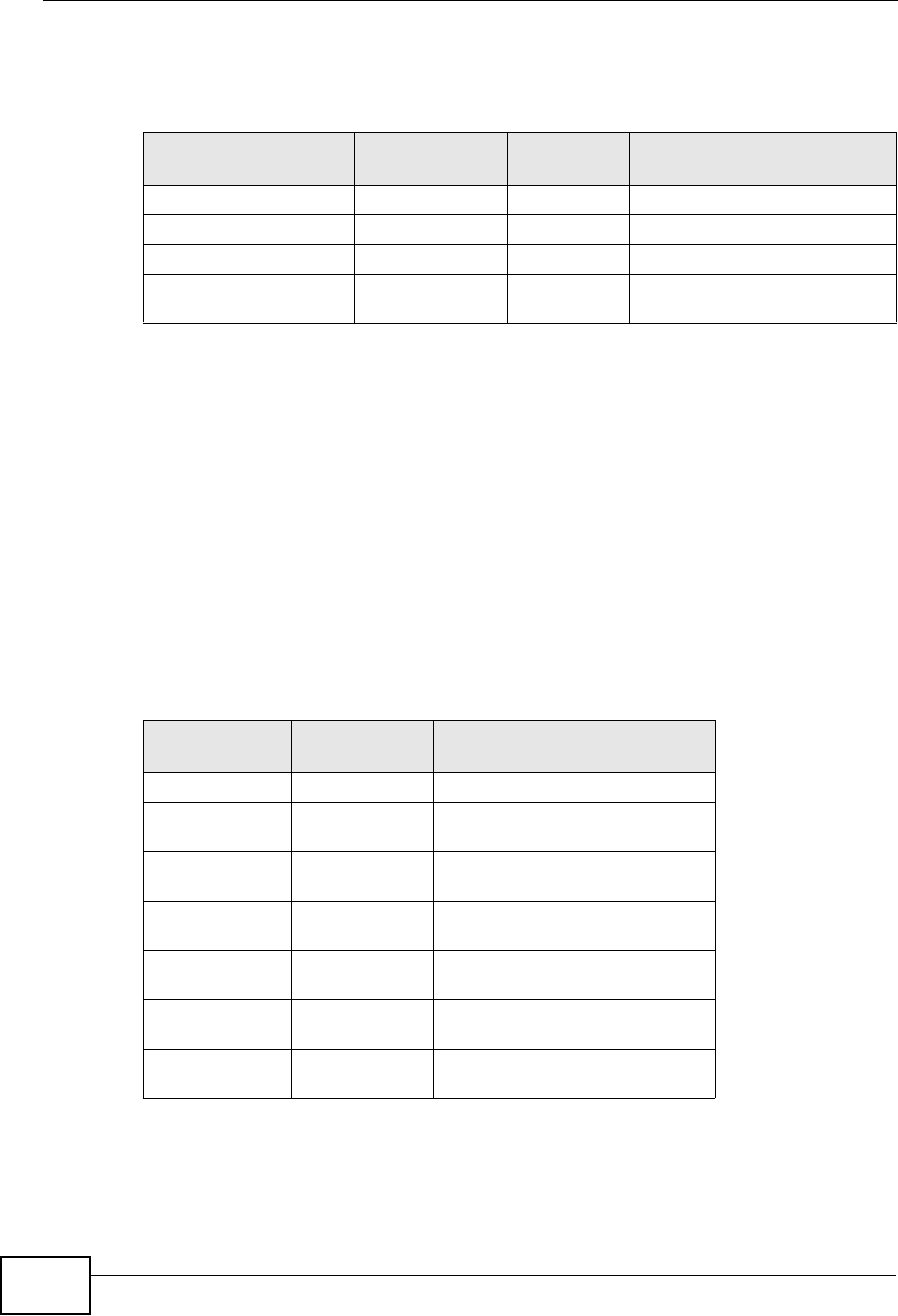
Appendix B IP Addresses and Subnetting
P-320W v3 User’s Guide
210
As these two IP addresses cannot be used for individual hosts, calculate the
maximum number of possible hosts in a network as follows:
Notation
Since the mask is always a continuous number of ones beginning from the left,
followed by a continuous number of zeros for the remainder of the 32 bit mask,
you can simply specify the number of ones instead of writing the value of each
octet. This is usually specified by writing a “/” followed by the number of bits in
the mask after the address.
For example, 192.1.1.0 /25 is equivalent to saying 192.1.1.0 with subnet mask
255.255.255.128.
The following table shows some possible subnet masks using both notations.
Table 87 Maximum Host Numbers
SUBNET MASK HOST ID SIZE MAXIMUM NUMBER OF
HOSTS
8 bits 255.0.0.0 24 bits 224 – 2 16777214
16 bits 255.255.0.0 16 bits 216 – 2 65534
24 bits 255.255.255.0 8 bits 28 – 2 254
29 bits 255.255.255.2
48
3 bits 23 – 2 6
Table 88 Alternative Subnet Mask Notation
SUBNET
MASK
ALTERNATIVE
NOTATION
LAST OCTET
(BINARY)
LAST OCTET
(DECIMAL)
255.255.255.0 /24 0000 0000 0
255.255.255.12
8
/25 1000 0000 128
255.255.255.19
2
/26 1100 0000 192
255.255.255.22
4
/27 1110 0000 224
255.255.255.24
0
/28 1111 0000 240
255.255.255.24
8
/29 1111 1000 248
255.255.255.25
2
/30 1111 1100 252
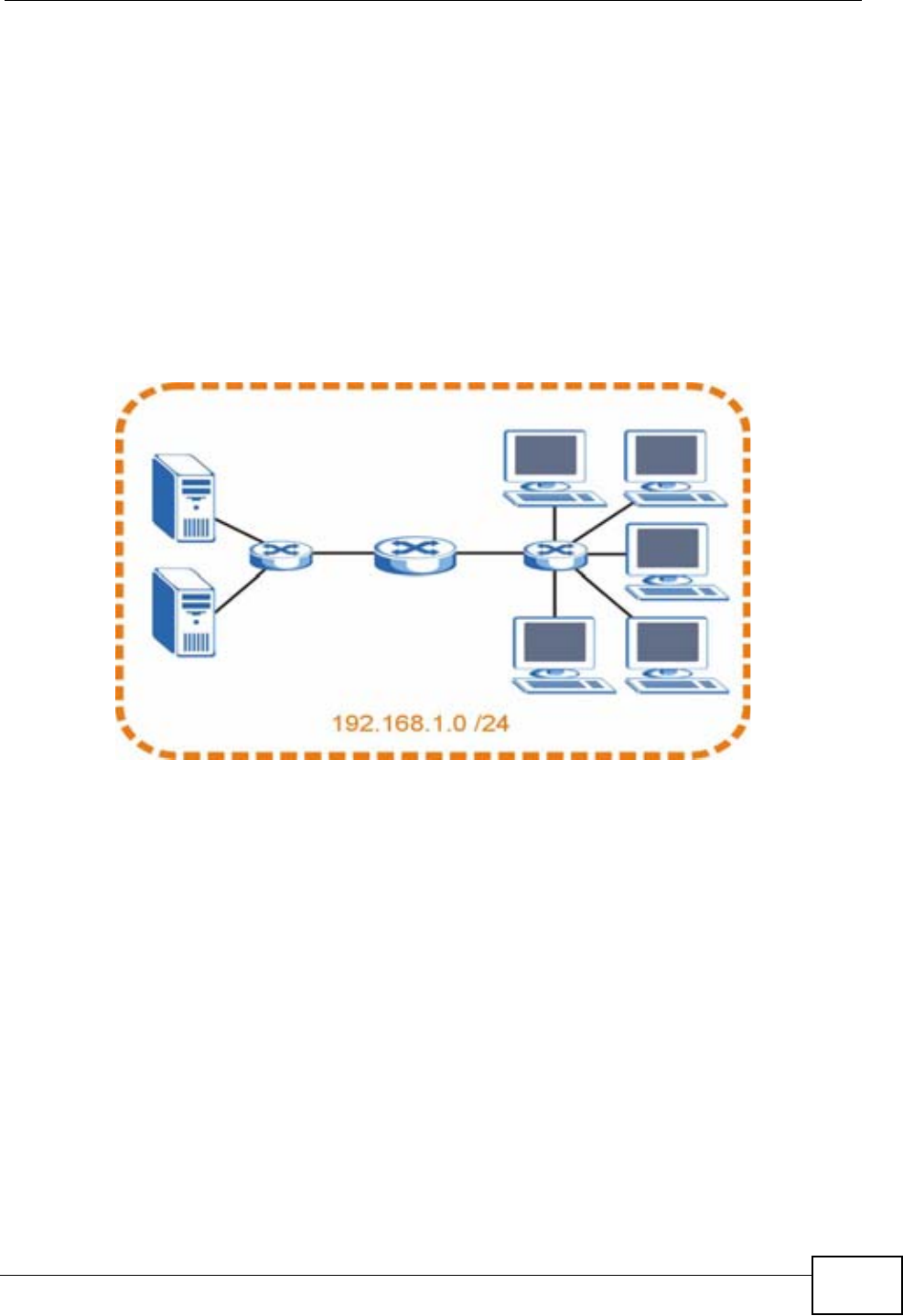
Appendix B IP Addresses and Subnetting
P-320W v3 User’s Guide 211
Subnetting
You can use subnetting to divide one network into multiple sub-networks. In the
following example a network administrator creates two sub-networks to isolate a
group of servers from the rest of the company network for security reasons.
In this example, the company network address is 192.168.1.0. The first three
octets of the address (192.168.1) are the network number, and the remaining
octet is the host ID, allowing a maximum of 28 – 2 or 254 possible hosts.
The following figure shows the company network before subnetting.
Figure 122 Subnetting Example: Before Subnetting
You can “borrow” one of the host ID bits to divide the network 192.168.1.0 into
two separate sub-networks. The subnet mask is now 25 bits (255.255.255.128 or
/25).
The “borrowed” host ID bit can have a value of either 0 or 1, allowing two
subnets; 192.168.1.0 /25 and 192.168.1.128 /25.
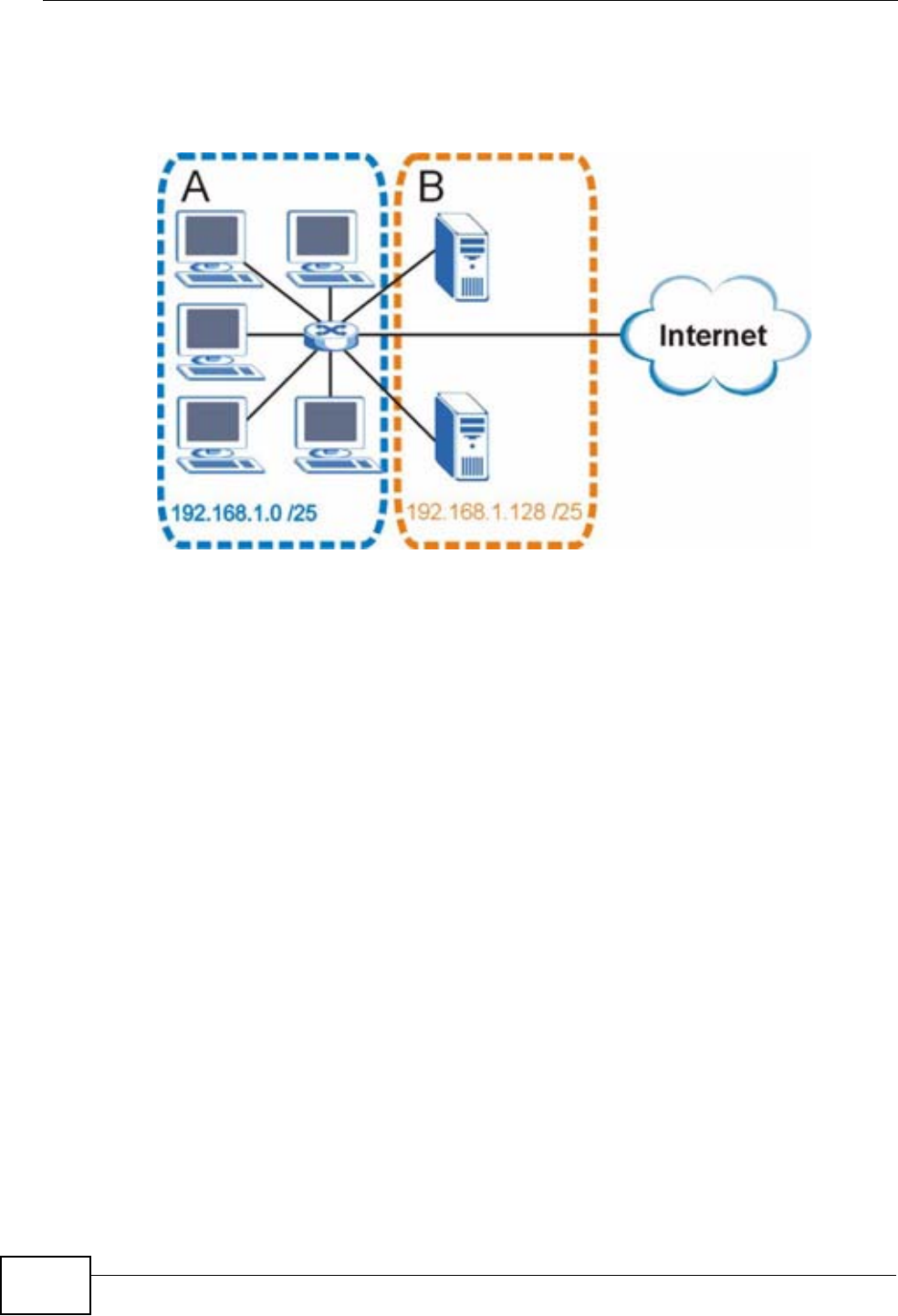
Appendix B IP Addresses and Subnetting
P-320W v3 User’s Guide
212
The following figure shows the company network after subnetting. There are now
two sub-networks, A and B.
Figure 123 Subnetting Example: After Subnetting
In a 25-bit subnet the host ID has 7 bits, so each sub-network has a maximum of
27 – 2 or 126 possible hosts (a host ID of all zeroes is the subnet’s address itself,
all ones is the subnet’s broadcast address).
192.168.1.0 with mask 255.255.255.128 is subnet A itself, and 192.168.1.127
with mask 255.255.255.128 is its broadcast address. Therefore, the lowest IP
address that can be assigned to an actual host for subnet A is 192.168.1.1 and
the highest is 192.168.1.126.
Similarly, the host ID range for subnet B is 192.168.1.129 to 192.168.1.254.
Example: Four Subnets
The previous example illustrated using a 25-bit subnet mask to divide a 24-bit
address into two subnets. Similarly, to divide a 24-bit address into four subnets,
you need to “borrow” two host ID bits to give four possible combinations (00, 01,
10 and 11). The subnet mask is 26 bits
(11111111.11111111.11111111.11000000) or 255.255.255.192.

Appendix B IP Addresses and Subnetting
P-320W v3 User’s Guide 213
Each subnet contains 6 host ID bits, giving 26 - 2 or 62 hosts for each subnet (a
host ID of all zeroes is the subnet itself, all ones is the subnet’s broadcast
address).
Table 89 Subnet 1
IP/SUBNET MASK NETWORK NUMBER LAST OCTET BIT
VALUE
IP Address (Decimal) 192.168.1. 0
IP Address (Binary) 11000000.10101000.00000001. 00000000
Subnet Mask (Binary) 11111111.11111111.11111111. 11000000
Subnet Address:
192.168.1.0
Lowest Host ID: 192.168.1.1
Broadcast Address:
192.168.1.63
Highest Host ID: 192.168.1.62
Table 90 Subnet 2
IP/SUBNET MASK NETWORK NUMBER LAST OCTET BIT
VALUE
IP Address 192.168.1. 64
IP Address (Binary) 11000000.10101000.00000001. 01000000
Subnet Mask (Binary) 11111111.11111111.11111111. 11000000
Subnet Address:
192.168.1.64
Lowest Host ID: 192.168.1.65
Broadcast Address:
192.168.1.127
Highest Host ID: 192.168.1.126
Table 91 Subnet 3
IP/SUBNET MASK NETWORK NUMBER LAST OCTET BIT
VALUE
IP Address 192.168.1. 128
IP Address (Binary) 11000000.10101000.00000001. 10000000
Subnet Mask (Binary) 11111111.11111111.11111111. 11000000
Subnet Address:
192.168.1.128
Lowest Host ID: 192.168.1.129
Broadcast Address:
192.168.1.191
Highest Host ID: 192.168.1.190
Table 92 Subnet 4
IP/SUBNET MASK NETWORK NUMBER LAST OCTET BIT
VALUE
IP Address 192.168.1. 192
IP Address (Binary) 11000000.10101000.00000001
.
11000000
Subnet Mask (Binary) 11111111.11111111.11111111
.
11000000
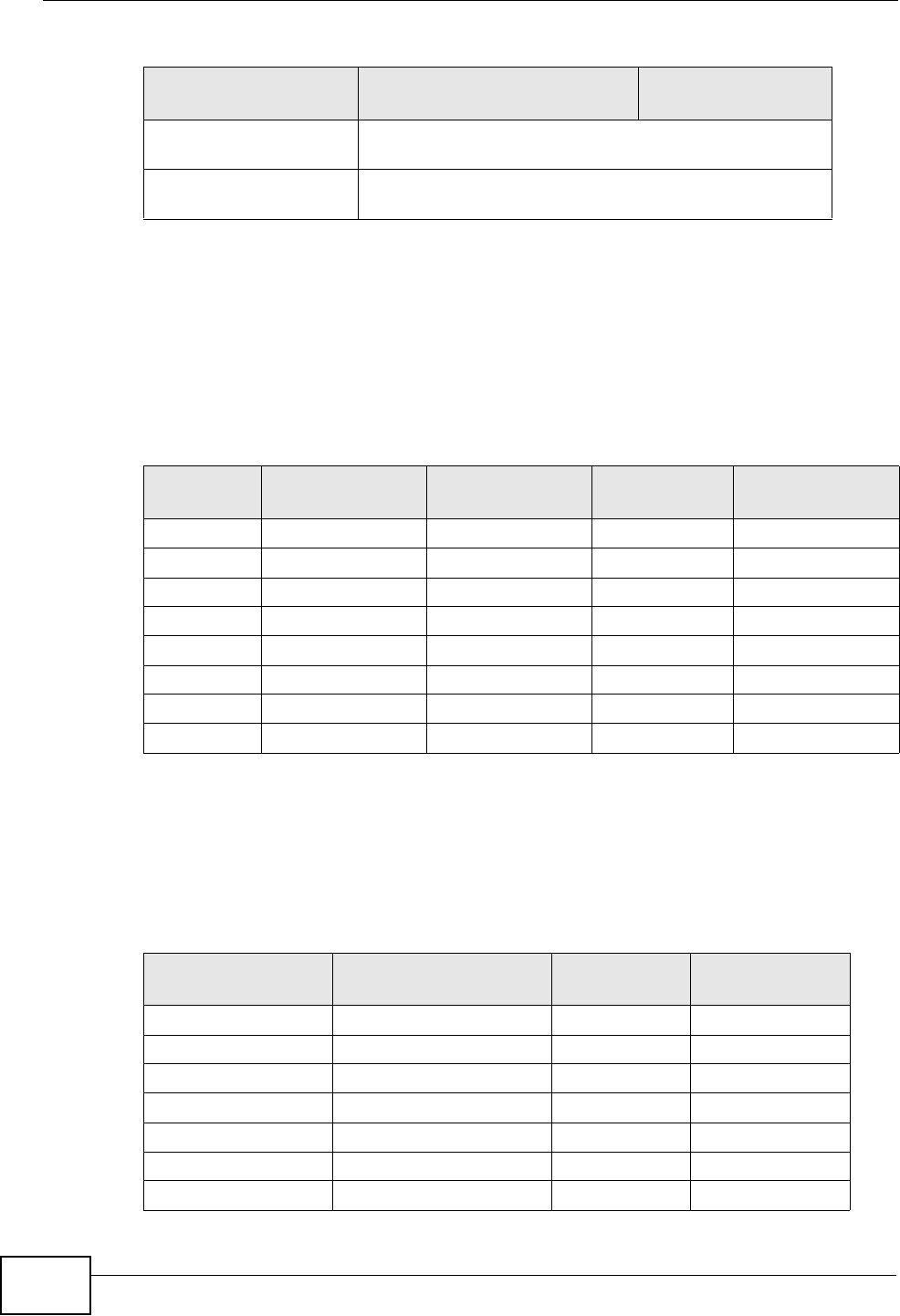
Appendix B IP Addresses and Subnetting
P-320W v3 User’s Guide
214
Example: Eight Subnets
Similarly, use a 27-bit mask to create eight subnets (000, 001, 010, 011, 100,
101, 110 and 111).
The following table shows IP address last octet values for each subnet.
Subnet Planning
The following table is a summary for subnet planning on a network with a 24-bit
network number.
Subnet Address:
192.168.1.192
Lowest Host ID: 192.168.1.193
Broadcast Address:
192.168.1.255
Highest Host ID: 192.168.1.254
Table 92 Subnet 4 (continued)
IP/SUBNET MASK NETWORK NUMBER LAST OCTET BIT
VALUE
Table 93 Eight Subnets
SUBNET SUBNET
ADDRESS FIRST ADDRESS LAST
ADDRESS
BROADCAST
ADDRESS
1 0 1 30 31
232 33 62 63
364 65 94 95
496 97 126 127
5128 129 158 159
6160 161 190 191
7192 193 222 223
8224 225 254 255
Table 94 24-bit Network Number Subnet Planning
NO. “BORROWED”
HOST BITS SUBNET MASK NO. SUBNETS NO. HOSTS PER
SUBNET
1255.255.255.128 (/25) 2126
2255.255.255.192 (/26) 462
3255.255.255.224 (/27) 830
4255.255.255.240 (/28) 16 14
5255.255.255.248 (/29) 32 6
6255.255.255.252 (/30) 64 2
7255.255.255.254 (/31) 128 1

Appendix B IP Addresses and Subnetting
P-320W v3 User’s Guide 215
The following table is a summary for subnet planning on a network with a 16-bit
network number.
Configuring IP Addresses
Where you obtain your network number depends on your particular situation. If
the ISP or your network administrator assigns you a block of registered IP
addresses, follow their instructions in selecting the IP addresses and the subnet
mask.
If the ISP did not explicitly give you an IP network number, then most likely you
have a single user account and the ISP will assign you a dynamic IP address when
the connection is established. If this is the case, it is recommended that you select
a network number from 192.168.0.0 to 192.168.255.0. The Internet Assigned
Number Authority (IANA) reserved this block of addresses specifically for private
use; please do not use any other number unless you are told otherwise. You must
also enable Network Address Translation (NAT) on the P-320W v3.
Once you have decided on the network number, pick an IP address for your P-
320W v3 that is easy to remember (for instance, 192.168.1.1) but make sure that
no other device on your network is using that IP address.
The subnet mask specifies the network number portion of an IP address. Your P-
320W v3 will compute the subnet mask automatically based on the IP address
Table 95 16-bit Network Number Subnet Planning
NO. “BORROWED”
HOST BITS SUBNET MASK NO. SUBNETS NO. HOSTS PER
SUBNET
1255.255.128.0 (/17) 232766
2255.255.192.0 (/18) 416382
3255.255.224.0 (/19) 88190
4255.255.240.0 (/20) 16 4094
5255.255.248.0 (/21) 32 2046
6255.255.252.0 (/22) 64 1022
7255.255.254.0 (/23) 128 510
8255.255.255.0 (/24) 256 254
9255.255.255.128 (/25) 512 126
10 255.255.255.192 (/26) 1024 62
11 255.255.255.224 (/27) 2048 30
12 255.255.255.240 (/28) 4096 14
13 255.255.255.248 (/29) 8192 6
14 255.255.255.252 (/30) 16384 2
15 255.255.255.254 (/31) 32768 1

Appendix B IP Addresses and Subnetting
P-320W v3 User’s Guide
216
that you entered. You don't need to change the subnet mask computed by the P-
320W v3 unless you are instructed to do otherwise.
Private IP Addresses
Every machine on the Internet must have a unique address. If your networks are
isolated from the Internet (running only between two branch offices, for example)
you can assign any IP addresses to the hosts without problems. However, the
Internet Assigned Numbers Authority (IANA) has reserved the following three
blocks of IP addresses specifically for private networks:
• 10.0.0.0 — 10.255.255.255
• 172.16.0.0 — 172.31.255.255
• 192.168.0.0 — 192.168.255.255
You can obtain your IP address from the IANA, from an ISP, or it can be assigned
from a private network. If you belong to a small organization and your Internet
access is through an ISP, the ISP can provide you with the Internet addresses for
your local networks. On the other hand, if you are part of a much larger
organization, you should consult your network administrator for the appropriate IP
addresses.
Regardless of your particular situation, do not create an arbitrary IP address;
always follow the guidelines above. For more information on address assignment,
please refer to RFC 1597, Address Allocation for Private Internets and RFC 1466,
Guidelines for Management of IP Address Space.

P-320W v3 User’s Guide 217
APPENDIX C
Setting up Your Computer’s IP
Address
All computers must have a 10M or 100M Ethernet adapter card and TCP/IP
installed.
Windows 95/98/Me/NT/2000/XP, Macintosh OS 7 and later operating systems and
all versions of UNIX/LINUX include the software components you need to install
and use TCP/IP on your computer. Windows 3.1 requires the purchase of a third-
party TCP/IP application package.
TCP/IP should already be installed on computers using Windows NT/2000/XP,
Macintosh OS 7 and later operating systems.
After the appropriate TCP/IP components are installed, configure the TCP/IP
settings in order to "communicate" with your network.
If you manually assign IP information instead of using dynamic assignment, make
sure that your computers have IP addresses that place them in the same subnet
as the Prestige’s LAN port.
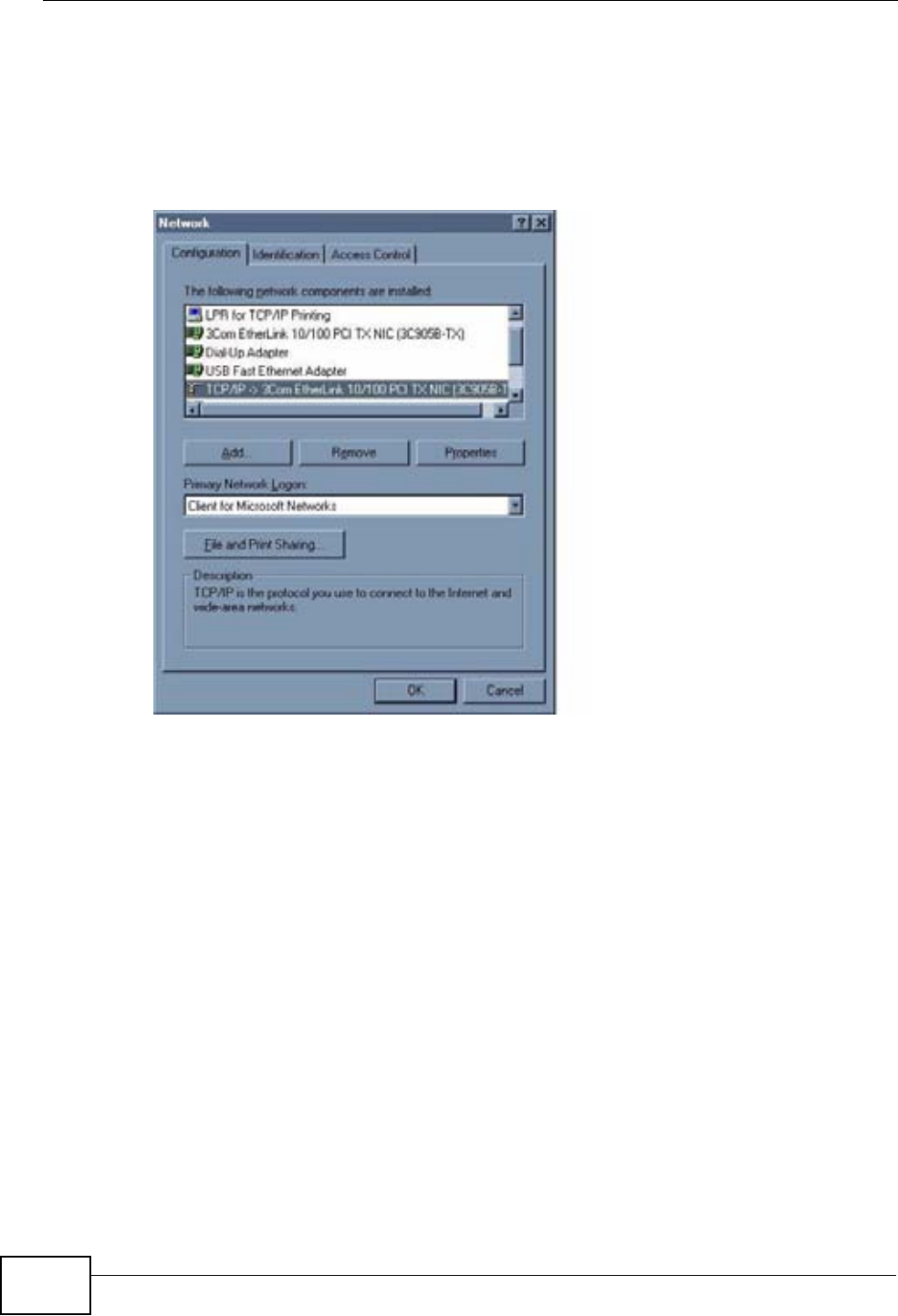
Appendix C Setting up Your Computer’s IP Address
P-320W v3 User’s Guide
218
Windows 95/98/Me
Click Start,Settings,Control Panel and double-click the Network icon to open
the Network window.
Figure 124 WIndows 95/98/Me: Network: Configuration
Installing Components
The Network window Configuration tab displays a list of installed components.
You need a network adapter, the TCP/IP protocol and Client for Microsoft
Networks.
If you need the adapter:
1In the Network window, click Add.
2Select Adapter and then click Add.
3Select the manufacturer and model of your network adapter and then click OK.
If you need TCP/IP:
1In the Network window, click Add.
2Select Protocol and then click Add.
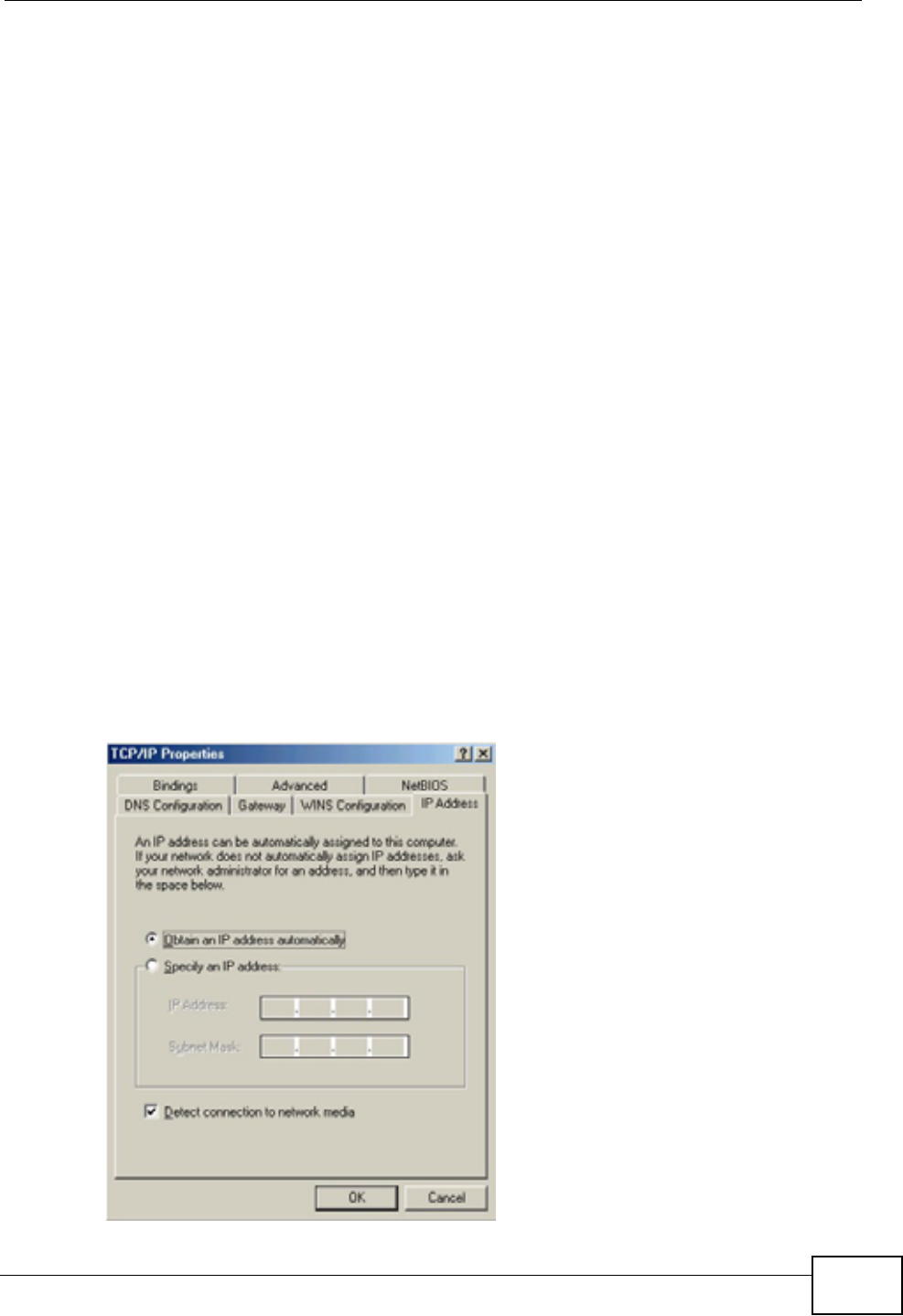
Appendix C Setting up Your Computer’s IP Address
P-320W v3 User’s Guide 219
3Select Microsoft from the list of manufacturers.
4Select TCP/IP from the list of network protocols and then click OK.
If you need Client for Microsoft Networks:
1Click Add.
2Select Client and then click Add.
3Select Microsoft from the list of manufacturers.
4Select Client for Microsoft Networks from the list of network clients and then
click OK.
5Restart your computer so the changes you made take effect.
Configuring
1In the Network window Configuration tab, select your network adapter's TCP/IP
entry and click Properties
2Click the IP Address tab.
• If your IP address is dynamic, select Obtain an IP address automatically.
• If you have a static IP address, select Specify an IP address and type your
information into the IP Address and Subnet Mask fields.
Figure 125 Windows 95/98/Me: TCP/IP Properties: IP Address
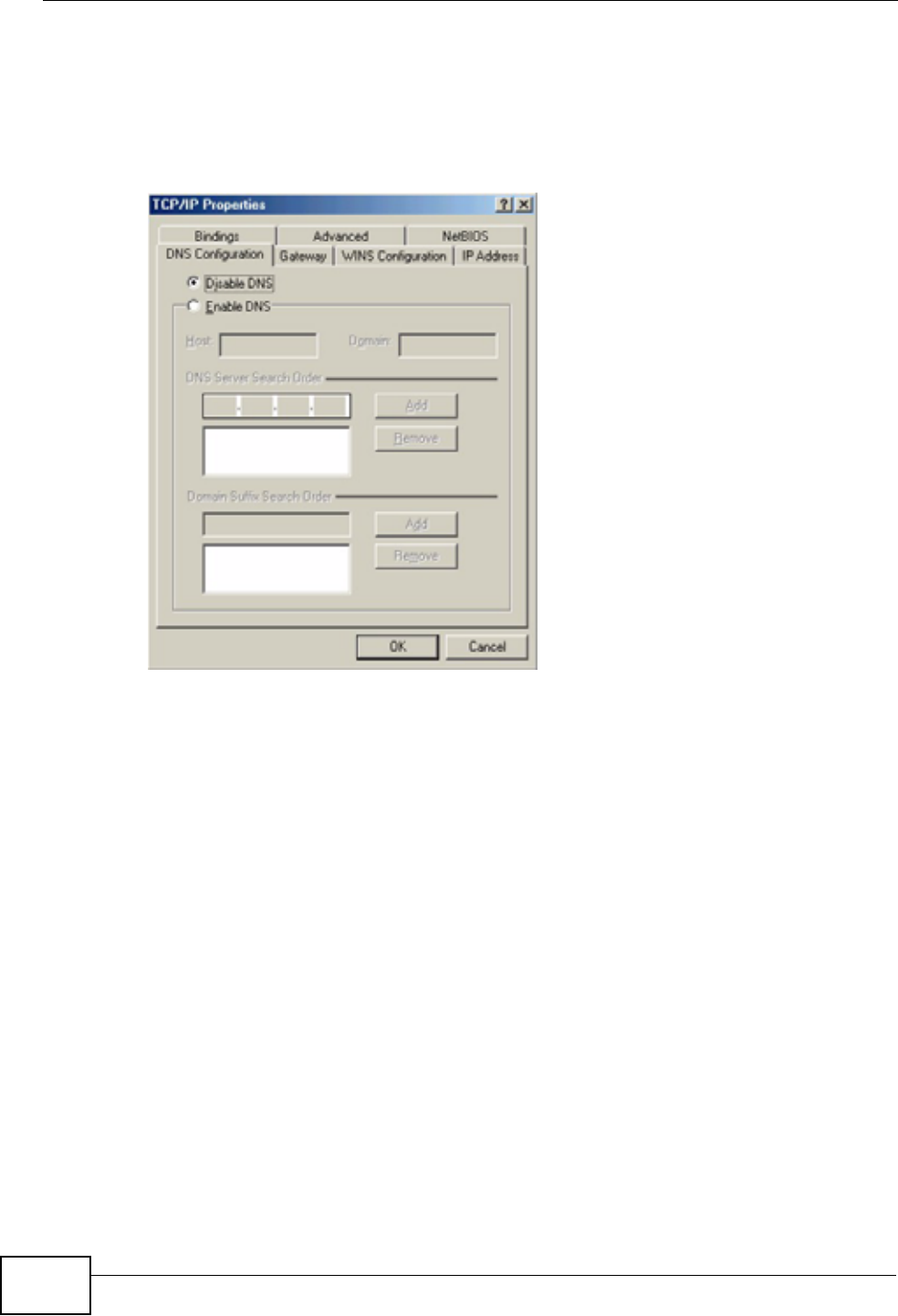
Appendix C Setting up Your Computer’s IP Address
P-320W v3 User’s Guide
220
3Click the DNS Configuration tab.
• If you do not know your DNS information, select Disable DNS.
• If you know your DNS information, select Enable DNS and type the
information in the fields below (you may not need to fill them all in).
Figure 126 Windows 95/98/Me: TCP/IP Properties: DNS Configuration
4Click the Gateway tab.
• If you do not know your gateway’s IP address, remove previously installed
gateways.
• If you have a gateway IP address, type it in the New gateway field and click
Add.
5Click OK to save and close the TCP/IP Properties window.
6Click OK to close the Network window. Insert the Windows CD if prompted.
7Turn on your Prestige and restart your computer when prompted.
Verifying Settings
1Click Start and then Run.
2In the Run window, type "winipcfg" and then click OK to open the IP
Configuration window.
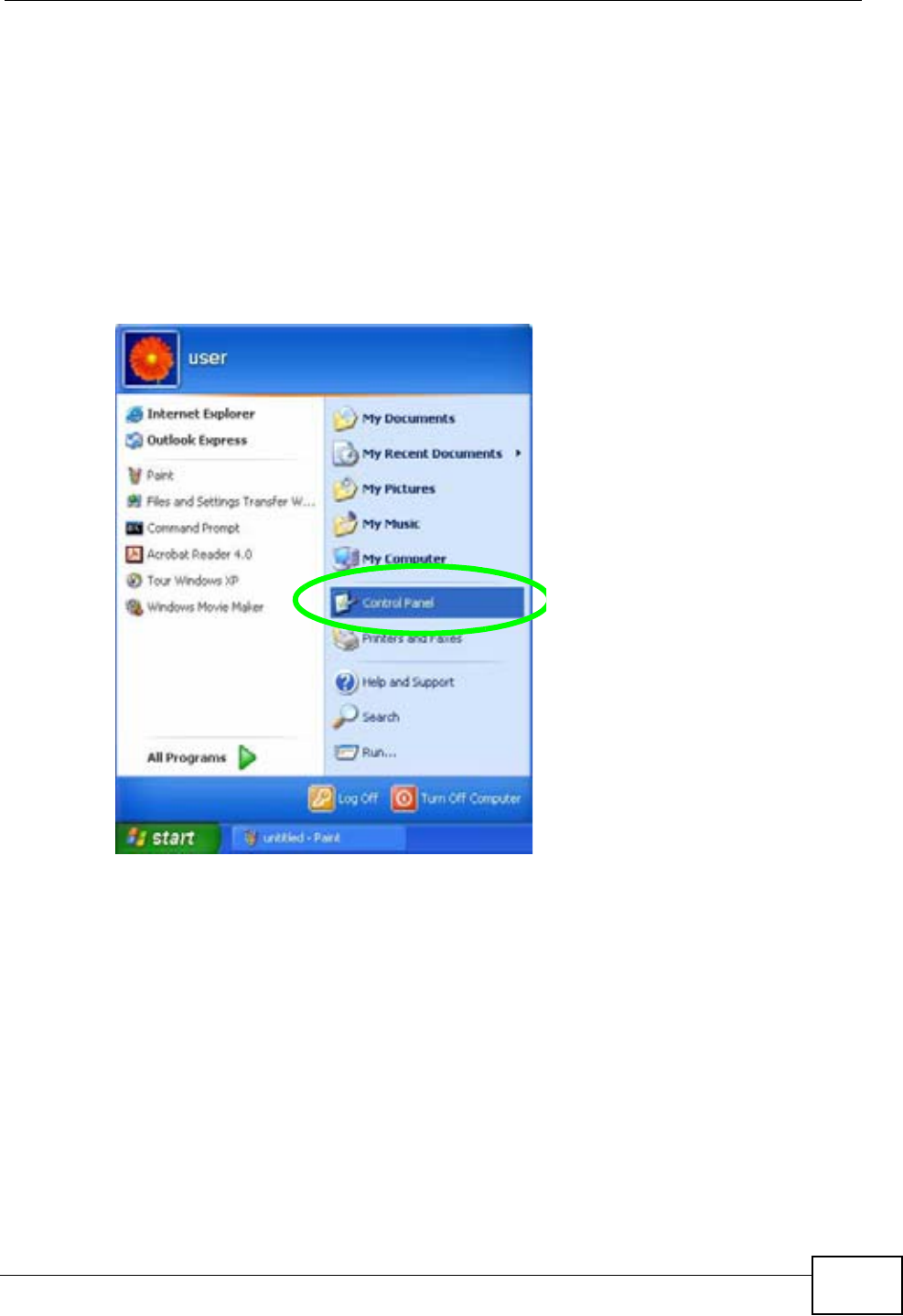
Appendix C Setting up Your Computer’s IP Address
P-320W v3 User’s Guide 221
3Select your network adapter. You should see your computer's IP address, subnet
mask and default gateway.
Windows 2000/NT/XP
The following example figures use the default Windows XP GUI theme.
1Click start (Start in Windows 2000/NT), Settings,Control Panel.
Figure 127 Windows XP: Start Menu
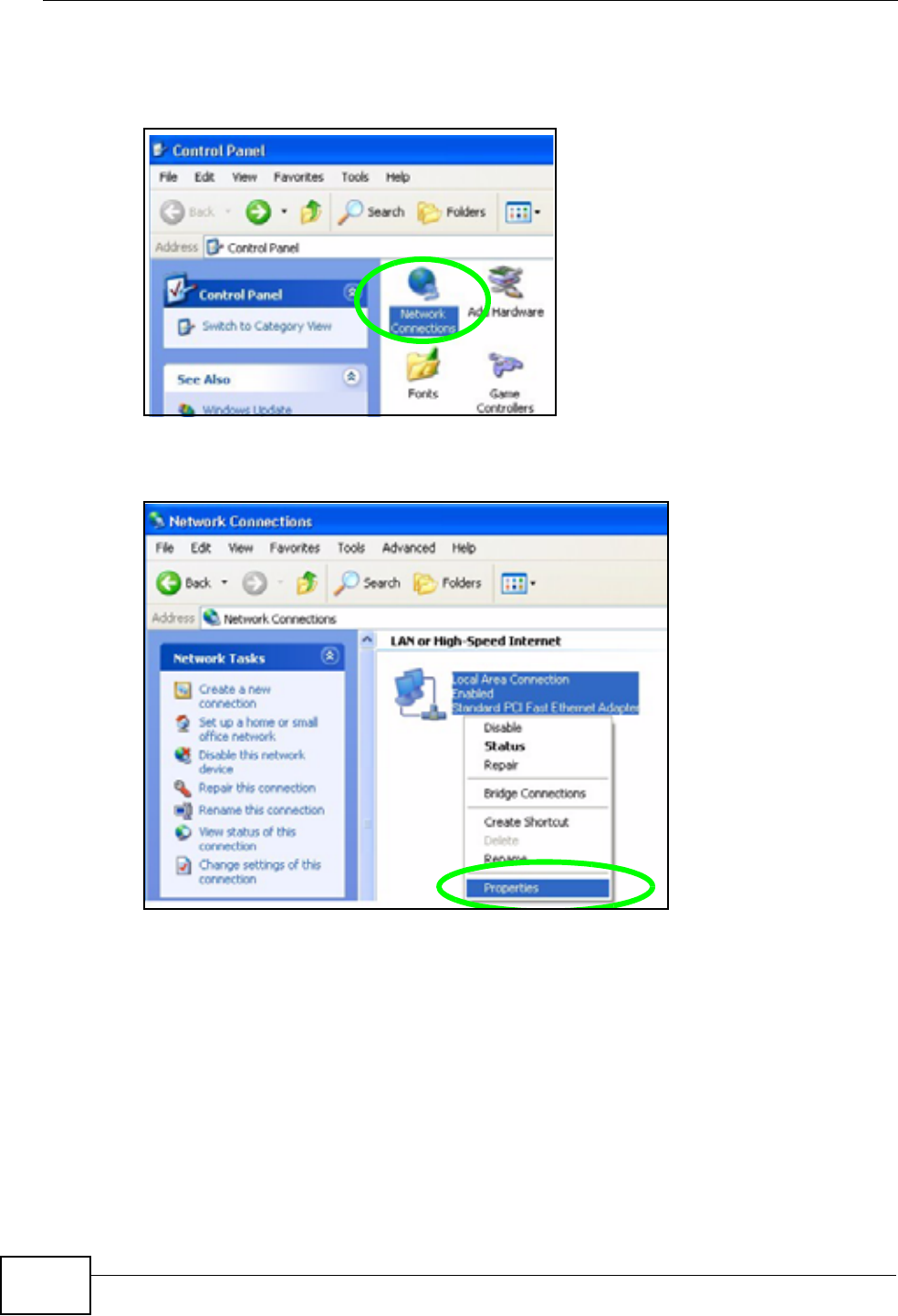
Appendix C Setting up Your Computer’s IP Address
P-320W v3 User’s Guide
222
2In the Control Panel, double-click Network Connections (Network and Dial-
up Connections in Windows 2000/NT).
Figure 128 Windows XP: Control Panel
3Right-click Local Area Connection and then click Properties.
Figure 129 Windows XP: Control Panel: Network Connections: Properties
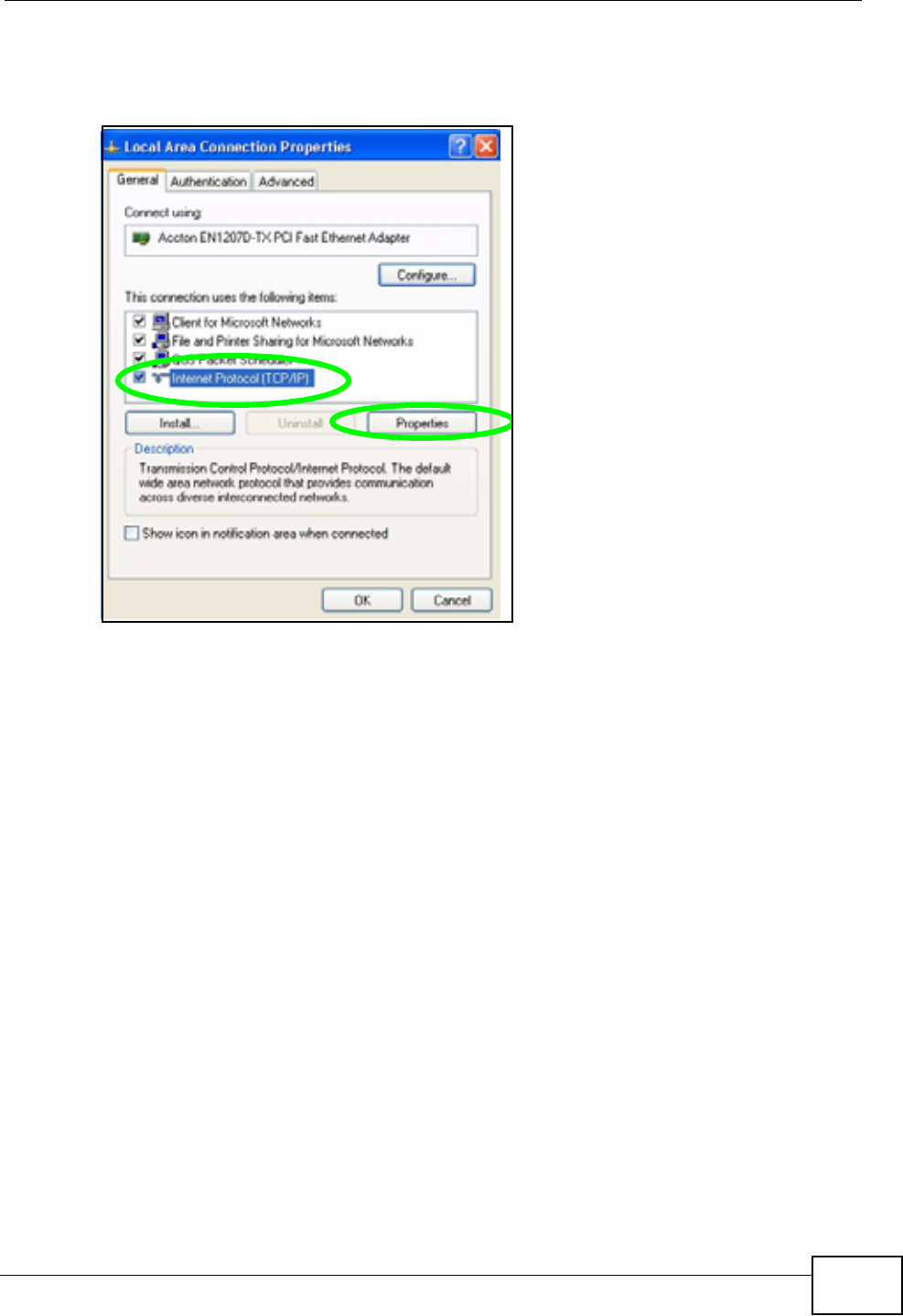
Appendix C Setting up Your Computer’s IP Address
P-320W v3 User’s Guide 223
4Select Internet Protocol (TCP/IP) (under the General tab in Win XP) and then
click Properties.
Figure 130 Windows XP: Local Area Connection Properties
5The Internet Protocol TCP/IP Properties window opens (the General tab in
Windows XP).
• If you have a dynamic IP address click Obtain an IP address
automatically.
• If you have a static IP address click Use the following IP Address and fill in
the IP address,Subnet mask, and Default gateway fields.
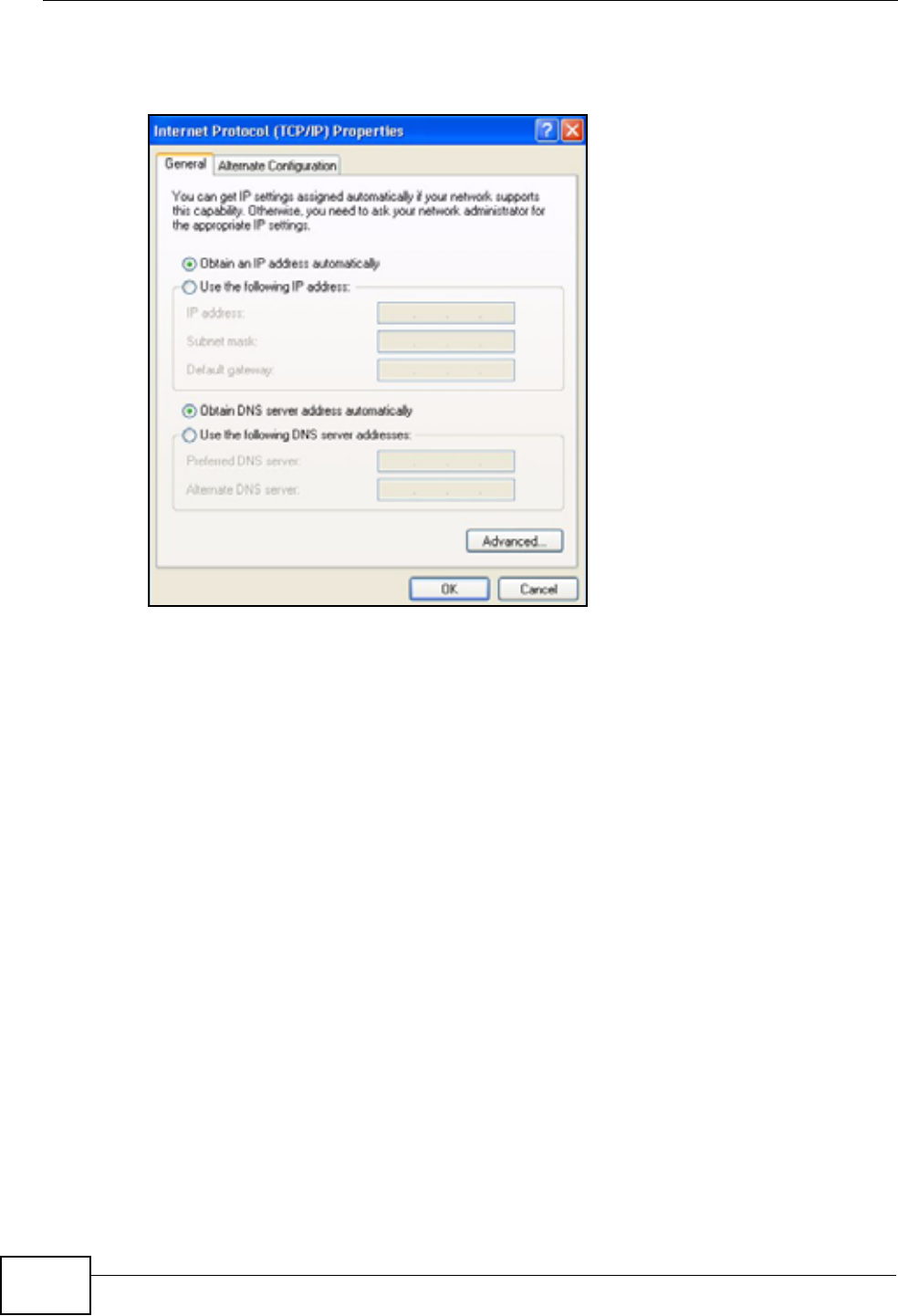
Appendix C Setting up Your Computer’s IP Address
P-320W v3 User’s Guide
224
•Click Advanced.
Figure 131 Windows XP: Internet Protocol (TCP/IP) Properties
6 If you do not know your gateway's IP address, remove any previously installed
gateways in the IP Settings tab and click OK.
Do one or more of the following if you want to configure additional IP addresses:
•In the IP Settings tab, in IP addresses, click Add.
•In TCP/IP Address, type an IP address in IP address and a subnet mask in
Subnet mask, and then click Add.
• Repeat the above two steps for each IP address you want to add.
• Configure additional default gateways in the IP Settings tab by clicking Add
in Default gateways.
•In TCP/IP Gateway Address, type the IP address of the default gateway in
Gateway. To manually configure a default metric (the number of transmission
hops), clear the Automatic metric check box and type a metric in Metric.
•Click Add.
• Repeat the previous three steps for each default gateway you want to add.
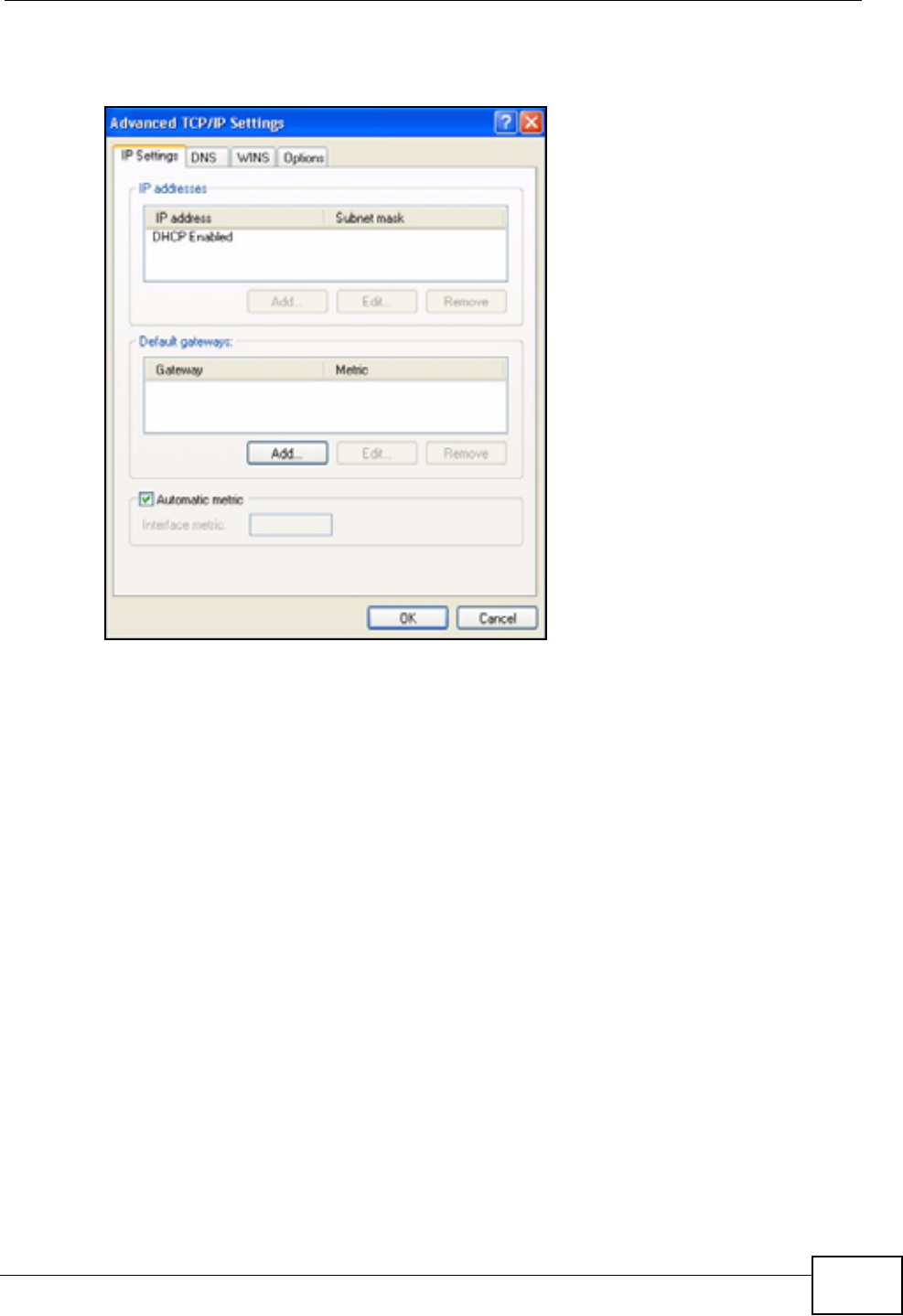
Appendix C Setting up Your Computer’s IP Address
P-320W v3 User’s Guide 225
•Click OK when finished.
Figure 132 Windows XP: Advanced TCP/IP Properties
7In the Internet Protocol TCP/IP Properties window (the General tab in
Windows XP):
•Click Obtain DNS server address automatically if you do not know your
DNS server IP address(es).
• If you know your DNS server IP address(es), click Use the following DNS
server addresses, and type them in the Preferred DNS server and
Alternate DNS server fields.
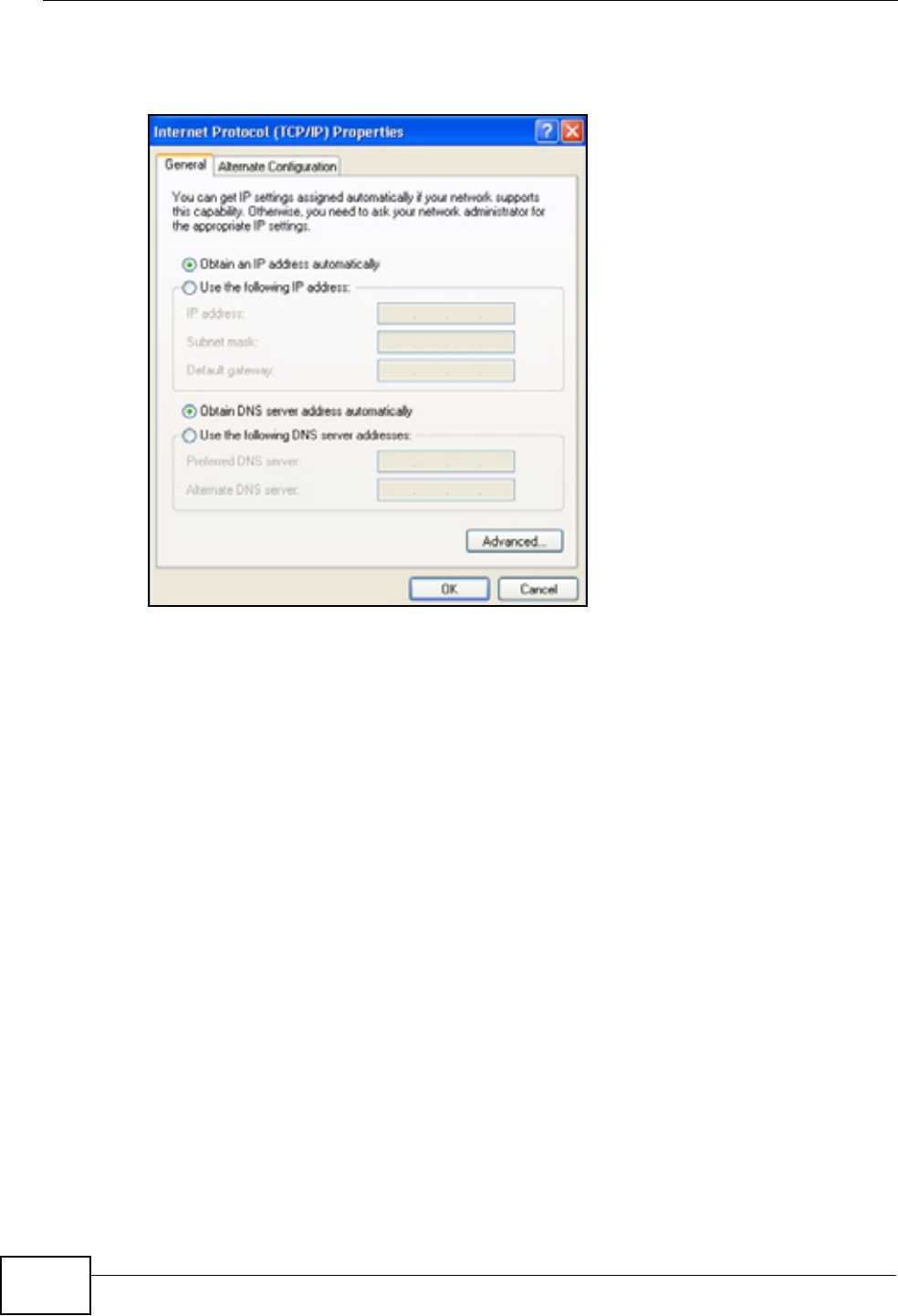
Appendix C Setting up Your Computer’s IP Address
P-320W v3 User’s Guide
226
If you have previously configured DNS servers, click Advanced and then the
DNS tab to order them.
Figure 133 Windows XP: Internet Protocol (TCP/IP) Properties
8Click OK to close the Internet Protocol (TCP/IP) Properties window.
9Click Close (OK in Windows 2000/NT) to close the Local Area Connection
Properties window.
10 Close the Network Connections window (Network and Dial-up Connections
in Windows 2000/NT).
11 Turn on your Prestige and restart your computer (if prompted).
Verifying Settings
1Click Start,All Programs,Accessories and then Command Prompt.
2In the Command Prompt window, type "ipconfig" and then press [ENTER]. You
can also open Network Connections, right-click a network connection, click
Status and then click the Support tab.
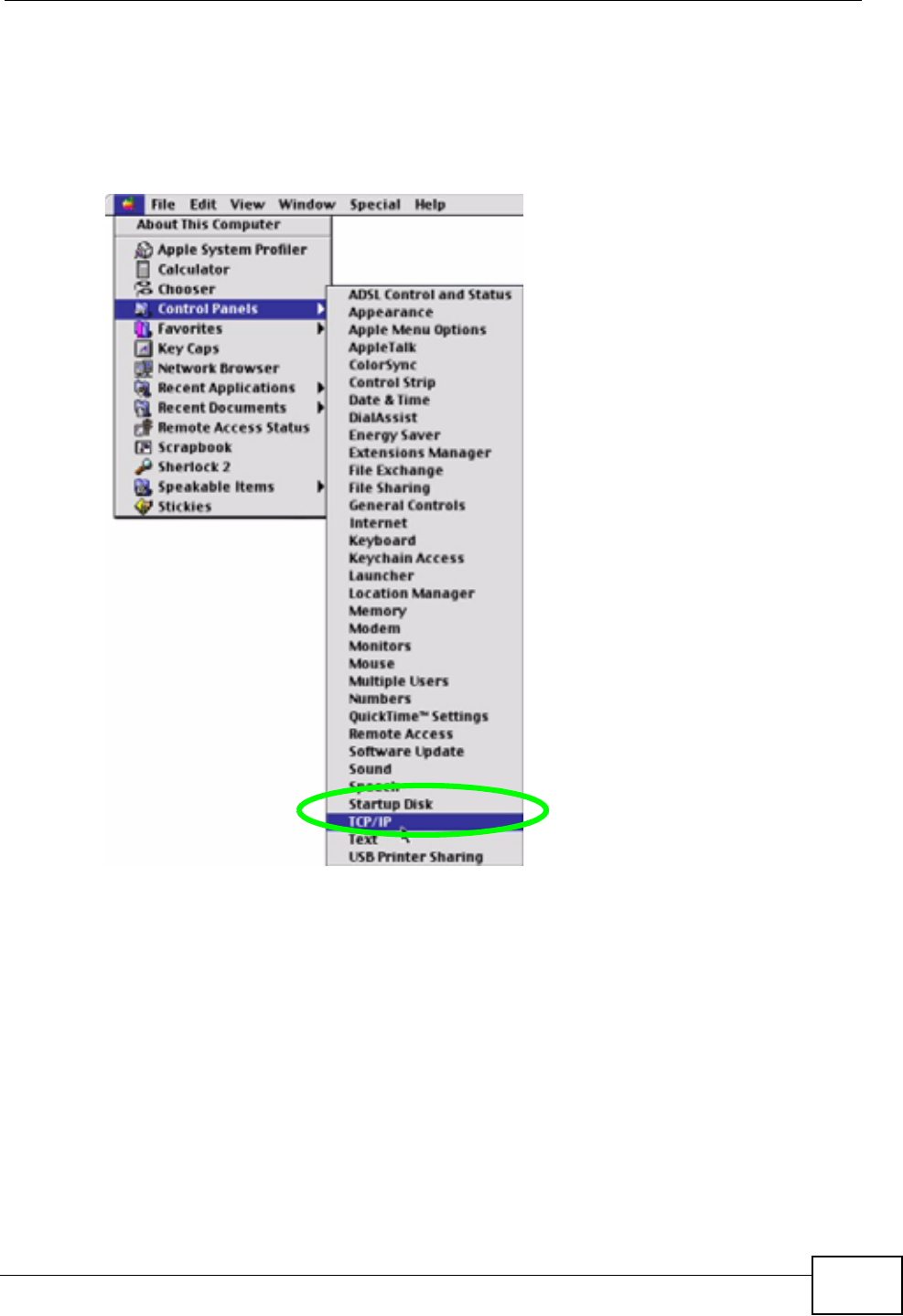
Appendix C Setting up Your Computer’s IP Address
P-320W v3 User’s Guide 227
Macintosh OS 8/9
1Click the Apple menu, Control Panel and double-click TCP/IP to open the TCP/
IP Control Panel.
Figure 134 Macintosh OS 8/9: Apple Menu
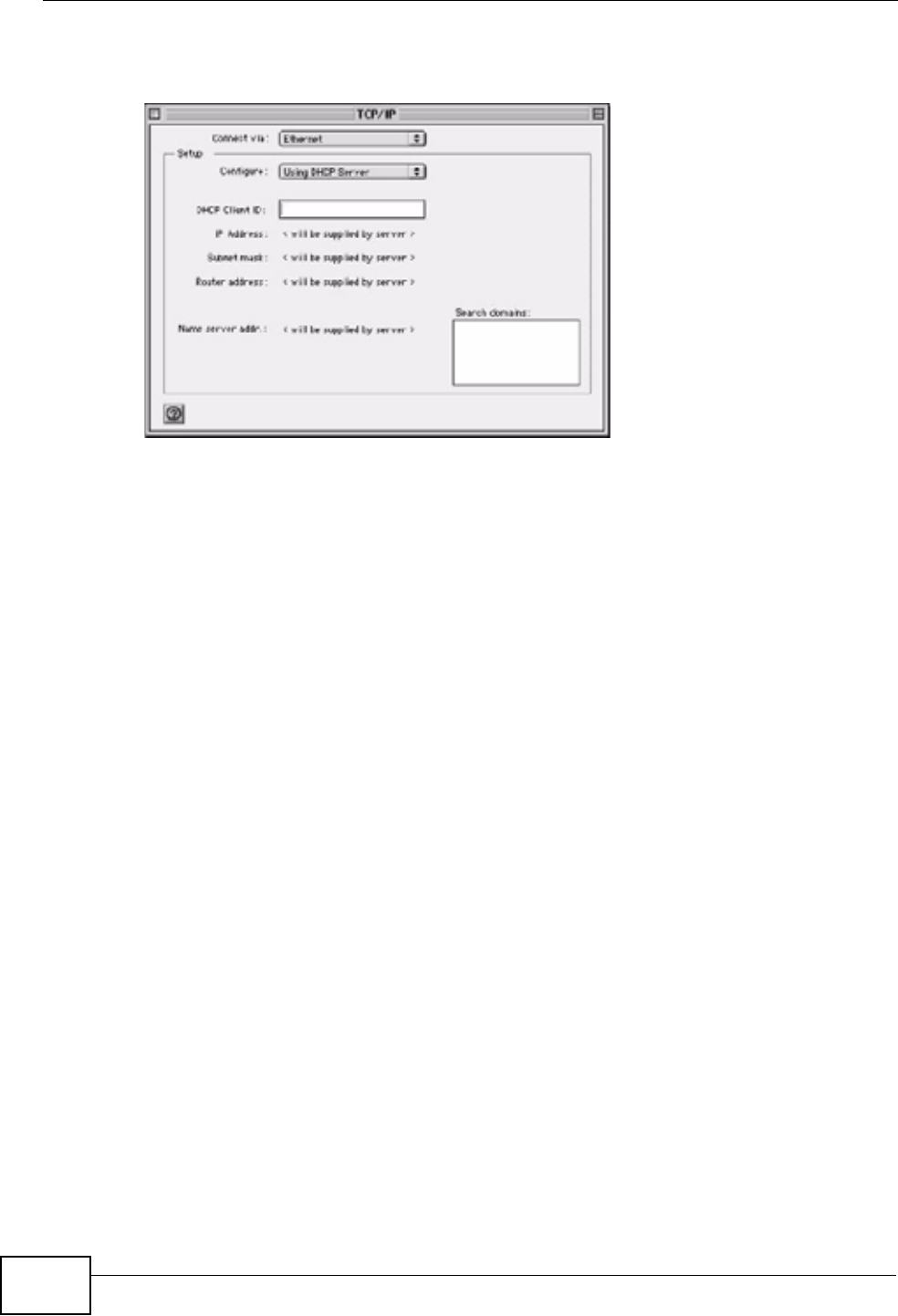
Appendix C Setting up Your Computer’s IP Address
P-320W v3 User’s Guide
228
2Select Ethernet built-in from the Connect via list.
Figure 135 Macintosh OS 8/9: TCP/IP
3For dynamically assigned settings, select Using DHCP Server from the
Configure: list.
4For statically assigned settings, do the following:
•From the Configure box, select Manually.
• Type your IP address in the IP Address box.
• Type your subnet mask in the Subnet mask box.
• Type the IP address of your Prestige in the Router address box.
5Close the TCP/IP Control Panel.
6Click Save if prompted, to save changes to your configuration.
7Turn on your Prestige and restart your computer (if prompted).
Verifying Settings
Check your TCP/IP properties in the TCP/IP Control Panel window.
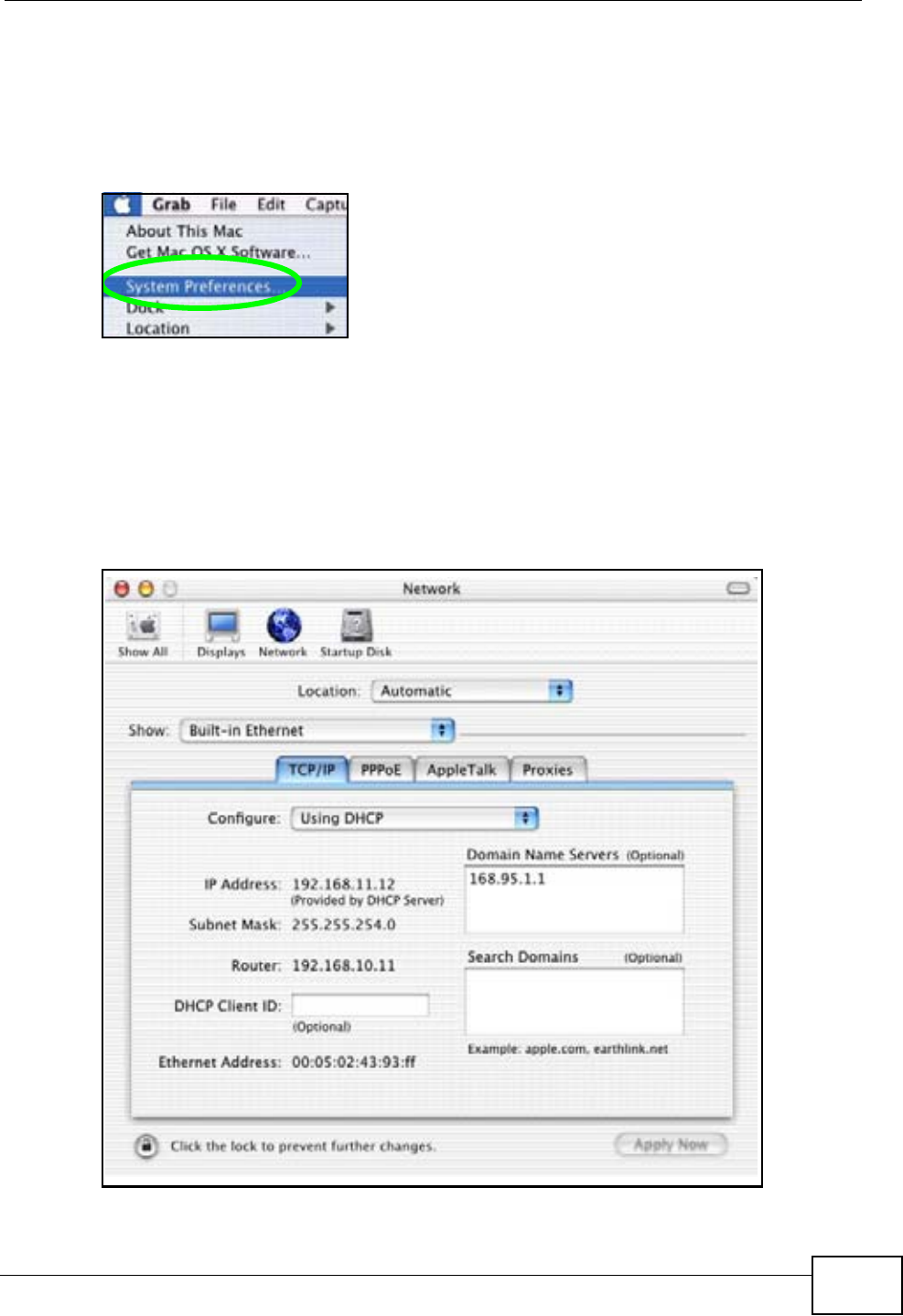
Appendix C Setting up Your Computer’s IP Address
P-320W v3 User’s Guide 229
Macintosh OS X
1Click the Apple menu, and click System Preferences to open the System
Preferences window.
Figure 136 Macintosh OS X: Apple Menu
2Click Network in the icon bar.
• Select Automatic from the Location list.
• Select Built-in Ethernet from the Show list.
•Click the TCP/IP tab.
3For dynamically assigned settings, select Using DHCP from the Configure list.
Figure 137 Macintosh OS X: Network
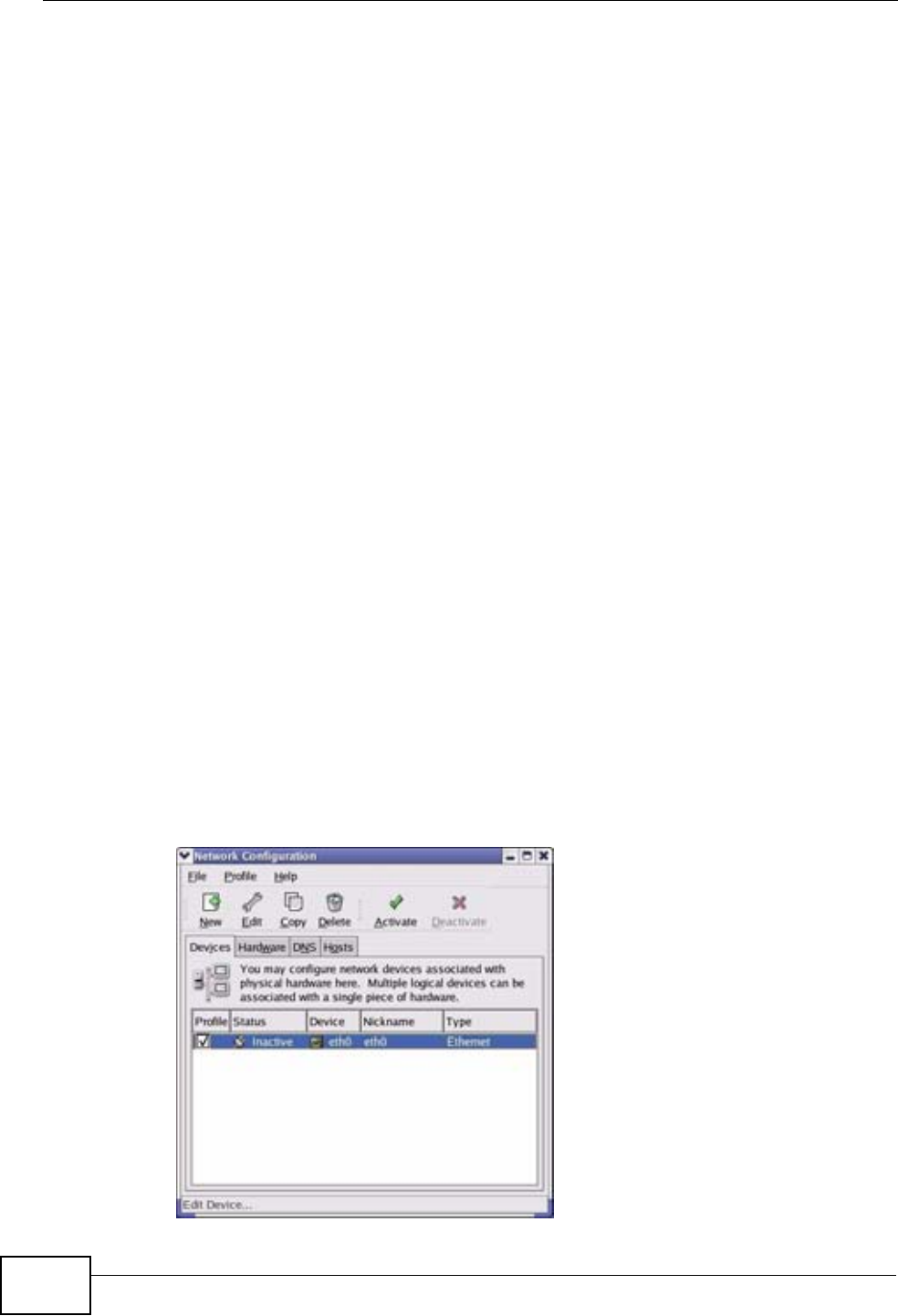
Appendix C Setting up Your Computer’s IP Address
P-320W v3 User’s Guide
230
4For statically assigned settings, do the following:
•From the Configure box, select Manually.
• Type your IP address in the IP Address box.
• Type your subnet mask in the Subnet mask box.
• Type the IP address of your Prestige in the Router address box.
5Click Apply Now and close the window.
6Turn on your Prestige and restart your computer (if prompted).
Verifying Settings
Check your TCP/IP properties in the Network window.
Linux
This section shows you how to configure your computer’s TCP/IP settings in Red
Hat Linux 9.0. Procedure, screens and file location may vary depending on your
Linux distribution and release version.
Note: Make sure you are logged in as the root administrator.
Using the K Desktop Environment (KDE)
Follow the steps below to configure your computer IP address using the KDE.
1Click the Red Hat button (located on the bottom left corner), select System
Setting and click Network.
Figure 138 Red Hat 9.0: KDE: Network Configuration: Devices
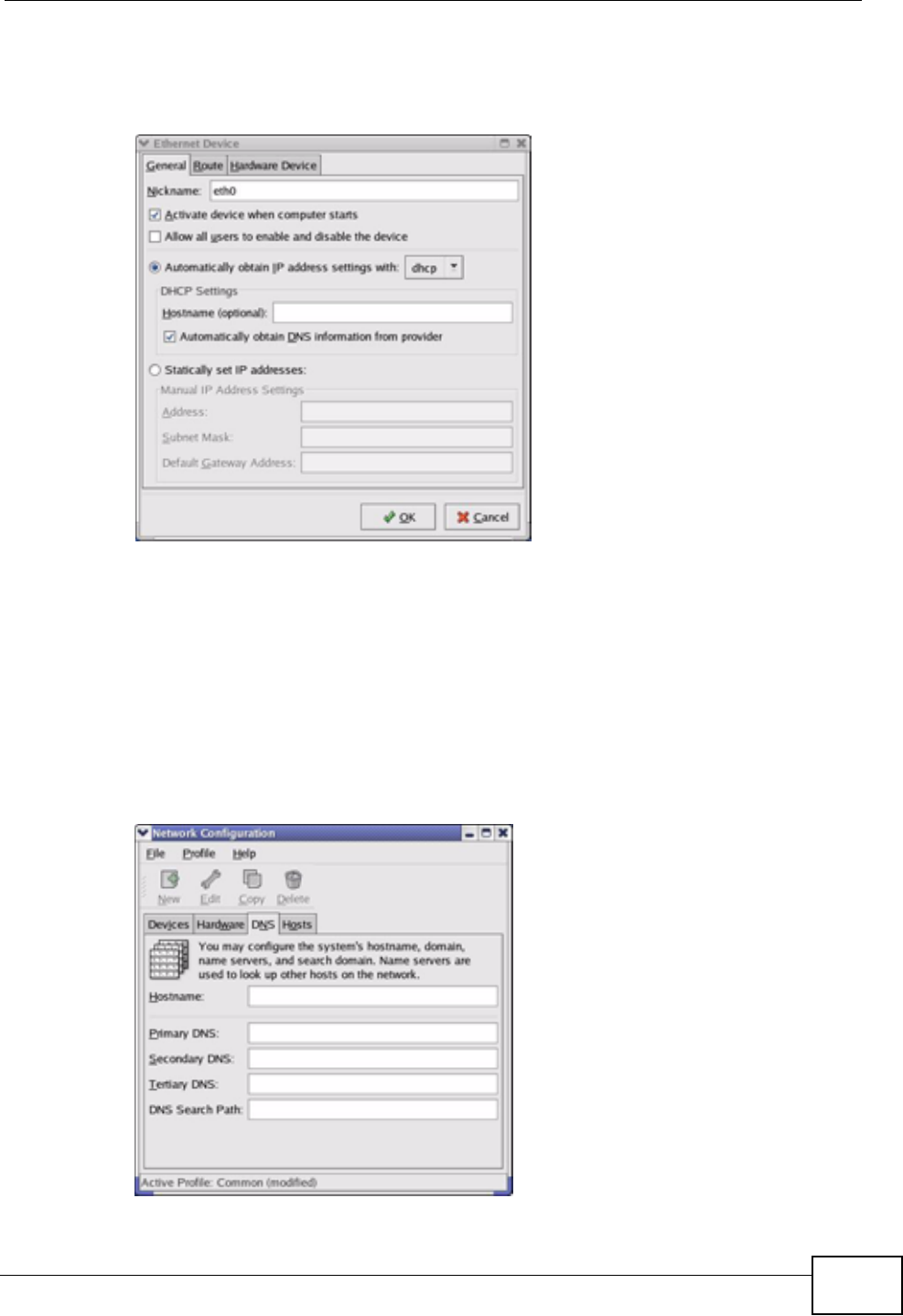
Appendix C Setting up Your Computer’s IP Address
P-320W v3 User’s Guide 231
2Double-click on the profile of the network card you wish to configure. The
Ethernet Device General screen displays as shown.
Figure 139 Red Hat 9.0: KDE: Ethernet Device: General
• If you have a dynamic IP address click Automatically obtain IP address
settings with and select dhcp from the drop down list.
• If you have a static IP address click Statically set IP Addresses and fill in
the Address,Subnet mask, and Default Gateway Address fields.
3Click OK to save the changes and close the Ethernet Device General screen.
4If you know your DNS server IP address(es), click the DNS tab in the Network
Configuration screen. Enter the DNS server information in the fields provided.
Figure 140 Red Hat 9.0: KDE: Network Configuration: DNS
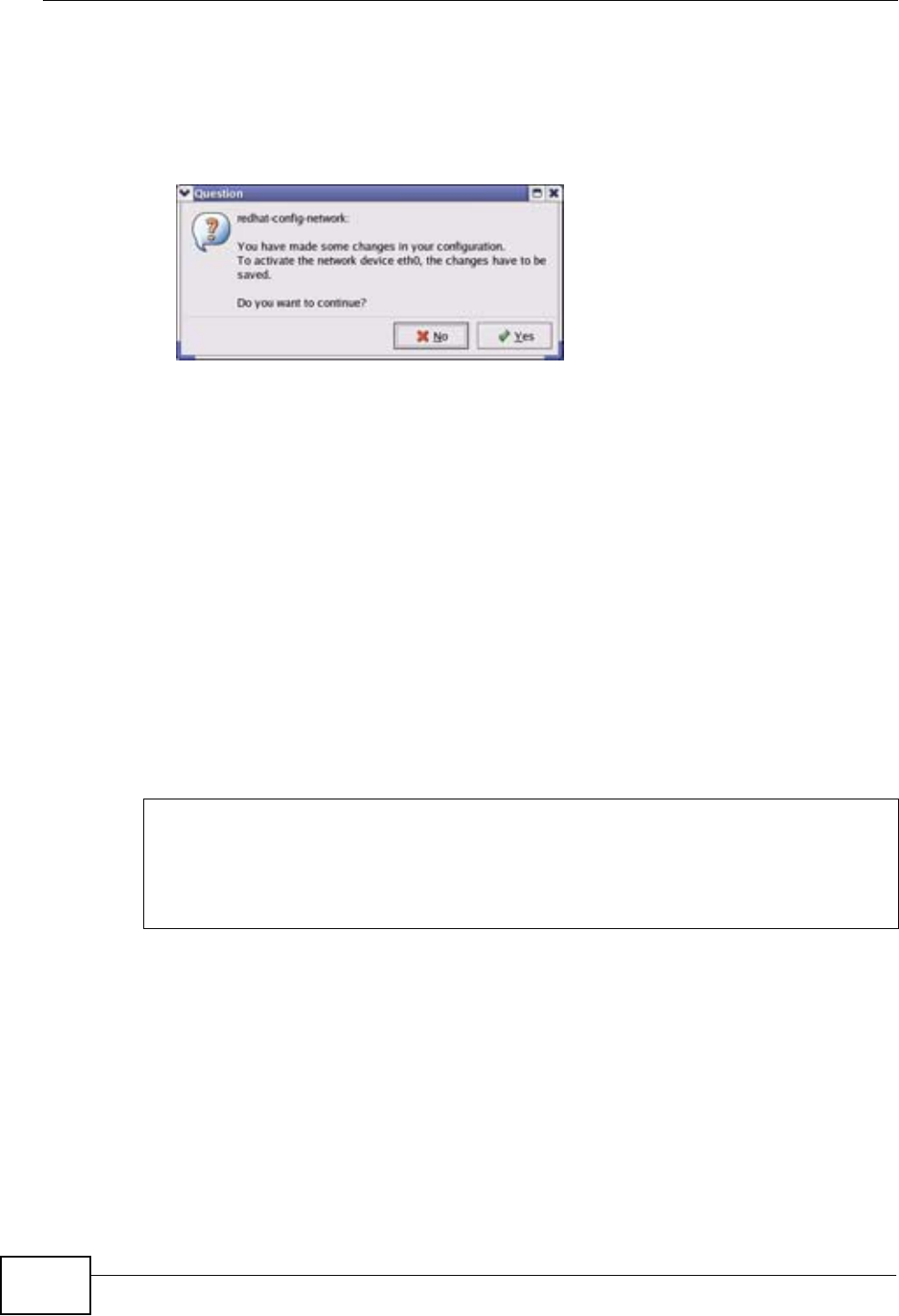
Appendix C Setting up Your Computer’s IP Address
P-320W v3 User’s Guide
232
5Click the Devices tab.
6Click the Activate button to apply the changes. The following screen displays.
Click Yes to save the changes in all screens.
Figure 141 Red Hat 9.0: KDE: Network Configuration: Activate
7After the network card restart process is complete, make sure the Status is
Active in the Network Configuration screen.
Using Configuration Files
Follow the steps below to edit the network configuration files and set your
computer IP address.
1Assuming that you have only one network card on the computer, locate the
ifconfig-eth0 configuration file (where eth0 is the name of the Ethernet card).
Open the configuration file with any plain text editor.
• If you have a dynamic IP address, enter dhcp in the BOOTPROTO= field. The
following figure shows an example.
Figure 142 Red Hat 9.0: Dynamic IP Address Setting in ifconfig-eth0
DEVICE=eth0
ONBOOT=yes
BOOTPROTO=dhcp
USERCTL=no
PEERDNS=yes
TYPE=Ethernet

Appendix C Setting up Your Computer’s IP Address
P-320W v3 User’s Guide 233
• If you have a static IP address, enter static in the BOOTPROTO= field. Type
IPADDR= followed by the IP address (in dotted decimal notation) and type
NETMASK= followed by the subnet mask. The following example shows an
example where the static IP address is 192.168.1.10 and the subnet mask is
255.255.255.0.
Figure 143 Red Hat 9.0: Static IP Address Setting in ifconfig-eth0
2If you know your DNS server IP address(es), enter the DNS server information in
the resolv.conf file in the /etc directory. The following figure shows an example
where two DNS server IP addresses are specified.
Figure 144 Red Hat 9.0: DNS Settings in resolv.conf
3After you edit and save the configuration files, you must restart the network card.
Enter./network restart in the /etc/rc.d/init.d directory. The following figure
shows an example.
Figure 145 Red Hat 9.0: Restart Ethernet Card
DEVICE=eth0
ONBOOT=yes
BOOTPROTO=static
IPADDR=192.168.1.10
NETMASK=255.255.255.0
USERCTL=no
PEERDNS=yes
TYPE=Ethernet
nameserver 172.23.5.1
nameserver 172.23.5.2
[root@localhost init.d]# network restart
Shutting down interface eth0: [OK]
Shutting down loopback interface: [OK]
Setting network parameters: [OK]
Bringing up loopback interface: [OK]
Bringing up interface eth0: [OK]

Appendix C Setting up Your Computer’s IP Address
P-320W v3 User’s Guide
234
21.0.1 Verifying Settings
Enter ifconfig in a terminal screen to check your TCP/IP properties.
Figure 146 Red Hat 9.0: Checking TCP/IP Properties
[root@localhost]# ifconfig
eth0 Link encap:Ethernet HWaddr 00:50:BA:72:5B:44
inet addr:172.23.19.129 Bcast:172.23.19.255 Mask:255.255.255.0
UP BROADCAST RUNNING MULTICAST MTU:1500 Metric:1
RX packets:717 errors:0 dropped:0 overruns:0 frame:0
TX packets:13 errors:0 dropped:0 overruns:0 carrier:0
collisions:0 txqueuelen:100
RX bytes:730412 (713.2 Kb) TX bytes:1570 (1.5 Kb)
Interrupt:10 Base address:0x1000
[root@localhost]#

P-320W v3 User’s Guide 235
APPENDIX D
Wireless LANs
Wireless LAN Topologies
This section discusses ad-hoc and infrastructure wireless LAN topologies.
Ad-hoc Wireless LAN Configuration
The simplest WLAN configuration is an independent (Ad-hoc) WLAN that connects
a set of computers with wireless stations (A, B, C). Any time two or more wireless
adapters are within range of each other, they can set up an independent network,
which is commonly referred to as an Ad-hoc network or Independent Basic Service
Set (IBSS). The following diagram shows an example of notebook computers
using wireless adapters to form an Ad-hoc wireless LAN.
Figure 147 Peer-to-Peer Communication in an Ad-hoc Network
BSS
A Basic Service Set (BSS) exists when all communications between wireless
stations or between a wireless station and a wired network client go through one
access point (AP).
Intra-BSS traffic is traffic between wireless stations in the BSS. When Intra-BSS is
enabled, wireless station A and B can access the wired network and communicate
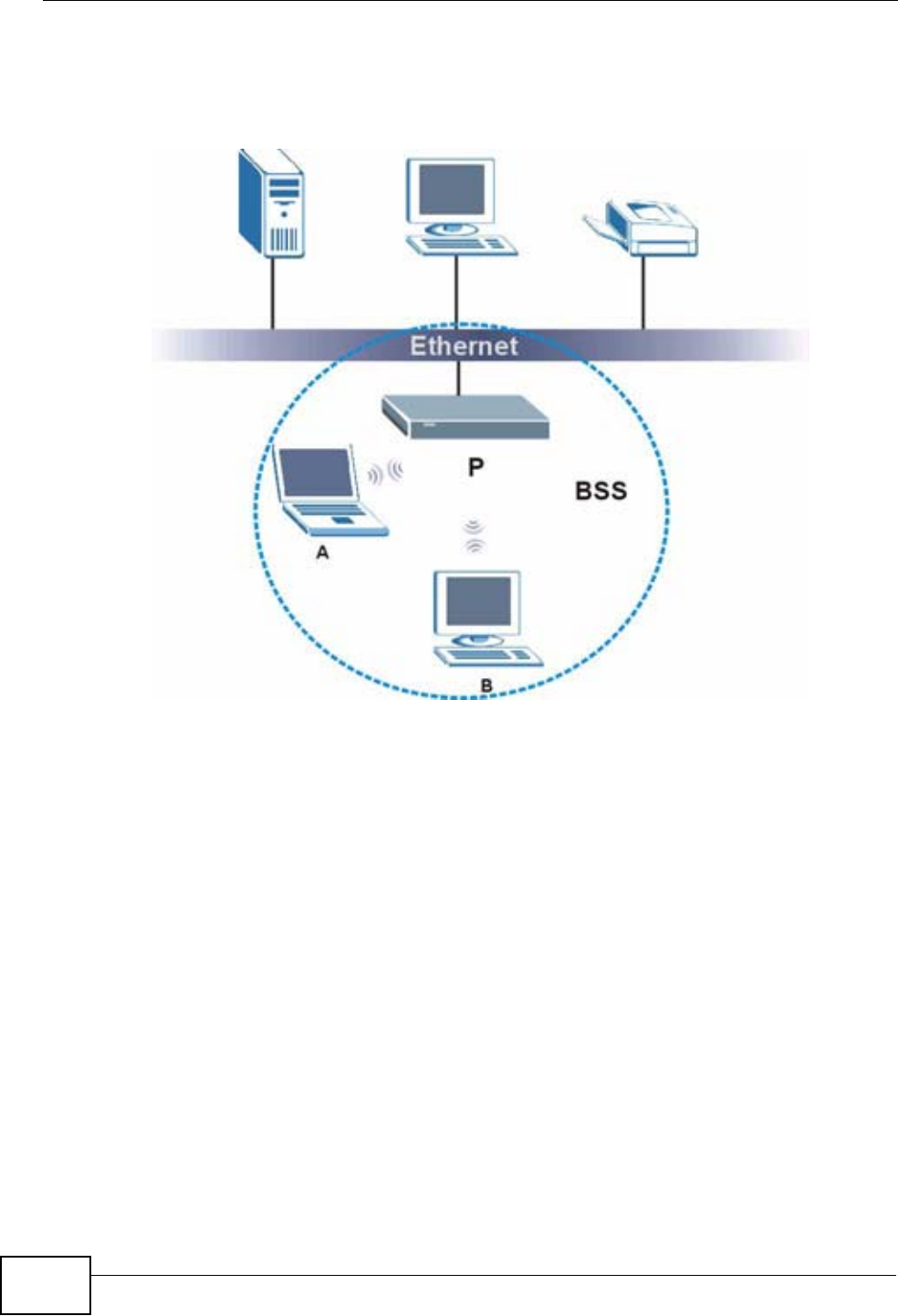
Appendix D Wireless LANs
P-320W v3 User’s Guide
236
with each other. When Intra-BSS is disabled, wireless station A and B can still
access the wired network but cannot communicate with each other.
Figure 148 Basic Service Set
ESS
An Extended Service Set (ESS) consists of a series of overlapping BSSs, each
containing an access point, with each access point connected together by a wired
network. This wired connection between APs is called a Distribution System (DS).
This type of wireless LAN topology is called an Infrastructure WLAN. The Access
Points not only provide communication with the wired network but also mediate
wireless network traffic in the immediate neighborhood.
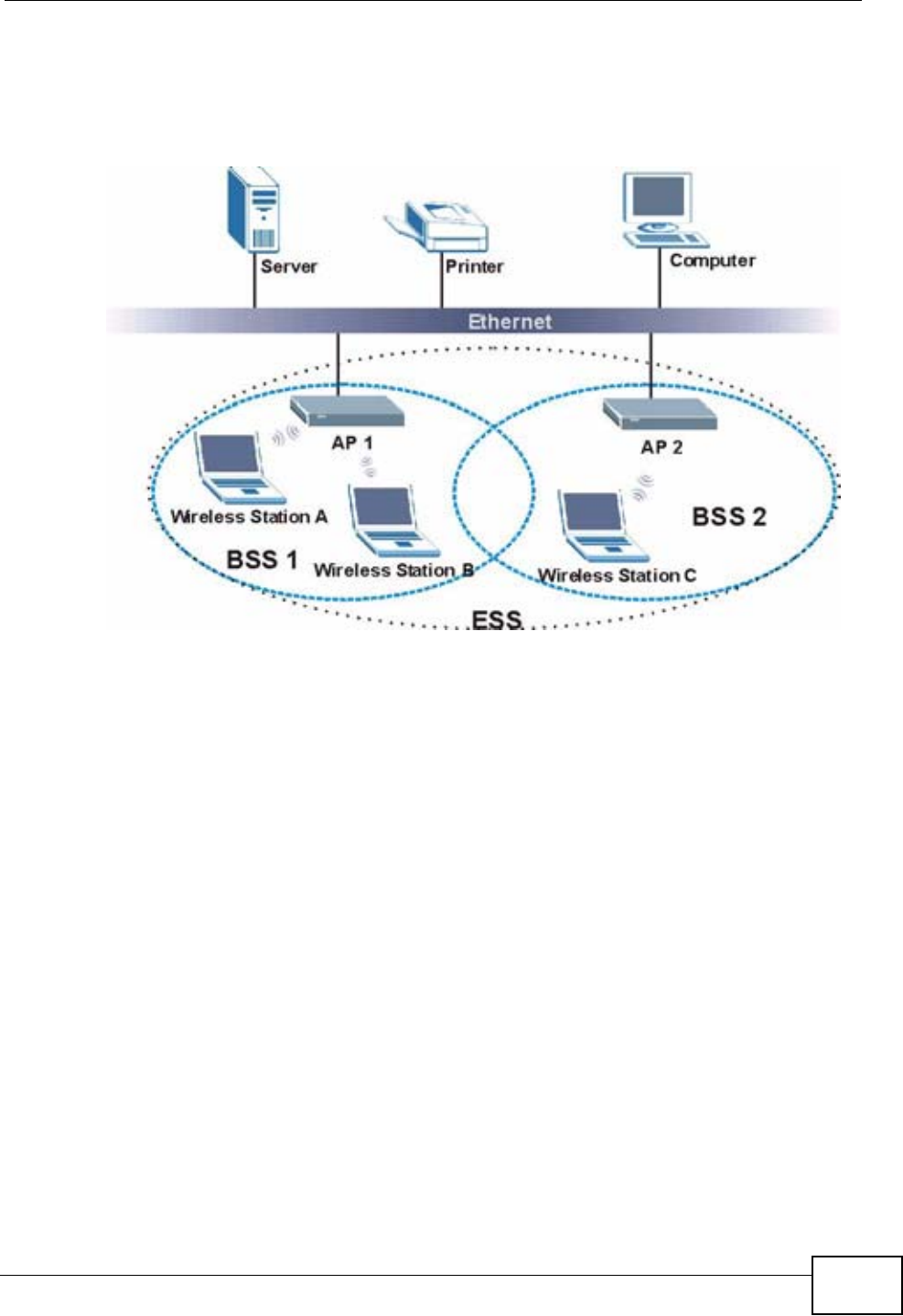
Appendix D Wireless LANs
P-320W v3 User’s Guide 237
An ESSID (ESS IDentification) uniquely identifies each ESS. All access points and
their associated wireless stations within the same ESS must have the same ESSID
in order to communicate.
Figure 149 Infrastructure WLAN
Channel
A channel is the radio frequency(ies) used by IEEE 802.11a/b/g wireless devices.
Channels available depend on your geographical area. You may have a choice of
channels (for your region) so you should use a different channel than an adjacent
AP (access point) to reduce interference. Interference occurs when radio signals
from different access points overlap causing interference and degrading
performance.
Adjacent channels partially overlap however. To avoid interference due to overlap,
your AP should be on a channel at least five channels away from a channel that an
adjacent AP is using. For example, if your region has 11 channels and an adjacent
AP is using channel 1, then you need to select a channel between 6 or 11.
Note: To comply with US FCC regulation, the country selection function has been
completely removed from all US models. The above function is for non-US
models only.
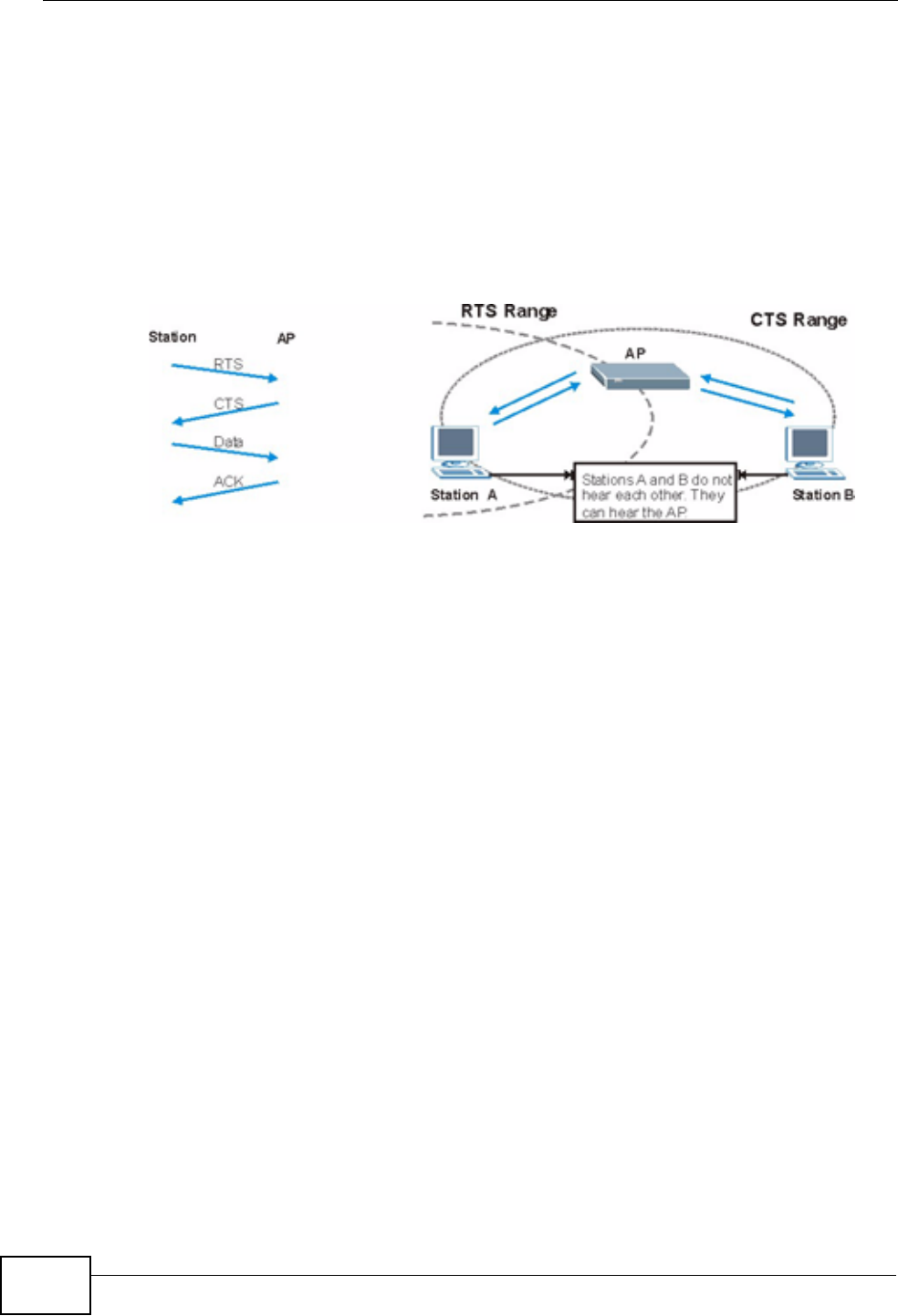
Appendix D Wireless LANs
P-320W v3 User’s Guide
238
RTS/CTS
A hidden node occurs when two stations are within range of the same access
point, but are not within range of each other. The following figure illustrates a
hidden node. Both stations (STA) are within range of the access point (AP) or
wireless gateway, but out-of-range of each other, so they cannot "hear" each
other, that is they do not know if the channel is currently being used. Therefore,
they are considered hidden from each other.
Figure 150 RTS/CTS
When station A sends data to the AP, it might not know that the station B is
already using the channel. If these two stations send data at the same time,
collisions may occur when both sets of data arrive at the AP at the same time,
resulting in a loss of messages for both stations.
RTS/CTS is designed to prevent collisions due to hidden nodes. An RTS/CTS
defines the biggest size data frame you can send before an RTS (Request To
Send)/CTS (Clear to Send) handshake is invoked.
When a data frame exceeds the RTS/CTS value you set (between 0 to 2432
bytes), the station that wants to transmit this frame must first send an RTS
(Request To Send) message to the AP for permission to send it. The AP then
responds with a CTS (Clear to Send) message to all other stations within its range
to notify them to defer their transmission. It also reserves and confirms with the
requesting station the time frame for the requested transmission.
Stations can send frames smaller than the specified RTS/CTS directly to the AP
without the RTS (Request To Send)/CTS (Clear to Send) handshake.
You should only configure RTS/CTS if the possibility of hidden nodes exists on
your network and the "cost" of resending large frames is more than the extra
network overhead involved in the RTS (Request To Send)/CTS (Clear to Send)
handshake.
If the RTS/CTS value is greater than the Fragmentation Threshold value (see
next), then the RTS (Request To Send)/CTS (Clear to Send) handshake will never
occur as data frames will be fragmented before they reach RTS/CTS size.

Appendix D Wireless LANs
P-320W v3 User’s Guide 239
Note: Enabling the RTS Threshold causes redundant network overhead that could
negatively affect the throughput performance instead of providing a remedy.
Fragmentation Threshold
AFragmentation Threshold is the maximum data fragment size (between 256
and 2432 bytes) that can be sent in the wireless network before the AP will
fragment the packet into smaller data frames.
A large Fragmentation Threshold is recommended for networks not prone to
interference while you should set a smaller threshold for busy networks or
networks that are prone to interference.
If the Fragmentation Threshold value is smaller than the RTS/CTS value (see
previously) you set then the RTS (Request To Send)/CTS (Clear to Send)
handshake will never occur as data frames will be fragmented before they reach
RTS/CTS size.
Preamble Type
A preamble is used to synchronize the transmission timing in your wireless
network. There are two preamble modes: Long and Short.
Short preamble takes less time to process and minimizes overhead, so it should
be used in a good wireless network environment when all wireless stations
support it.
Select Long if you have a ‘noisy’ network or are unsure of what preamble mode
your wireless stations support as all IEEE 802.11b compliant wireless adapters
must support long preamble. However, not all wireless adapters support short
preamble. Use long preamble if you are unsure what preamble mode the wireless
adapters support, to ensure interpretability between the AP and the wireless
stations and to provide more reliable communication in ‘noisy’ networks.
Select Dynamic to have the AP automatically use short preamble when all
wireless stations support it, otherwise the AP uses long preamble.
Note: The AP and the wireless stations MUST use the same preamble mode in order
to communicate.
IEEE 802.11g Wireless LAN
IEEE 802.11g is fully compatible with the IEEE 802.11b standard. This means an
IEEE 802.11b adapter can interface directly with an IEEE 802.11g access point
(and vice versa) at 11 Mbps or lower depending on range. IEEE 802.11g has

Appendix D Wireless LANs
P-320W v3 User’s Guide
240
several intermediate rate steps between the maximum and minimum data rates.
The IEEE 802.11g data rate and modulation are as follows:
IEEE 802.1x
In June 2001, the IEEE 802.1x standard was designed to extend the features of
IEEE 802.11 to support extended authentication as well as providing additional
accounting and control features. It is supported by Windows XP and a number of
network devices. Some advantages of IEEE 802.1x are:
• User based identification that allows for roaming.
• Support for RADIUS (Remote Authentication Dial In User Service, RFC 2138,
2139) for centralized user profile and accounting management on a network
RADIUS server.
• Support for EAP (Extensible Authentication Protocol, RFC 2486) that allows
additional authentication methods to be deployed with no changes to the access
point or the wireless stations.
RADIUS
RADIUS is based on a client-server model that supports authentication,
authorization and accounting. The access point is the client and the server is the
RADIUS server. The RADIUS server handles the following tasks:
• Authentication
Determines the identity of the users.
• Authorization
Determines the network services available to authenticated users once they are
connected to the network.
•Accounting
Keeps track of the client’s network activity.
RADIUS is a simple package exchange in which your AP acts as a message relay
between the wireless station and the network RADIUS server.
Table 96 IEEE 802.11g
DATA RATE
(MBPS) MODULATION
1 DBPSK (Differential Binary Phase Shift Keyed)
2 DQPSK (Differential Quadrature Phase Shift Keying)
5.5 / 11 CCK (Complementary Code Keying)
6/9/12/18/24/36/
48/54
OFDM (Orthogonal Frequency Division Multiplexing)

Appendix D Wireless LANs
P-320W v3 User’s Guide 241
Types of RADIUS Messages
The following types of RADIUS messages are exchanged between the access point
and the RADIUS server for user authentication:
• Access-Request
Sent by an access point requesting authentication.
• Access-Reject
Sent by a RADIUS server rejecting access.
• Access-Accept
Sent by a RADIUS server allowing access.
• Access-Challenge
Sent by a RADIUS server requesting more information in order to allow access.
The access point sends a proper response from the user and then sends another
Access-Request message.
The following types of RADIUS messages are exchanged between the access point
and the RADIUS server for user accounting:
•Accounting-Request
Sent by the access point requesting accounting.
• Accounting-Response
Sent by the RADIUS server to indicate that it has started or stopped accounting.
In order to ensure network security, the access point and the RADIUS server use a
shared secret key, which is a password, they both know. The key is not sent over
the network. In addition to the shared key, password information exchanged is
also encrypted to protect the network from unauthorized access.
Types of Authentication
This appendix discusses some popular authentication types: EAP-MD5,EAP-TLS,
EAP-TTLS,PEAP and LEAP.
The type of authentication you use depends on the RADIUS server or the AP.
Consult your network administrator for more information.
EAP-MD5 (Message-Digest Algorithm 5)
MD5 authentication is the simplest one-way authentication method. The
authentication server sends a challenge to the wireless station. The wireless
station ‘proves’ that it knows the password by encrypting the password with the
challenge and sends back the information. Password is not sent in plain text.

Appendix D Wireless LANs
P-320W v3 User’s Guide
242
However, MD5 authentication has some weaknesses. Since the authentication
server needs to get the plaintext passwords, the passwords must be stored. Thus
someone other than the authentication server may access the password file. In
addition, it is possible to impersonate an authentication server as MD5
authentication method does not perform mutual authentication. Finally, MD5
authentication method does not support data encryption with dynamic session
key. You must configure WEP encryption keys for data encryption.
EAP-TLS (Transport Layer Security)
With EAP-TLS, digital certifications are needed by both the server and the wireless
stations for mutual authentication. The server presents a certificate to the client.
After validating the identity of the server, the client sends a different certificate to
the server. The exchange of certificates is done in the open before a secured
tunnel is created. This makes user identity vulnerable to passive attacks. A digital
certificate is an electronic ID card that authenticates the sender’s identity.
However, to implement EAP-TLS, you need a Certificate Authority (CA) to handle
certificates, which imposes a management overhead.
EAP-TTLS (Tunneled Transport Layer Service)
EAP-TTLS is an extension of the EAP-TLS authentication that uses certificates for
only the server-side authentications to establish a secure connection. Client
authentication is then done by sending username and password through the
secure connection, thus client identity is protected. For client authentication, EAP-
TTLS supports EAP methods and legacy authentication methods such as PAP,
CHAP, MS-CHAP and MS-CHAP v2.
PEAP (Protected EAP)
Like EAP-TTLS, server-side certificate authentication is used to establish a secure
connection, then use simple username and password methods through the
secured connection to authenticate the clients, thus hiding client identity.
However, PEAP only supports EAP methods, such as EAP-MD5, EAP-MSCHAPv2
and EAP-GTC (EAP-Generic Token Card), for client authentication. EAP-GTC is
implemented only by Cisco.
LEAP
LEAP (Lightweight Extensible Authentication Protocol) is a Cisco implementation of
IEEE 802.1x.
Dynamic WEP Key Exchange
The AP maps a unique key that is generated with the RADIUS server. This key
expires when the wireless connection times out, disconnects or reauthentication
times out. A new WEP key is generated each time reauthentication is performed.

Appendix D Wireless LANs
P-320W v3 User’s Guide 243
If this feature is enabled, it is not necessary to configure a default encryption key
in the Wireless screen. You may still configure and store keys here, but they will
not be used while Dynamic WEP is enabled.
Note: EAP-MD5 cannot be used with dynamic WEP key exchange
For added security, certificate-based authentications (EAP-TLS, EAP-TTLS and
PEAP) use dynamic keys for data encryption. They are often deployed in corporate
environments, but for public deployment, a simple user name and password pair
is more practical. The following table is a comparison of the features of
authentication types.
WPA(2)
Wi-Fi Protected Access (WPA) is a subset of the IEEE 802.11i standard. WPA2
(IEEE 802.11i) is a wireless security standard that defines stronger encryption,
authentication and key management than WPA.
Key differences between WPA(2) and WEP are improved data encryption and user
authentication.
Encryption
Both WPA and WPA2 improve data encryption by using Temporal Key Integrity
Protocol (TKIP), Message Integrity Check (MIC) and IEEE 802.1x. In addition to
TKIP, WPA2 also uses Advanced Encryption Standard (AES) in the Counter mode
with Cipher block chaining Message authentication code Protocol (CCMP) to offer
stronger encryption.
Temporal Key Integrity Protocol (TKIP) uses 128-bit keys that are dynamically
generated and distributed by the authentication server. It includes a per-packet
key mixing function, a Message Integrity Check (MIC) named Michael, an
extended initialization vector (IV) with sequencing rules, and a re-keying
mechanism.
Table 97 Comparison of EAP Authentication Types
EAP-MD5 EAP-TLS EAP-TTLS PEAP LEAP
Mutual Authentication No Yes Yes Yes Yes
Certificate – Client No Yes Optional Optional No
Certificate – Server No Yes Yes Yes No
Dynamic Key Exchange No Yes Yes Yes Yes
Credential Integrity None Strong Strong Strong Moderate
Deployment Difficulty Easy Hard Moderate Moderate Moderate
Client Identity
Protection
No No Yes Yes No

Appendix D Wireless LANs
P-320W v3 User’s Guide
244
TKIP regularly changes and rotates the encryption keys so that the same
encryption key is never used twice. The RADIUS server distributes a Pairwise
Master Key (PMK) key to the AP that then sets up a key hierarchy and
management system, using the pair-wise key to dynamically generate unique data
encryption keys to encrypt every data packet that is wirelessly communicated
between the AP and the wireless clients. This all happens in the background
automatically.
WPA2 AES (Advanced Encryption Standard) is a block cipher that uses a 256-bit
mathematical algorithm called Rijndael.
The Message Integrity Check (MIC) is designed to prevent an attacker from
capturing data packets, altering them and resending them. The MIC provides a
strong mathematical function in which the receiver and the transmitter each
compute and then compare the MIC. If they do not match, it is assumed that the
data has been tampered with and the packet is dropped.
By generating unique data encryption keys for every data packet and by creating
an integrity checking mechanism (MIC), TKIP makes it much more difficult to
decode data on a Wi-Fi network than WEP, making it difficult for an intruder to
break into the network.
The encryption mechanisms used for WPA and WPA-PSK are the same. The only
difference between the two is that WPA-PSK uses a simple common password,
instead of user-specific credentials. The common-password approach makes WPA-
PSK susceptible to brute-force password-guessing attacks but it's still an
improvement over WEP as it employs an easier-to-use, consistent, single,
alphanumeric password.
User Authentication
WPA or WPA2 applies IEEE 802.1x and Extensible Authentication Protocol (EAP) to
authenticate wireless clients using an external RADIUS database.
If both an AP and the wireless clients support WPA2 and you have an external
RADIUS server, use WPA2 for stronger data encryption. If you don't have an
external RADIUS server, you should use WPA2 -PSK (WPA2 -Pre-Shared Key) that
only requires a single (identical) password entered into each access point, wireless
gateway and wireless client. As long as the passwords match, a wireless client will
be granted access to a WLAN.
If the AP or the wireless clients do not support WPA2, just use WPA or WPA-PSK
depending on whether you have an external RADIUS server or not.
Select WEP only when the AP and/or wireless clients do not support WPA or WPA2.
WEP is less secure than WPA or WPA2.
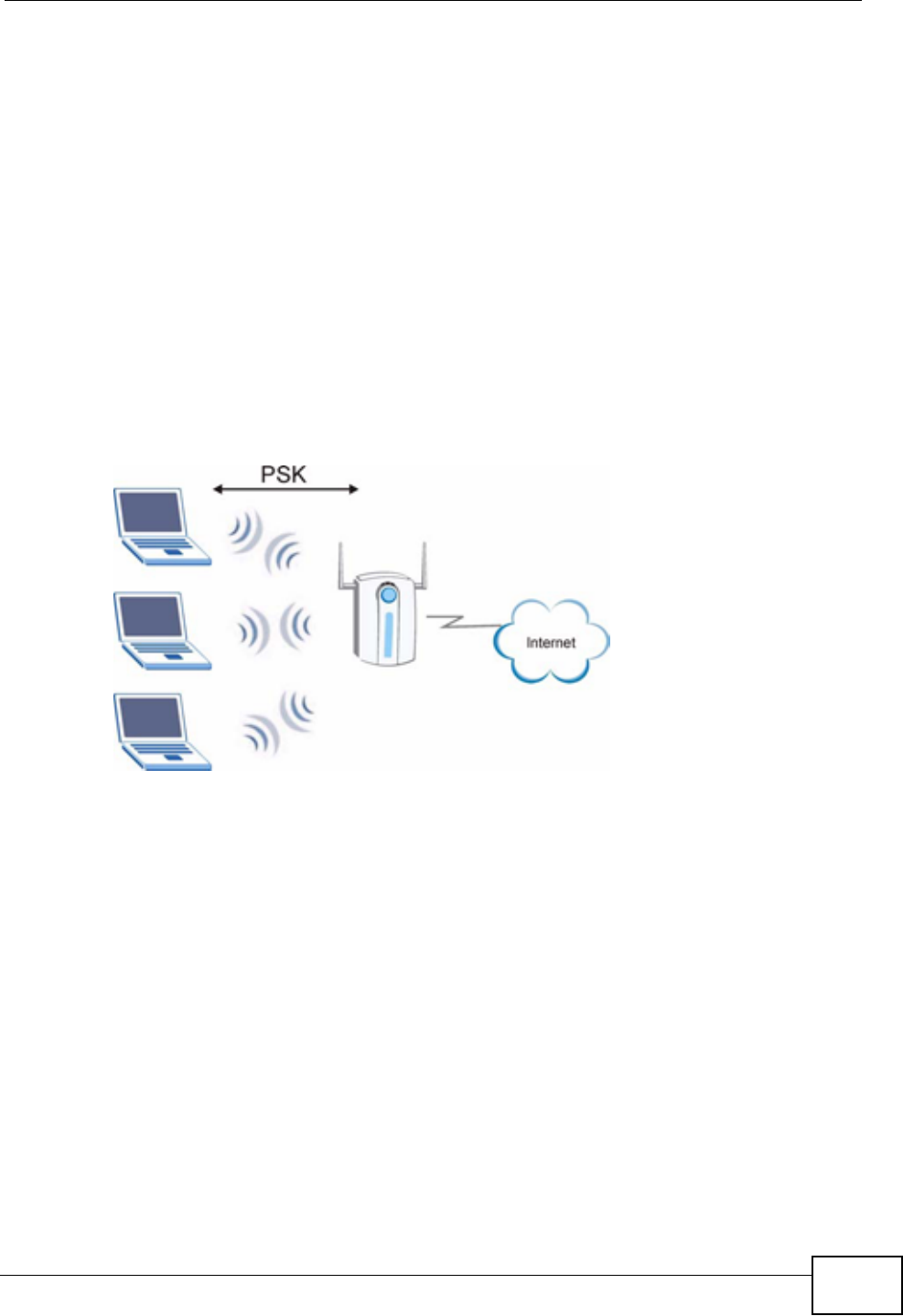
Appendix D Wireless LANs
P-320W v3 User’s Guide 245
21.0.2 WPA(2)-PSK Application Example
A WPA(2)-PSK application looks as follows.
1First enter identical passwords into the AP and all wireless clients. The Pre-Shared
Key (PSK) must consist of between 8 and 63 ASCII characters (including spaces
and symbols).
2The AP checks each wireless client's password and (only) allows it to join the
network if the password matches.
3The AP derives and distributes keys to the wireless clients.
4The AP and wireless clients use the TKIP or AES encryption process to encrypt
data exchanged between them.
Figure 151 WPA(2)-PSK Authentication
21.0.3 WPA(2) with RADIUS Application Example
You need the IP address of the RADIUS server, its port number (default is 1812),
and the RADIUS shared secret. A WPA(2) application example with an external
RADIUS server looks as follows. "A" is the RADIUS server. "DS" is the distribution
system.
1The AP passes the wireless client's authentication request to the RADIUS server.
2The RADIUS server then checks the user's identification against its database and
grants or denies network access accordingly.
3The RADIUS server distributes a Pairwise Master Key (PMK) key to the AP that
then sets up a key hierarchy and management system, using the pair-wise key to
dynamically generate unique data encryption keys to encrypt every data packet
that is wirelessly communicated between the AP and the wireless clients.

Appendix D Wireless LANs
P-320W v3 User’s Guide
246
Security Parameters Summary
Refer to this table to see what other security parameters you should configure for
each Authentication Method/ key management protocol type. MAC address filters
are not dependent on how you configure these security features.
Table 98 Wireless Security Relational Matrix
AUTHENTICATION
METHOD/ KEY
MANAGEMENT
PROTOCOL
ENCRYPTIO
N METHOD
ENTER
MANUAL KEY IEEE 802.1X
Open None No Disable
Enable without Dynamic WEP
Key
Open WEP No Enable with Dynamic WEP
Key
Yes Enable without Dynamic WEP
Key
Yes Disable
Shared WEP No Enable with Dynamic WEP
Key
Yes Enable without Dynamic WEP
Key
Yes Disable
WPA TKIP No Enable
WPA-PSK TKIP Yes Enable
WPA2 AES No Enable
WPA2-PSK AES Yes Enable

P-320W v3 User’s Guide 247
APPENDIX E
Services
The following table lists some commonly-used services and their associated
protocols and port numbers.
•Name: This is a short, descriptive name for the service. You can use this one or
create a different one, if you like.
•Protocol: This is the type of IP protocol used by the service. If this is TCP/
UDP, then the service uses the same port number with TCP and UDP. If this is
User-Defined, the Port(s) is the IP protocol number, not the port number.
•Port(s): This value depends on the Protocol.
•If the Protocol is TCP,UDP, or TCP/UDP, this is the IP port number.
•If the Protocol is USER, this is the IP protocol number.
•Description: This is a brief explanation of the applications that use this service
or the situations in which this service is used.

Appendix E Services
P-320W v3 User’s Guide
248
Table 99 Examples of Services
NAME PROTOCOL PORT(S) DESCRIPTION
AH
(IPSEC_TUNNEL)
User-Defined 51 The IPSEC AH (Authentication Header)
tunneling protocol uses this service.
AIM TCP 5190 AOL’s Internet Messenger service.
AUTH TCP 113 Authentication protocol used by some
servers.
BGP TCP 179 Border Gateway Protocol.
BOOTP_CLIENT UDP 68 DHCP Client.
BOOTP_SERVER UDP 67 DHCP Server.
CU-SEEME TCP/UDP
TCP/UDP
7648
24032
A popular videoconferencing solution
from White Pines Software.
DNS TCP/UDP 53 Domain Name Server, a service that
matches web names (e.g.
www.zyxel.com) to IP numbers.
ESP
(IPSEC_TUNNEL)
User-Defined 50 The IPSEC ESP (Encapsulation
Security Protocol) tunneling protocol
uses this service.
FINGER TCP 79 Finger is a UNIX or Internet related
command that can be used to find out
if a user is logged on.
FTP TCP
TCP
20
21
File Transfer Program, a program to
enable fast transfer of files, including
large files that may not be possible by
e-mail.
H.323 TCP 1720 NetMeeting uses this protocol.
HTTP TCP 80 Hyper Text Transfer Protocol - a client/
server protocol for the world wide
web.
HTTPS TCP 443 HTTPS is a secured http session often
used in e-commerce.
ICMP User-Defined 1Internet Control Message Protocol is
often used for diagnostic purposes.
ICQ UDP 4000 This is a popular Internet chat
program.
IGMP
(MULTICAST)
User-Defined 2Internet Group Multicast Protocol is
used when sending packets to a
specific group of hosts.
IKE UDP 500 The Internet Key Exchange algorithm
is used for key distribution and
management.
IMAP4 TCP 143 The Internet Message Access Protocol
is used for e-mail.
IMAP4S TCP 993 This is a more secure version of IMAP4
that runs over SSL.
IRC TCP/UDP 6667 This is another popular Internet chat
program.

Appendix E Services
P-320W v3 User’s Guide 249
MSN Messenger TCP 1863 Microsoft Networks’ messenger
service uses this protocol.
NetBIOS TCP/UDP
TCP/UDP
TCP/UDP
TCP/UDP
137
138
139
445
The Network Basic Input/Output
System is used for communication
between computers in a LAN.
NEW-ICQ TCP 5190 An Internet chat program.
NEWS TCP 144 A protocol for news groups.
NFS UDP 2049 Network File System - NFS is a client/
server distributed file service that
provides transparent file sharing for
network environments.
NNTP TCP 119 Network News Transport Protocol is
the delivery mechanism for the
USENET newsgroup service.
PING User-Defined 1Packet INternet Groper is a protocol
that sends out ICMP echo requests to
test whether or not a remote host is
reachable.
POP3 TCP 110 Post Office Protocol version 3 lets a
client computer get e-mail from a
POP3 server through a temporary
connection (TCP/IP or other).
POP3S TCP 995 This is a more secure version of POP3
that runs over SSL.
PPTP TCP 1723 Point-to-Point Tunneling Protocol
enables secure transfer of data over
public networks. This is the control
channel.
PPTP_TUNNEL
(GRE)
User-Defined 47 PPTP (Point-to-Point Tunneling
Protocol) enables secure transfer of
data over public networks. This is the
data channel.
RCMD TCP 512 Remote Command Service.
REAL_AUDIO TCP 7070 A streaming audio service that
enables real time sound over the web.
REXEC TCP 514 Remote Execution Daemon.
RLOGIN TCP 513 Remote Login.
ROADRUNNER TCP/UDP 1026 This is an ISP that provides services
mainly for cable modems.
RTELNET TCP 107 Remote Telnet.
RTSP TCP/UDP 554 The Real Time Streaming (media
control) Protocol (RTSP) is a remote
control for multimedia on the
Internet.
Table 99 Examples of Services (continued)
NAME PROTOCOL PORT(S) DESCRIPTION

Appendix E Services
P-320W v3 User’s Guide
250
SFTP TCP 115 The Simple File Transfer Protocol is an
old way of transferring files between
computers.
SMTP TCP 25 Simple Mail Transfer Protocol is the
message-exchange standard for the
Internet. SMTP enables you to move
messages from one e-mail server to
another.
SMTPS TCP 465 This is a more secure version of SMTP
that runs over SSL.
SNMP TCP/UDP 161 Simple Network Management
Program.
SNMP-TRAPS TCP/UDP 162 Traps for use with the SNMP
(RFC:1215).
SQL-NET TCP 1521 Structured Query Language is an
interface to access data on many
different types of database systems,
including mainframes, midrange
systems, UNIX systems and network
servers.
SSDP UDP 1900 The Simple Service Discovery Protocol
supports Universal Plug-and-Play
(UPnP).
SSH TCP/UDP 22 Secure Shell Remote Login Program.
STRM WORKS UDP 1558 Stream Works Protocol.
SYSLOG UDP 514 Syslog allows you to send system logs
to a UNIX server.
TACACS UDP 49 Login Host Protocol used for (Terminal
Access Controller Access Control
System).
TELNET TCP 23 Telnet is the login and terminal
emulation protocol common on the
Internet and in UNIX environments. It
operates over TCP/IP networks. Its
primary function is to allow users to
log into remote host systems.
TFTP UDP 69 Trivial File Transfer Protocol is an
Internet file transfer protocol similar
to FTP, but uses the UDP (User
Datagram Protocol) rather than TCP
(Transmission Control Protocol).
VDOLIVE TCP
UDP
7000
user-
defined
A videoconferencing solution. The UDP
port number is specified in the
application.
Table 99 Examples of Services (continued)
NAME PROTOCOL PORT(S) DESCRIPTION

P-320W v3 User’s Guide 251
APPENDIX F
Legal Information
Copyright
Copyright © 2009 by ZyXEL Communications Corporation.
The contents of this publication may not be reproduced in any part or as a whole,
transcribed, stored in a retrieval system, translated into any language, or
transmitted in any form or by any means, electronic, mechanical, magnetic,
optical, chemical, photocopying, manual, or otherwise, without the prior written
permission of ZyXEL Communications Corporation.
Published by ZyXEL Communications Corporation. All rights reserved.
Disclaimer
ZyXEL does not assume any liability arising out of the application or use of any
products, or software described herein. Neither does it convey any license under
its patent rights nor the patent rights of others. ZyXEL further reserves the right
to make changes in any products described herein without notice. This publication
is subject to change without notice.
Trademarks
ZyNOS (ZyXEL Network Operating System) is a registered trademark of ZyXEL
Communications, Inc. Other trademarks mentioned in this publication are used for
identification purposes only and may be properties of their respective owners.
Certifications
Federal Communications Commission (FCC) Interference Statement
The device complies with Part 15 of FCC rules. Operation is subject to the
following two conditions:
• This device may not cause harmful interference.

Appendix F Legal Information
P-320W v3 User’s Guide
252
• This device must accept any interference received, including interference that
may cause undesired operations.
This device has been tested and found to comply with the limits for a Class B
digital device pursuant to Part 15 of the FCC Rules. These limits are designed to
provide reasonable protection against harmful interference in a residential
installation. This device generates, uses, and can radiate radio frequency energy,
and if not installed and used in accordance with the instructions, may cause
harmful interference to radio communications. However, there is no guarantee
that interference will not occur in a particular installation.
If this device does cause harmful interference to radio/television reception, which
can be determined by turning the device off and on, the user is encouraged to try
to correct the interference by one or more of the following measures:
1Reorient or relocate the receiving antenna.
2Increase the separation between the equipment and the receiver.
3Connect the equipment into an outlet on a circuit different from that to which the
receiver is connected.
4Consult the dealer or an experienced radio/TV technician for help.
FCC Radiation Exposure Statement
• This transmitter must not be co-located or operating in conjunction with any
other antenna or transmitter.
• IEEE 802.11b or 802.11g operation of this product in the U.S.A. is firmware-
limited to channels 1 through 11.
• To comply with FCC RF exposure compliance requirements, a separation
distance of at least 20 cm must be maintained between the antenna of this
device and all persons.
ࣹრ!"
ࠉᖕ!!܅פሽंᘿ୴ࢤሽᖲጥᙄऄ
รԼԲය!!ᆖীڤᎁᢞٽհ܅פ୴᙮ሽᖲΔॺᆖױΔֆΕᇆࢨࠌش
ृ݁լᖐ۞᧢ޓ᙮ΕףՕפࢨ᧢ޓૠհࢤ֗פ౨Ζ
รԼය!!܅פ୴᙮ሽᖲհࠌشլᐙଆڜ٤֗եឫٽऄຏॾΙᆖ࿇
ڶեឫွழΔᚨمܛೖشΔࠀޏ۟ྤեឫழֱᤉᥛࠌشΖ
ছႈٽऄຏॾΔਐࠉሽॾࡳ܂ᄐհྤᒵሽॾΖ܅פ୴᙮ሽᖲႊݴ
࠹ٽऄຏॾࢨՠᄐΕઝᖂ֗᠔᛭شሽंᘿ୴ࢤሽᖲໂհեឫΖ!

Appendix F Legal Information
P-320W v3 User’s Guide 253
ءᖲૻڇլեឫٽऄሽፕፖլ࠹եឫঅᎽයٙՀ࣍փࠌشΖ!
྇֟ሽंᐙΔᓮݔᔞࠌشΖ
Notices
Changes or modifications not expressly approved by the party responsible for
compliance could void the user's authority to operate the equipment.
This device has been designed for the WLAN 2.4 GHz network throughout the EC
region and Switzerland, with restrictions in France.
This Class B digital apparatus complies with Canadian ICES-003.
Cet appareil numérique de la classe B est conforme à la norme NMB-003 du
Canada.
Viewing Certifications
1Go to http://www.zyxel.com.
2Select your product on the ZyXEL home page to go to that product's page.
3Select the certification you wish to view from this page.
ZyXEL Limited Warranty
ZyXEL warrants to the original end user (purchaser) that this product is free from
any defects in materials or workmanship for a period of up to two years from the
date of purchase. During the warranty period, and upon proof of purchase, should
the product have indications of failure due to faulty workmanship and/or
materials, ZyXEL will, at its discretion, repair or replace the defective products or
components without charge for either parts or labor, and to whatever extent it
shall deem necessary to restore the product or components to proper operating
condition. Any replacement will consist of a new or re-manufactured functionally
equivalent product of equal or higher value, and will be solely at the discretion of
ZyXEL. This warranty shall not apply if the product has been modified, misused,
tampered with, damaged by an act of God, or subjected to abnormal working
conditions.
Note
Repair or replacement, as provided under this warranty, is the exclusive remedy of
the purchaser. This warranty is in lieu of all other warranties, express or implied,
including any implied warranty of merchantability or fitness for a particular use or

Appendix F Legal Information
P-320W v3 User’s Guide
254
purpose. ZyXEL shall in no event be held liable for indirect or consequential
damages of any kind to the purchaser.
To obtain the services of this warranty, contact your vendor. You may also refer to
the warranty policy for the region in which you bought the device at http://
www.zyxel.com/web/support_warranty_info.php.
Registration
Register your product online to receive e-mail notices of firmware upgrades and
information at www.zyxel.com for global products, or at www.us.zyxel.com for
North American products.

Index
P-320W v3 User’s Guide 255
Index
Numbers
802.11 Mode 71
A
ActiveX 126
Alert 163
alternative subnet mask notation 210
AP 21
AP (Access Point) 237
AP+Bridge 21
B
Backup configuration 181
Basic wireless security 42
Bridge/Repeater 21
BSS 235
C
CA 242
Certificate Authority 242
certifications 251
notices 253
viewing 253
CFI (Canonical Format Indicator) 102
Channel 29,237
Interference 237
channel 56
Configuration
backup 181
reset the factory defaults 183
restore 182
Cookies 126
copyright 251
CTS (Clear to Send) 238
D
Daylight saving 162
DDNS 157
see also Dynamic DNS
DHCP 32,89
DHCP server
see also Dynamic Host Configuration Protocol
DHCP client information 91
DHCP client list 91
DHCP server 86,89
DHCP table 32,91
DHCP client information
DHCP status
Dimensions 193
disclaimer 251
DNS 49
DNS server
see also Domain name system
Domain name 38
vs host name. see also system name
Dynamic DNS 157
Dynamic Host Configuration Protocol 89
Dynamic WEP Key Exchange 242
DynDNS Wildcard 158
E
EAP Authentication 241
Encryption 243
encryption 58
and local (user) database 58
key 58
WPA compatible 58
ESS 236

Index
P-320W v3 User’s Guide
256
ESSID 190
Extended Service Set 236
Extended wireless security 43
F
Factory LAN defaults 86
FCC interference statement 251
Firewall 117
Firewall overview
guidelines 121
network security
Stateful inspection 118
ZyXEL device firewall 118
Firmware upload 179
file extension
using HTTP
firmware version 29
Fragmentation Threshold 71,239
G
gateway 132
General wireless LAN screen 60
H
Hidden Node 238
I
IANA 216
IBSS 235
IEEE 802.11g 239
Independent Basic Service Set 235
Install UPnP 143
Windows Me 143
Windows XP 145
Internet Assigned Numbers Authority
See IANA
Internet connection
Ethernet
PPPoE. see also PPP over Ethernet
PPTP
WAN connection
Internet connection wizard 43
IP Address 87,97
IP address 49
dynamic
IP Pool 90
J
Java 126
L
LAN 85
IP pool setup 86
LAN overview 85
LAN setup 85
LAN TCP/IP 86
local (user) database 57
and encryption 58
Local Area Network 85
Log 164
M
MAC 68
MAC address 57
cloning 51
MAC address filter 57
MAC address filtering 68
MAC filter 68
managing the device
good habits 22
using the web configurator. See web
configurator.
MBSSID 21
Media access control 68
Metric 133

Index
P-320W v3 User’s Guide 257
mode 21
N
NAT 93,96,215
overview 93
port forwarding 94
see also Network Address Translation
server sets 94
NAT Traversal 142
Navigation Panel 30
navigation panel 30
Network Address Translation 93,96
O
operating mode 21
P
Pairwise Master Key (PMK) 59
Point-to-Point Protocol over Ethernet 44,109
Point-to-Point Tunneling Protocol 46,111
Pool Size 90
Port forwarding 94,97
default server 94
example 94
local server 97
port numbers
services
Power Specification 193
PPPoE 44,109
benefits 45
dial-up connection
see also Point-to-Point Protocol over
Ethernet 44
PPTP 46,111
see also Point-to-Point Tunneling Protocol 46
Preamble Mode 239
Private 133
product registration 254
R
RADIUS 240
Shared Secret Key 241
RADIUS Message Types 241
RADIUS Messages 241
RADIUS server 57
registration
product 254
related documentation 3
Remote management 135
and NAT 136
limitations 136
remote management session 135
system timeout 136
Reset button 27,183
Reset the device 27
Restore configuration 182
Restrict Web Features 126
RF (Radio Frequency) 194
RoadRunner 108
Roaming 70
RTS (Request To Send) 238
RTS Threshold 238,239
RTS/CTS Threshold 71
S
safety warnings 7
Security Parameters 246
Service Set 61
Service Set IDentification 61
Service Set IDentity. See SSID.
services
and port numbers 247
and protocols 247
Simple Mail Transfer Protocol 166
SMTP 166
SNMP 121
SSID 29,56,61
Static Route 132
Status 28
subnet 207

Index
P-320W v3 User’s Guide
258
Subnet Mask 87
subnet mask 49,208
subnetting 211
Summary
DHCP table 32
Packet statistics 33,35
Wireless station status 34
syntax conventions 5
System General Setup 158
System Name 159
System name 38
vs computer name
System restart 183
T
tagged VLAN 102
TCP/IP configuration 89
Temperature 193
Time setting 161
trademarks 251
trigger port 95
Trigger port forwarding 95
example 95
process 95
U
Universal Plug and Play 141
Application 142
UPnP 141
Forum 142
security issues 142
URL Keyword Blocking 126
Use Authentication 244
user authentication 57
local (user) database 57
RADIUS server 57
User Name 160
V
VID 102
number of possible VIDs 102
priority frame 102
VID (VLAN Identifier) 102
VLAN 101
ID 102
tagged 101
VPN 111
W
WAN
IP address assignment 48
WAN (Wide Area Network) 107
WAN advanced 114
WAN IP address 48
WAN IP address assignment 50
warranty 253
note 253
Web Configurator
how to access 25
Overview 25
Web configurator
navigating 27
web configurator 22
Web Proxy 126
WEP Encryption 63
WEP encryption 63
WEP key 63
Wildcard 158
Wireless association list 34
wireless channel 190
wireless LAN 190
Wireless LAN wizard 40
Wireless network
basic guidelines 55
channel 56
encryption 58
example 55
MAC address filter 57
overview 55
security 56

Index
P-320W v3 User’s Guide 259
SSID 56
Wireless security 56
overview 56
type 56
wireless security 190
Wireless tutorial 77
WPS 77
Wizard setup 37
complete 52
Internet connection 43
system information 38
wireless LAN 40
WLAN
Interference 237
Security Parameters 246
WPA
with RADIUS application example 59
WPA compatible 58
WPA, WPA2 243
WPA2
with RADIUS application example 59
WPA2-PSK
application example 59
WPA-PSK
application example 59
WPS 23
Z
ZyNOS 29

Index
P-320W v3 User’s Guide
260
